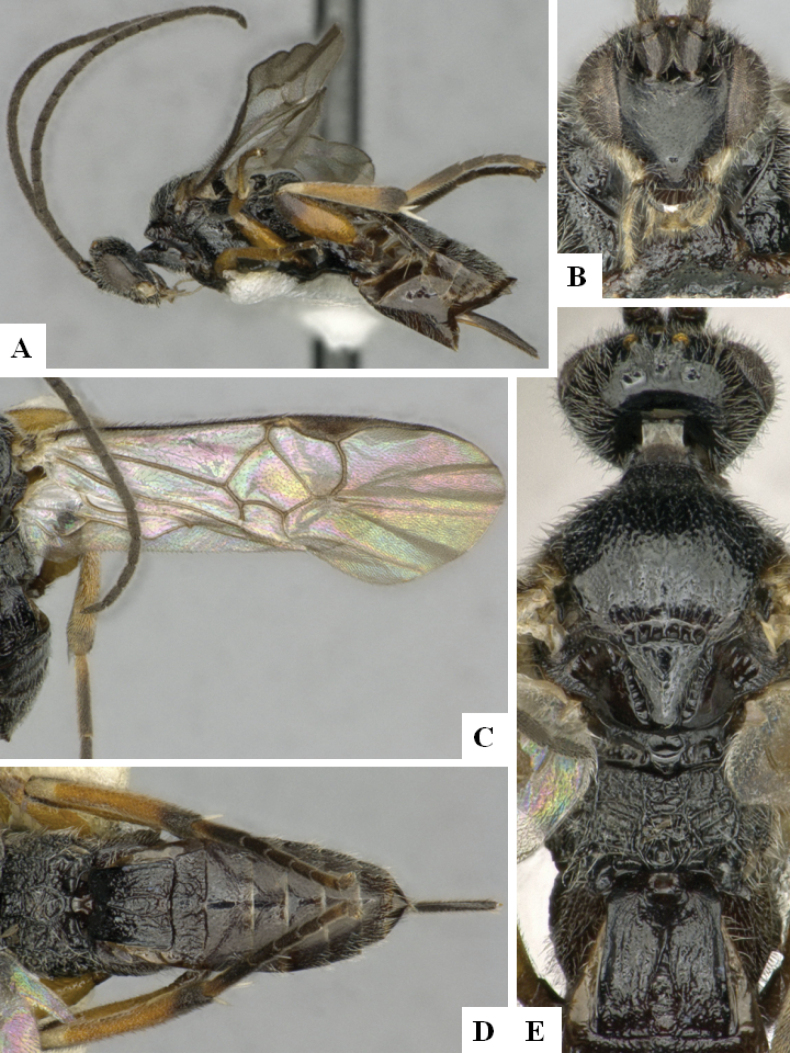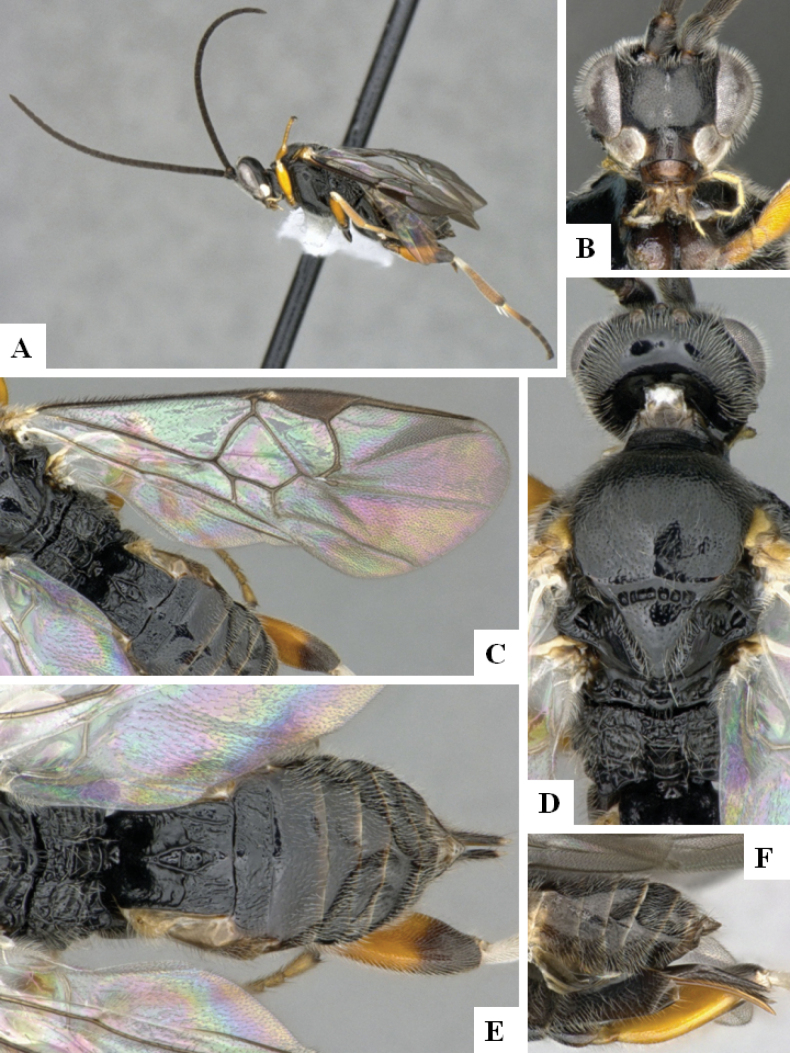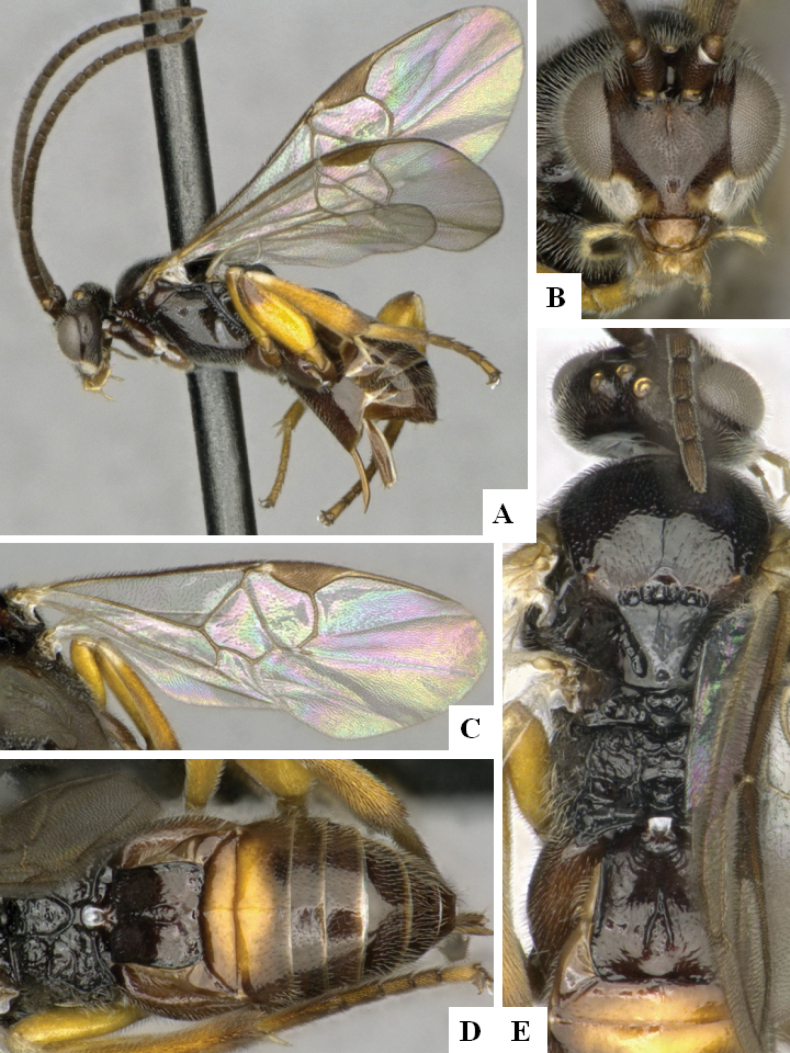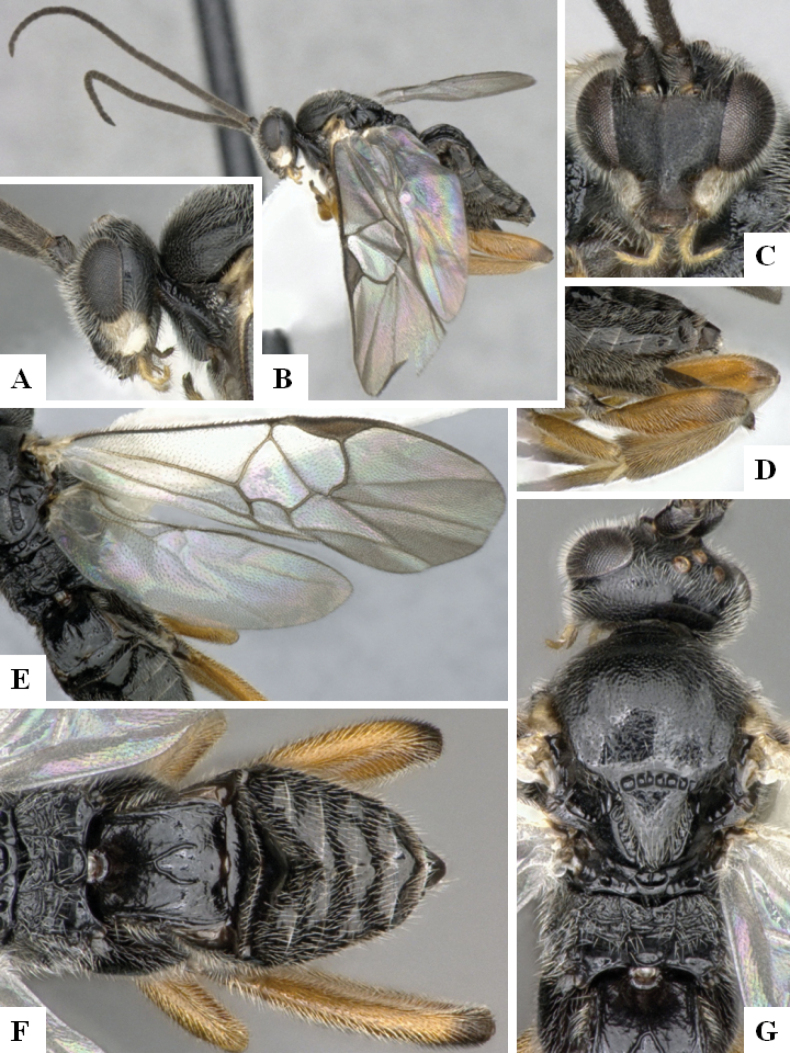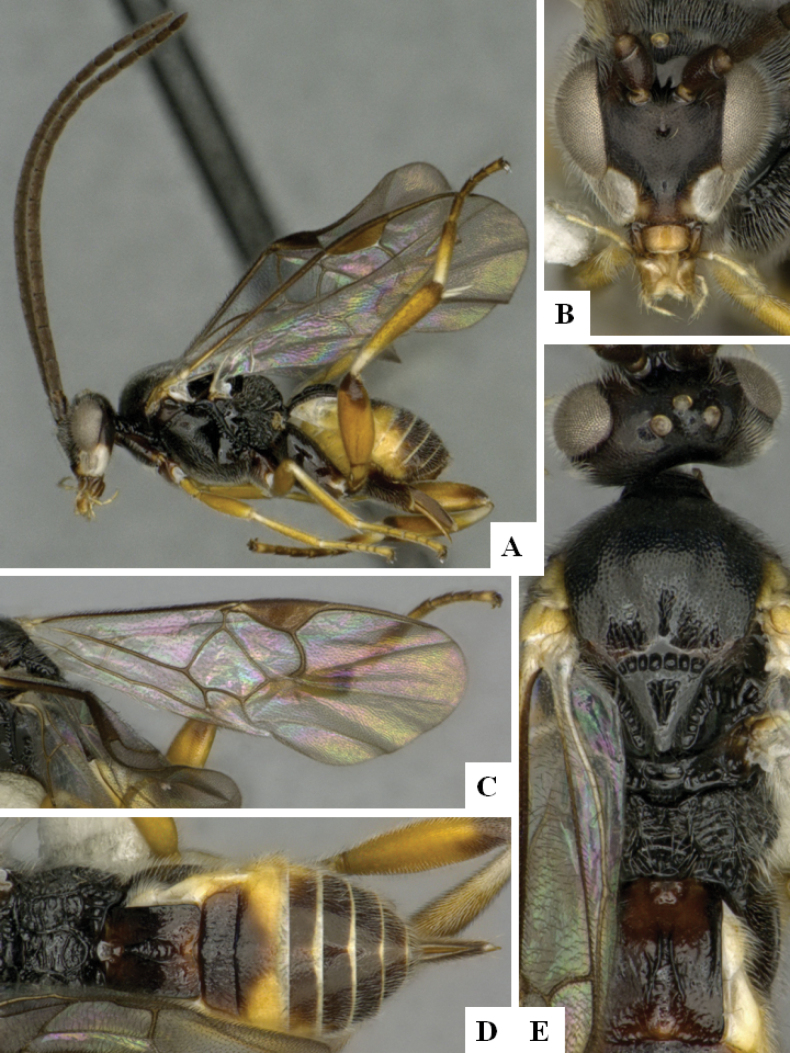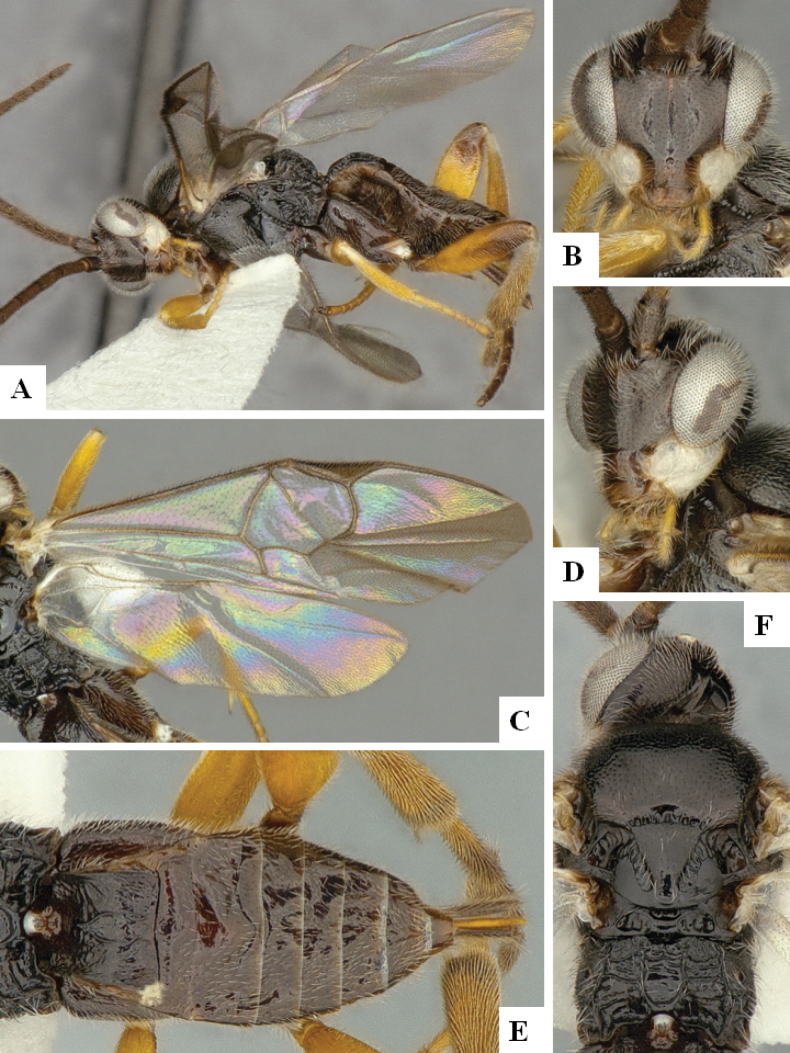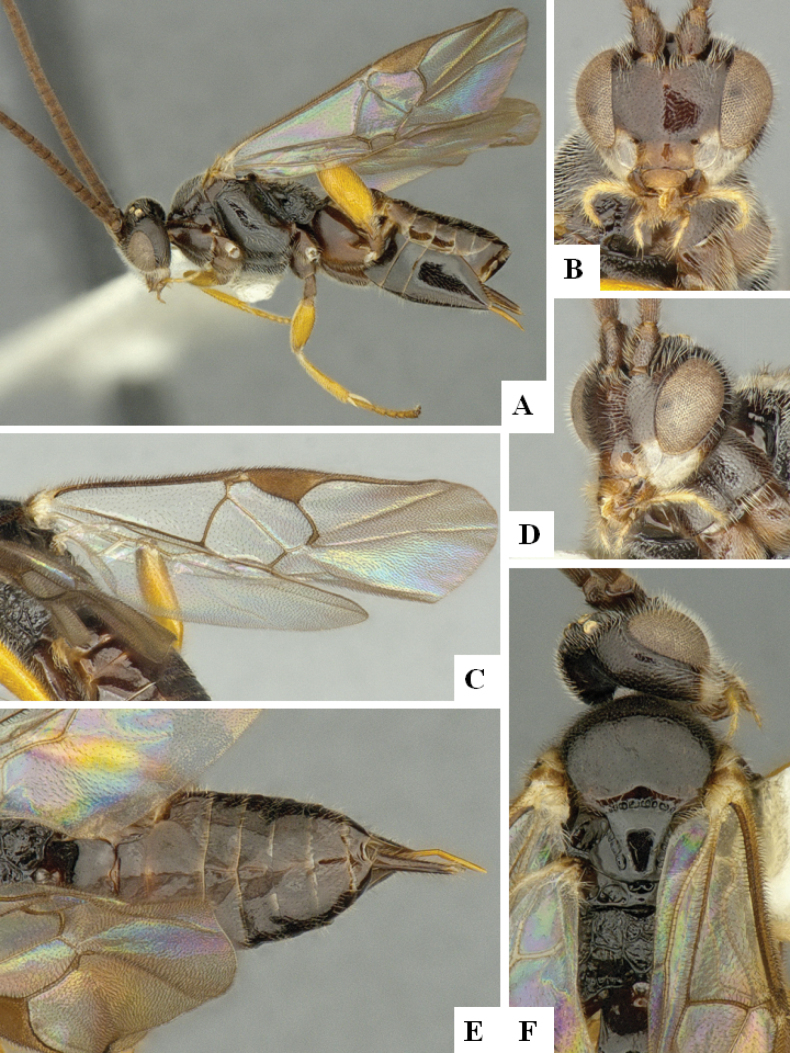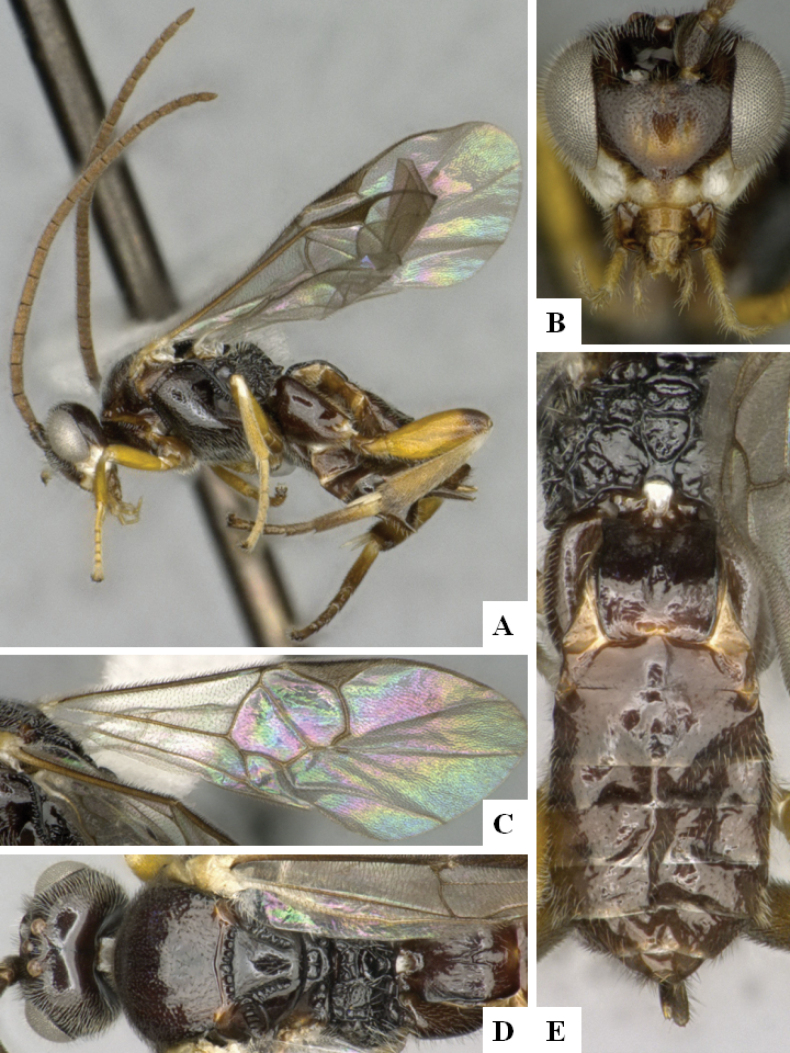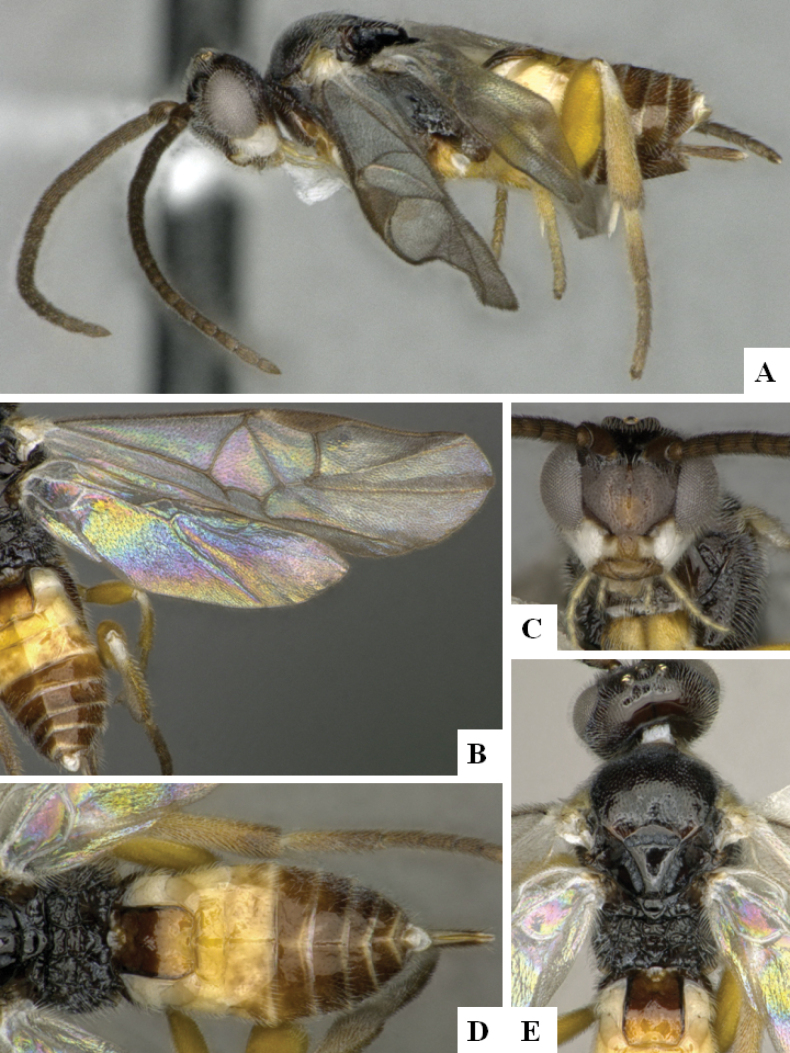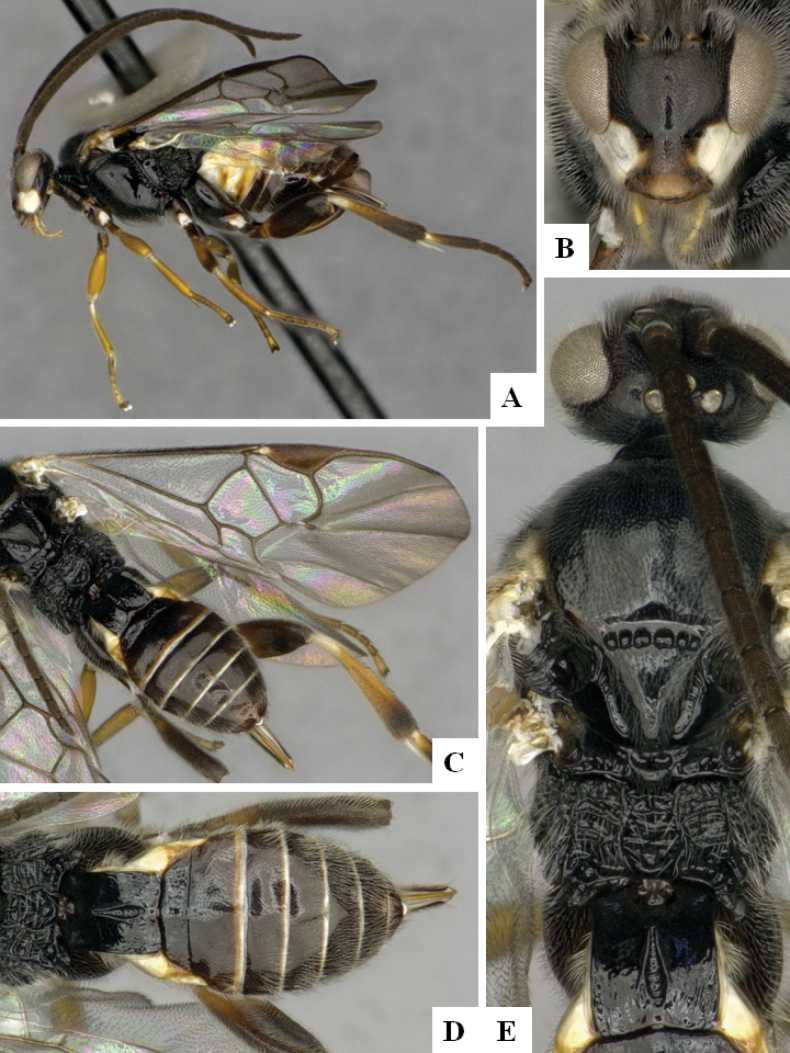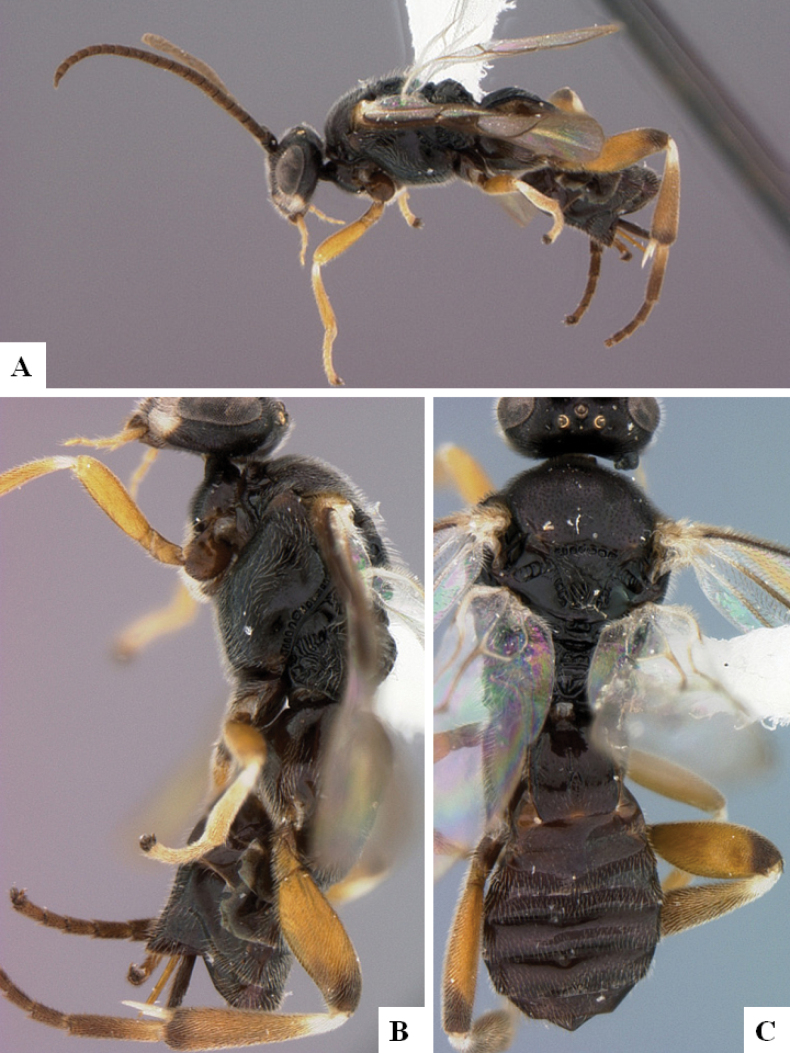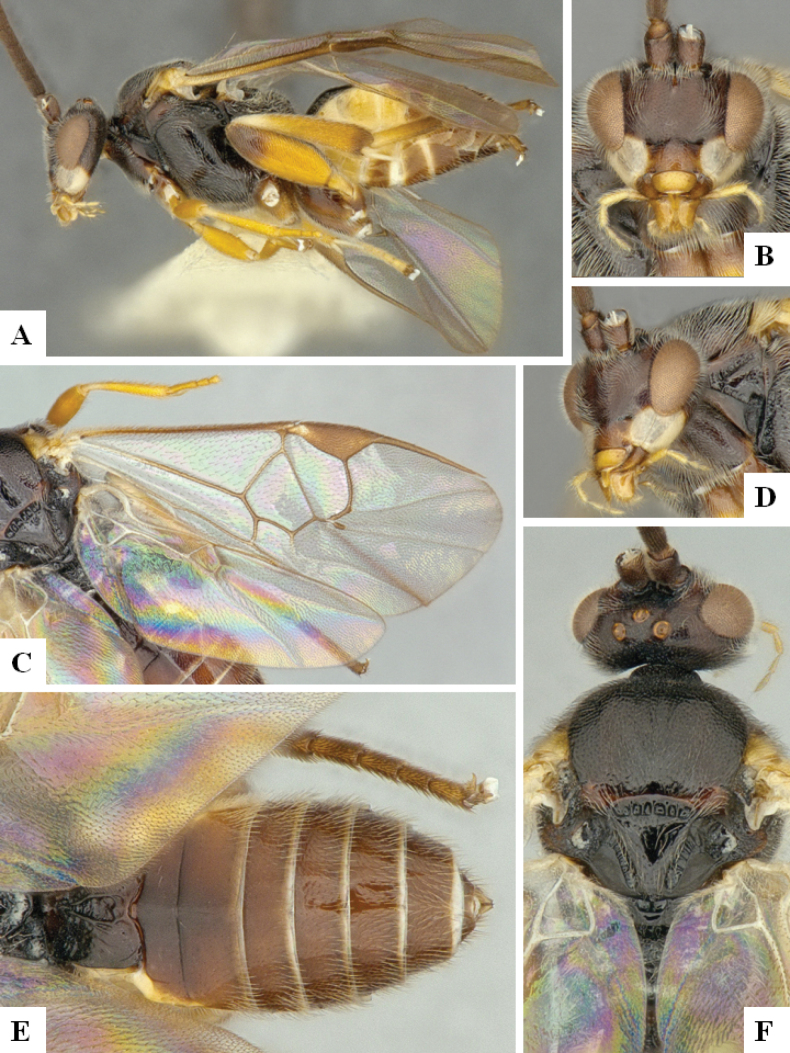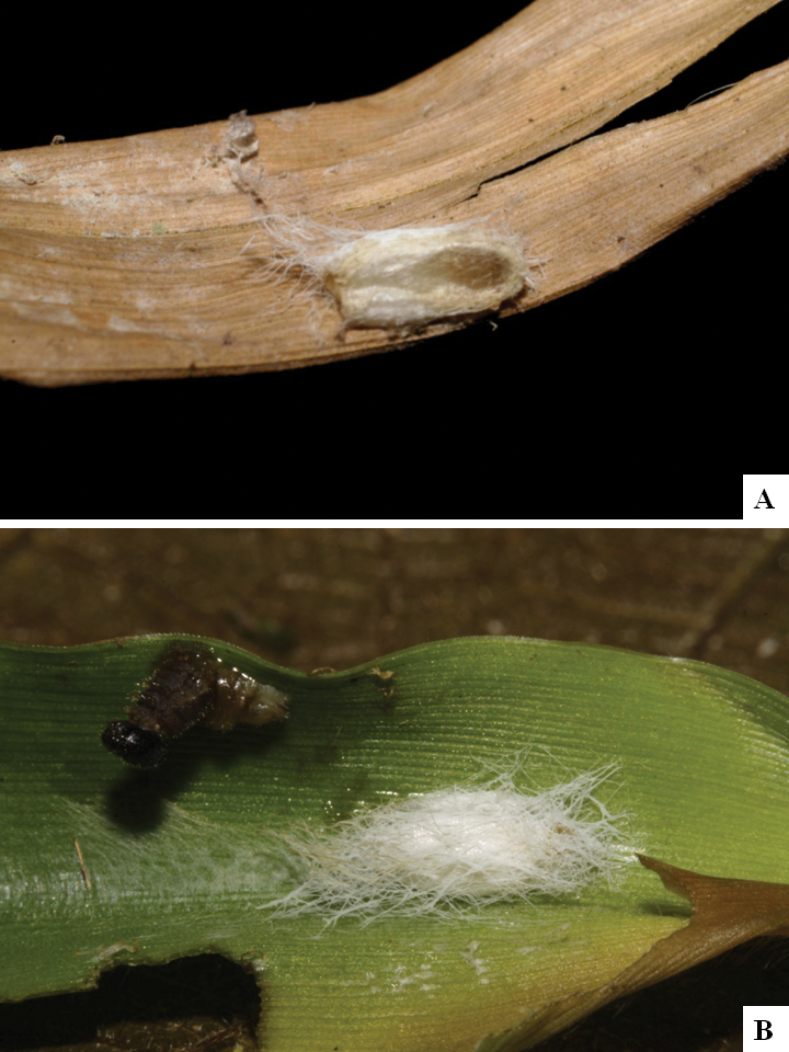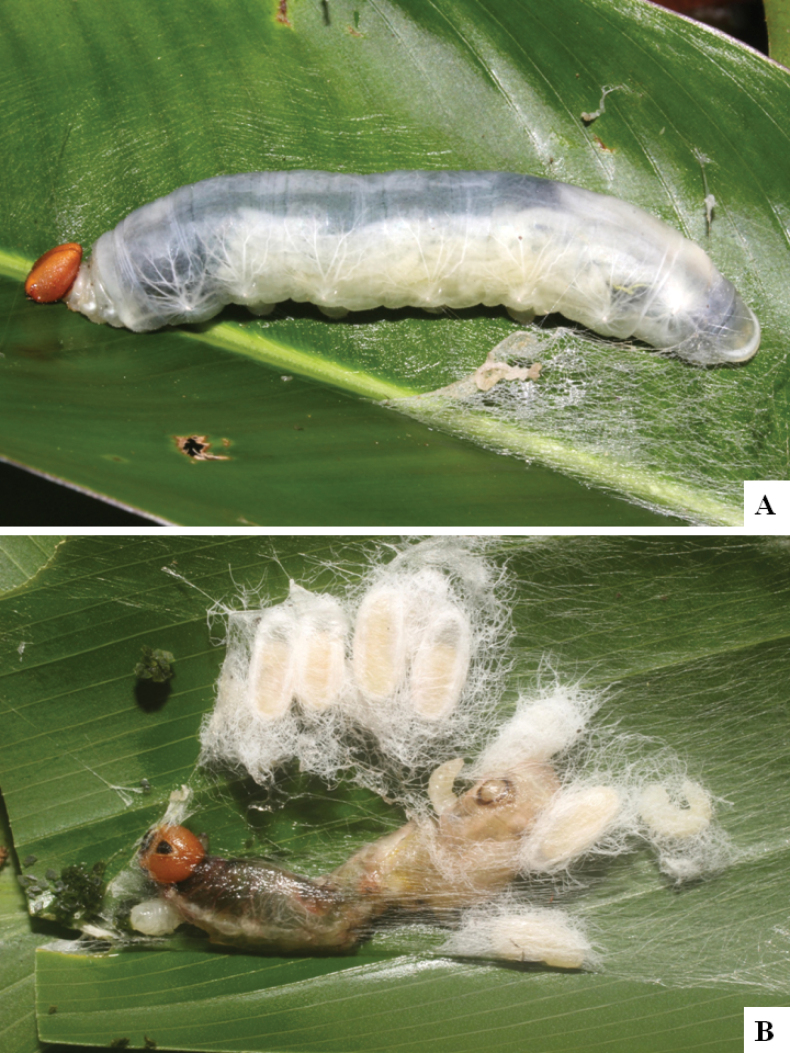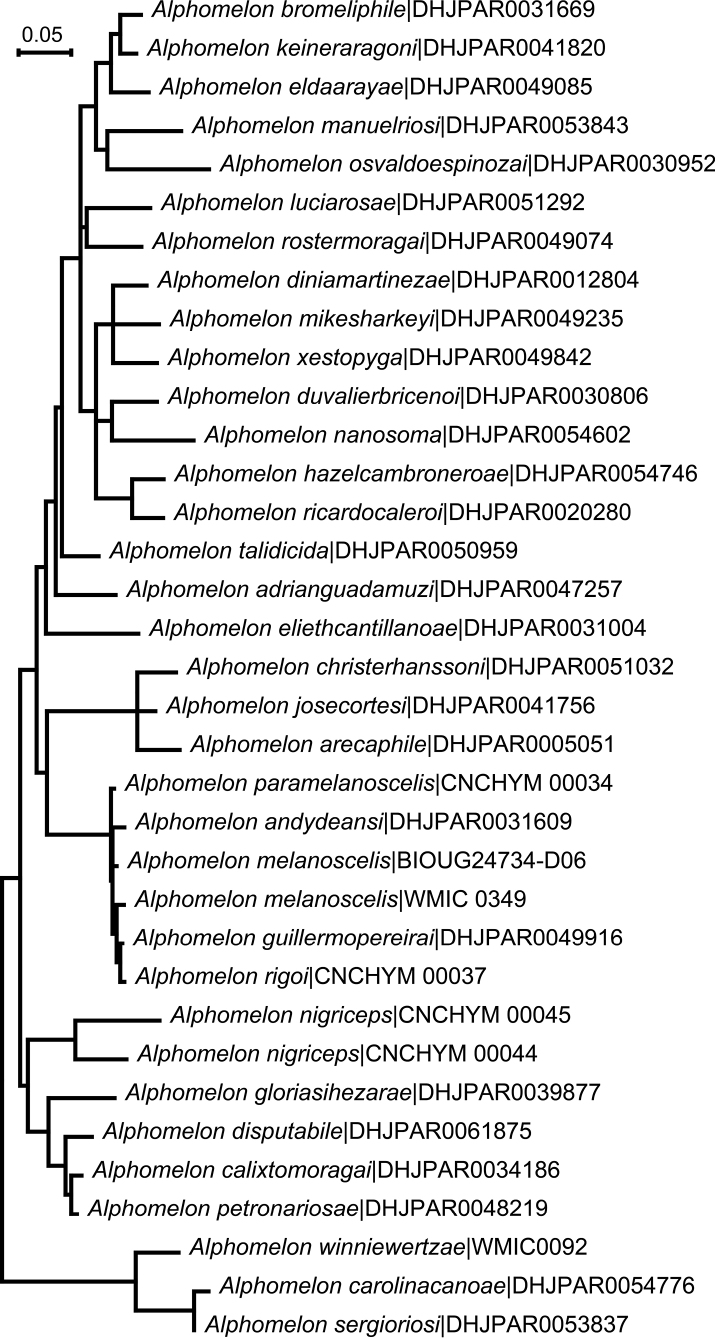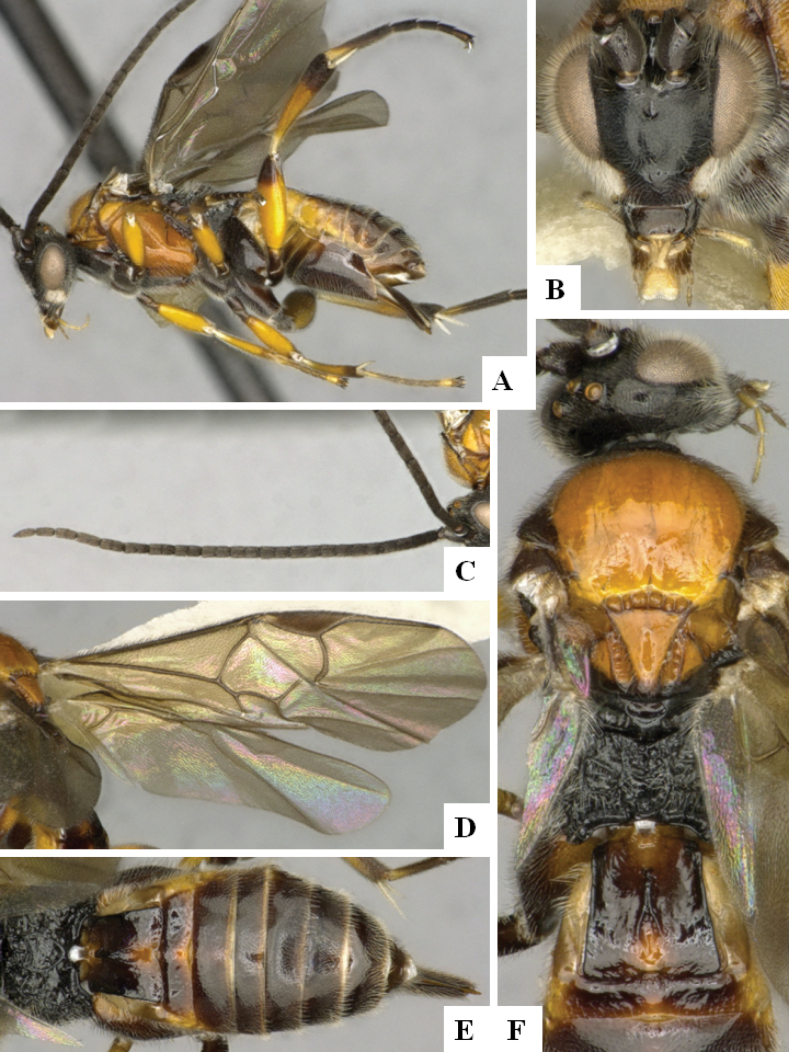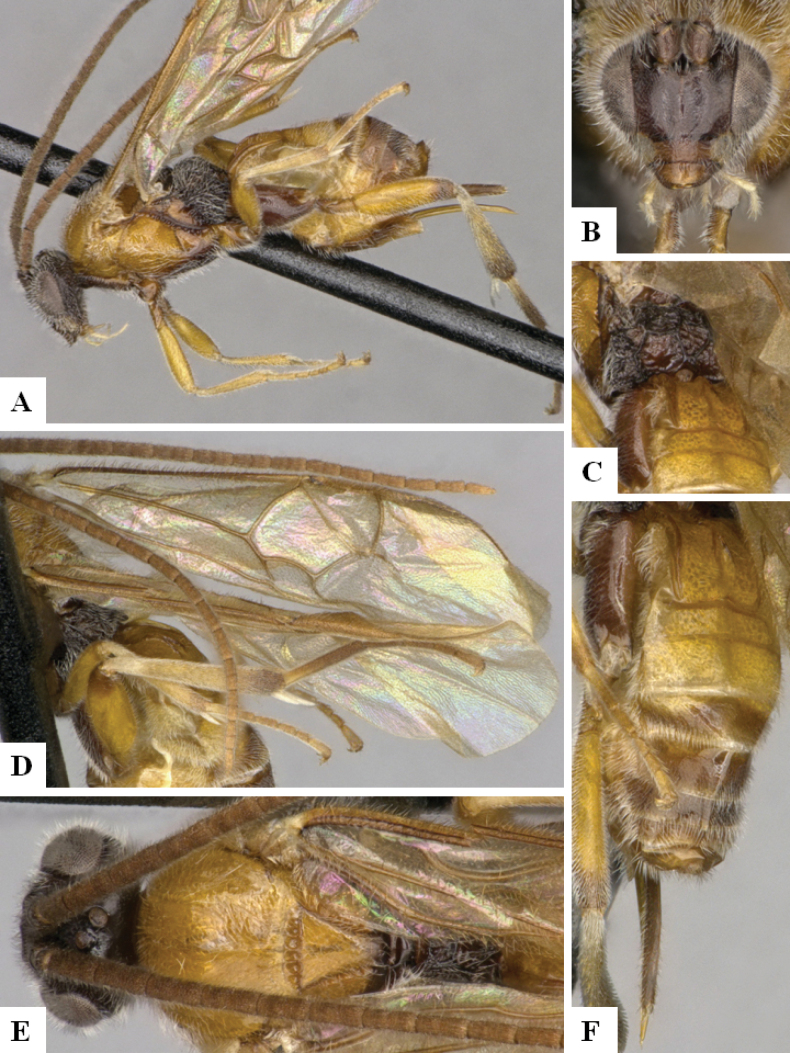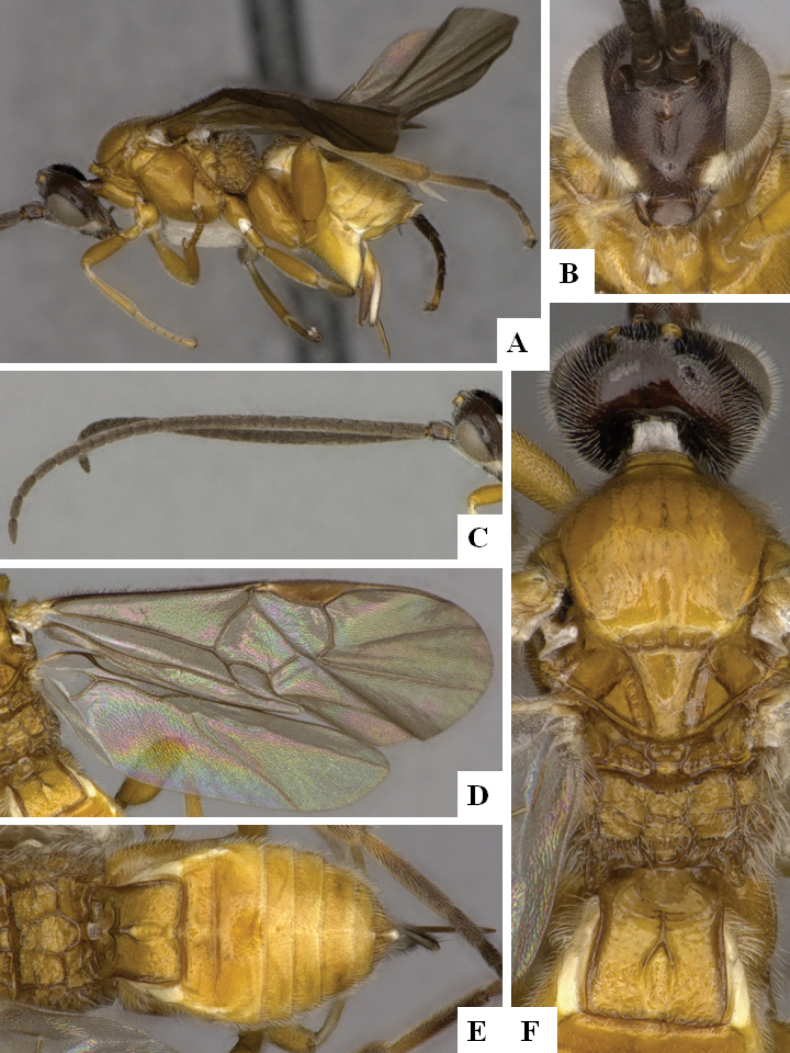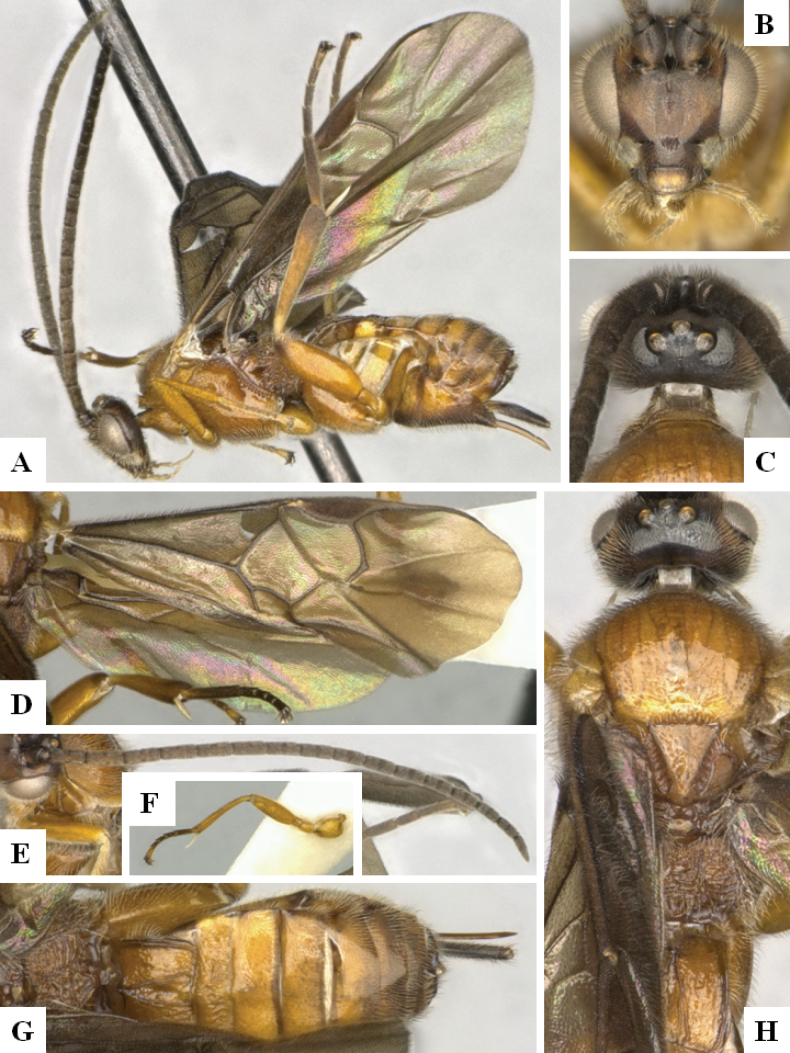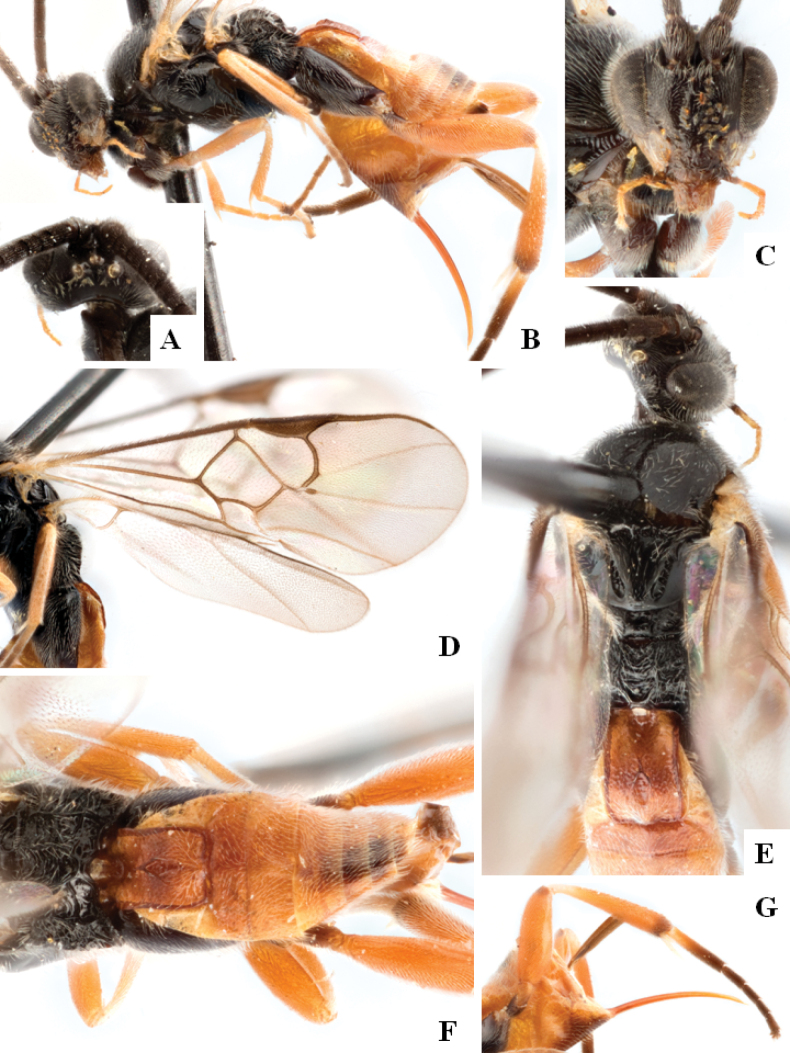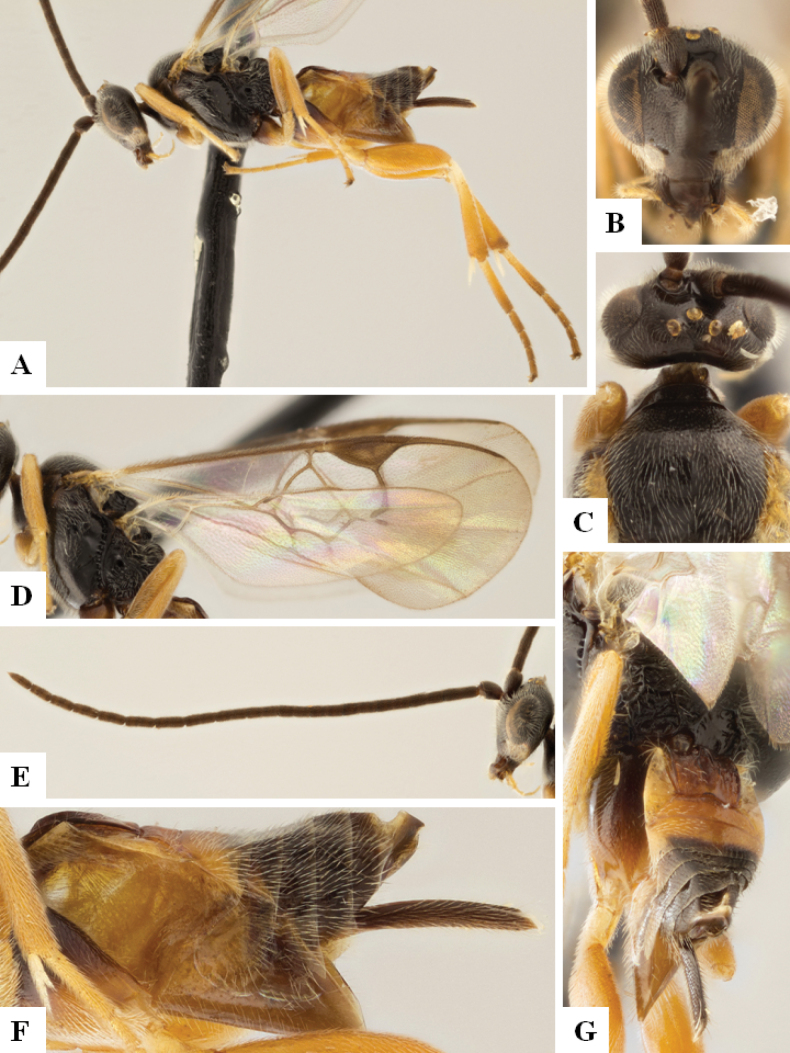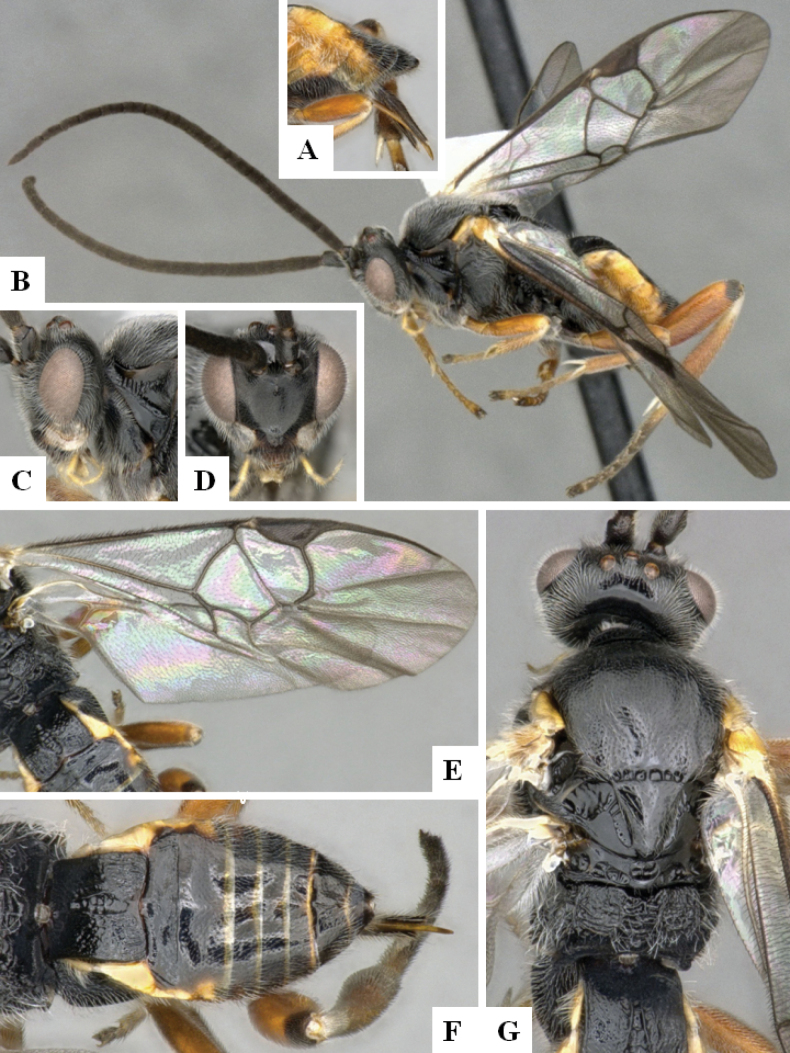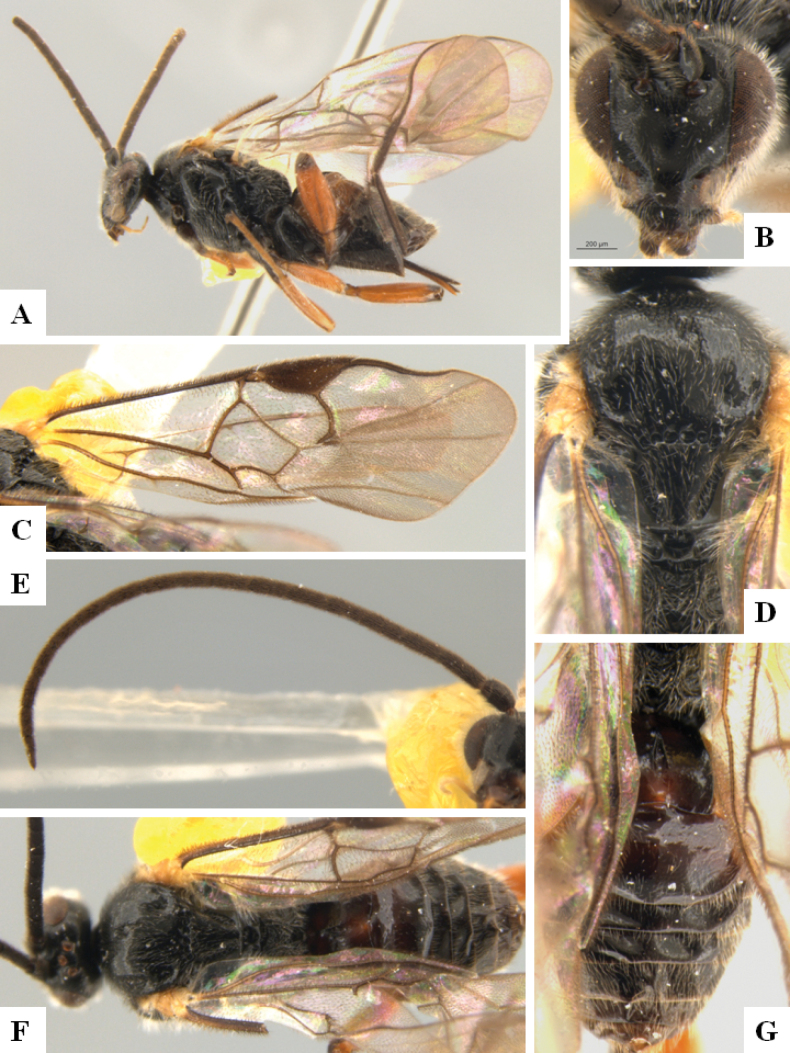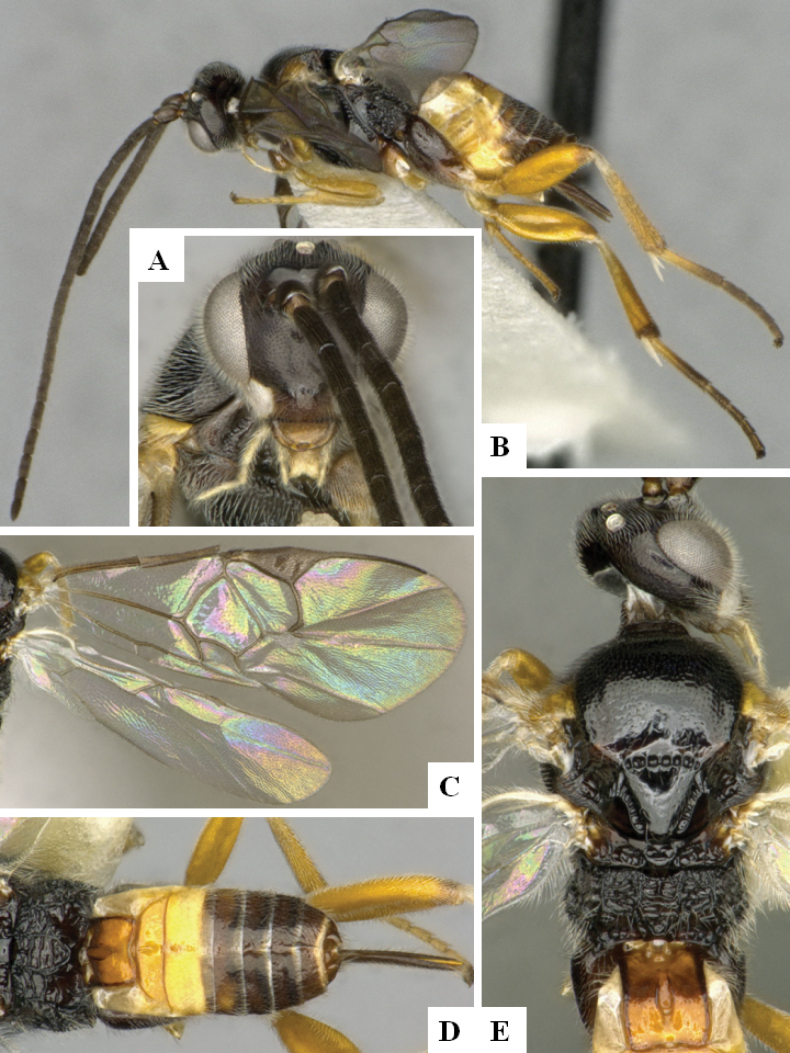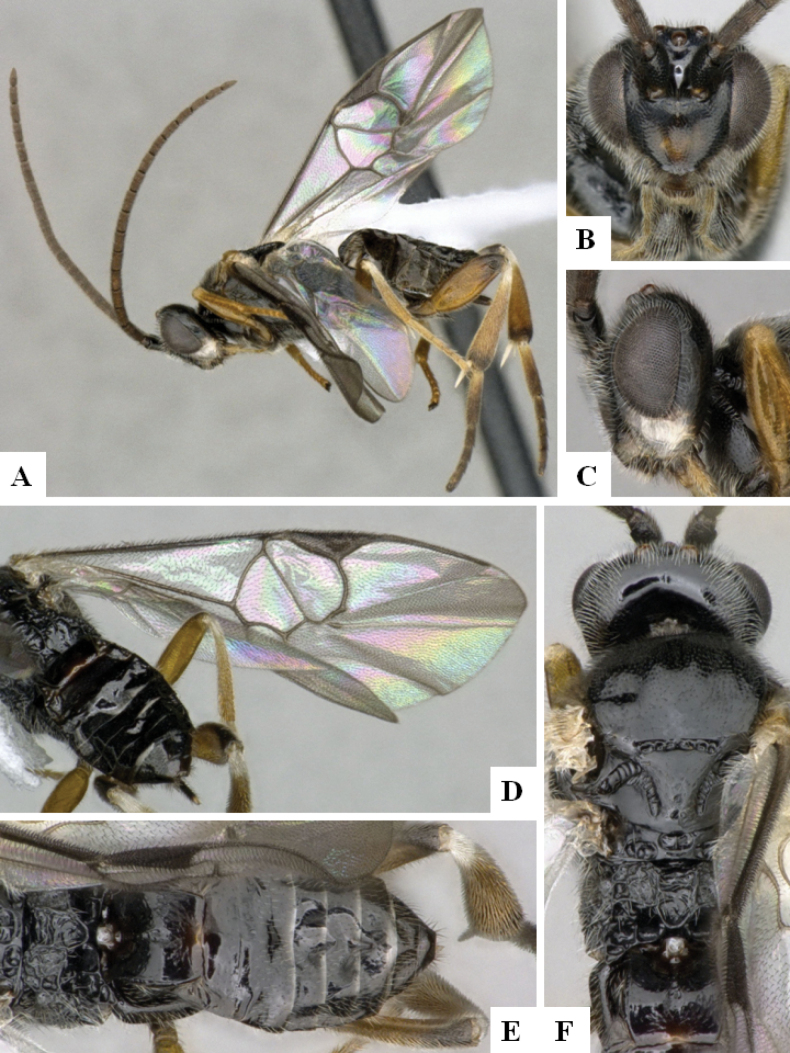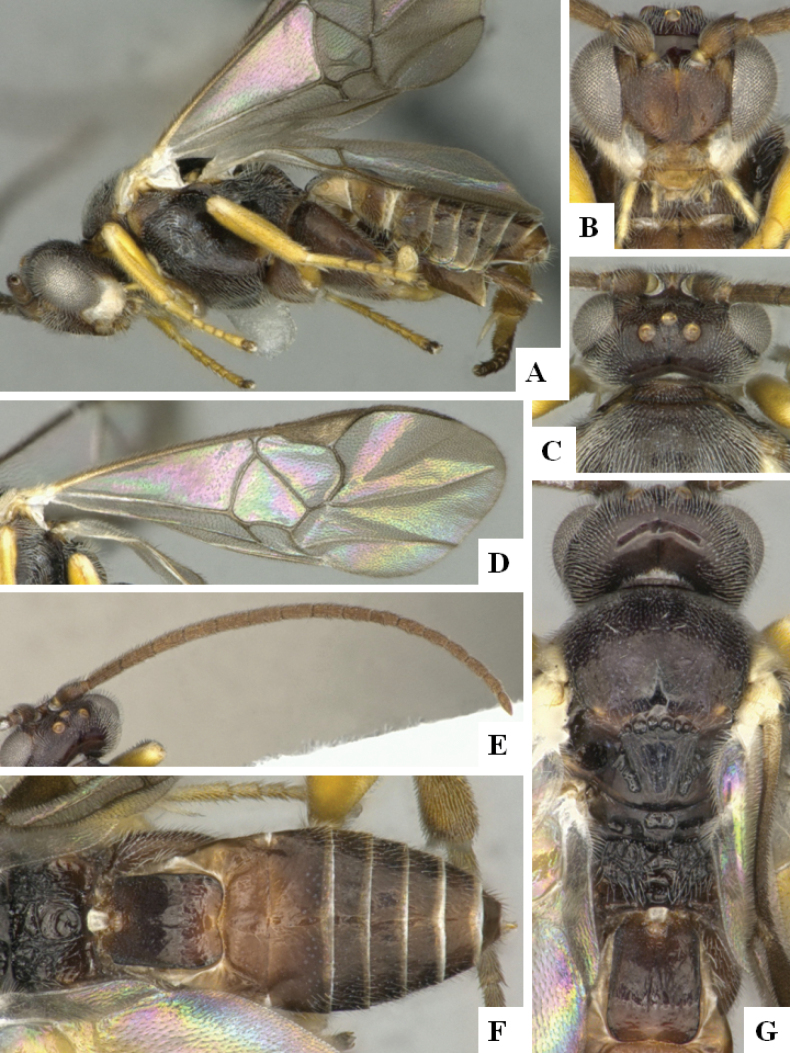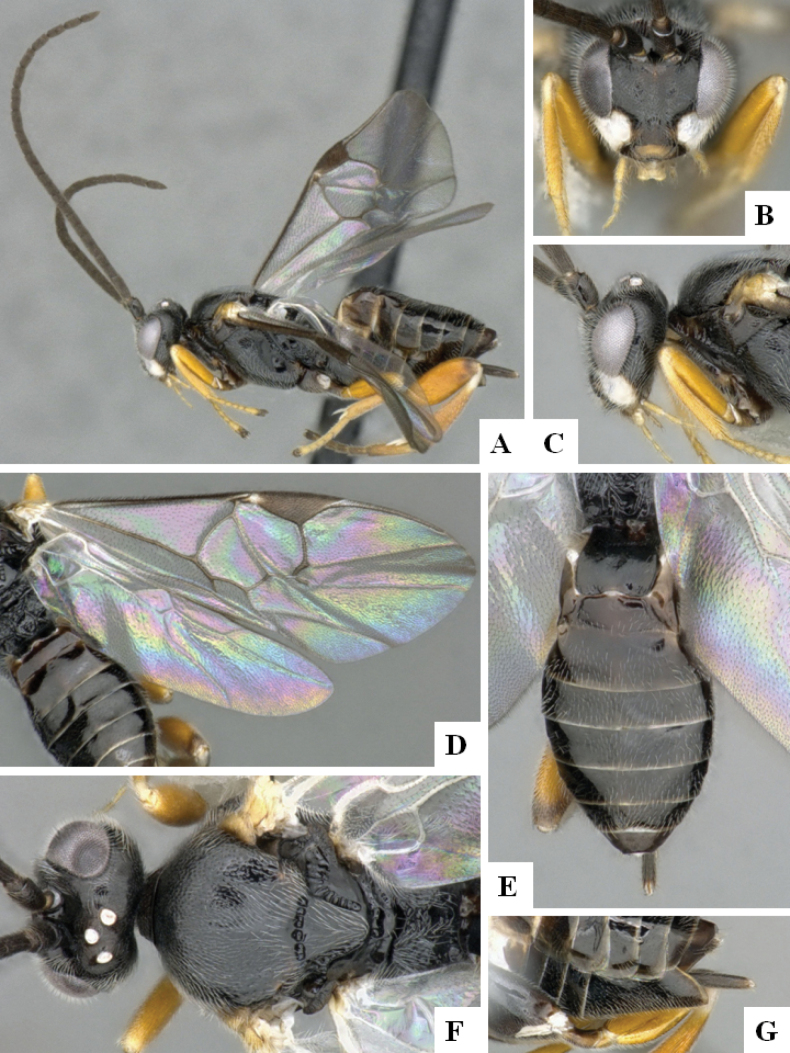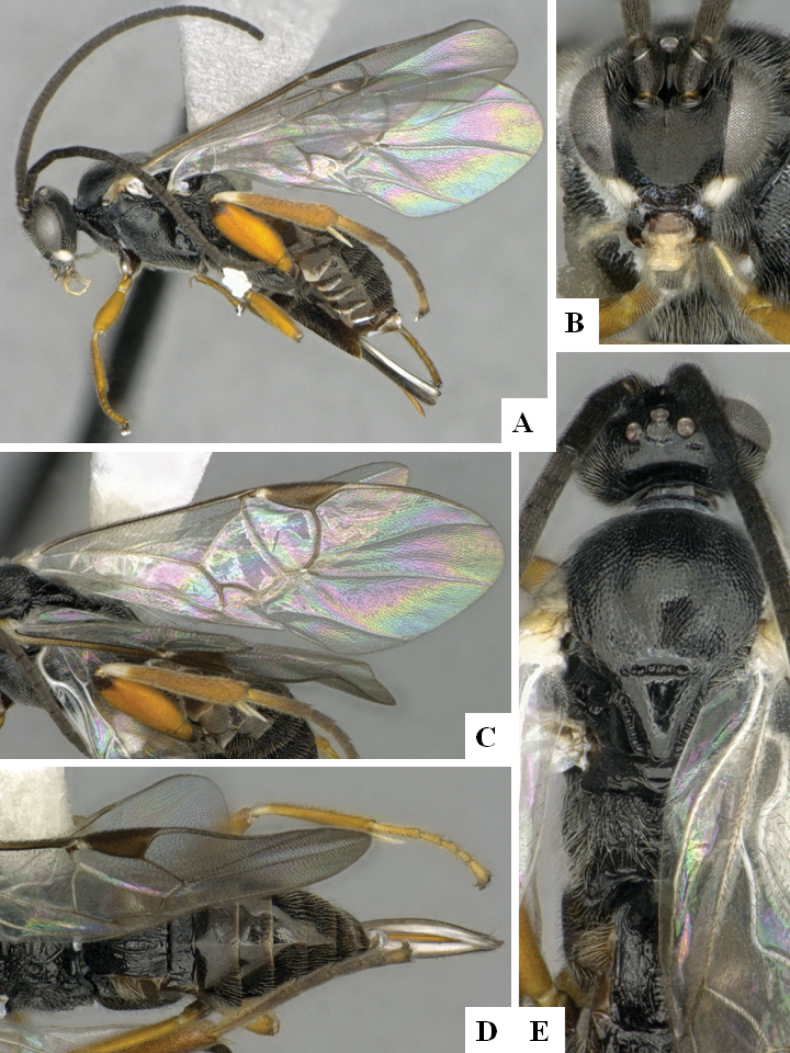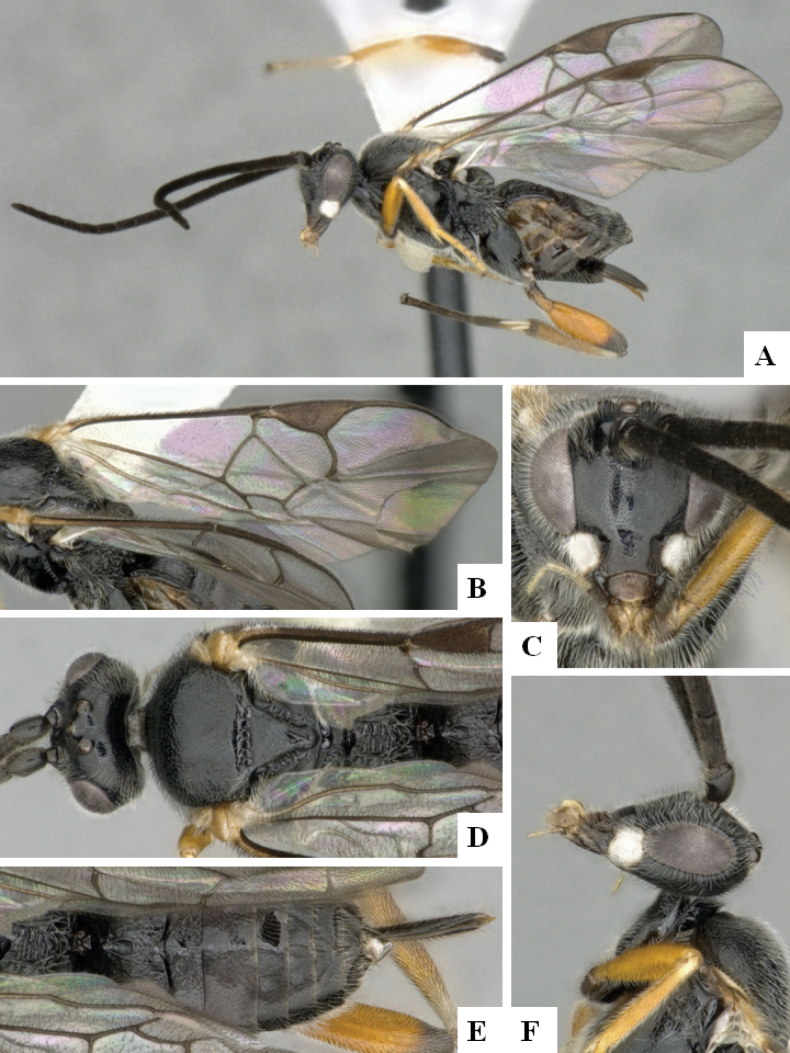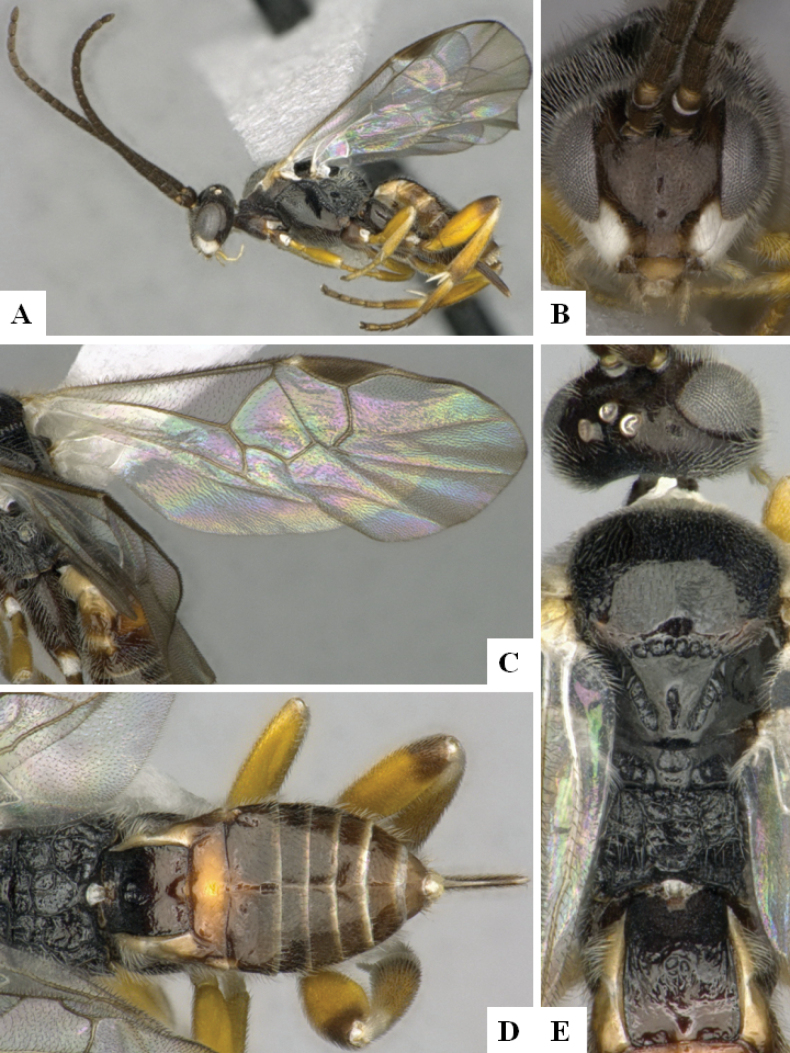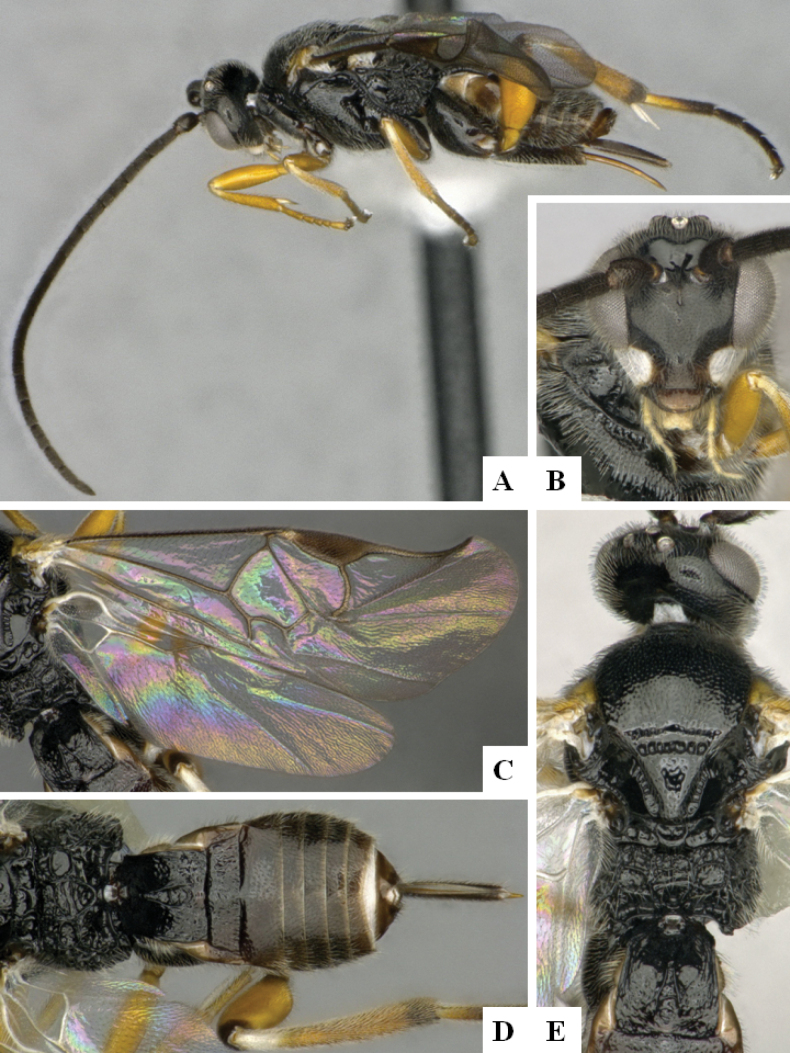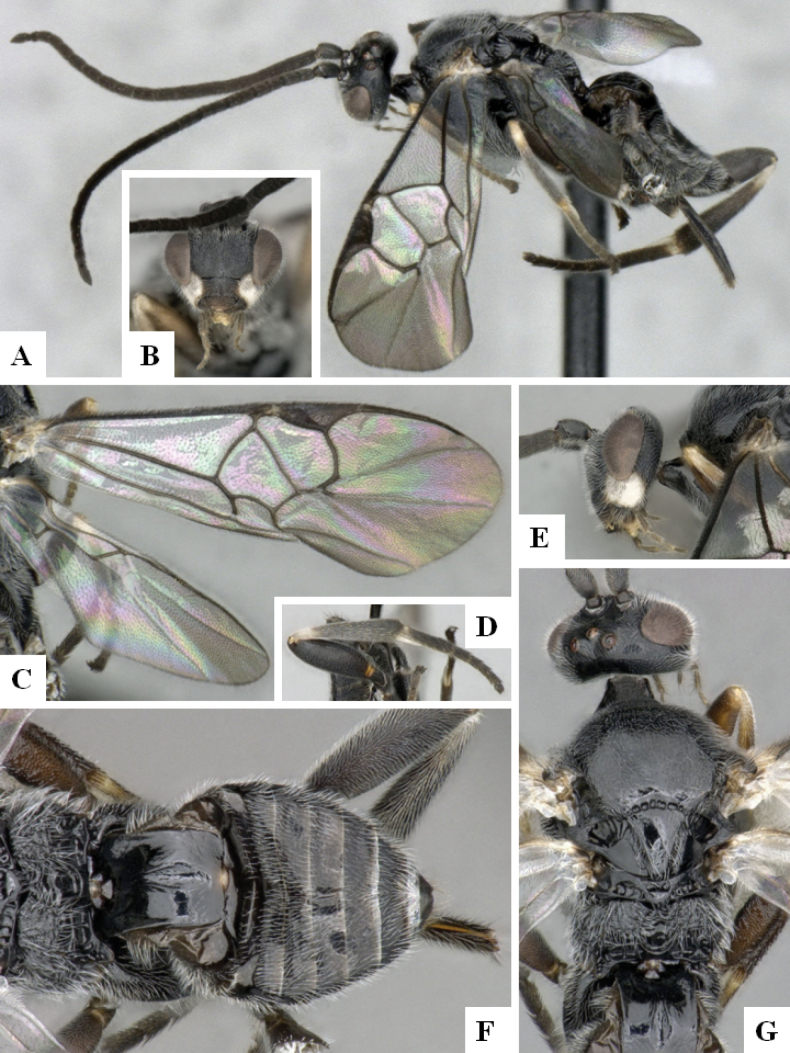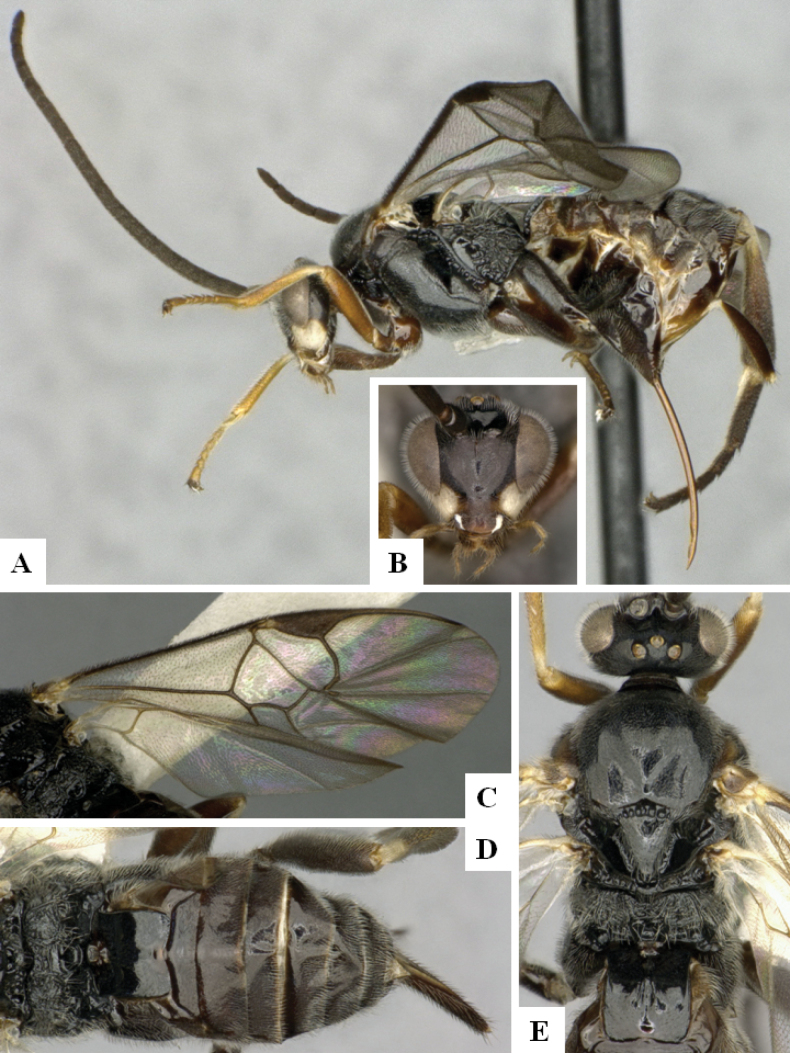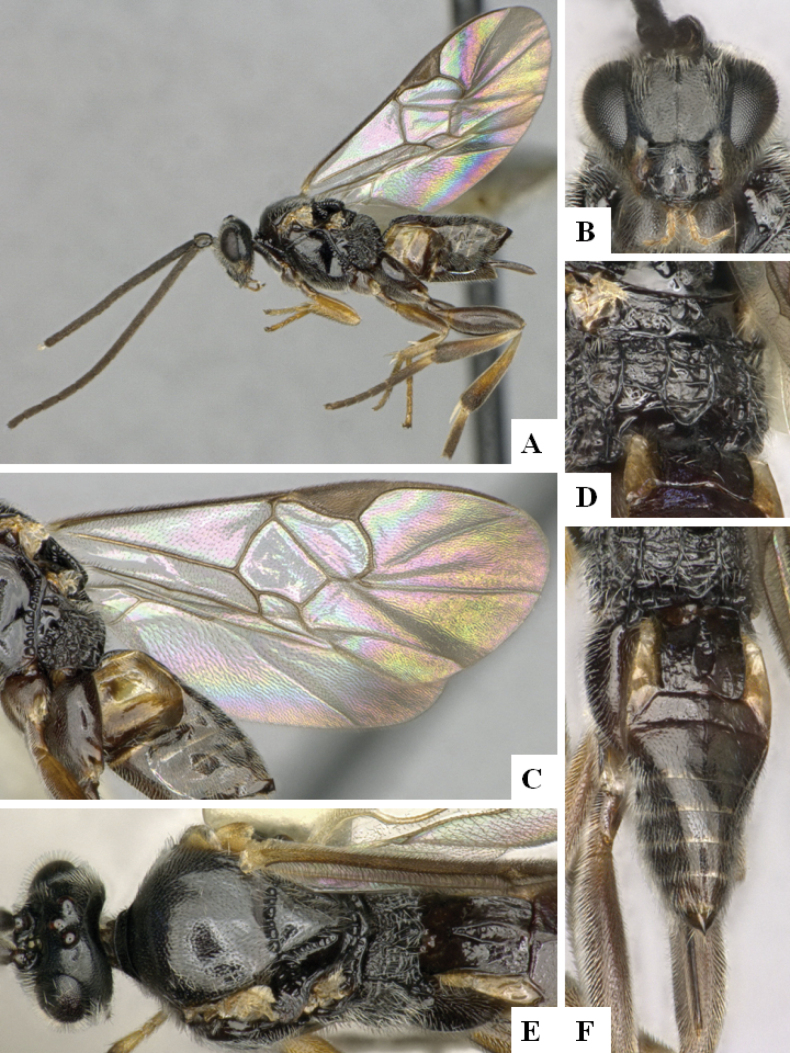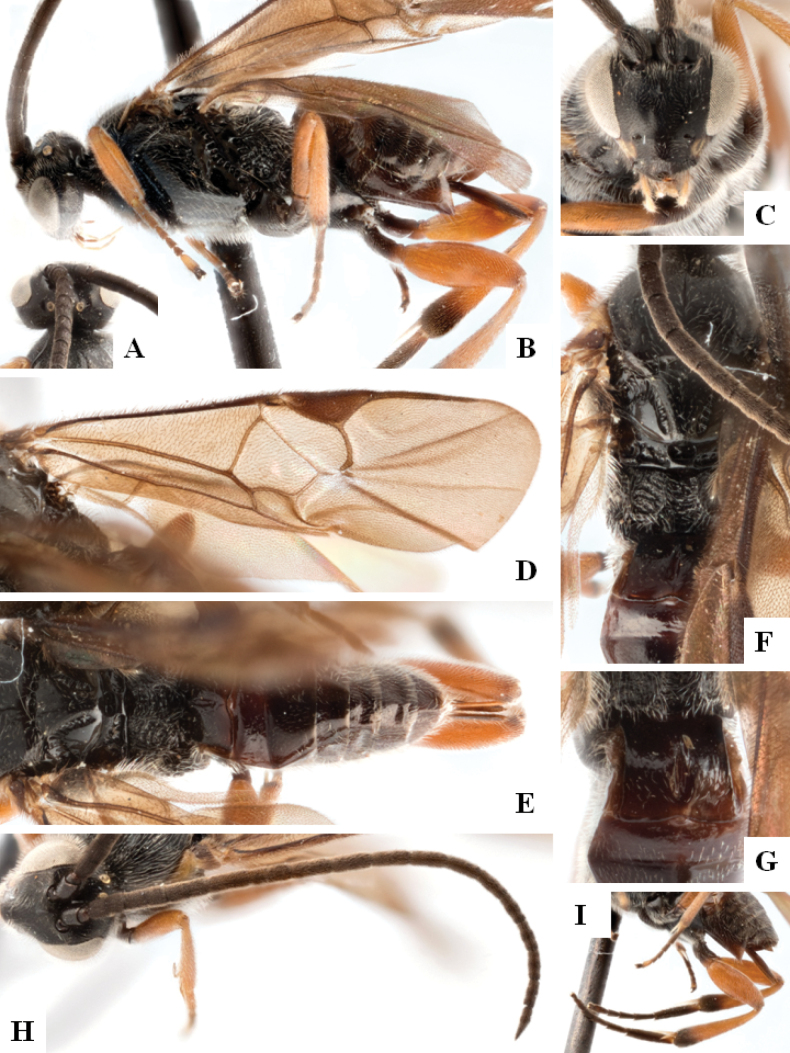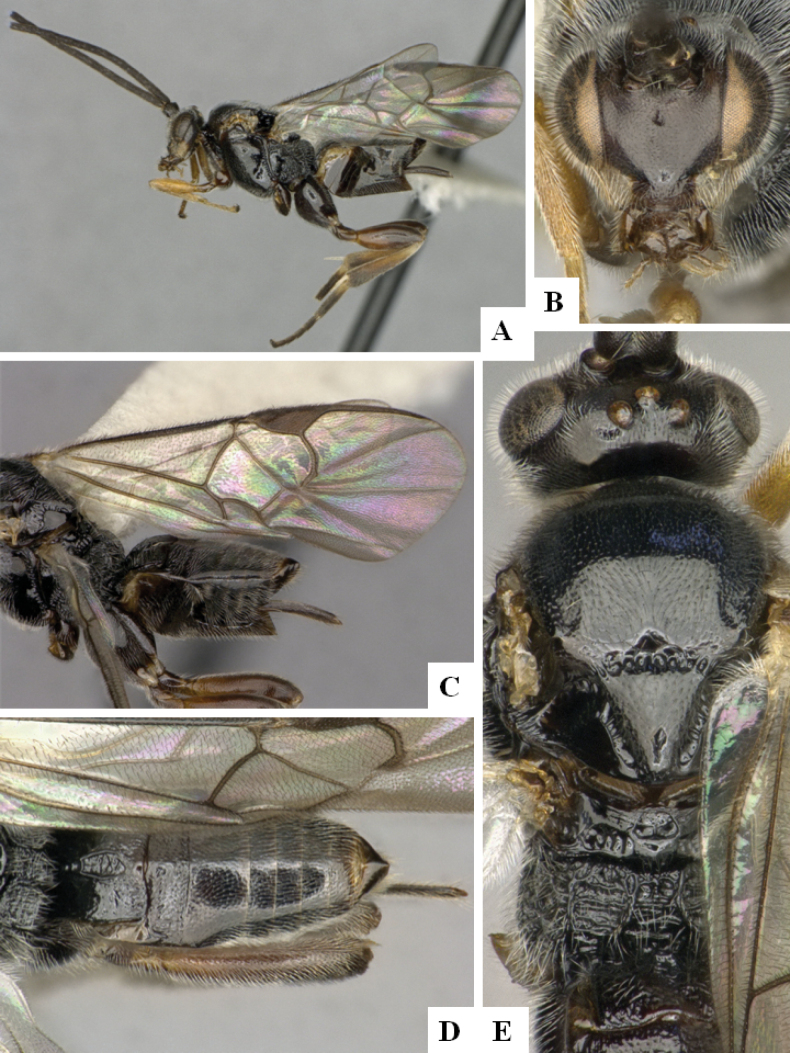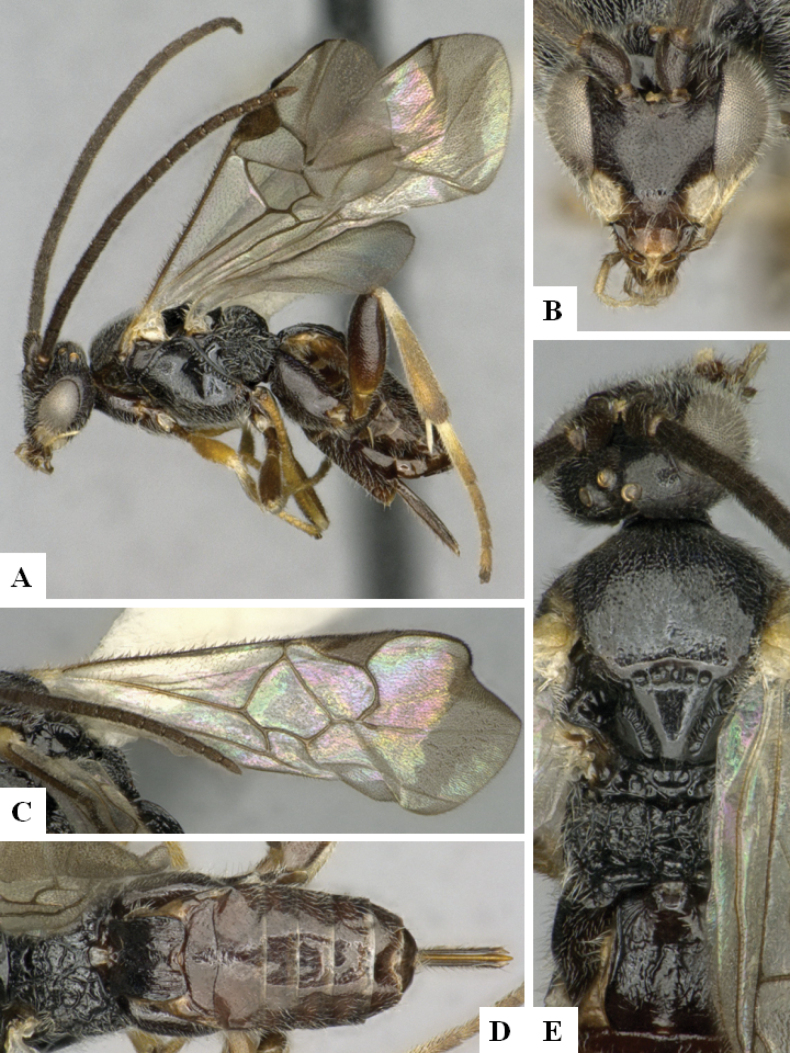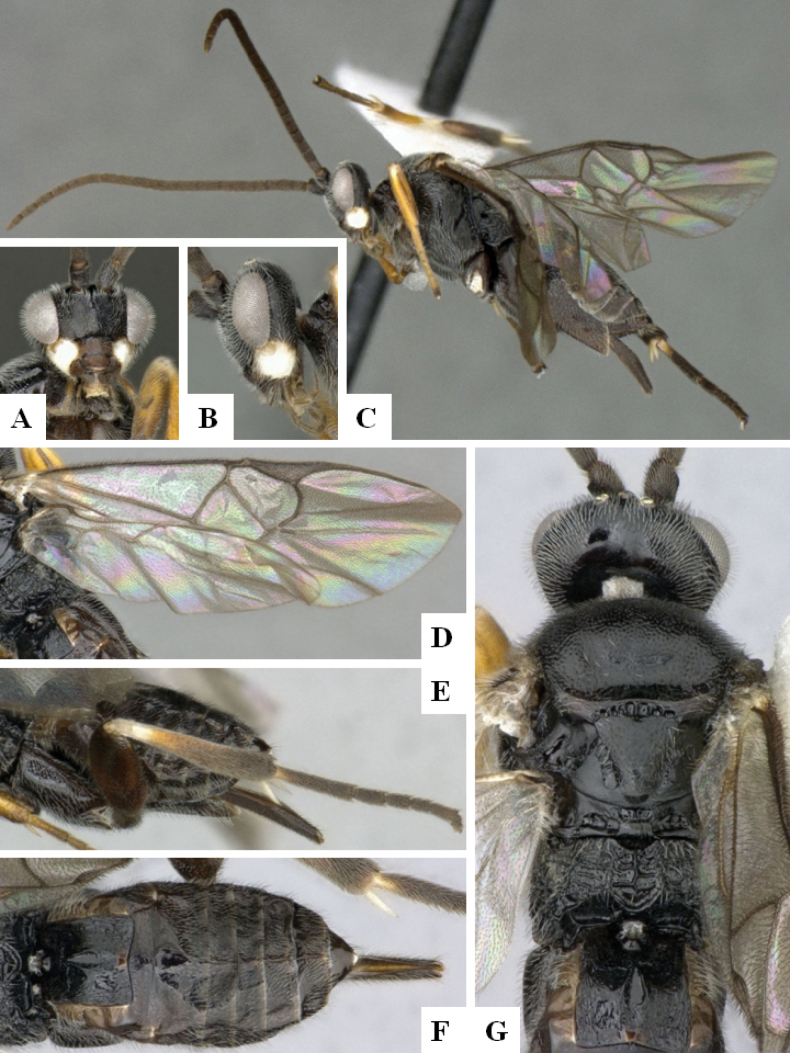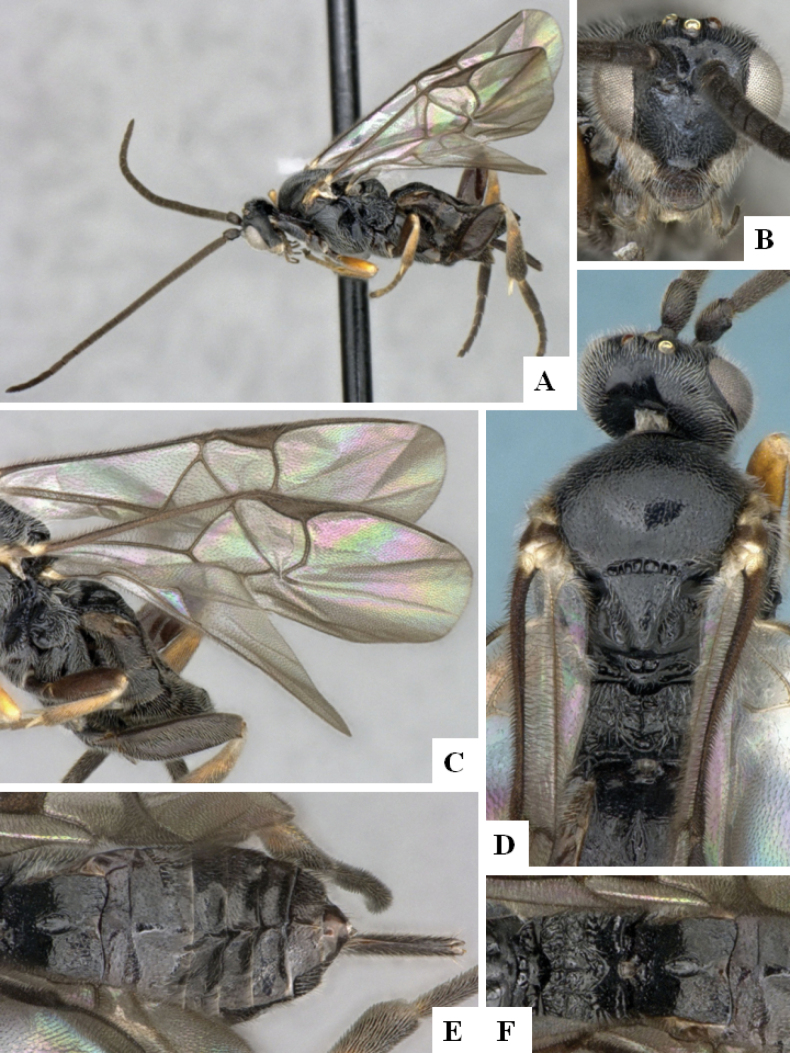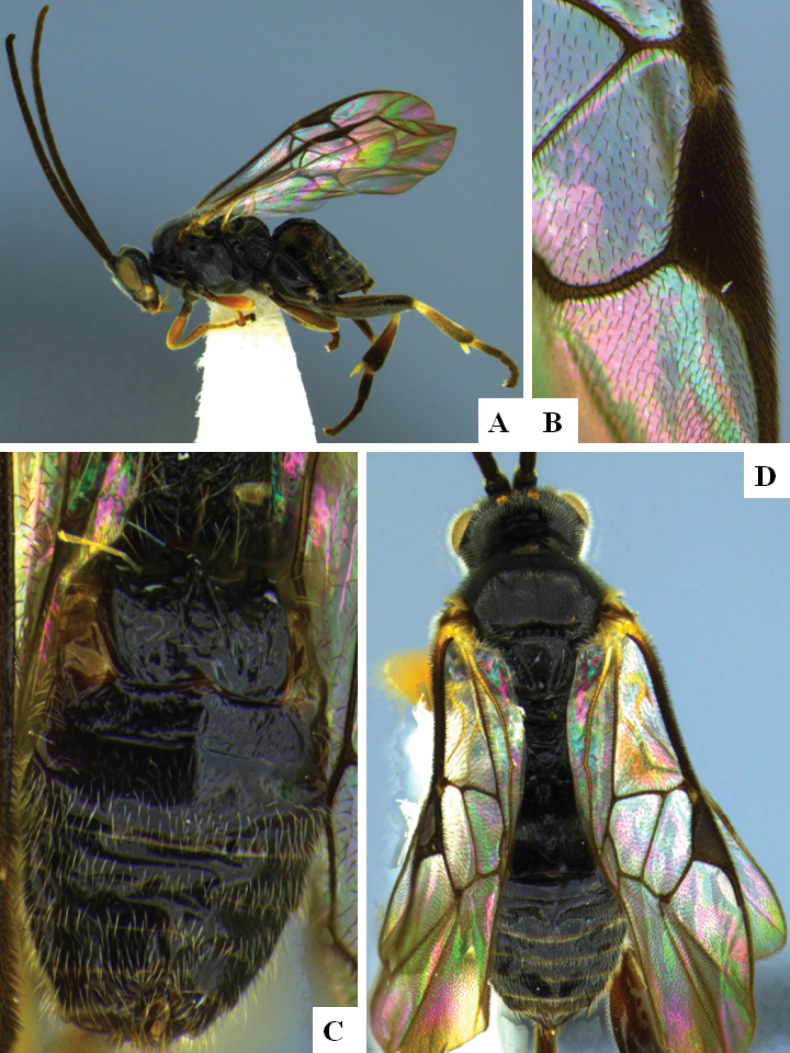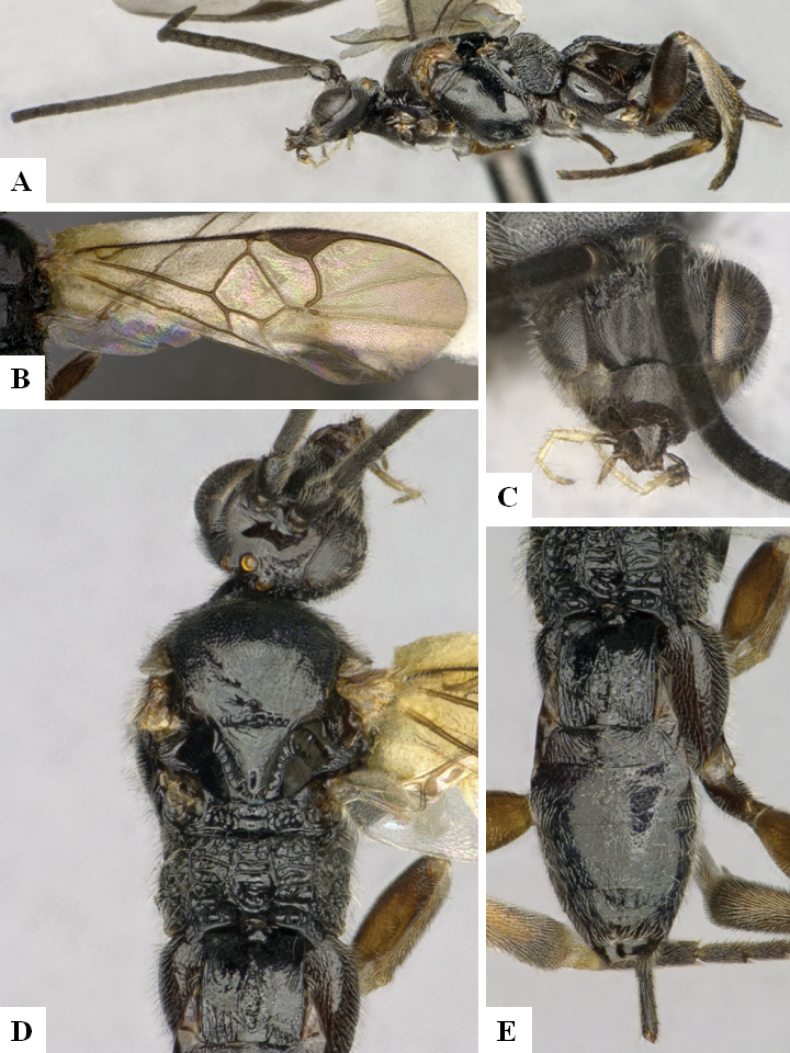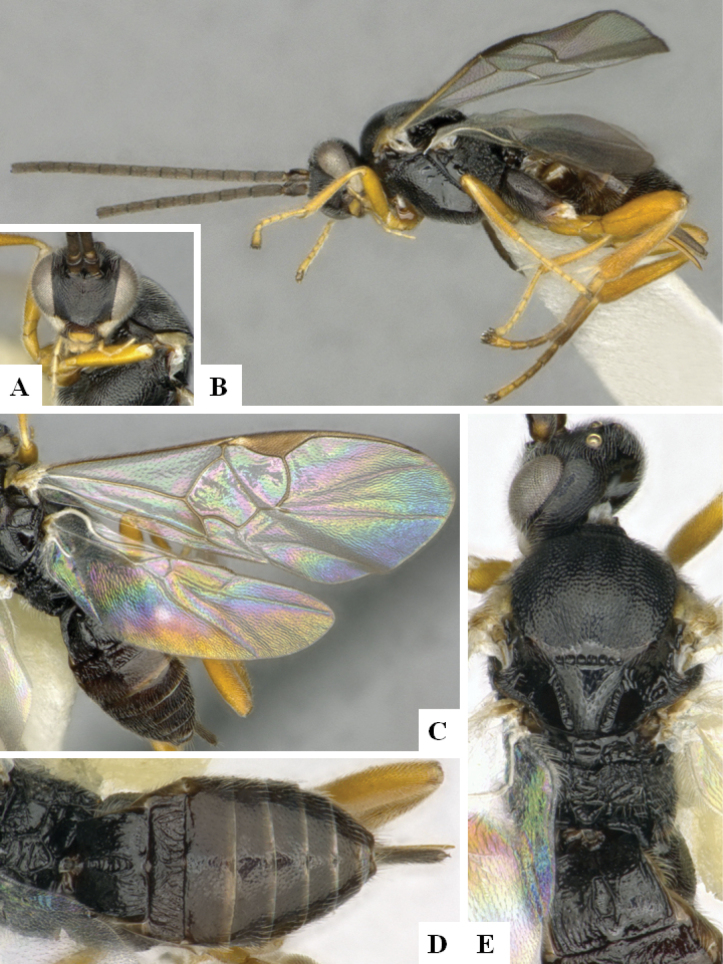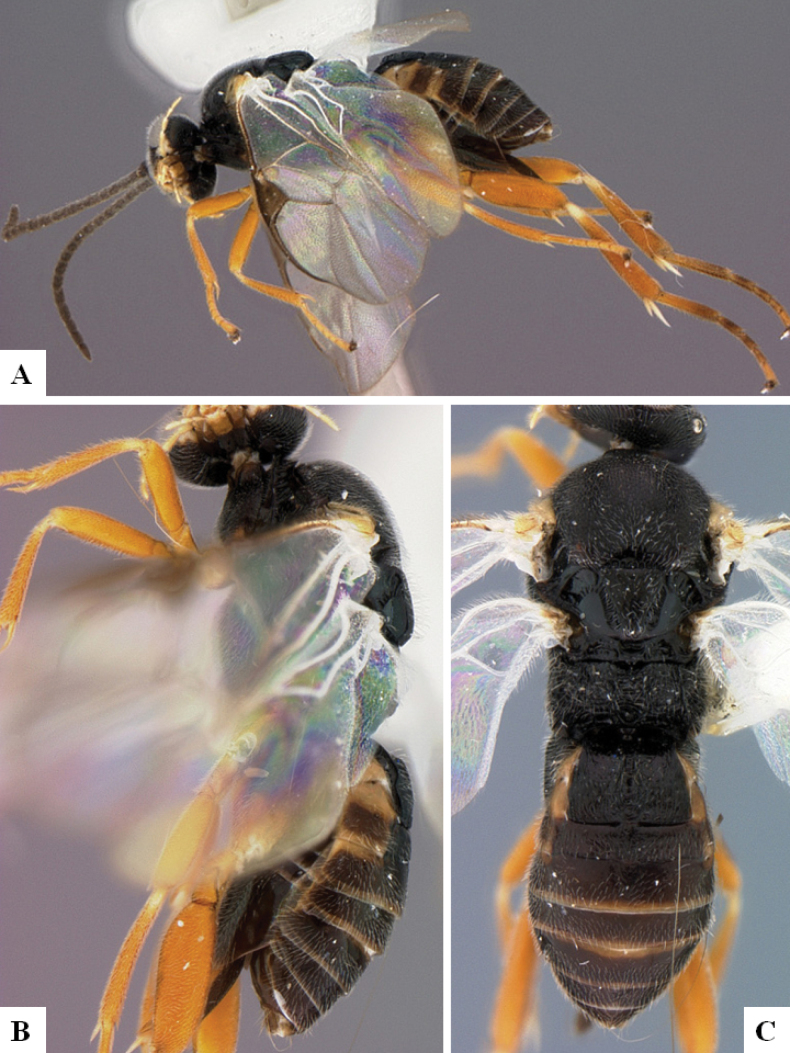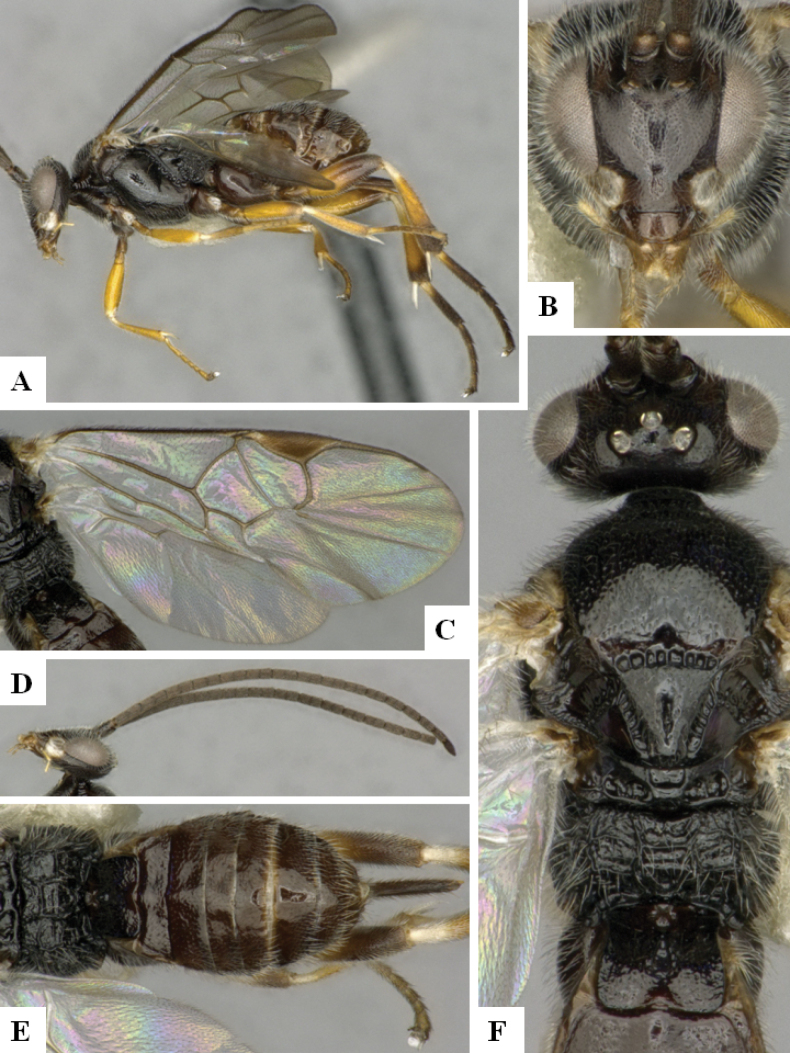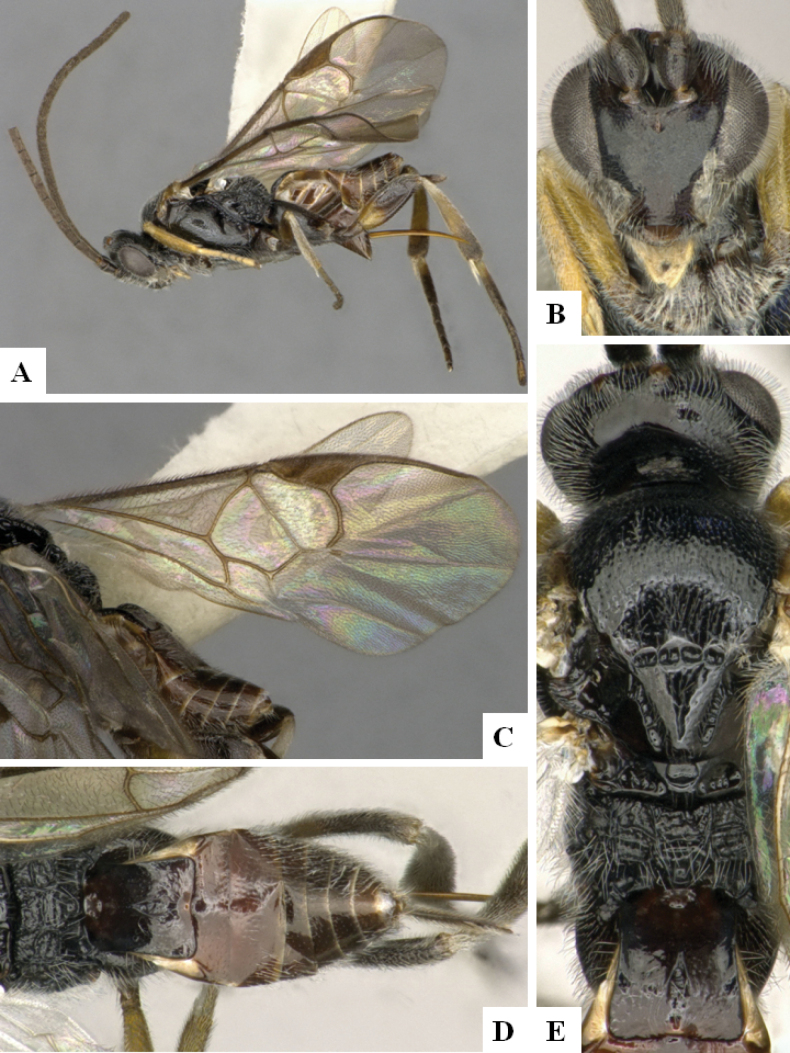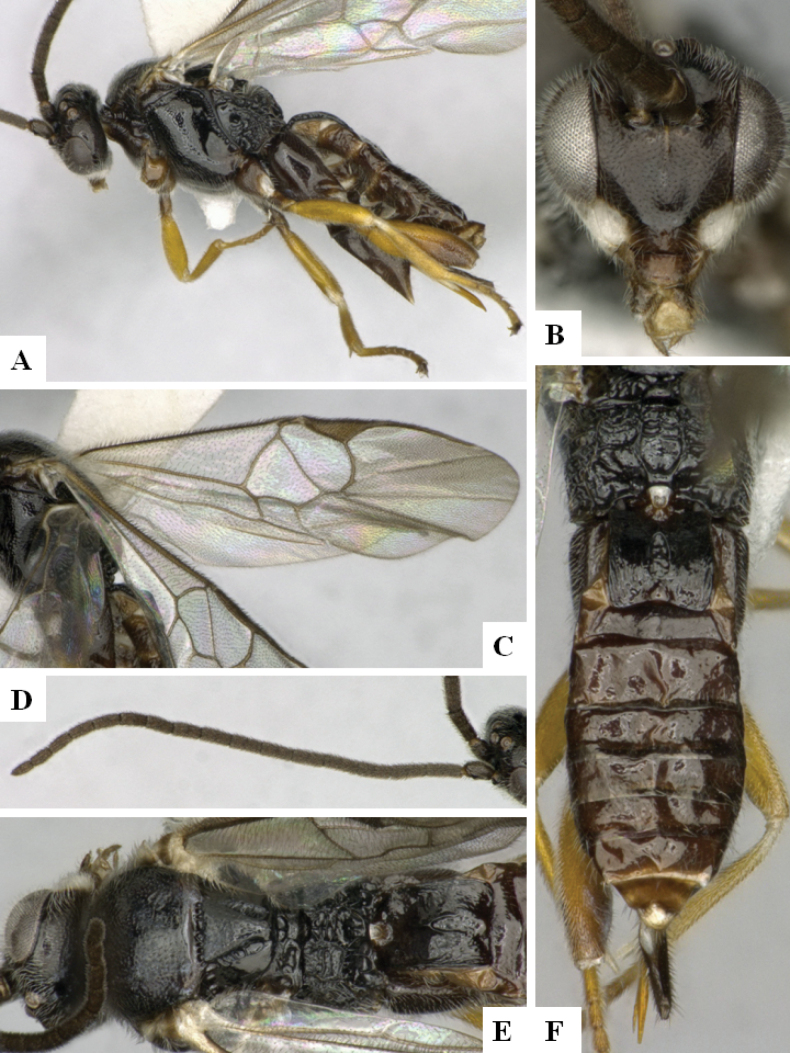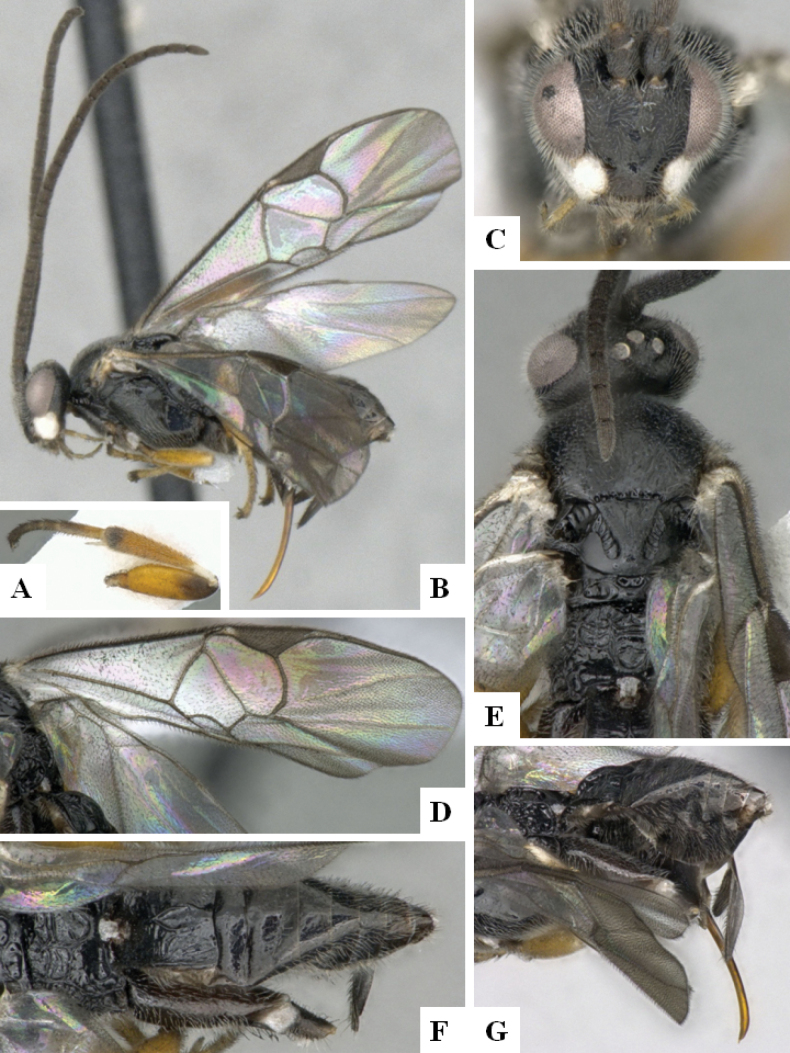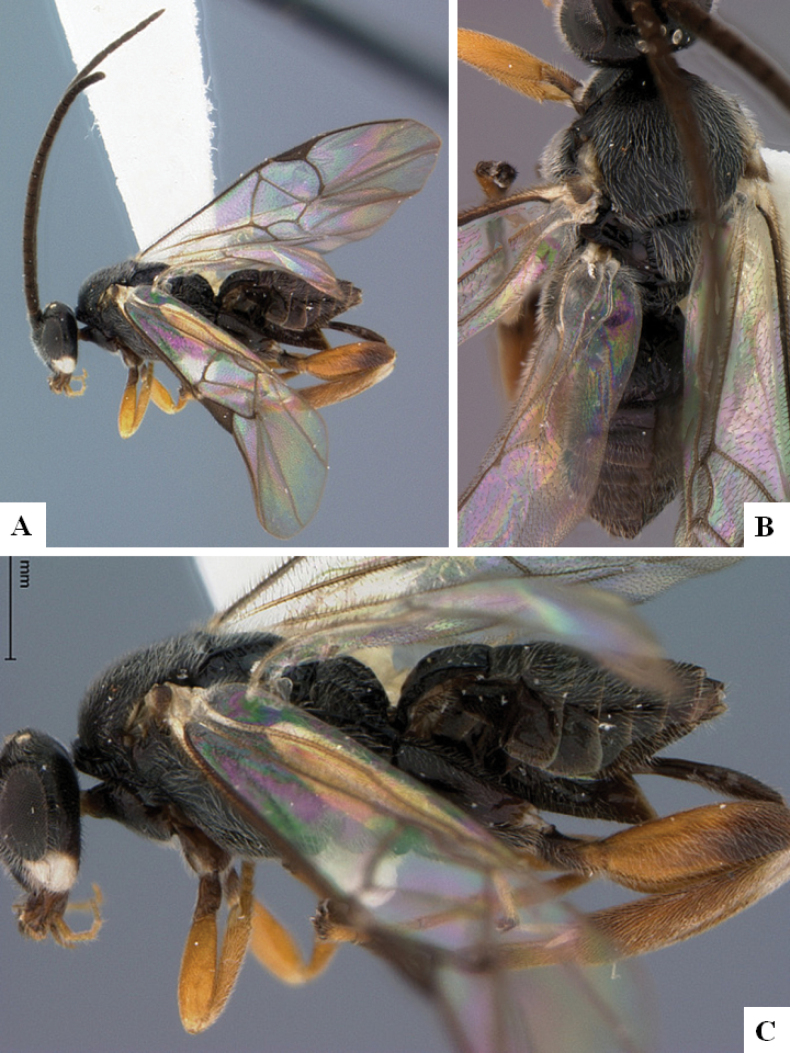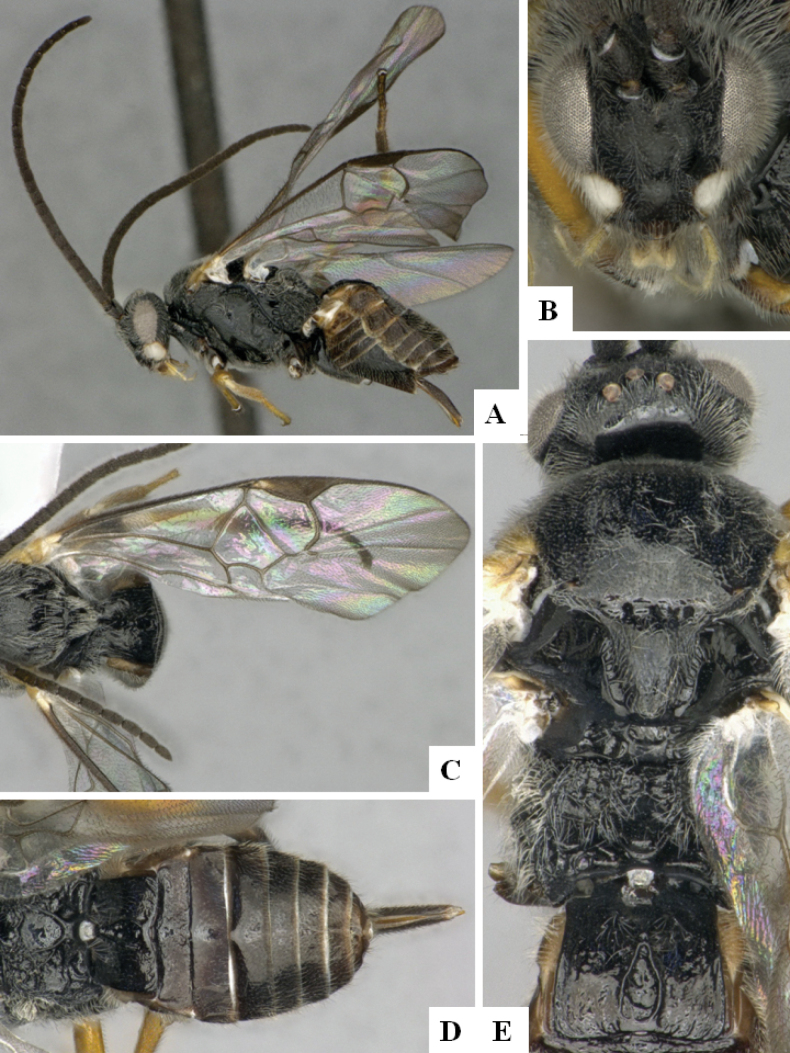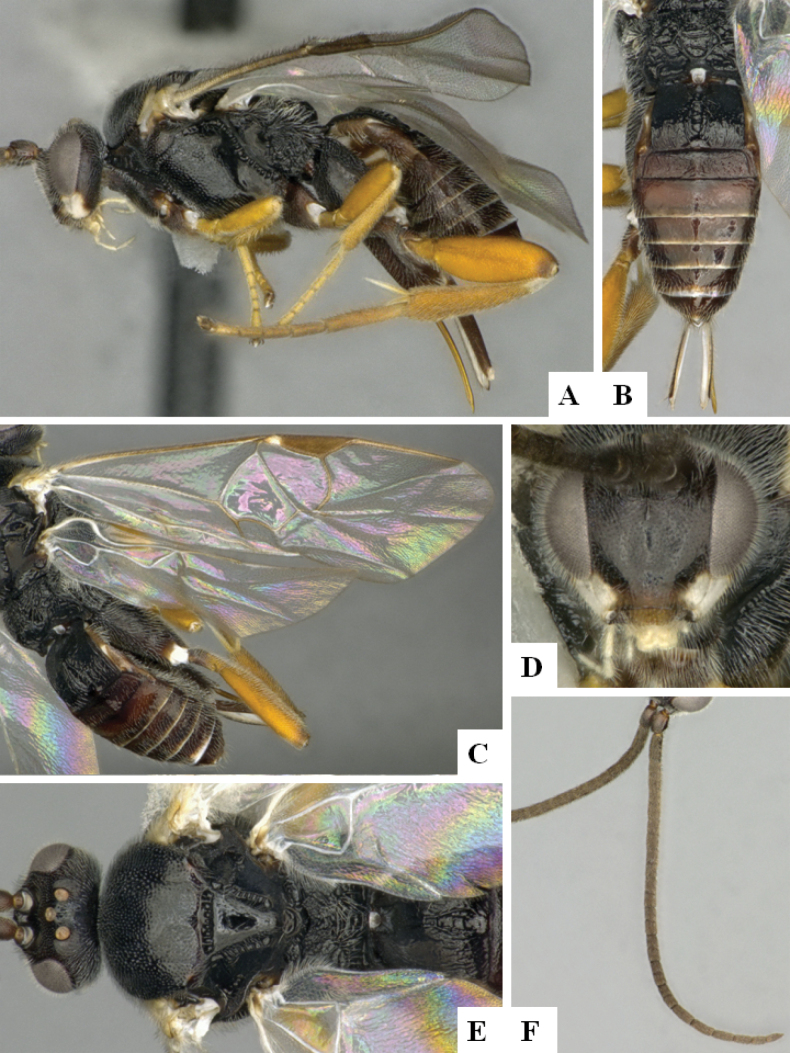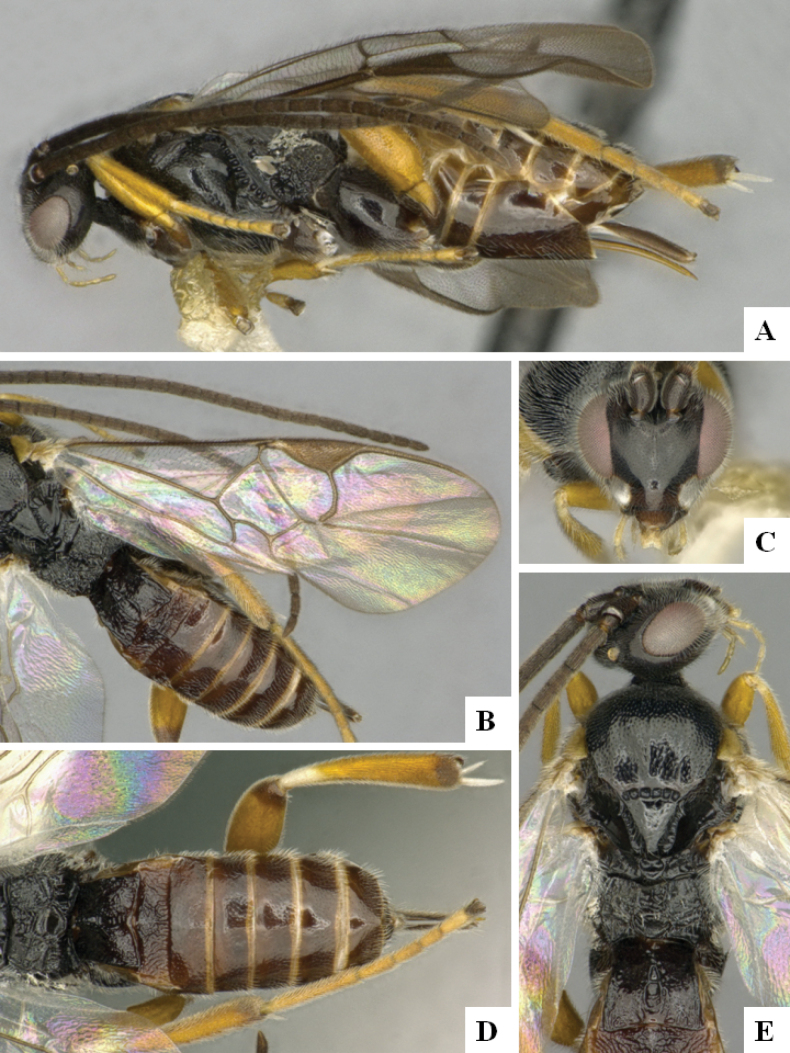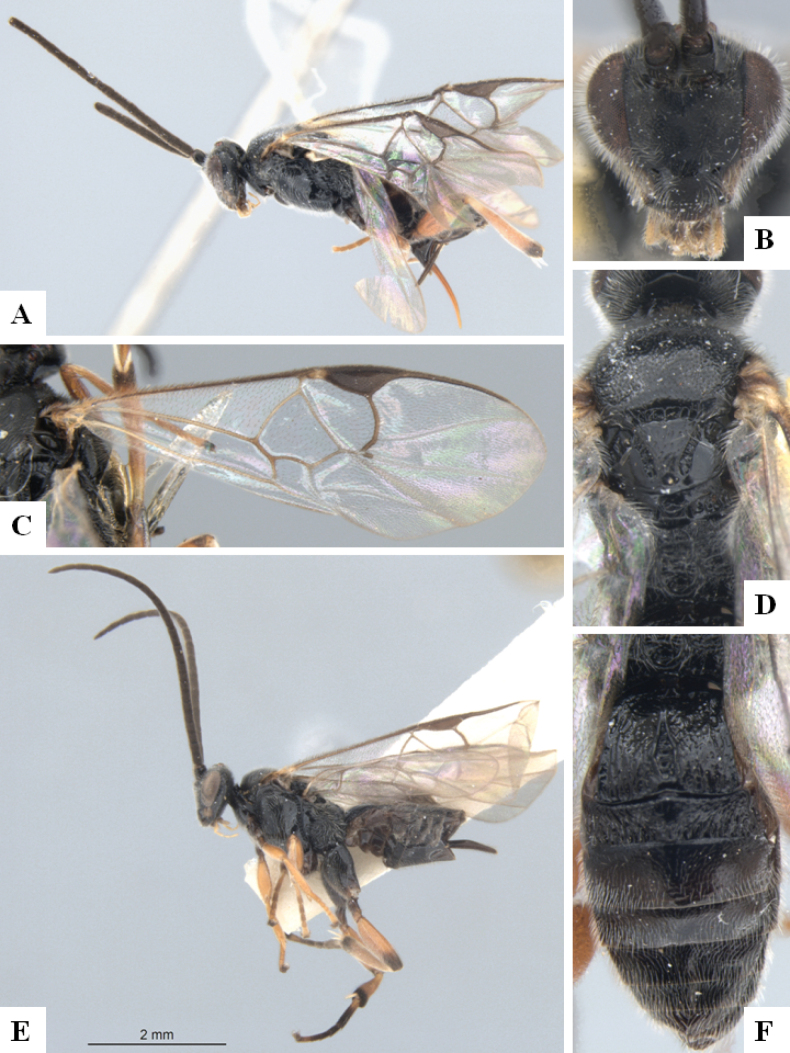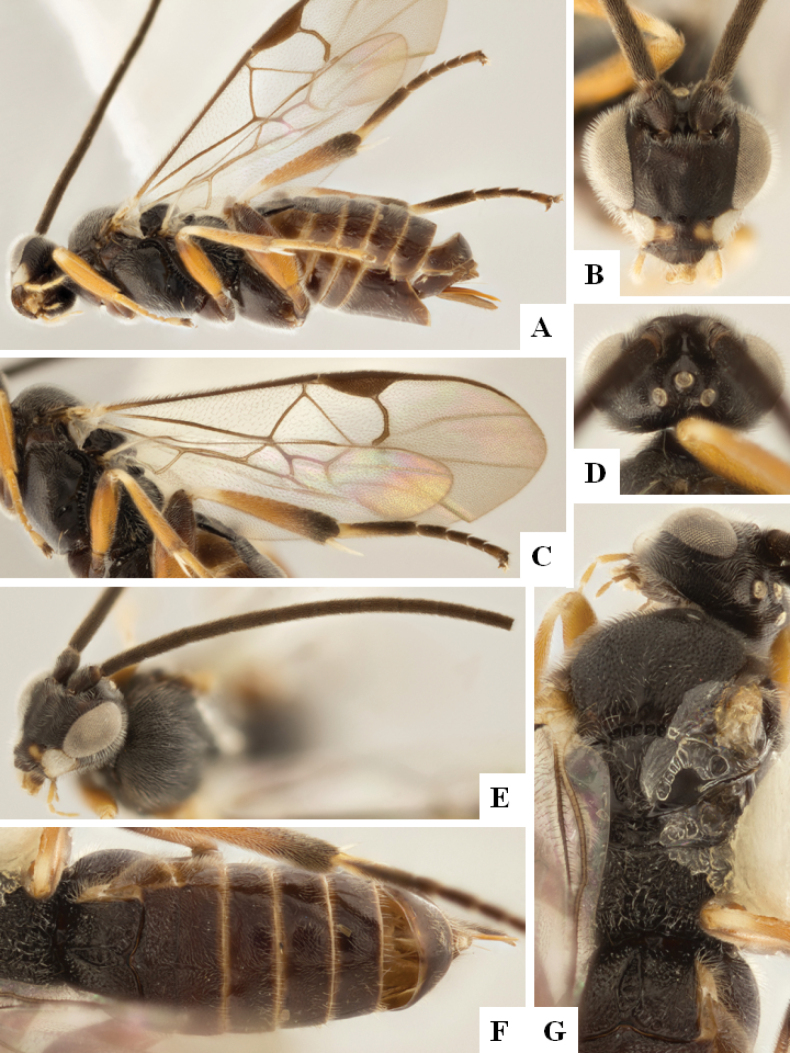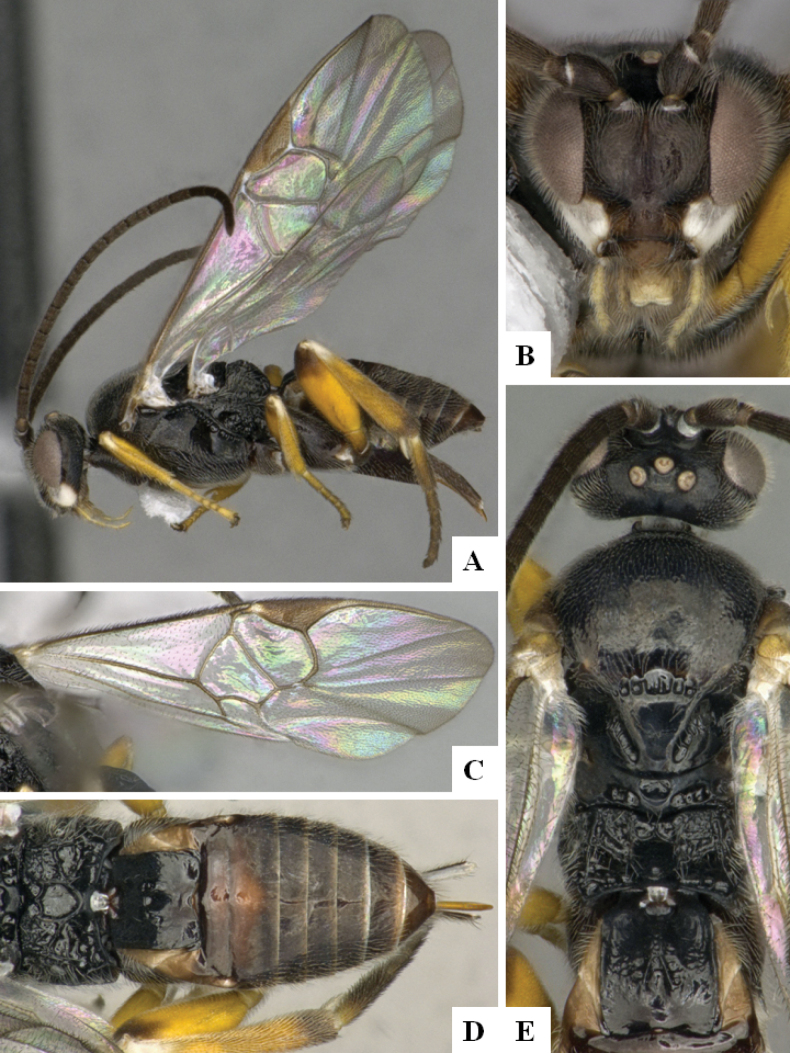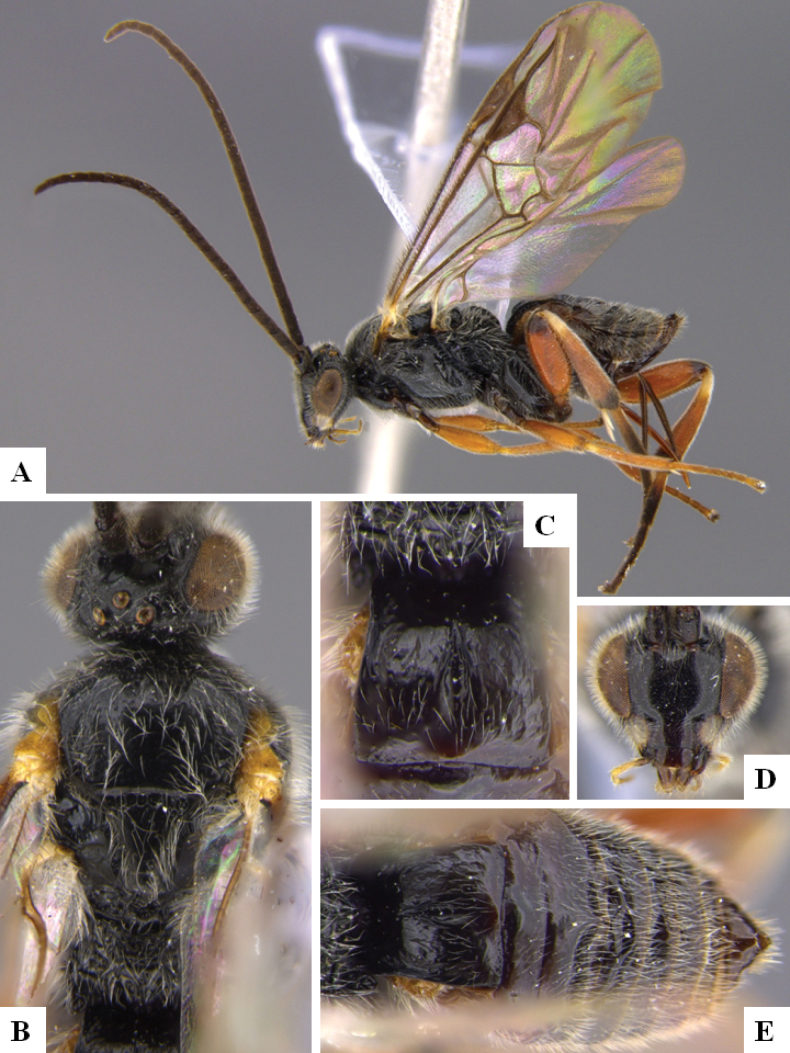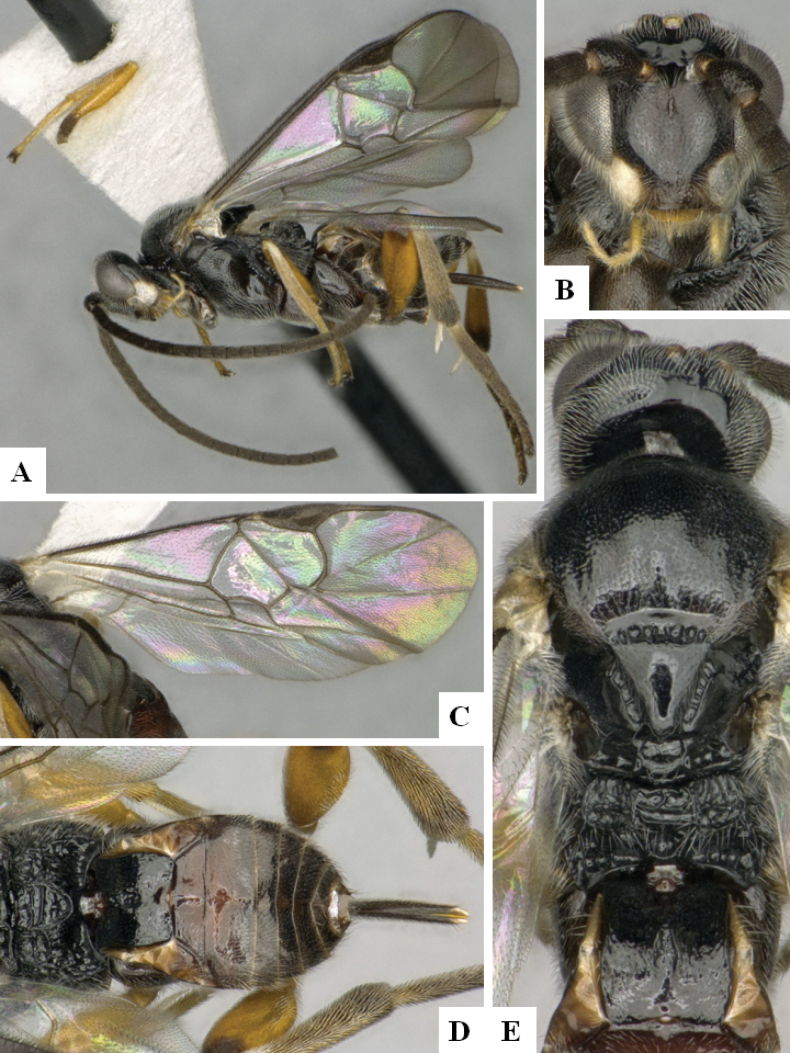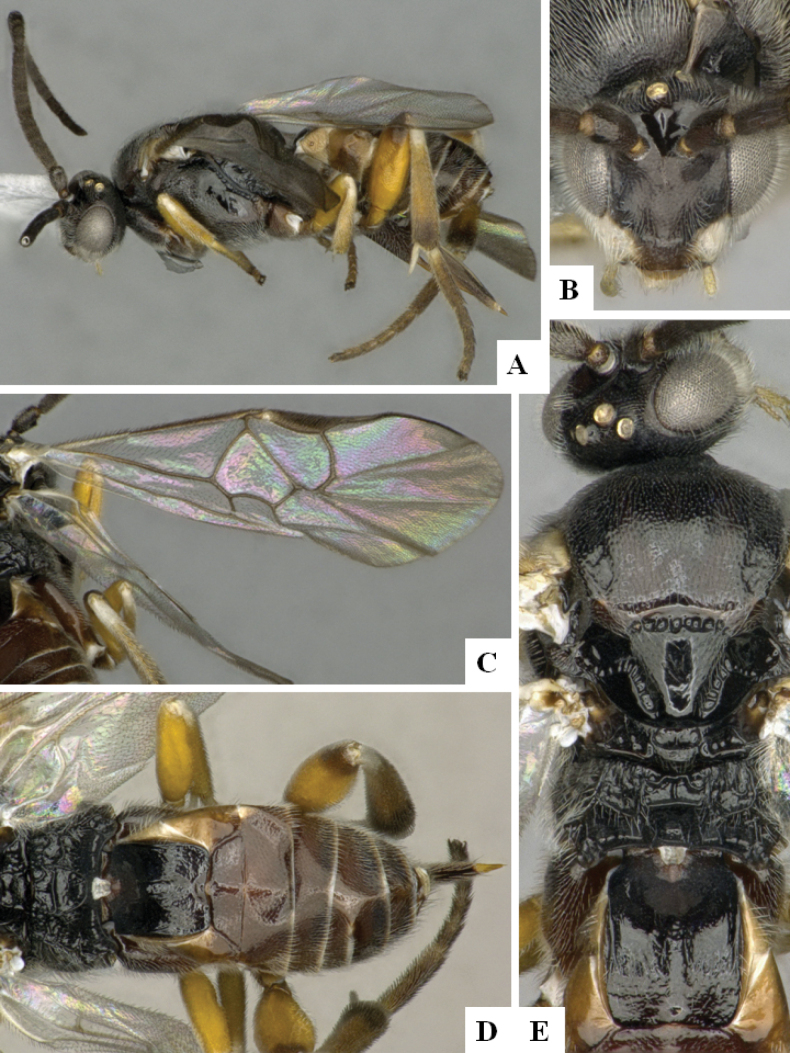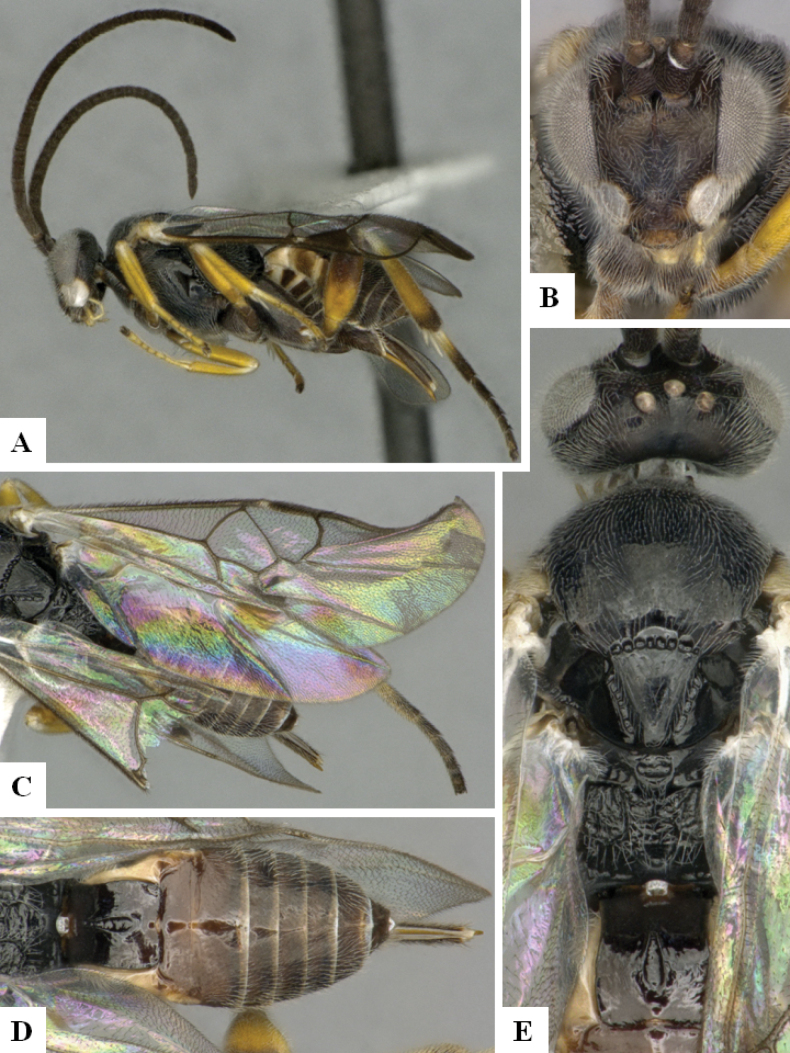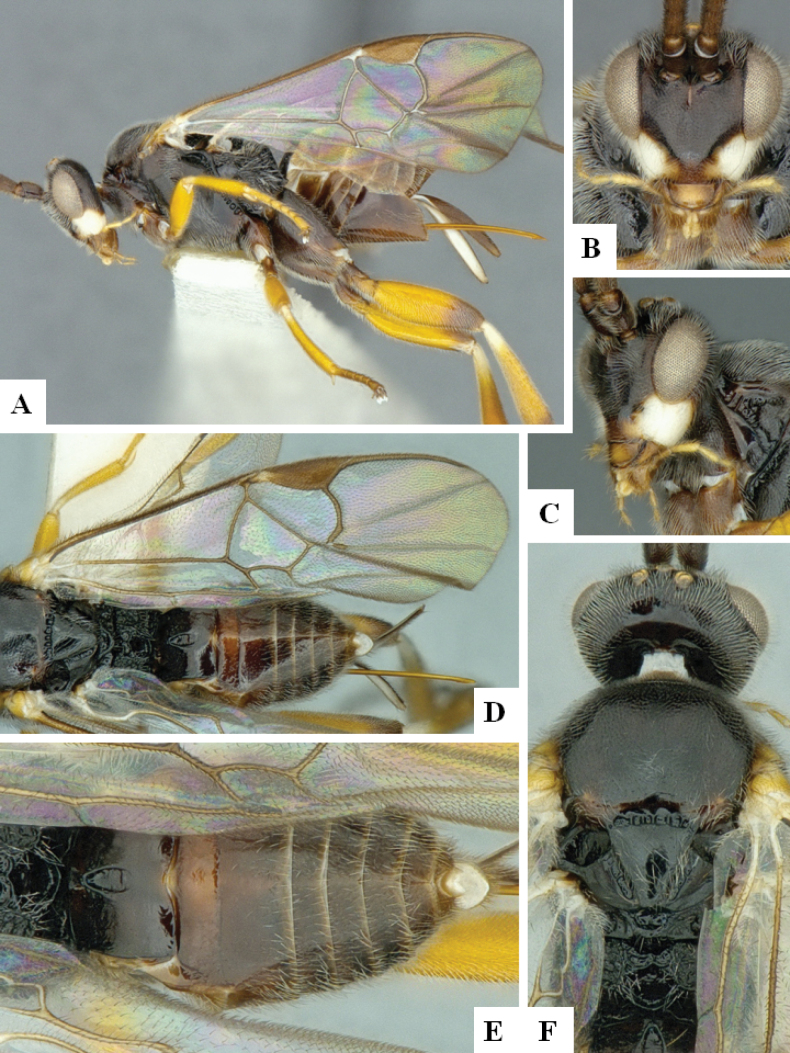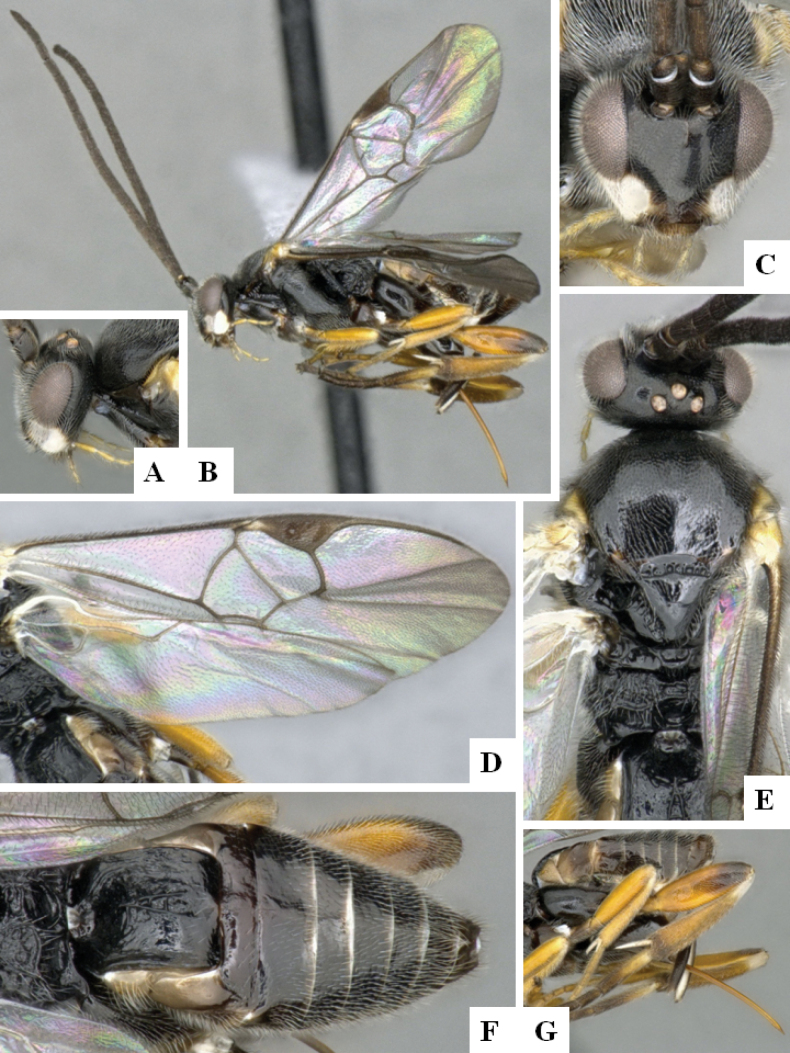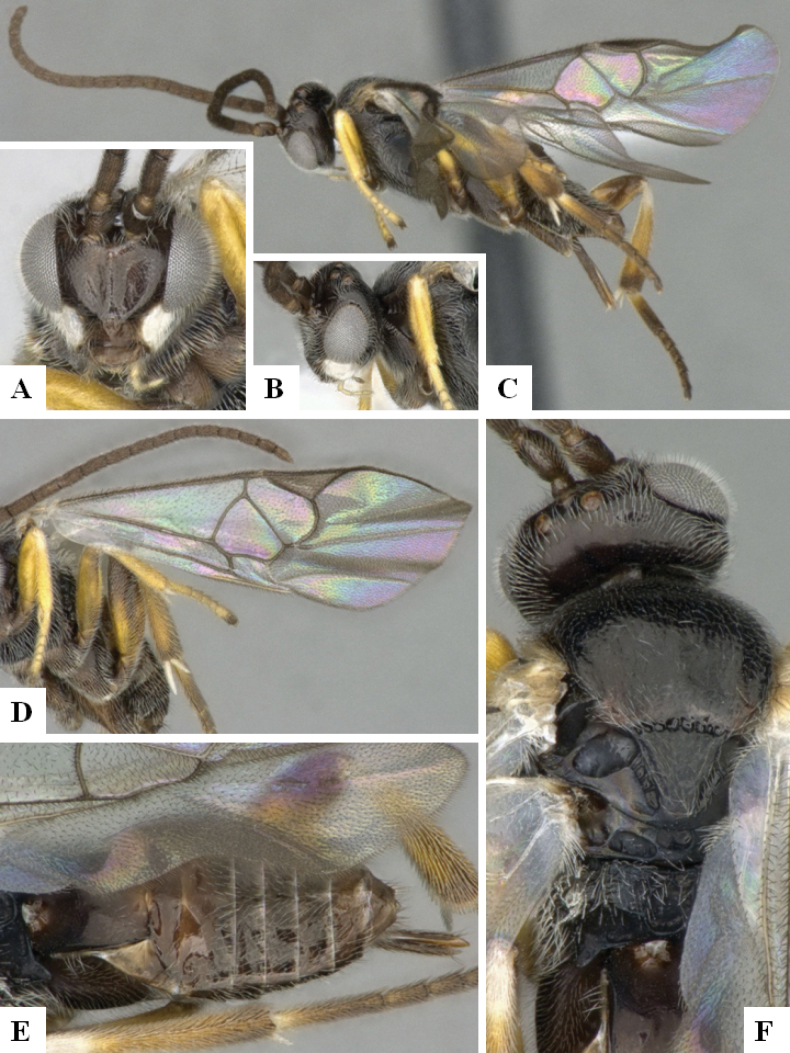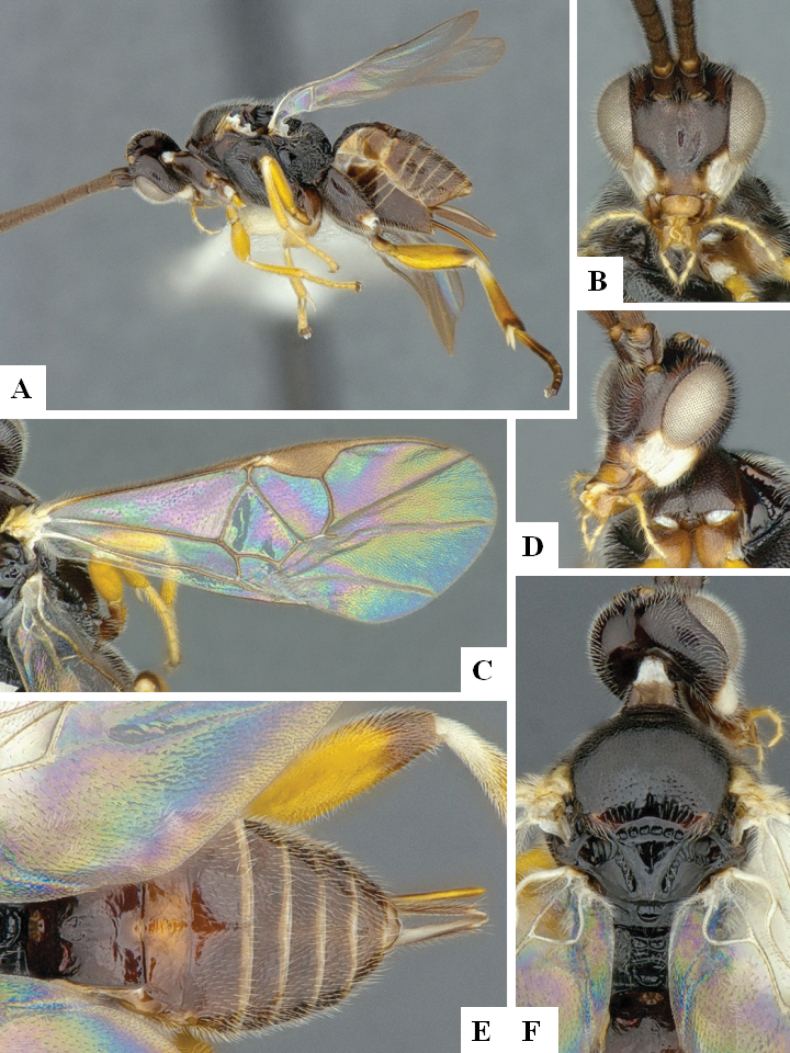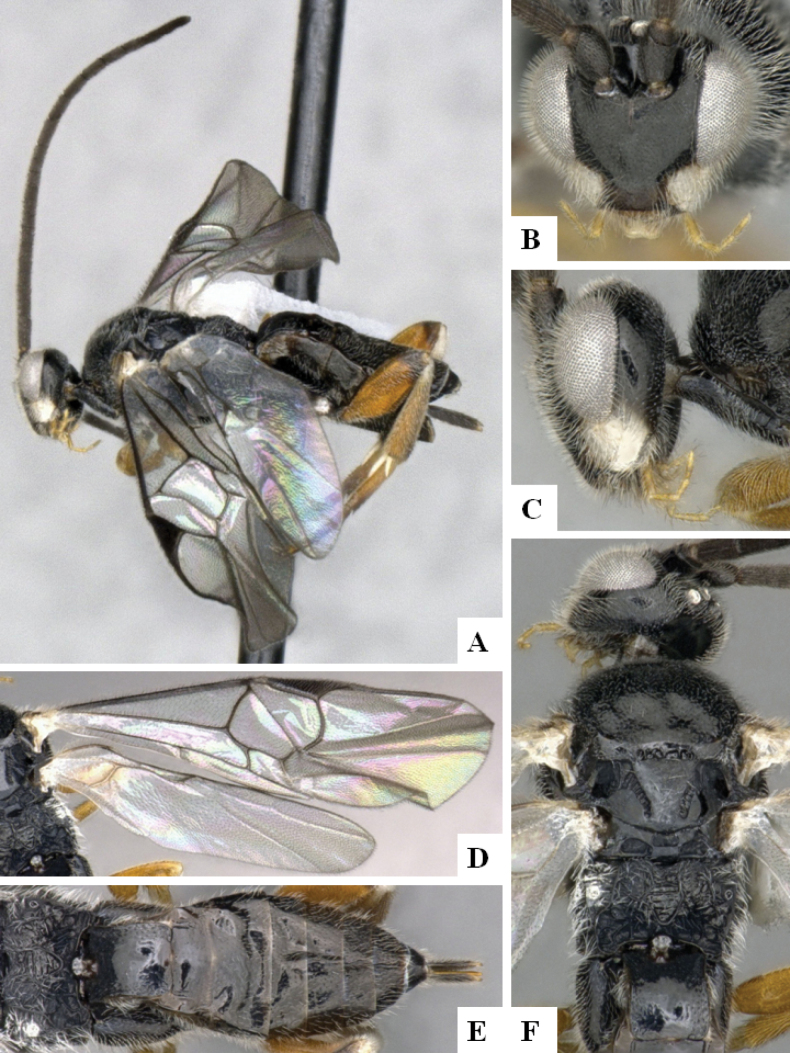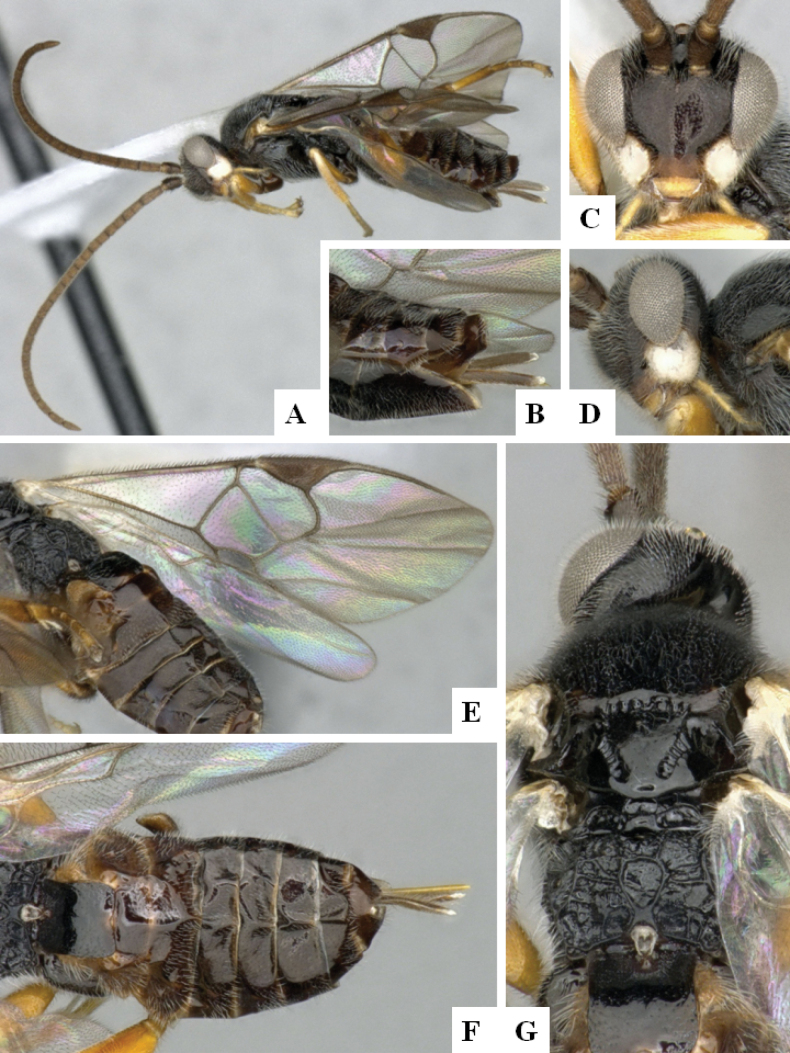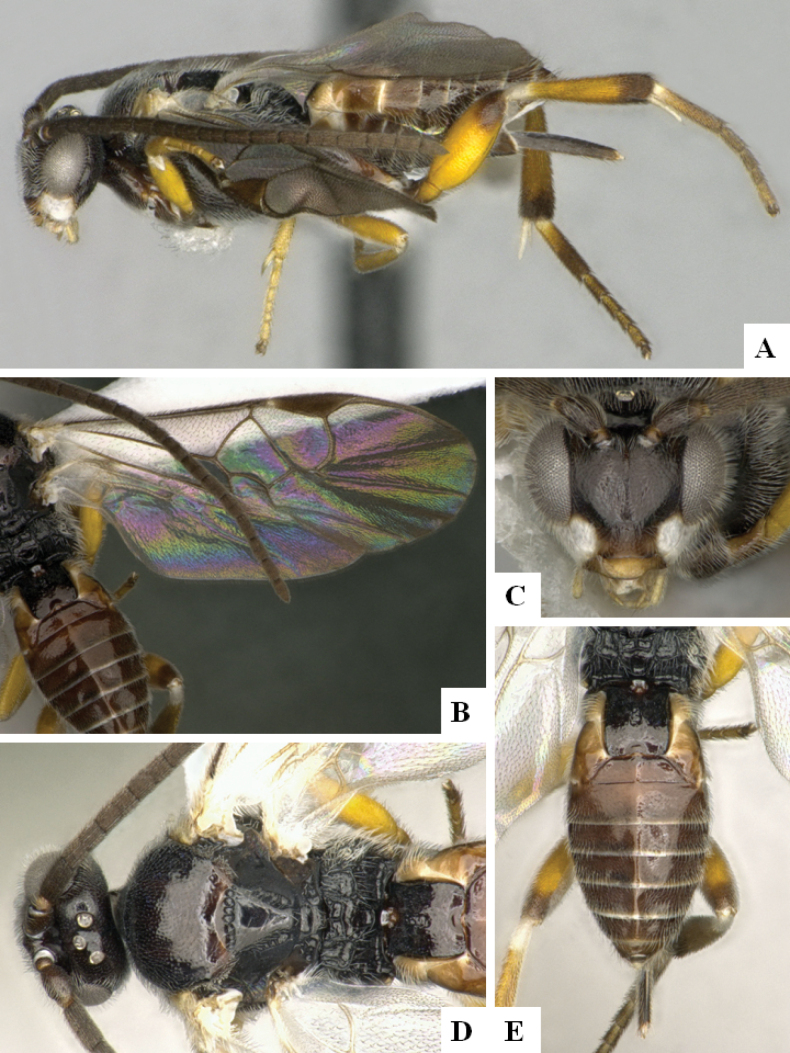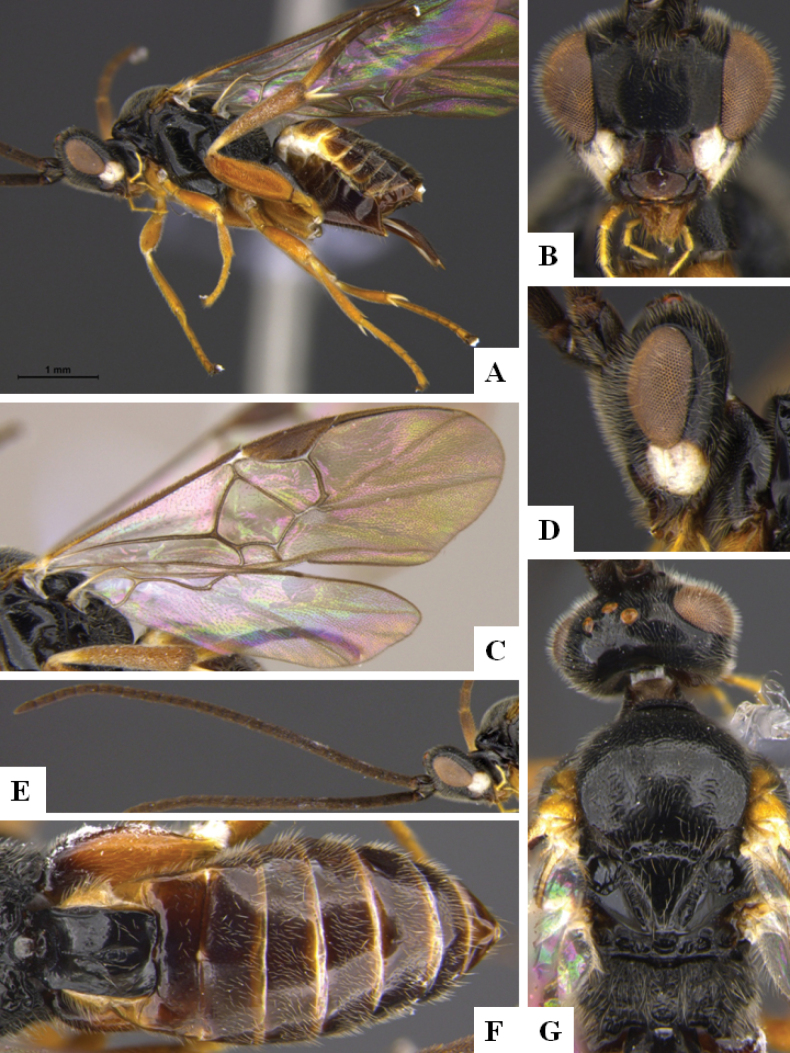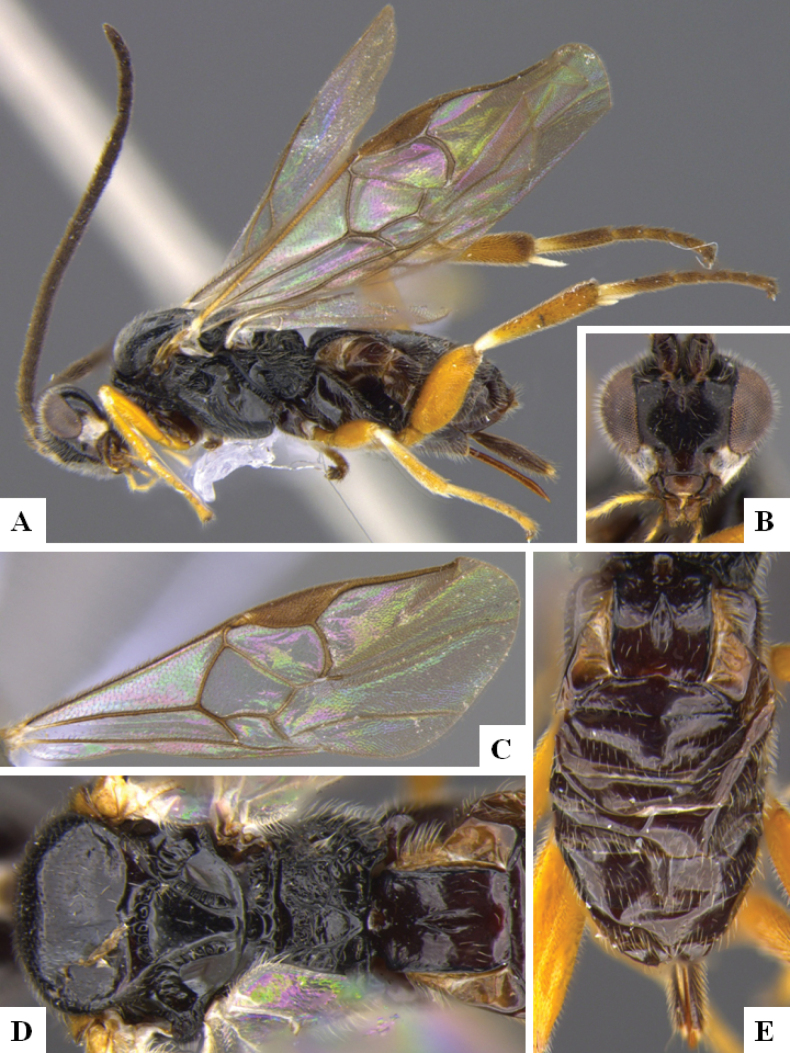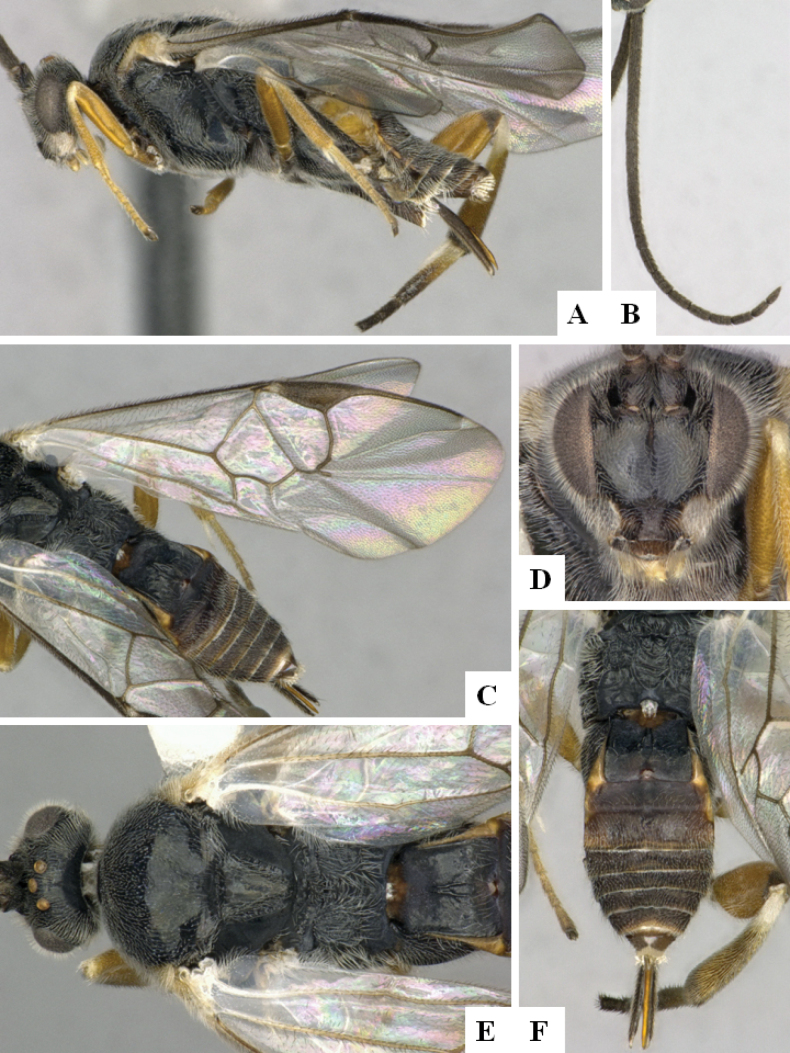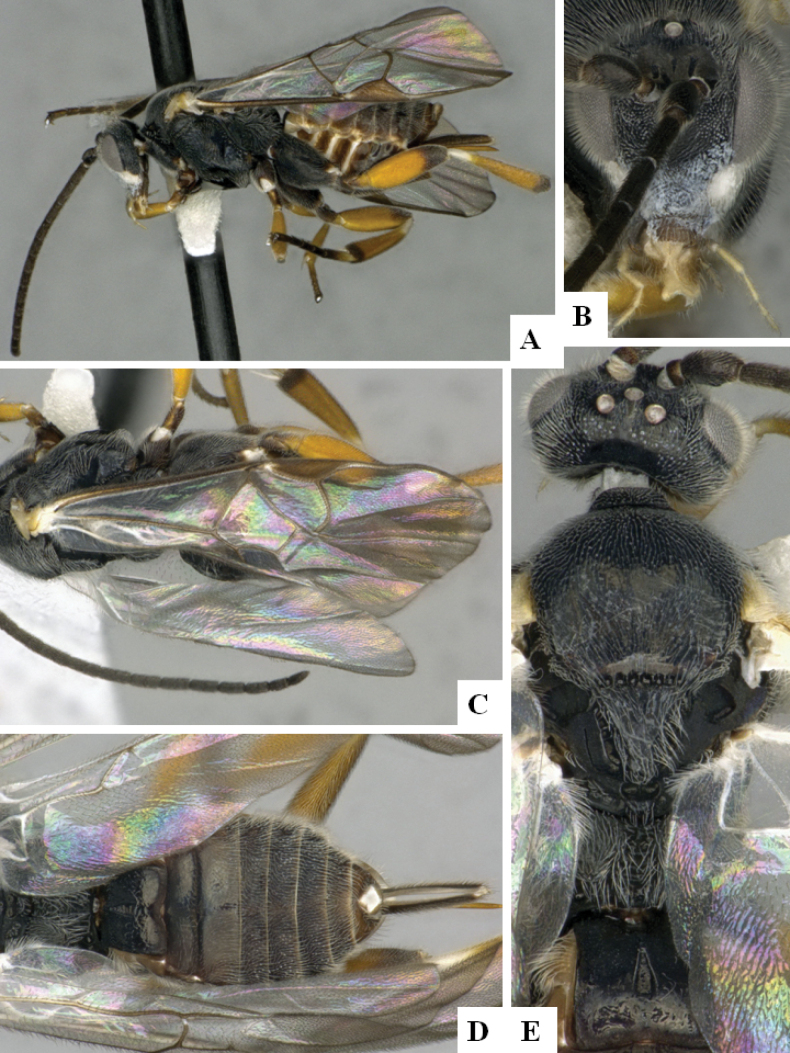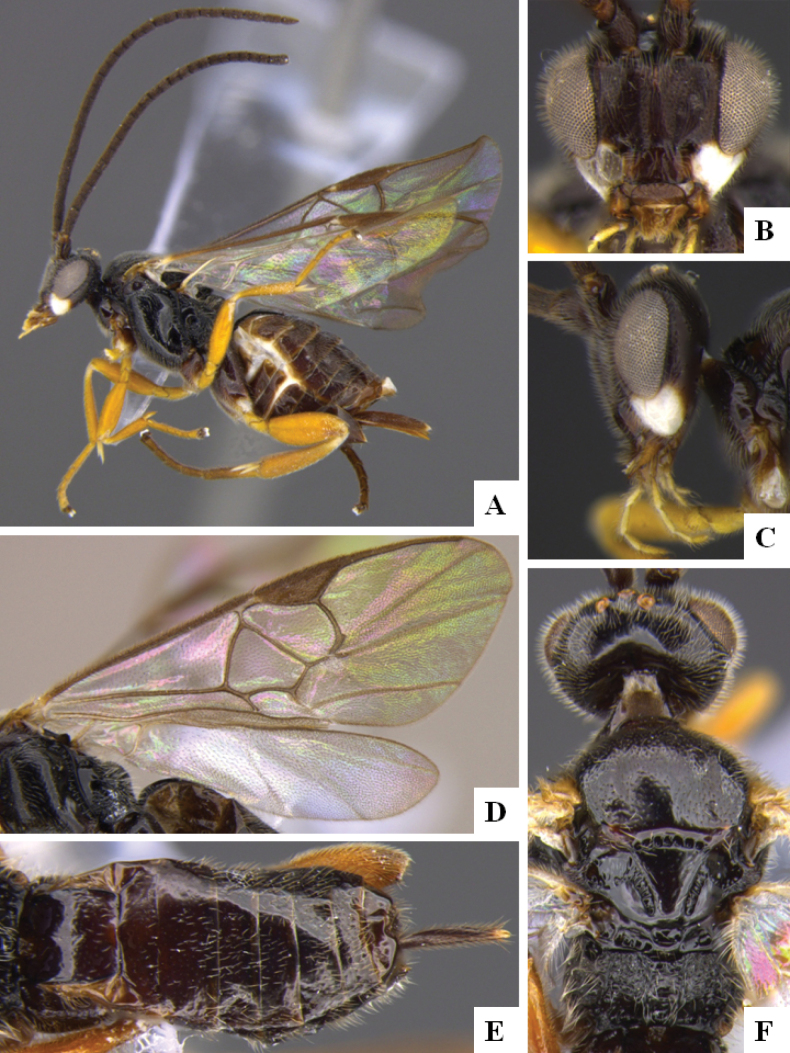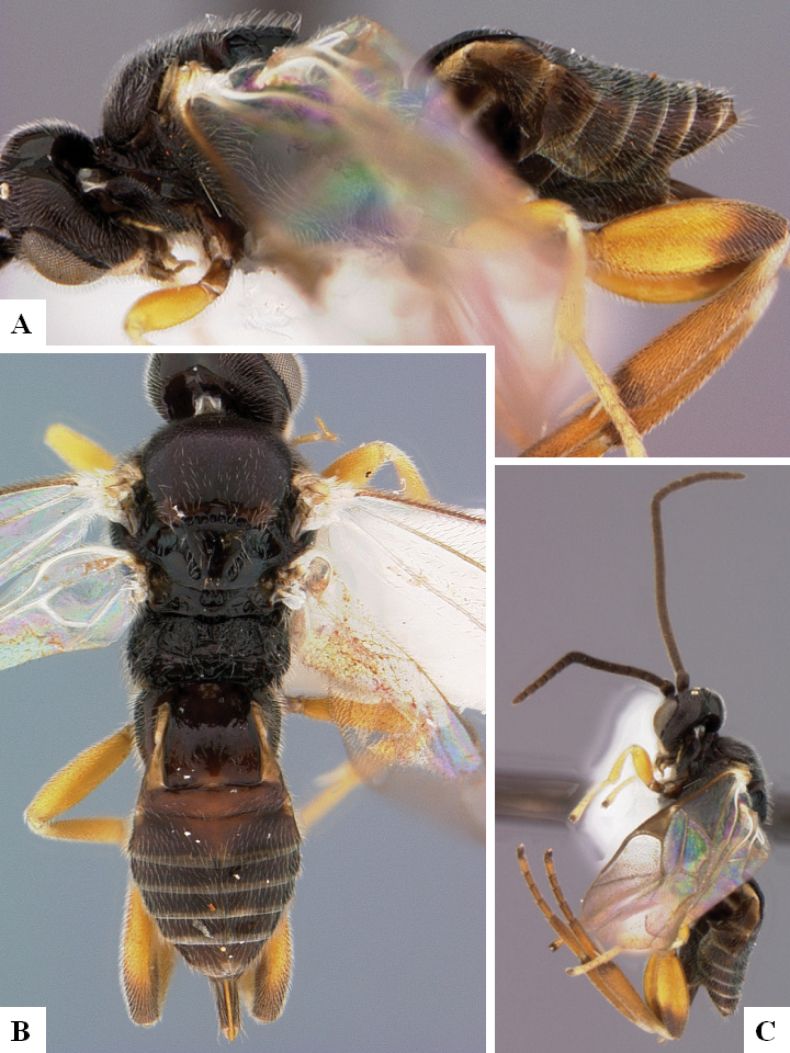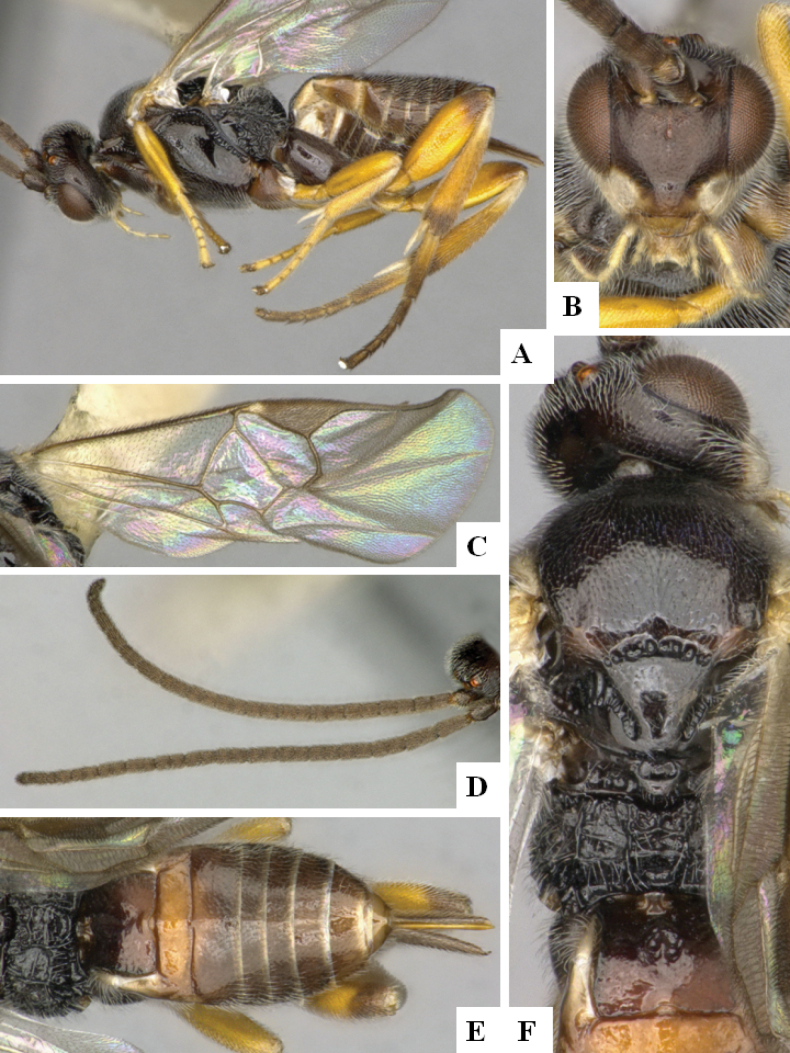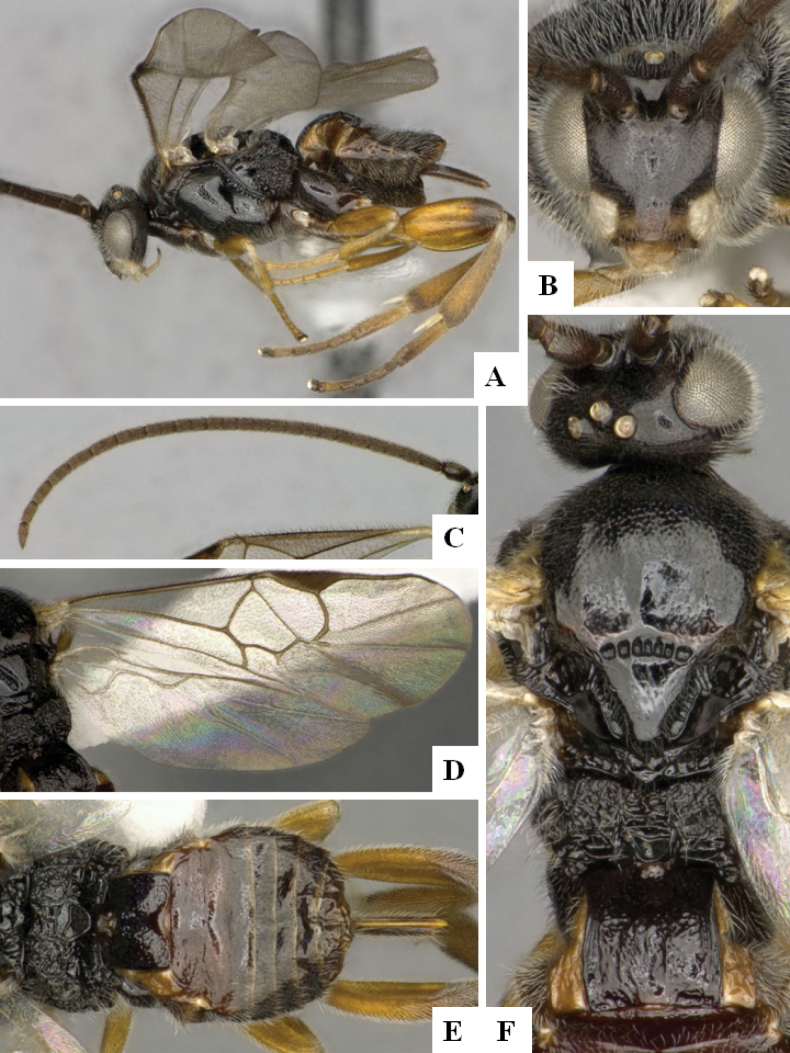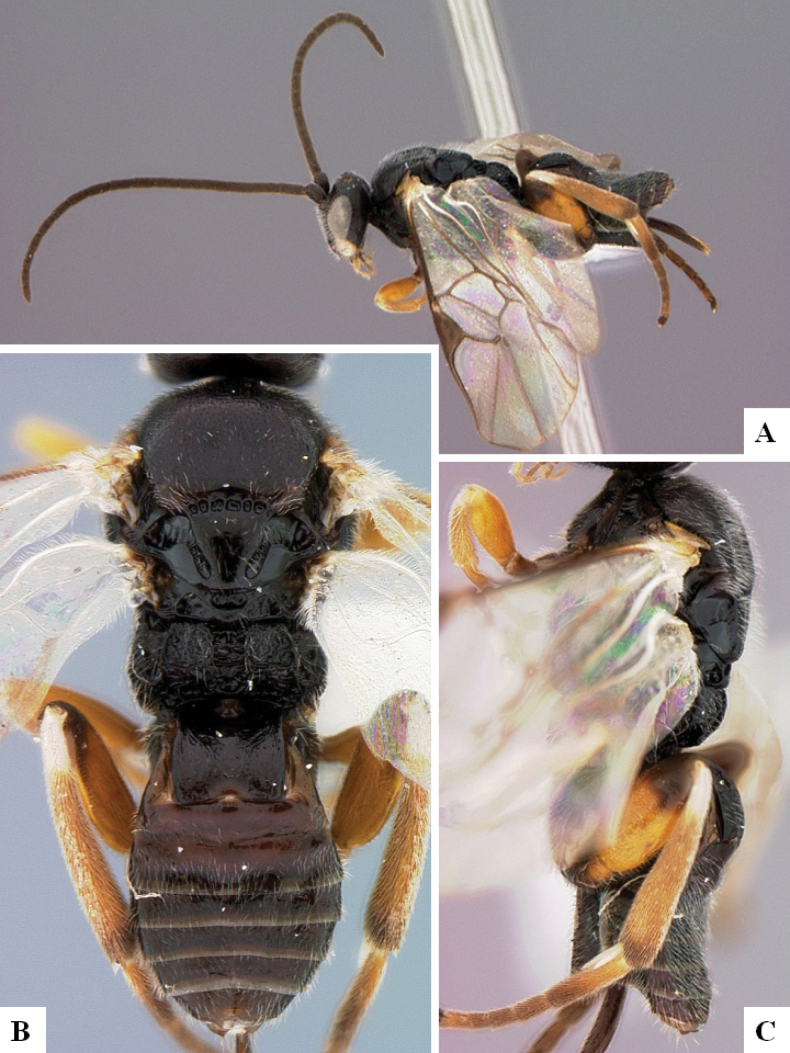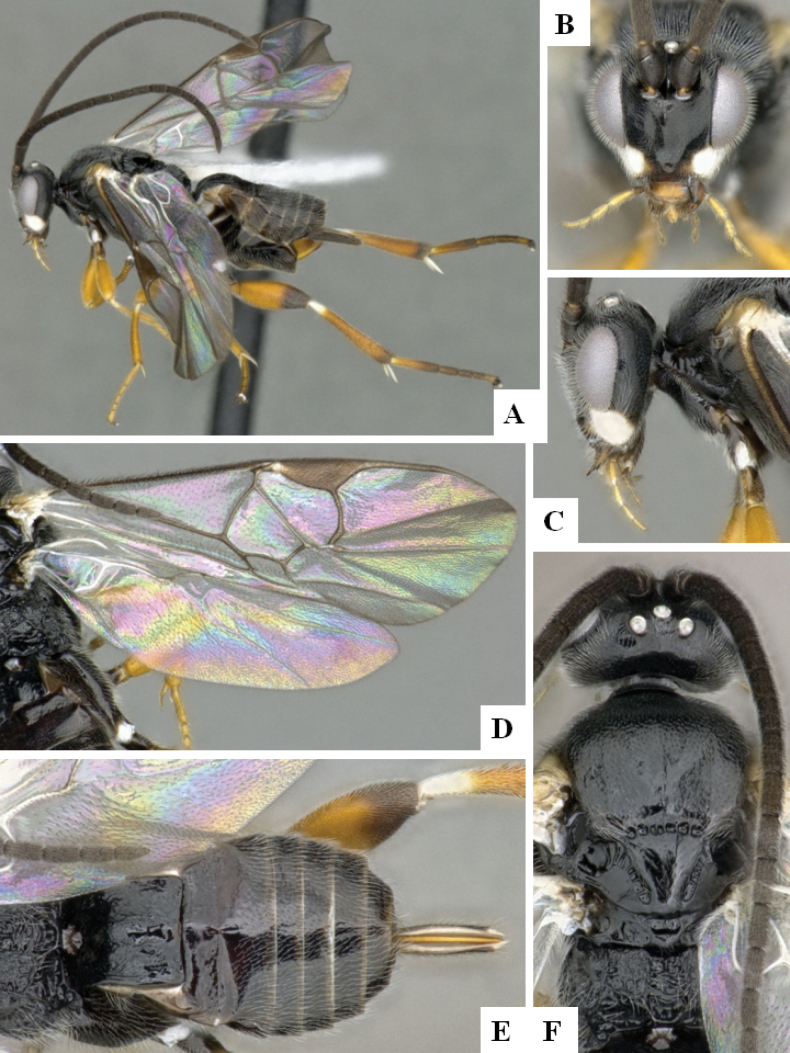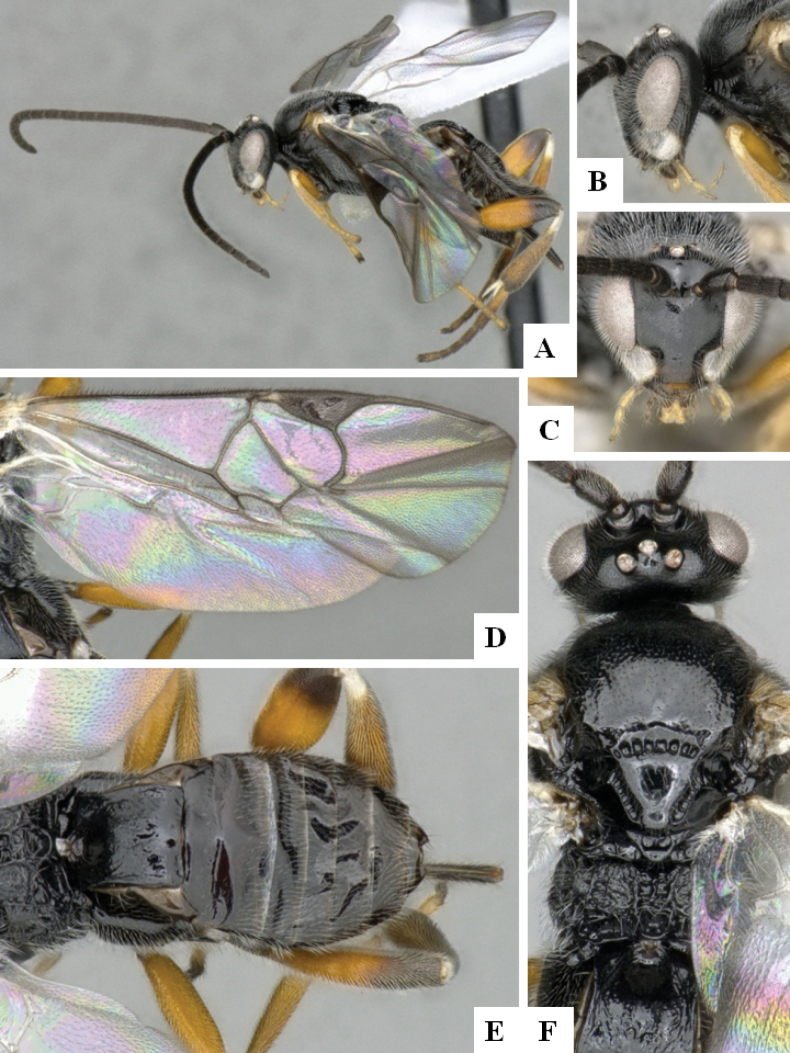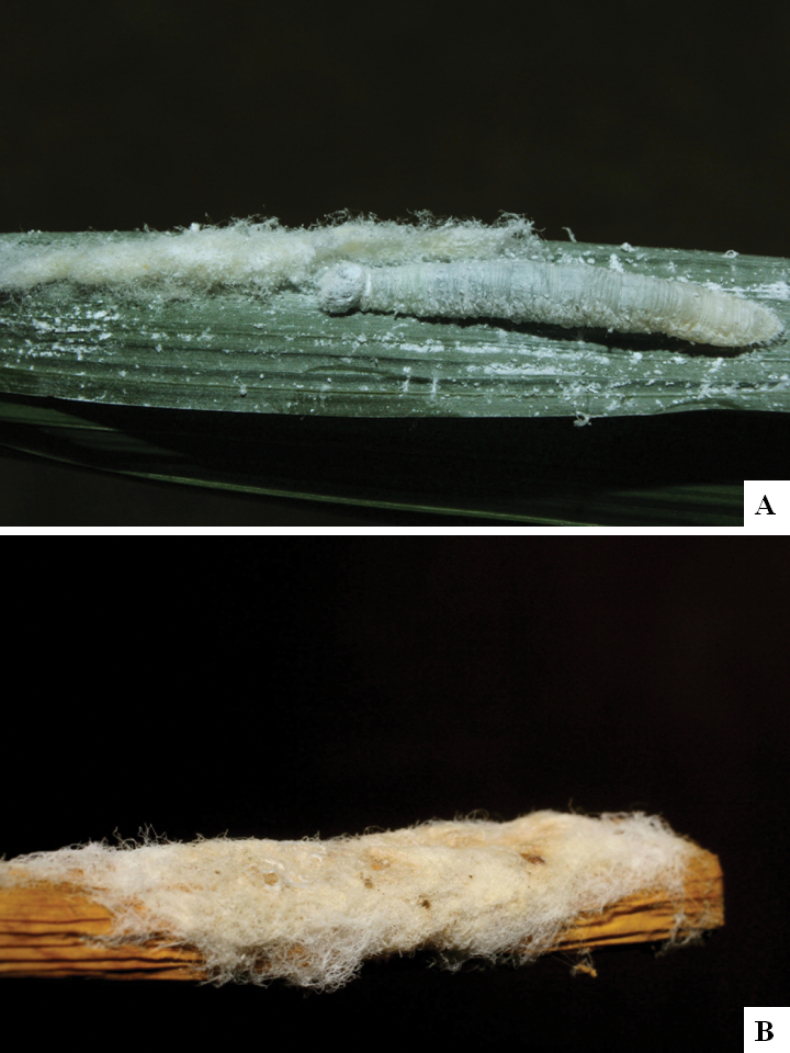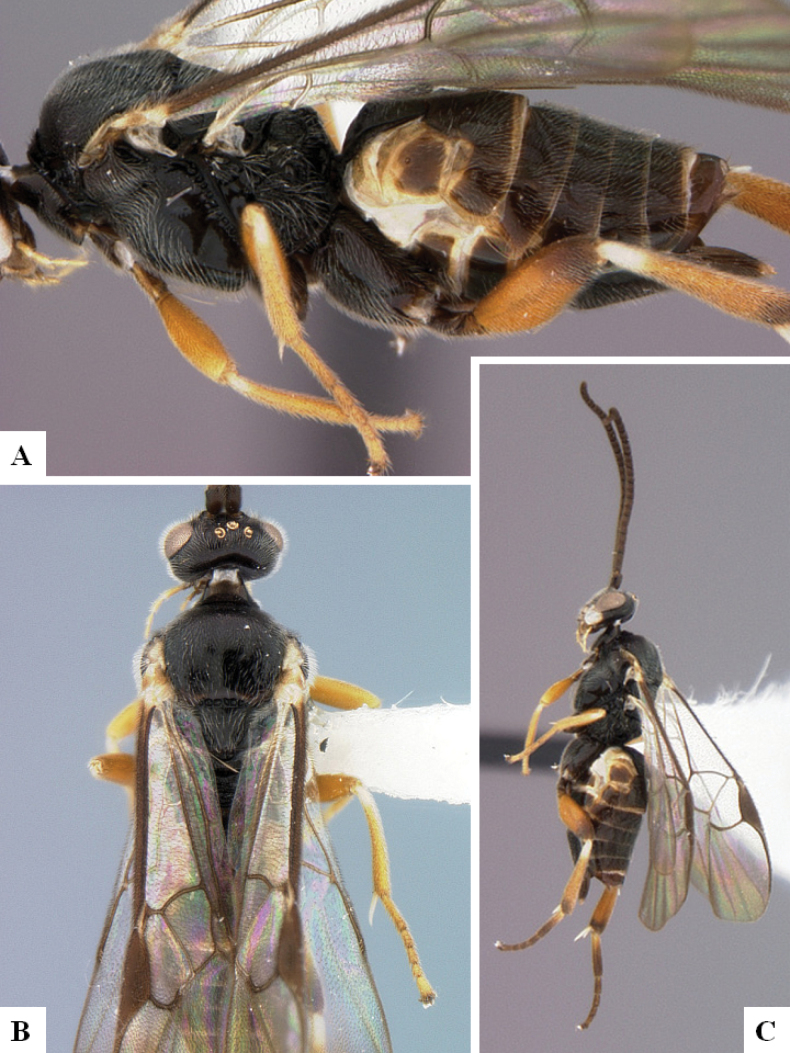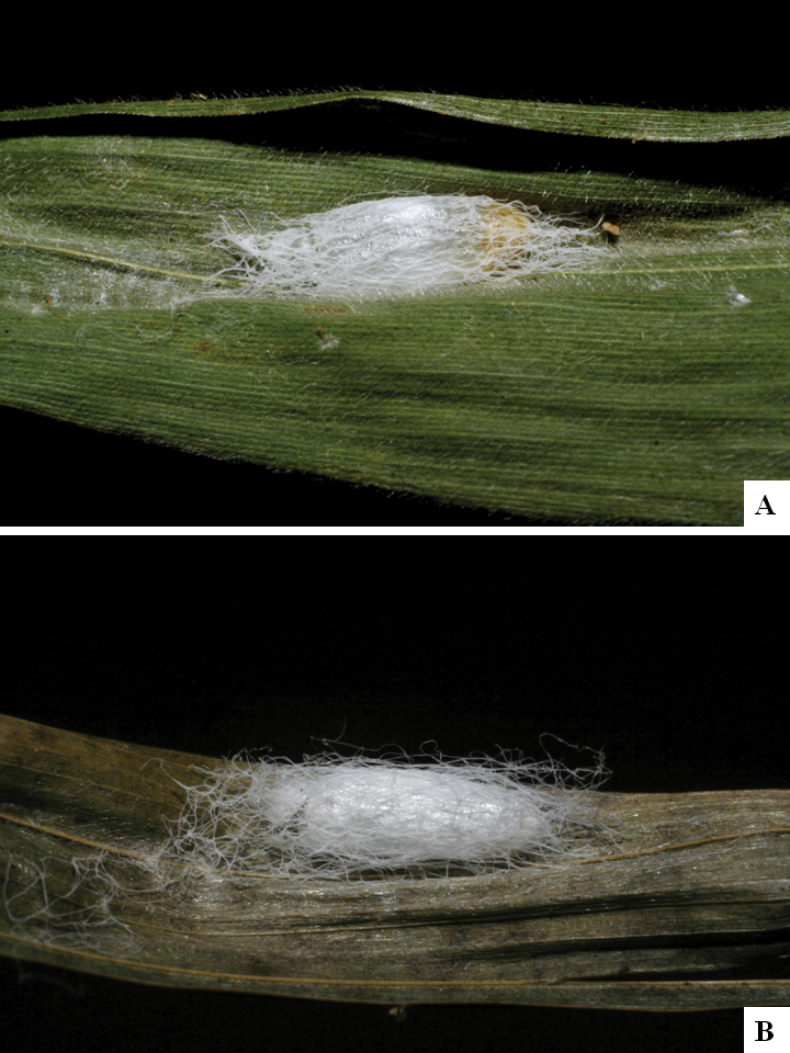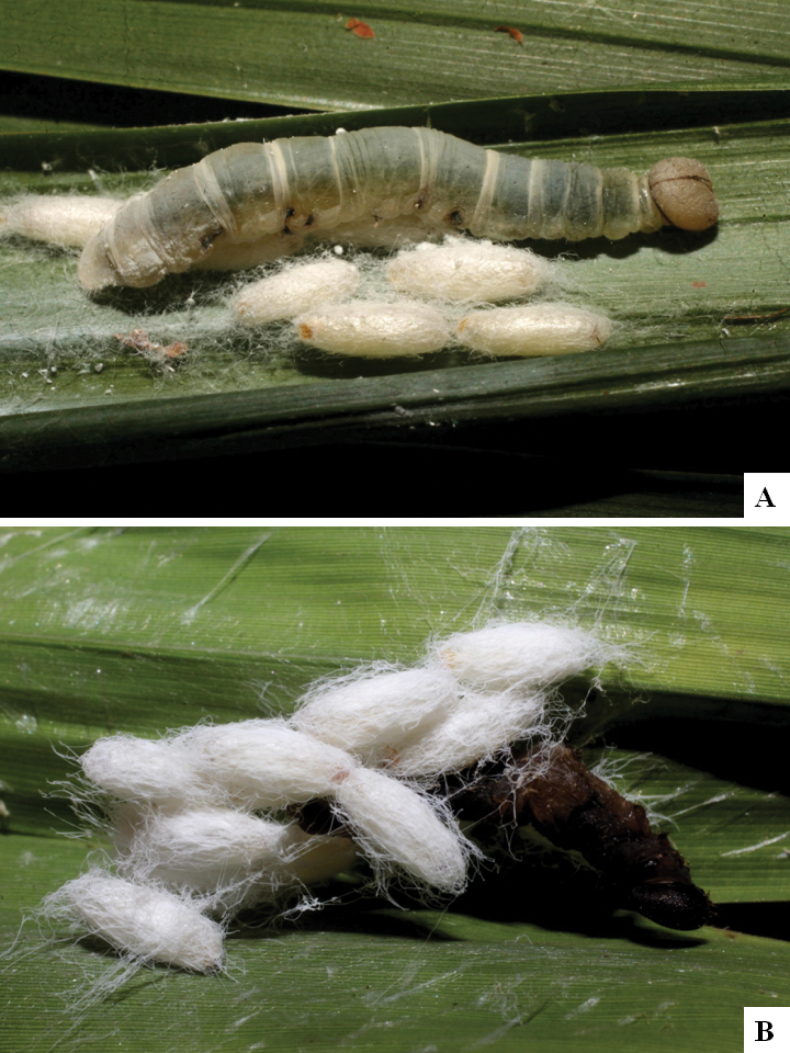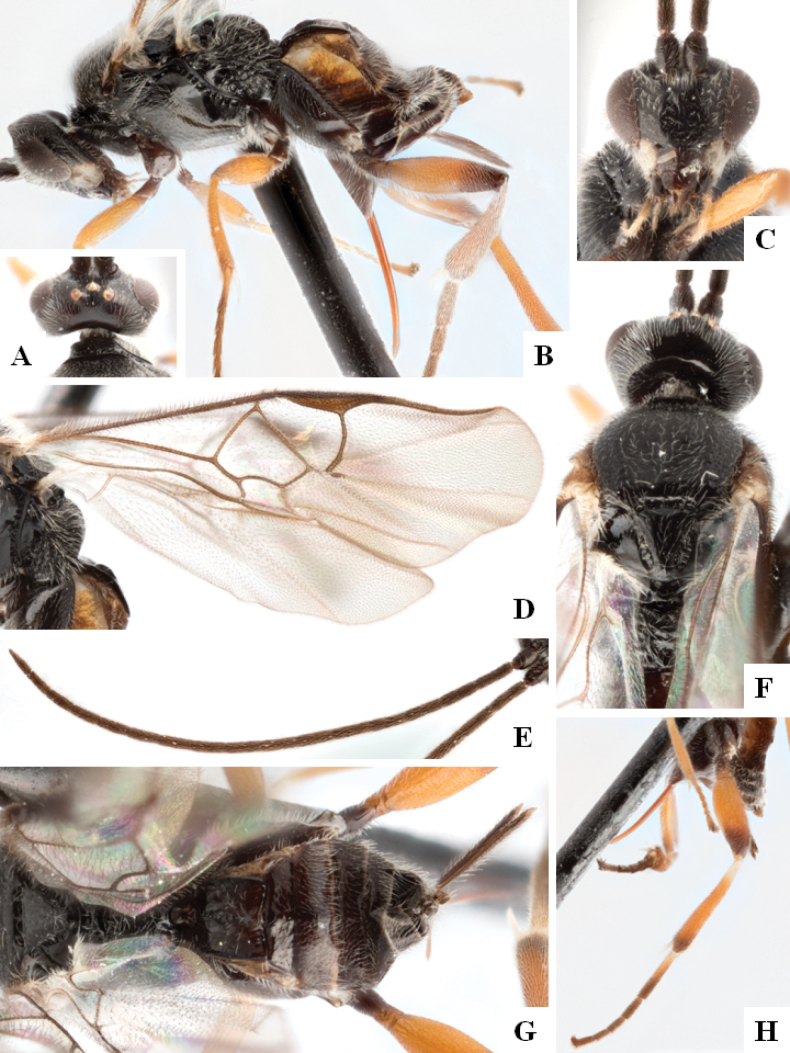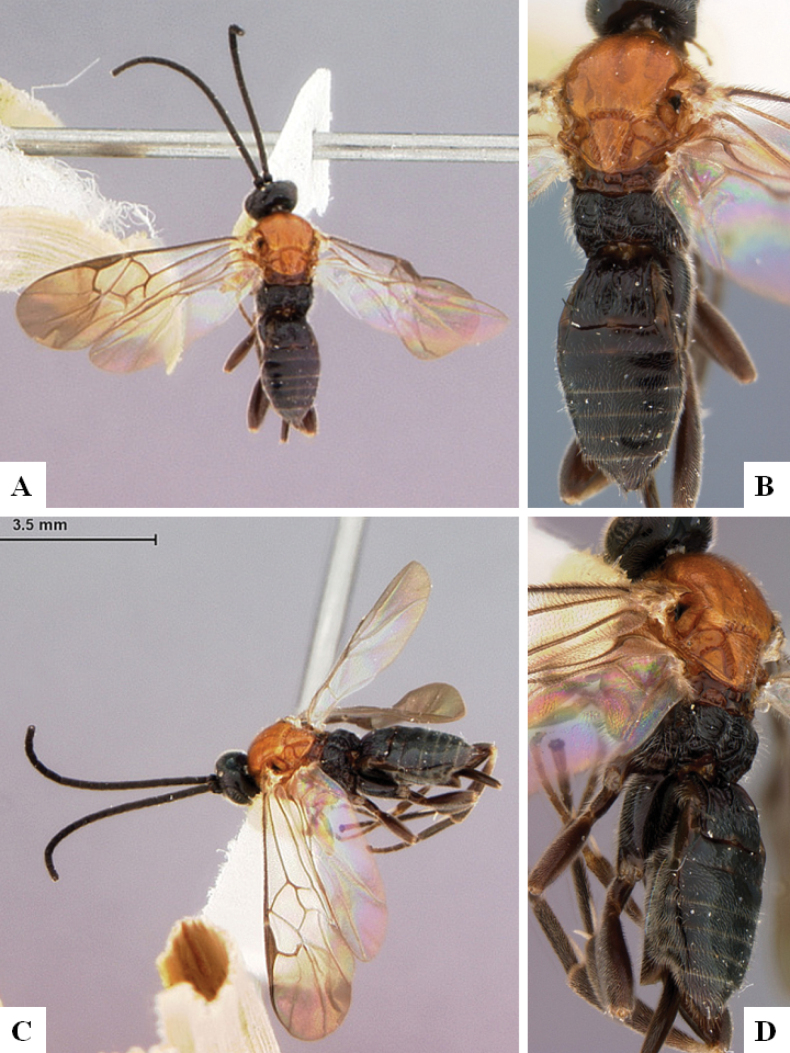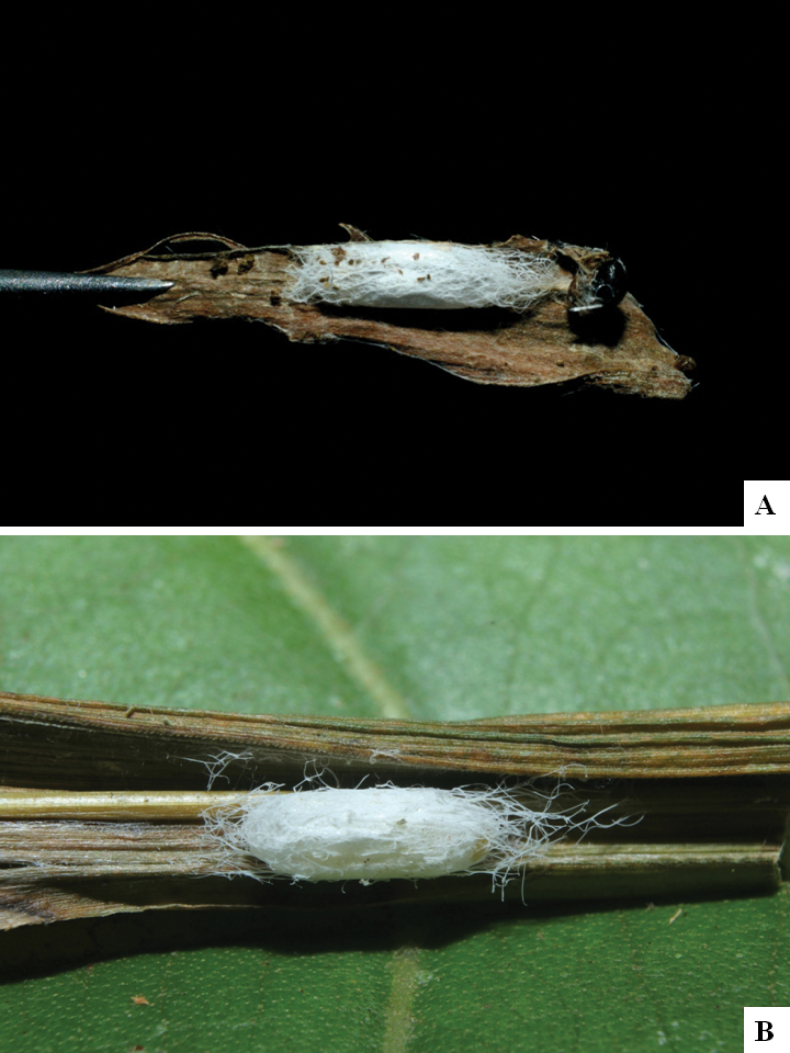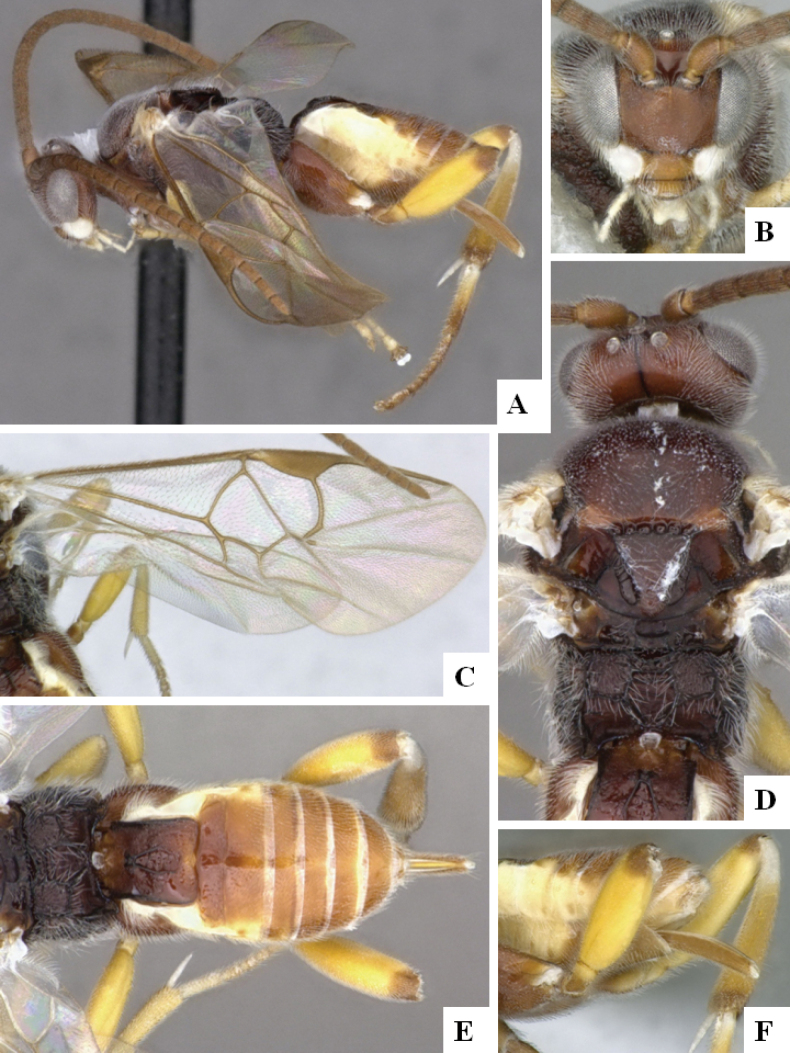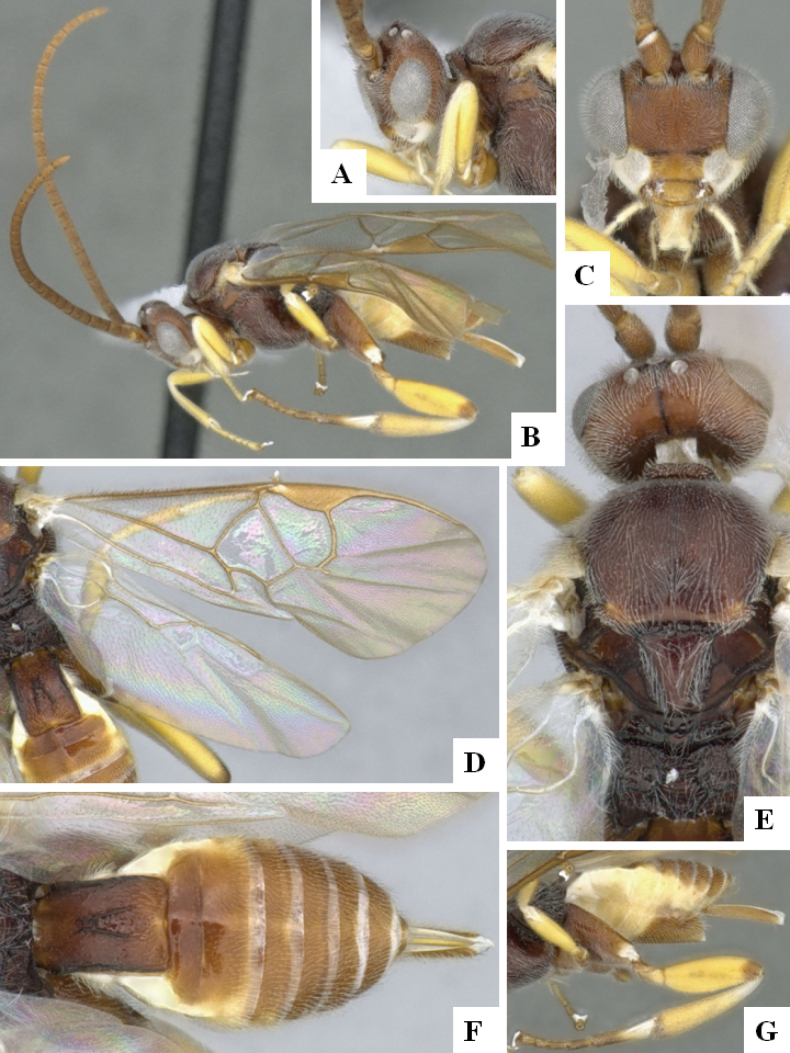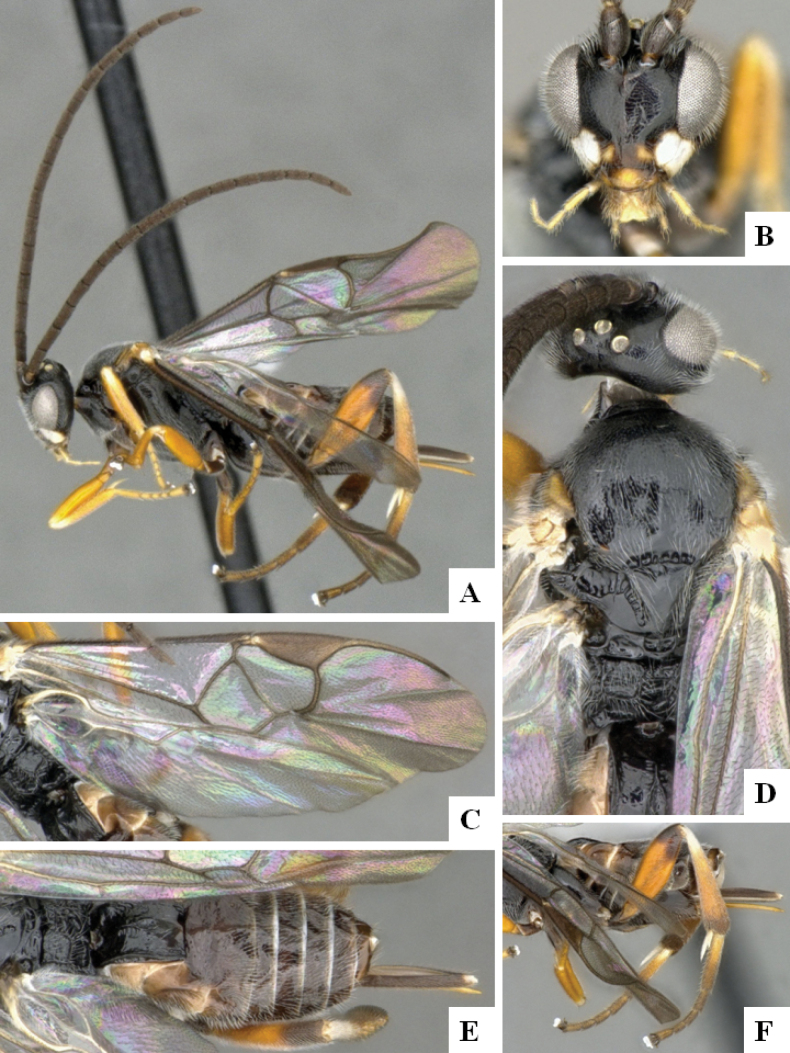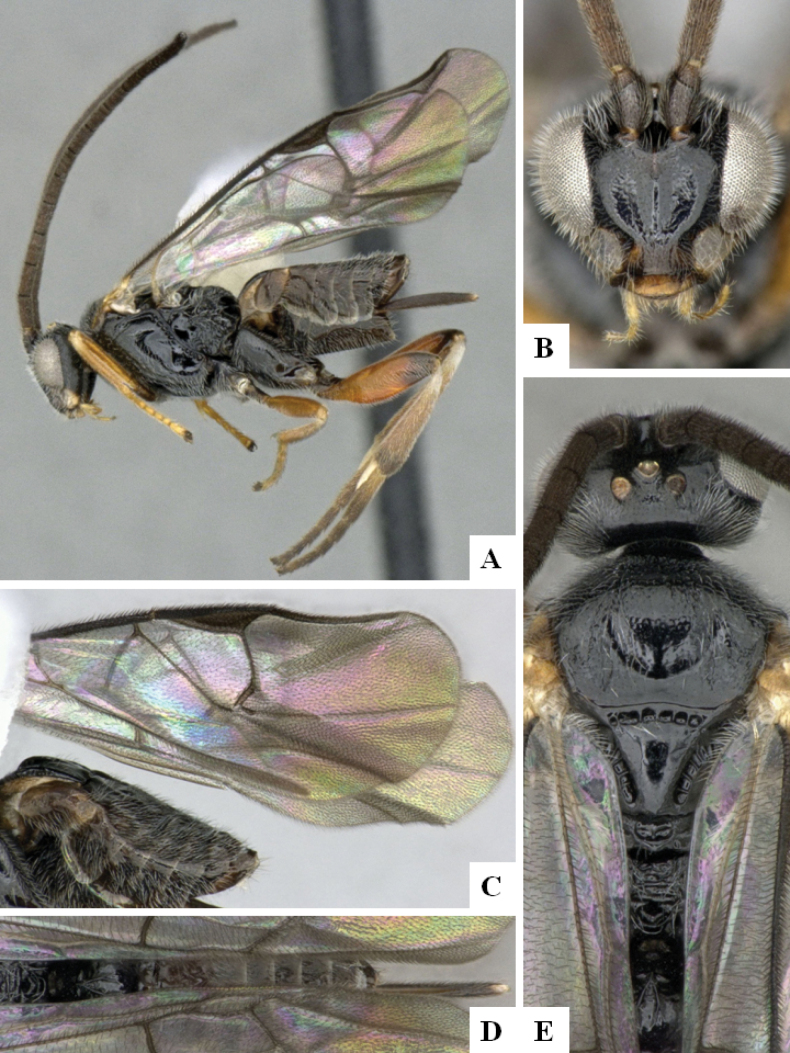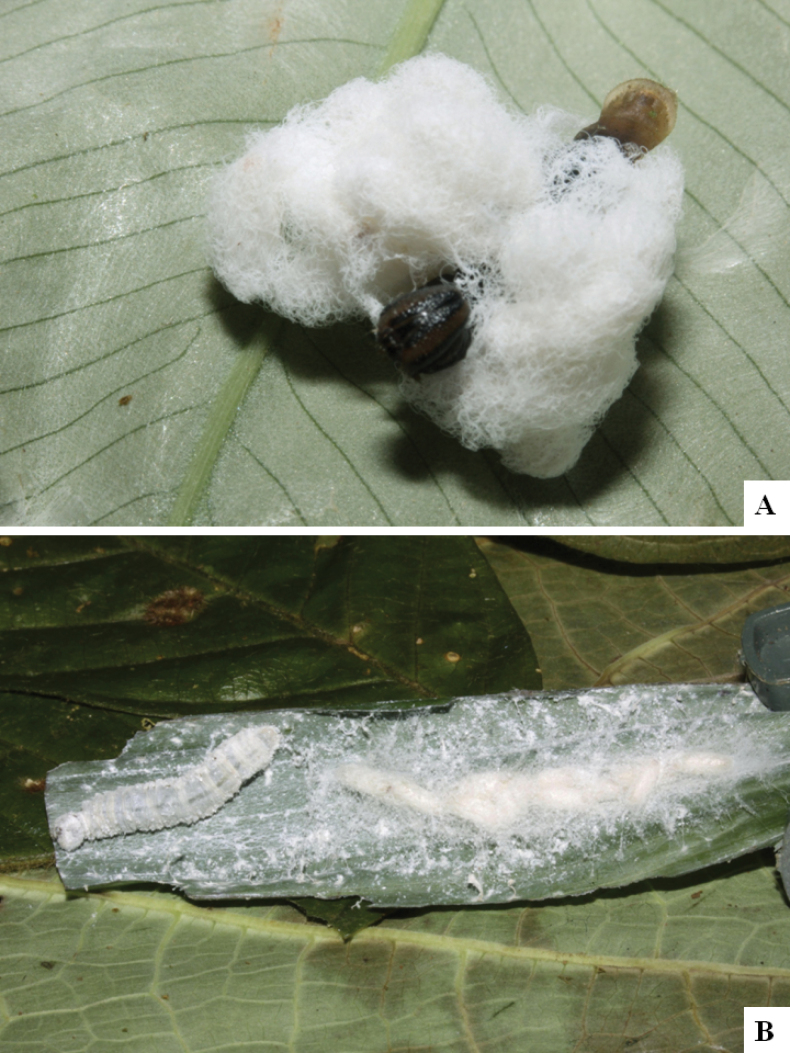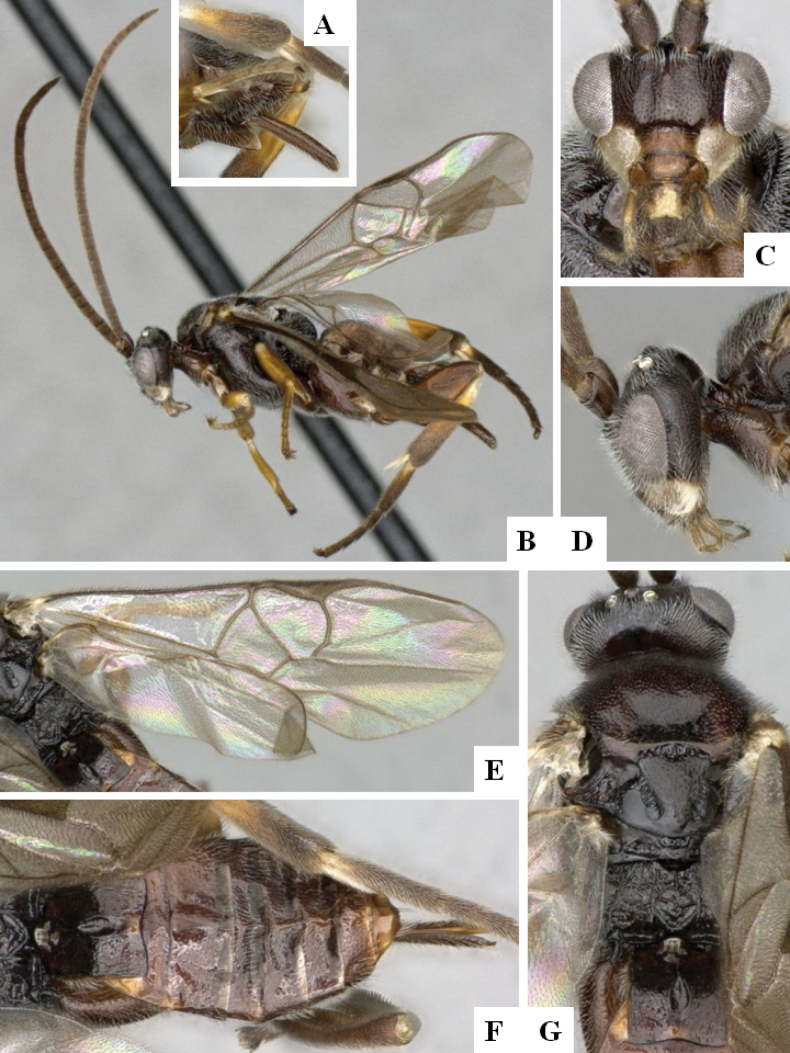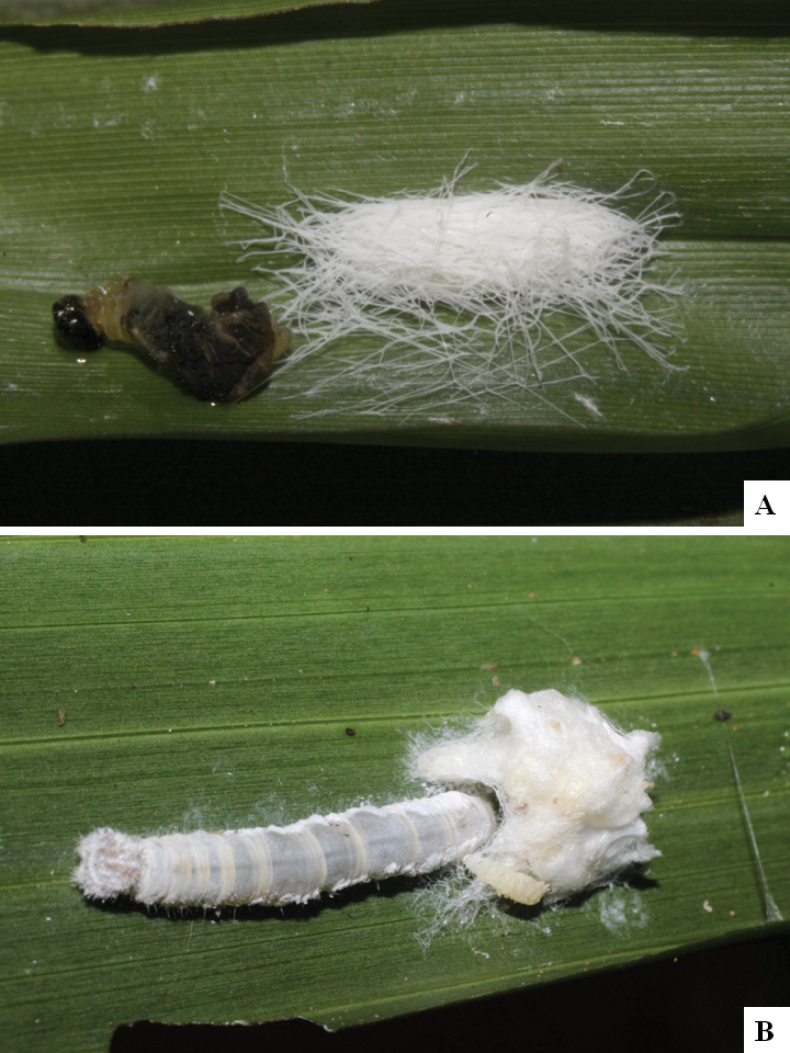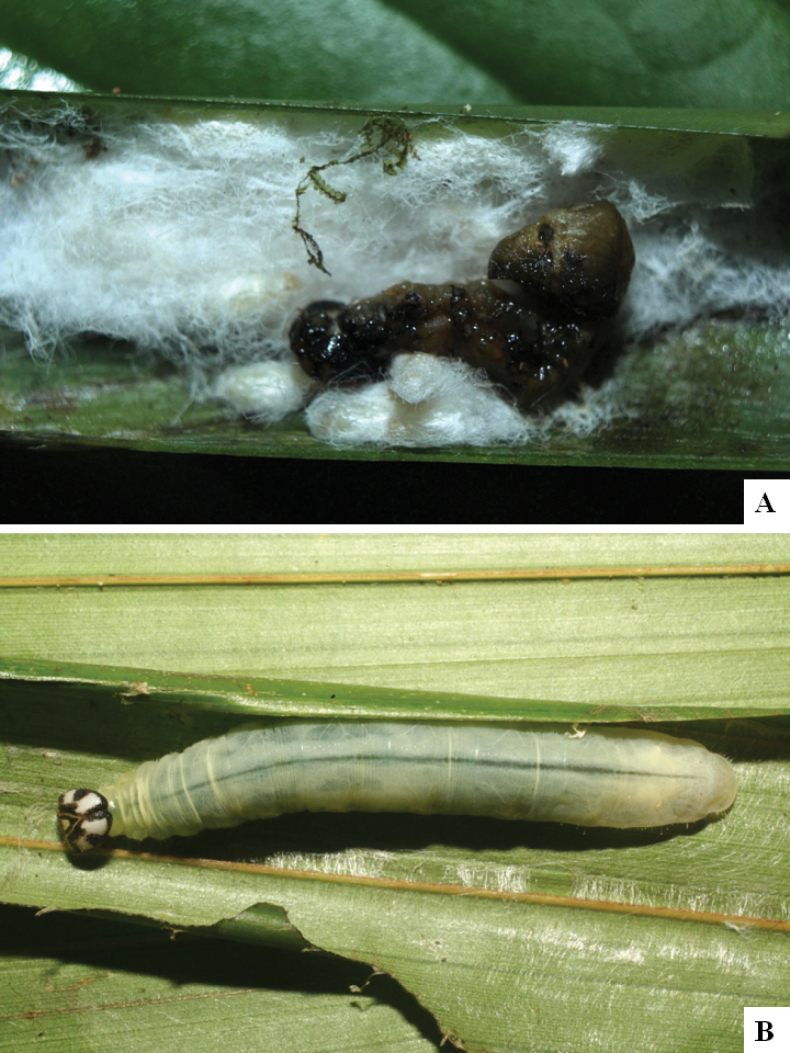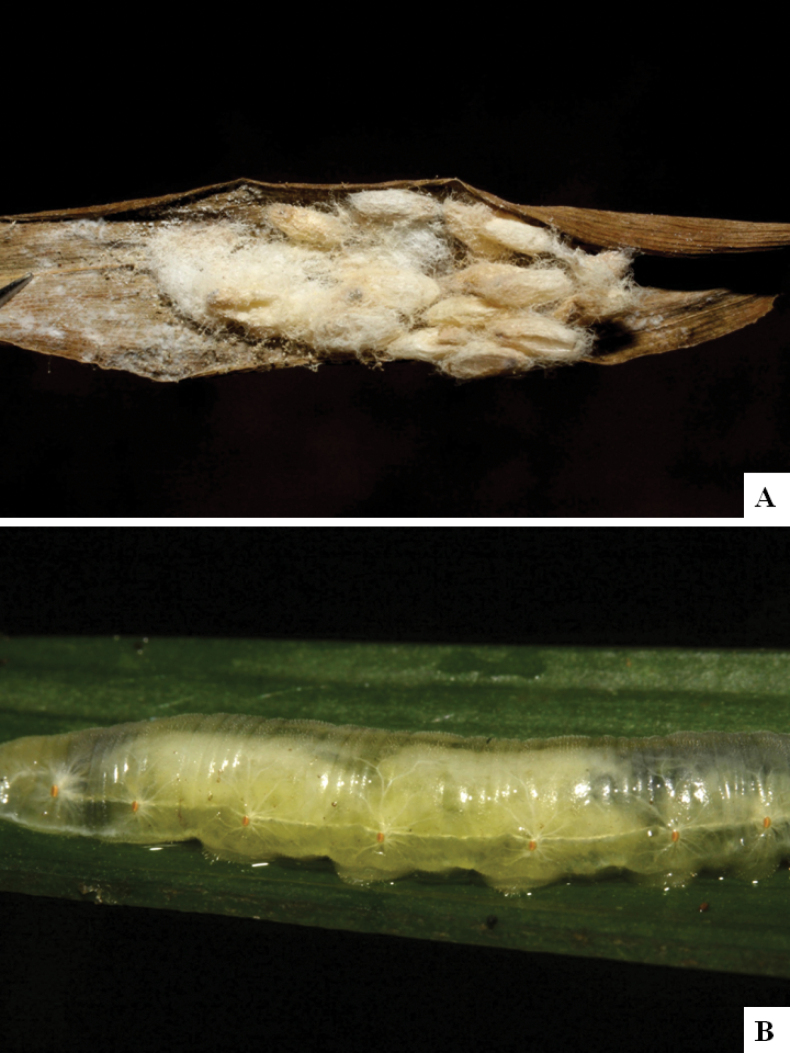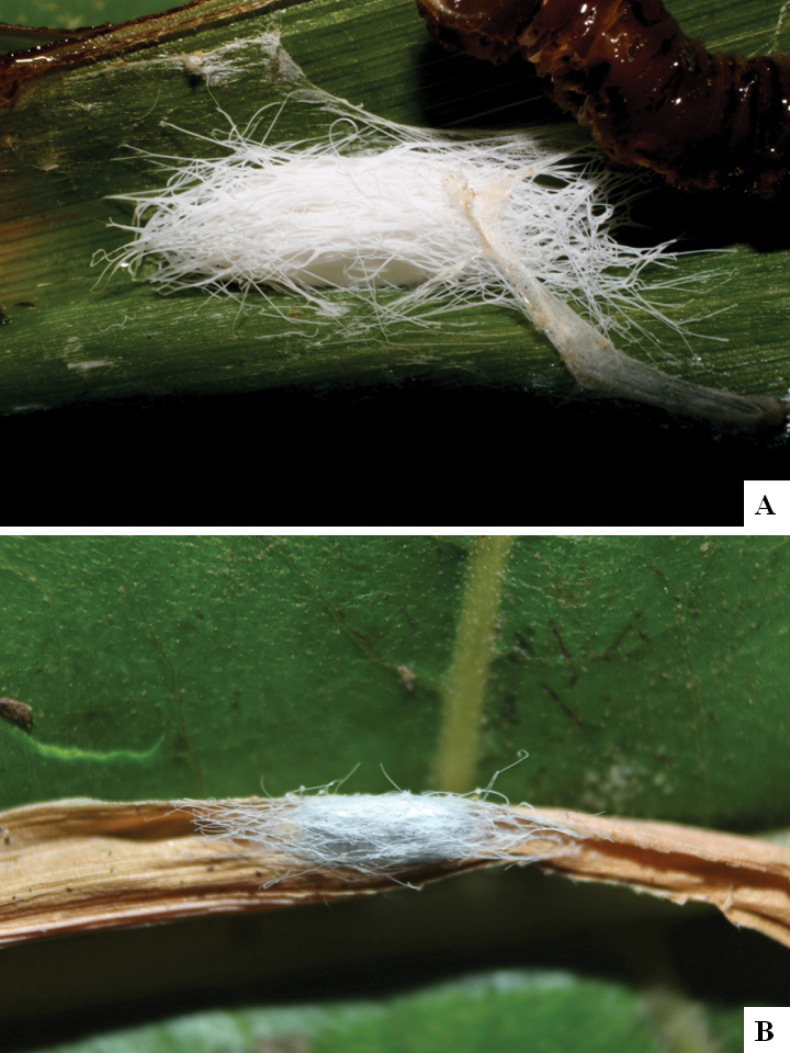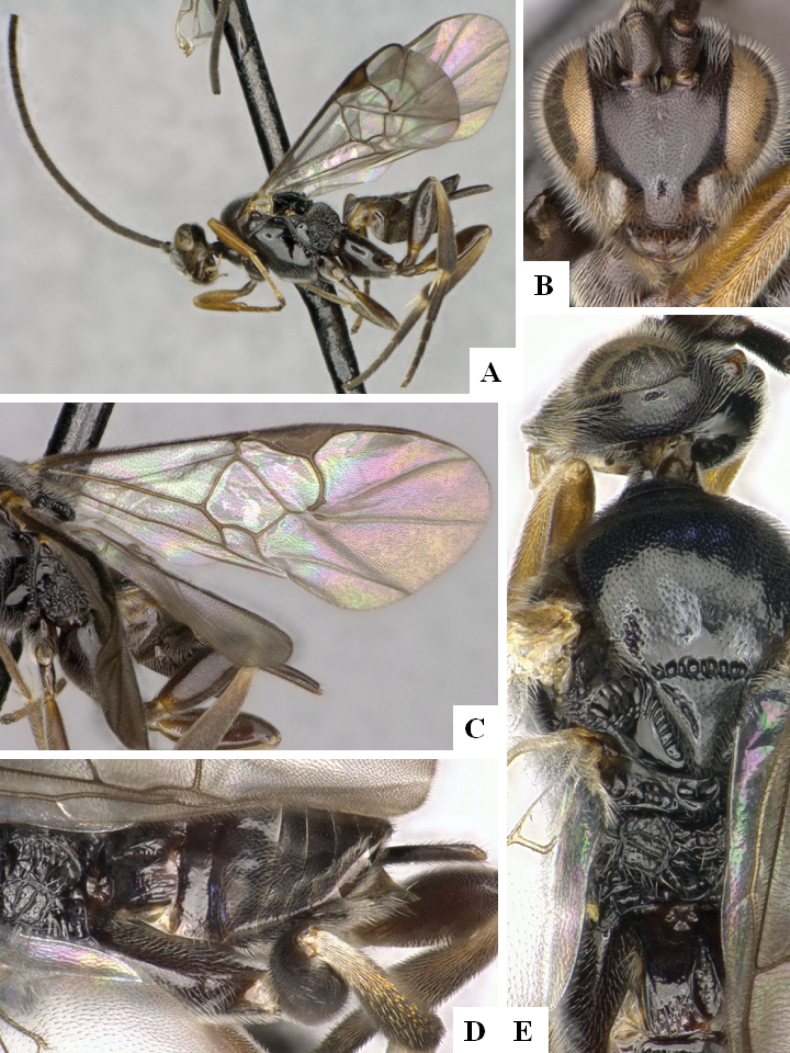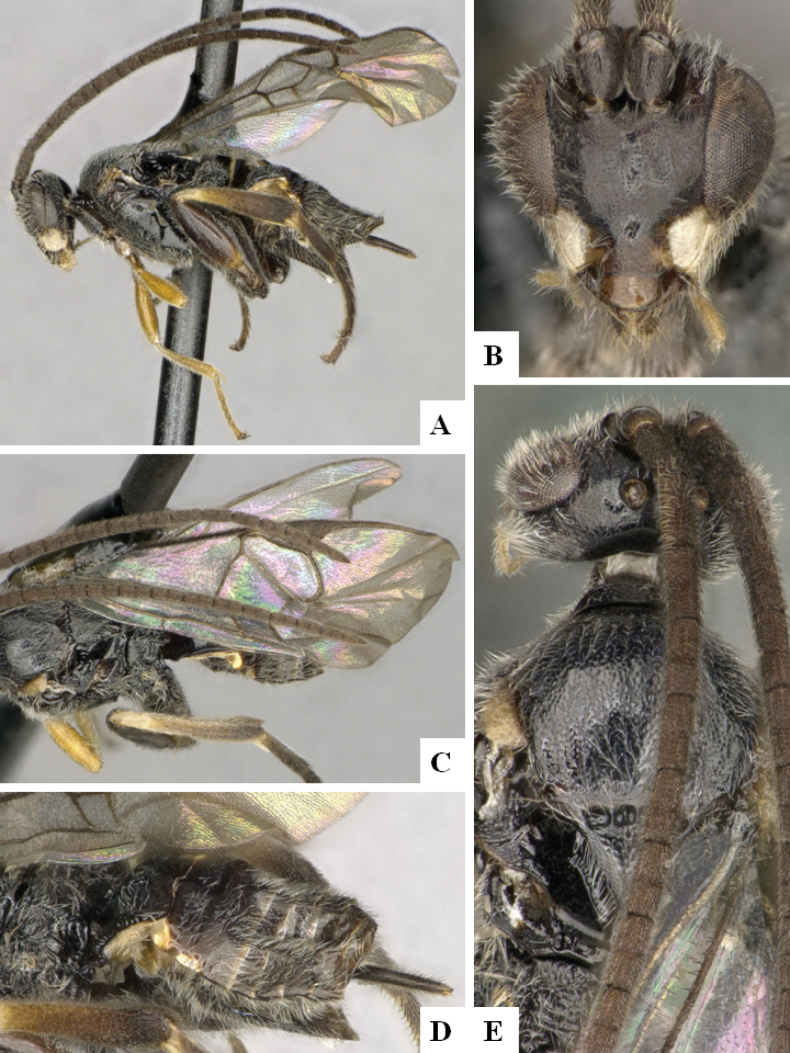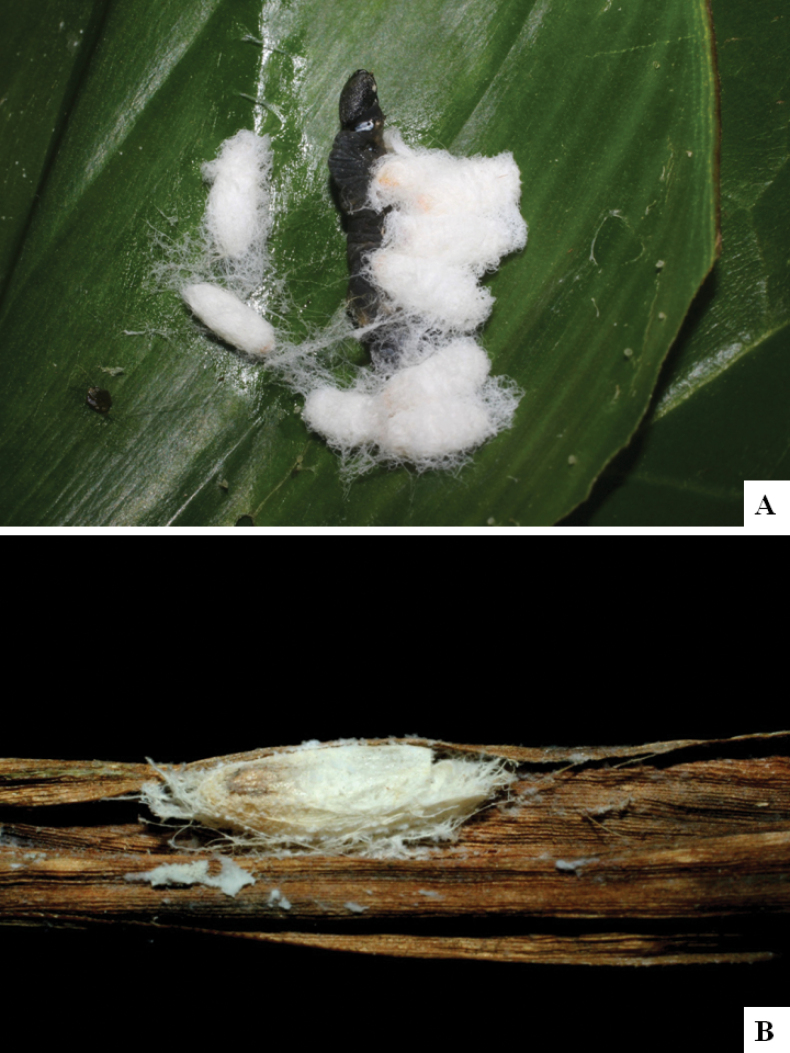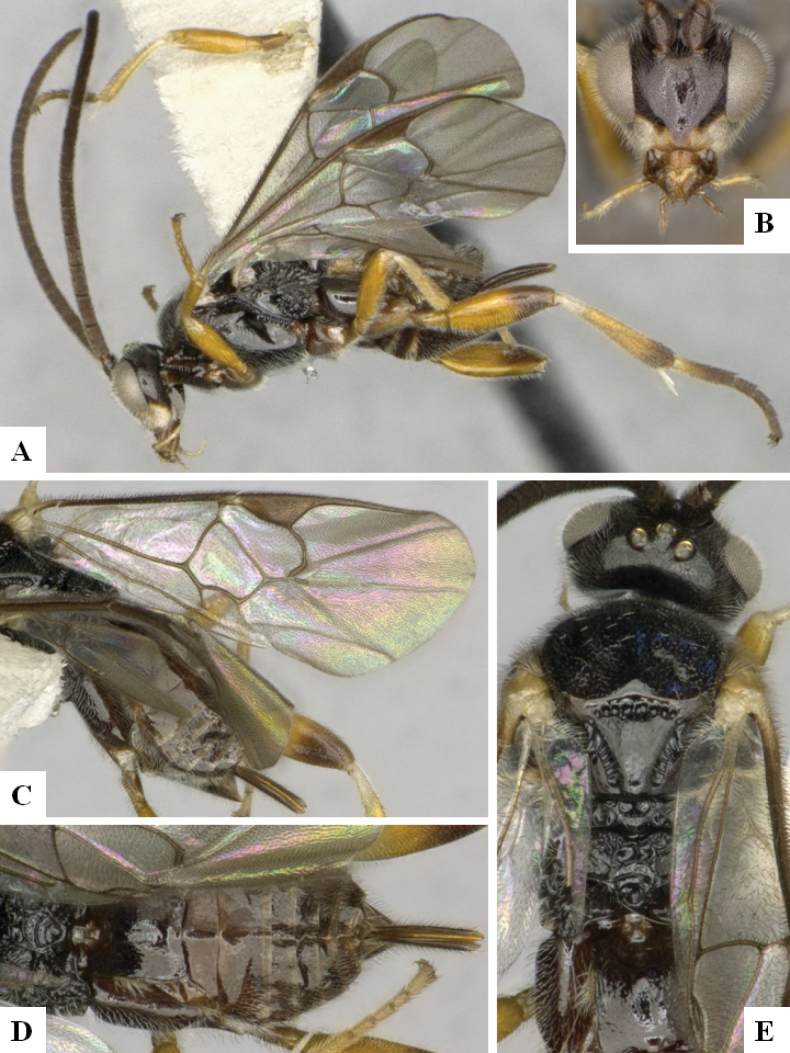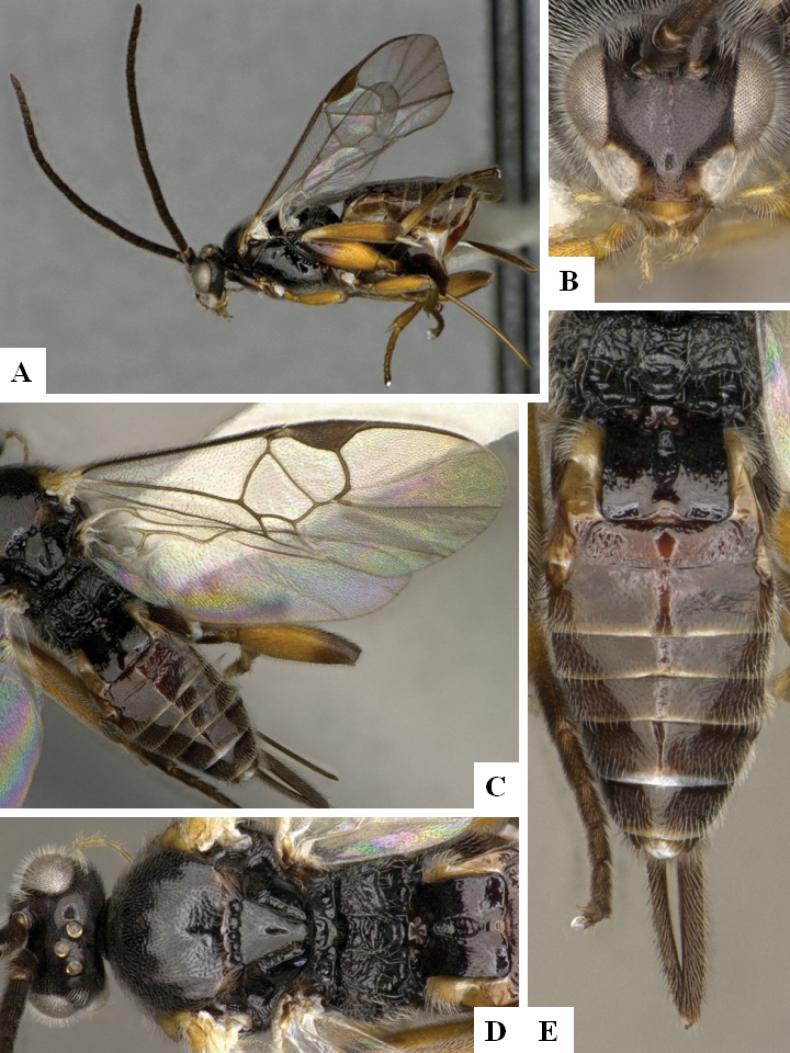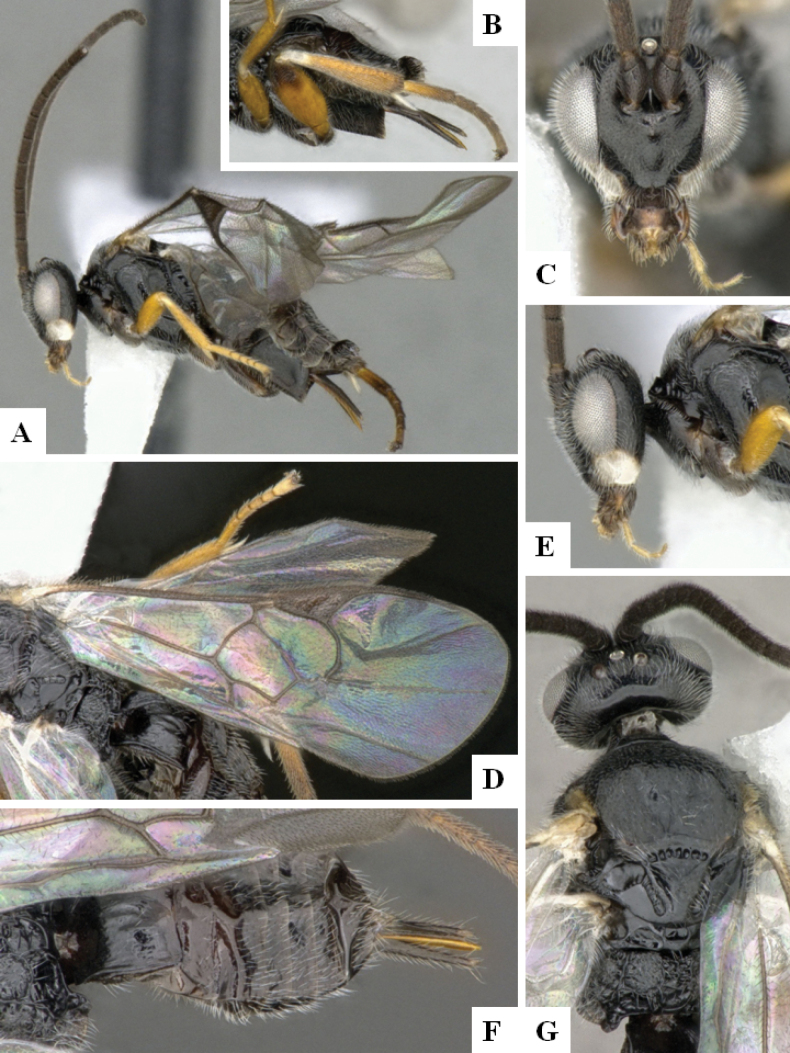Abstract
The parasitoid wasp genus Alphomelon Mason, 1981 is revised, based on a combination of basic morphology (dichotomous key and brief diagnostic descriptions), DNA barcoding, biology (host data and wasp cocoons), and distribution data. A total of 49 species is considered; the genus is almost entirely Neotropical (48 species recorded from that region), but three species reach the Nearctic, with one of them extending as far north as 45° N in Canada. Alphomelon parasitizes exclusively Hesperiinae caterpillars (Lepidoptera: Hesperiidae), mostly feeding on monocots in the families Arecaceae, Bromeliaceae, Cannaceae, Commelinaceae, Heliconiaceae, and Poaceae. Most wasp species parasitize either on one or very few (2–4) host species, usually within one or two hesperiine genera; but some species can parasitize several hosts from up to nine different hesperiine genera. Among species with available data for their cocoons, roughly half weave solitary cocoons (16) and half are gregarious (17); cocoons tend to be surrounded by a rather distinctive, coarse silk (especially in solitary species, but also distinguishable in some gregarious species). Neither morphology nor DNA barcoding alone was sufficient on its own to delimit all species properly; by integrating all available evidence (even if incomplete, as available data for every species is different) a foundation is provided for future studies incorporating more specimens, especially from South America. The following 30 new species are described: cruzi, itatiaiensis, and palomae, authored by Shimbori & Fernandez-Triana; and adrianguadamuzi, amazonas, andydeansi, calixtomoragai, carolinacanoae, christerhanssoni, diniamartinezae, duvalierbricenoi, eldaarayae, eliethcantillanoae, gloriasihezarae, guillermopereirai, hazelcambroneroae, josecortesi, keineraragoni, luciarosae, manuelriosi, mikesharkeyi, osvaldoespinozai, paramelanoscelis, paranigriceps, petronariosae, ricardocaleroi, rigoi, rostermoragai, sergioriosi, and yanayacu, authored by Fernandez-Triana & Shimbori.
Key words: Biology, DNA barcoding, Microgastrinae, morphology, Nearctic, Neotropical
Introduction
The genus Alphomelon (Hymenoptera: Braconidae, Microgastrinae) was described by Mason (1981) to accommodate three New World species, previously described under different genera, but all having in common a white spot on the gena, near the mandible base. Deans et al. (2003) revised the genus, including the description of 13 new Neotropical species, and provided the only available key to all known species at the time. That same year, Shimabukuro and Penteado-Dias (2003) added two new species from Brazil. Even today, Alphomelon is still restricted to the New World, and at present includes 19 described species mostly from the Neotropics but with a few extending north into the Nearctic. The overall species richness is estimated to exceed 50 species (Fernandez-Triana et al. 2020).
This study contributes to the ongoing insect biodiversity inventory by rearing and Malaise trapping of the 120,000 terrestrial ha Área de Conservación Guanacaste (ACG) in northwestern Costa Rica, a complex of dry forest, cloud forest, and rain forest, and many intergrades (Janzen and Hallwachs 2016). Here, we revise Alphomelon with an emphasis on the ACG species but also describe additional species from other Neotropical areas.
We provide an updated key, illustrations for all known species, and comments on natural history and DNA barcoding data. We also discuss the challenges of describing new species by combining morphological, molecular, and biological data while integrating previously described species based on less comprehensive data.
Materials and methods
Taxon sampling
As part of studies on the Microgastrinae fauna of ACG, we examined a significant number of Alphomelon specimens from that area but also many unidentified specimens of the genus from many Neotropical countries stored in the Canadian National Collection of insects, arachnids and nematodes, Ottawa, Canada (CNC), Coleção Entomológica do Departamento de Ecologia e Biologia Evolutiva da UFSCar, São Carlos, Brazil (DCBU), and the Illinois Natural History Survey, Urbana-Champaign, USA (INHS). We also analyzed images and DNA sequences from some specimens in the Centre for Biodiversity Genomics, University of Guelph, Canada (CBG), images of material (holotypes and paratypes) in the Coleção Taxonômica do Departamento de Ecologia e Biologia Evolutiva (DCBU) da Universidade Federal de São Carlos (UFSCAR), Brazil, and photographed some specimens in the American Entomological Institute Collection (AEIC), Logan, Utah, USA. In total, we studied more than one thousand specimens. This material allowed us to deal with the entire fauna on hand at this time, but we anticipate tens more new species once portions of the Neotropics have been inventoried with the intensity already invested in ACG.
Morphology and taxonomic characters
In this paper we diagnose and describe all the species using a combination of basic morphology (dichotomous key and brief diagnostic description), DNA barcodes (when available), biology, and distribution data, following suggestions outlined in Fernandez-Triana (2022).
Morphological terms and measurements mostly follow Huber and Sharkey (1993), Whitfield (1997), Karlsson and Ronquist (2012) and Fernandez-Triana et al. (2014). The abbreviations T1, T2, and T3 are used for metasomal mediotergites 1, 2, and 3 respectively; and L and W refer to length and width, respectively. Following recommendations for the simplified and abbreviated use of morphological data in turbo taxonomy approaches (Fernandez-Triana 2022), the diagnostic descriptions for all the new species were based on a relatively small set of morphological characters (12), which can be quickly assessed and scored (Table 1).
Table 1.
Morphological characters and their states, as used in the diagnostic description of the new species of Alphomelon.
| Character | Character states (separated by semicolons) |
|---|---|
| White patch on gena | neither extending onto clypeus nor to occiput (Figs 65C, 85A, 85B); extending to occiput but not to clypeus (Figs 2B, 16B, 32B, 41B, 64B); extending to occiput and onto clypeus (Figs 18B, 19A, 31C, 37B, 68B) |
| Tegula/humeral complex color | white/yellow; yellow/yellow; yellow/brown; brown/brown |
| Mesonotum color | mostly orange-yellow (Figs 57F, 64H, 22F); mostly dark brown to black (Figs 1E, 2E, 3D, 42G) |
| Metasoma color | mostly orange-yellow (Figs 57E, 64G); with several tergites orange-yellow, some laterotergites and sternites yellow, rest mostly brown (Figs 8D, 18D, 19A, 22A, 22E, 31D, 67B, 67F, 77A, 77F, 77G, 78D); mostly dark brown to black but with some laterotergites and sternites yellow (Figs 15A, 18A, 21B, 21G, 34B, 34F); mostly black or dark brown (Figs 1E, 2E, 7C, 38A, 39A, 42C) |
| Tarsal claws spine number (hind leg) | 0; 1; 2; 3; 4 |
| Pterostigma shape | comparatively more elongate, its length ≥ 3.0× its central height and more triangular with its two lower margins more or less straight (Figs 3C, 6B, 7A, 24A, 48C); comparatively less elongate, its length ≤ 2.5× its central height and usually more rounded with at least one of its lower margins curved (Figs 11C, 18C, 29B) |
| T1 sculpture | entirely to mostly smooth (Figs 11G, 13E, 13F, 14C, 31D, 31E, 41D, 45E); weakly sculptured along margins (Figs 1D, 1E, 8E, 36F, 38D); strongly sculptured on at least apical half or more (Figs 2D, 2E, 3E, 75F, 76C) |
| T1 central ridge | absent (Figs 26E, 59B); faintly indicated by shallow depression (Figs 30D, 45E); marked by weak carina (Figs 31D, 31E, 46F, 78D, 78E); clearly marked by two raised carinae (Figs 1E, 3E, 17F, 32E); strongly marked by two raised carinae and strong costulae centrally (Figs 2D, 18D, 33E, 72E, 76C, 76E) |
| T2 sculpture | entirely to mostly smooth (Figs 1D, 4F, 6F, 8D, 12E, 14C); weakly sculptured along margins (Figs 21G, 22E, 22F, 27E, 29E, 32D); entirely to mostly strongly sculptured (Figs 2D, 3E, 16D, 18D) |
| Ovipositor sheaths length | shorter than the first segment of metatarsus (Figs 9A, 31A, 44A, 61A); longer than the first segment of metatarsus (Figs 2A, 15A, 16A, 21B, 25A) |
| Body length (mm) | as detailed in Fernandez-Triana et al. (2014) |
| Fore wing length (mm) | as detailed in Fernandez-Triana et al. (2014) |
Some characters of particular relevance to Alphomelon were incorporated from the previous review of the genus by Deans et al. (2003). These characters are: a) the “petiolar ridge” or T1 central ridge (e.g., Figs 2E, 3E, 8E, 17F, 18E), which is a central, longitudinal carina on T1 usually extending from around half of the tergite length and ending close to the posterior margin; the carina can bifurcate posteriorly and the space between the two arms sometimes presents some transverse striations; b) the size and shape of white/pale coloration in the gena, which can extend to the occiput and sometimes onto the clypeus (e.g., Figs 5D, 9D, 12B, 18B, 19A, 31C, 60B); and c) the degree of angulation of the vein cu-a on the hind wing (e.g., Figs 5C, 14C, 19B, 20C; also see Deans et al. 2003).
Figure 2.
Alphomelonamazonas Fernandez-Triana & Shimbori holotype female CNC1066010 A habitus, lateral B head, frontal C fore wing D propodeum and metasoma, dorsal E mesosoma and T1, dorsal.
Figure 3.
Alphomelonandydeansi Fernandez-Triana & Shimbori holotype female DHJPAR0031609 A habitus, lateral B head, frontal C wings D mesosoma, dorsal E propodeum and metasoma, dorsal F ovipositor, lateral.
Figure 8.
Alphomelonbrachymacher Deans female CNCHYM 00006 A habitus, lateral B head, frontal C wings D propodeum and metasoma, dorsal E mesosoma, dorsal.
Figure 17.
Alphomelonchristerhanssoni Fernandez-Triana & Shimbori holotype female CNC308752 A head, lateral B habitus, lateral C head, frontal D ovipositor, lateral E wings, F propodeum and metasoma, dorsal G mesosoma, dorsal.
Figure 18.
Alphomeloncitroloma Deans female CNC704170 A habitus, lateral B head, frontal C fore wing D propodeum and metasoma, dorsal E mesosoma, dorsal.
Figure 5.
Alphomelonarecaphile Deans female CNC704666 A habitus, lateral B head, frontal C wings D head, fronto-lateral E metasoma, dorsal F mesosoma, dorsal.
Figure 9.
Alphomelonbrachymacher Deans female CNCHYM 00010 A habitus, lateral B head, frontal C wings D head, fronto-lateral E metasoma, dorsal F mesosoma, dorsal.
Figure 12.
Alphomelonbromeliphile Deans female CNC704660 A habitus, lateral B head, frontal C fore wing D head and mesosoma, dorsal E propodeum and metasoma, dorsal.
Figure 19.
Alphomeloncitroloma Deans holotype female USNMENT00828298 A close-up of habitus, lateral B habitus, dorsal C habitus, lateral.
Figure 31.
Alphomeloneldaarayae Fernandez-Triana & Shimbori holotype female CNC1179987 A habitus, lateral B wings C head, frontal D propodeum and metasoma, dorsal E mesosoma, dorsal.
Figure 60.
Alphomelonparamelanoscelis Fernandez-Triana & Shimbori female CNC704366 A habitus, lateral B head, frontal C wings D propodeum and metasoma, dorsal E mesosoma, dorsal.
Figure 14.
Alphomelonbromeliphile Deans holotype female USNMENT00828296 A habitus, lateral B close-up of habitus, lateral C habitus, dorsal.
Figure 20.
Alphomeloncitroloma Deans male CNCHYM 00019 A habitus, lateral B head, frontal C wings D head, fronto-lateral E metasoma, dorsal F mesosoma, dorsal.
In the Distribution section for each species, new country or state records are indicated by an asterisk (*). Complete and verbatim label details were provided only for holotypes. Paratypes and other specimens examined were listed only with basic information (country, repository, sex, and voucher codes). All information associated with those specimens can be accessed in the publicly available CNC database (https://www.cnc.agr.gc.ca/taxonomy/TaxonMain.php) and at dx.doi.org/10.5883/DS-ALPHOMEL; the dataset “DS-ALPHOMEL” in BOLD (https://www.boldsystems.org/index.php/MAS_Management_DataConsole?codes=DS-ALPHOMEL) also comprises details for those specimens with available DNA sequences.
Molecular data
DNA barcoding was also used to characterize and recognize species. DNA extracts were obtained from single legs using a glass fiber protocol (Ivanova et al. 2006), and total genomic DNA was re-suspended in 30 μl of distilled water. The barcode region, a 658 base pairs (bp) region near the 5’ terminus of the COI gene, was amplified using standard primers following established protocols (e.g., see references in Fernandez-Triana et al. 2014).
The Barcode Index Number (BIN) was considered to approximately characterize species limits, following the BIN concept detailed in Ratnasingham and Hebert (2013).
All information for the sequences associated with each specimen barcoded (including primers and trace files) is available on the Barcode of Life Data System (BOLD) (Ratnasingham and Hebert 2007) under the dataset “DS-ALPHOMEL”. Two Neighbor Joining trees (with all Alphomelon sequences longer than 300 and 500 base pairs respectively) are provided in Suppl. material 1.
Host data
Host data (Lepidoptera species) as well as wasp cocoon strategy (solitary/gregarious) were mostly taken from the website “Dynamic database for an inventory of the macrocaterpillar fauna, and its food plants and parasitoids in ACG databases” (http://janzen.sas.upenn.edu/caterpillars/database.lasso). Although many hosts are identified to species in that database, for many others the available information only included the Lepidoptera genus with an interim or provisional species name code. For example, “Neoxeniades Burns03” and “Neoxeniades Burns04” respectively mean species #3 and #4 identified by Burns as members of the genus Neoxeniades; these examples being relatively easy to understand. Other host species names have more complicated syntaxis; for example, “Morys lydeDHJ02” means species # 2 identified by Daniel H. Janzen within the genus Morys, supposedly related to but not the same as the species Moryslyde (the relationship shown by adding the identifier initials to the “lyde” name but the latter not written in italics to indicate it is a different species). Extreme cases include “hespJanzen01 Janzen60”, which means unidentified genus #1 in the Hesperiidae family identified by Janzen, with an unidentified species # 60, also identified by Janzen; in this case it should be interpreted as an unidentified genus and species of Hesperiidae. These conventions to record Lepidoptera hosts from ACG have been used in many scientific papers published during the past 10+ years.
Digital imaging
The majority of the photos were taken by CB and JFT with a Keyence VHX-1000 Digital Microscope (Keyence Corporation, Japan), using a lens with a range of 10–130×; multiple images were taken of the structures through the focal plane and then combined to produce a single in-focus image using the software associated with the Keyence System. Some photographs by CB were taken with a Canon EOS-7D Mark 2 (G) (Canon Inc., Japan) using a super-macro lens Canon MP-65 with a Yongnuo professional flash speedlight flashlight installed on a modified microscope stand; multiple images (in raw format .CR2) were taken of a structure through the focal plane, converted to .dng with Adobe DNG converter, then corrected (brightness and contrast) in Adobe Bridge CS4, converted to .tiff images with Adobe Photoshop CS4 and finally combined to produce a single in-focus image using Zerene Stacker (http://zerenesystems.com/cms/stacker). Final images produced by CB and JFT were corrected using GIMP 2.10.12. Photos by EMS were taken with a 3MP Leica video camera and a Leica M205C stereomicroscope (Wetzlar®, Germany) running Leica Application Suite (LAS) software and focus-stacked using the same software. Images by SRS were produced using Leica Application Suite (Leica Microsystems) and image stacking software, Combine ZM and Zerene Stacker v. 1.04. Color digital photos taken by AMPD were captured through an MC170 HD video camera attached to a Leica M205C stereomicroscope and the Leica Application Suite v. 4.12. Images of wasp cocoons and larvae were taken by parataxonomists at ACG. All plates were prepared using Microsoft PowerPoint 2010 and saved as .TIF files.
Images of eight holotypes (of previously described species), deposited in the Natural History Museum (Smithsonian Institution, Washington DC, USA) were accessed through the Primary Type Specimens Catalog of the Department of Entomology Collections (https://collections.nmnh.si.edu/search/ento/). The downloaded images were later combined into plates. Those images were classified in that website as CC0, therefore making them available under the Creative Commons license CC0 1.0 license granting the right to share for personal and educational purposes under the fair use doctrine; in any case, we acknowledge the source of those images here.
Results
With the 30 new species described below, Alphomelon now contains 49 species (Table 2). This more than doubles the previous total of 19 known species (Fernandez-Triana et al. 2020), in spite of a major taxonomic revision of the genus having been published relatively recently (Deans et al. 2003). Improved and more comprehensive collecting for the past few years, coupled with DNA barcoding, explain this significant increase in species richness. And the total reported here is far from being close to the expected species richness. We have seen in entomological collections many more specimens from South America that remain unstudied and appear to be undescribed. It is clear that the recent estimate of 50 species as the overall diversity of the genus (Fernandez-Triana et al. 2020) was a severe underestimate, and we now estimate the Neotropical species richness of Alphomelon to be close to 100 species, or twice what is presented in this paper.
Table 2.
List of all Alphomelon species with their hosts, wasp cocoon, DNA data (BINs), and distribution by country. ACG- Area de Conservación Guanacaste, Costa Rica. New country or state records are indicated by *. The column BIN code details the BIN associated with a species (when available), or specifies when only partial barcodes or no molecular data are available. For countries where data was available (Canada, United States and Brazil) finer species distributions (by provinces, states, territories) is provided; abbreviations for Canada and the United States follow http://www.canadapost.ca/tools/pg/manual/PGaddress-e.asp; for Brazil states follow https://www.iso.org/obp/ui/#iso:code:3166:BR.
| Species | Host | Wasp cocoons | BIN code | Distribution |
|---|---|---|---|---|
| Alphomelonadrianguadamuzi | Niconiadesincomptus,Parphorusdecora | Solitary | BOLD:AAR3562 | Costa Rica (ACG) |
| A.amazonas | No data | No data | No data | Colombia |
| A.andydeansi | Anthoptusepictetus, A.insignis, A. Burns33, Congachydaea, Corticeacorticea, Cymaenesodiliatrebius,C. Burns01, Cyneairma, Justinianorda, Morys lydeDHJ02,Nycteliusnyctelius, Parphorusdecora, Psoralis Janzen38, Synaptesalenus, Vehiliusvetula, Vettiusaurelius | Solitary | BOLD:ADJ6568 | Costa Rica (ACG) |
| A.arecaphile | Carystoidesbasoches,Synalecynaxa | Gregarious | BOLD:AAB1086 | Brazil (PA), Costa Rica (ACG) |
| A.brachymacher | No data | No data | Partial barcode | Brazil (ES, MT, PA, SC), Colombia, Costa Rica, Ecuador, Peru |
| A.brasiliensis | No data | No data | No data | Brazil (MG, SP, RS). |
| A.bromeliphile | Neoxeniadesluda | Gregarious | BOLD:AAB5598 | Costa Rica (ACG), Mexico |
| A.calixtomoragai | Vettiusaurelius | Solitary | BOLD:ADA5721 | Costa Rica (ACG), Mexico |
| A.carolinacanoae | Carystoidesescalantei | Solitary | BOLD:ACE5969 | Costa Rica (ACG) |
| A.christerhanssoni | Aidesbrino, Carystinaaurifer, Dubiellabelpa | Gregarious | BOLD:AAB0787 | Costa Rica (ACG) |
| A.citroloma | No data | No data | Partial barcode | Argentina, Belize*, Bolivia, Brazil (PE, RJ, RO), Costa Rica, Ecuador, Panama, Paraguay, Peru*, Trinidad & Tobago, Venezuela |
| A.conforme | Unidentified hesperiine | Gregarious | No data | Brazil (RJ), Costa Rica, Venezuela |
| A.crocostethus | Unidentified hesperiine | Solitary | BOLD:AAZ9859 | Argentina*, Bolivia, Brazil (DF*, ES, MG, PE*, RJ, RN*, SP*), Colombia, Dominican Republic*, Jamaica, Peru*, Puerto Rico |
| A.cruzi | No data | No data | No data | Brazil (MG) |
| A.diniamartinezae | Niconiadesincomptus | Gregarious | BOLD:AAE2209 | Costa Rica (ACG) |
| A.disputabile | Cymaenestrebius, Lerema spp. | Solitary | BOLD:AAF3301 | United States (KS, TX); Argentina, Belize, Bolivia, Brazil (ES, MT, PA, RJ, SC), Costa Rica, Cuba, Dominica, Ecuador, Grenada, Guatemala, Mexico, Panama, Paraguay, Peru*, Puerto Rico, Saint Vincent, Trinidad & Tobago, Venezuela. |
| A.duvalierbricenoi | Methionopsisina | Gregarious | BOLD:AAB4029 | Costa Rica (ACG) |
| A.eldaarayae | Neoxeniades Burns03, N. Burns04 | Gregarious | BOLD:AAE2229 | Costa Rica (ACG) |
| A.eliethcantillanoae | Nisoniadescastolus | Solitary | BOLD:AAC7653 | Costa Rica (ACG) |
| A.gloriasihezarae | Cymaenesodiliatrebius, Morysmicythus | Solitary | BOLD:AAE5720 | Costa Rica (ACG), Mexico |
| A.guillermopereirai | Mnasitheus Janzen55, Anthoptusepictetus, Anthoptusinsignis, Anthoptus Burns33, Corticeacorticea, Cymaenesodiliatrebius | Solitary | BOLD:AAB8584 (partially) | Costa Rica (ACG) |
| A.hazelcambroneroae | Calpodesfusta, C.severus, Cyneaanthracinus, C.cynea, C.irma, C.megalops, C. Burns02, C. Burns04, C. Burns05, C. Burns06, C. Burns11, Rhinthonmolion, R.osca | Gregarious | BOLD:AAA6775 | Costa Rica (ACG) |
| A.itatiaiensis | No data | No data | No data | Brazil (RJ) |
| A.josecortesi | Verticasubrufescens | Gregarious | BOLD:AAB6733 | Costa Rica (ACG) |
| A.keineraragoni | Neoxeniadespluviasilva, N. Burns03 | Gregarious | BOLD:ABU7420 | Costa Rica (ACG) |
| A.luciarosae | Ebususebusus | Gregarious | BOLD:ACJ4259 | Costa Rica (ACG) |
| A.manuelriosi | Corticealysias, Cymaenesodiliatrebius, Parphorusdecora, P.storax | Solitary | BOLD:ABX0806 | Costa Rica (ACG) |
| A.melanoscelis | Unidentified hesperiine | No data | BOLD:AAB8584 (partially) | Argentina*, Brazil (AL, MT), Costa Rica, Mexico, Venezuela |
| A.mikesharkeyi | Parphorusdecora, Quasimellanaservilius, Quasimellana Burns01 | Gregarious | BOLD:AAJ2210 | Costa Rica (ACG) |
| A.nanosoma | Carystoidesbasoches, C.escalantei, C.hondura, C.orbius, C. Burns01, Cobalopsis sp.(?) | Gregarious | BOLD:AAB9792 | Brazil (MT), Costa Rica (ACG), Ecuador, Mexico, Panama, Trinidad & Tobago |
| A.nigriceps | Calpodesethlius | Solitary | Partial barcode | Argentina, Belize, Brazil (RO), Colombia, Cuba, Curacao*, Dominica, Grenada, Netherlands Antilles, Peru, Saint Lucia, Saint Vincent, Trinidad & Tobago, Venezuela |
| A.osvaldoespinozai | Enosisimmaculata, Eutychideochus, Niconiadesgladys, N.incomptus, Oxynthescorusca, Parphorusdecora, Vettiuspica, “hespJanzen01 Janzen60” | Solitary | BOLD:AAJ2207 | Costa Rica (ACG) |
| A.palomae | No data | No data | No data | Brazil (RJ, SP) |
| A.paramelanoscelis | No data | No data | Partial barcode | Brazil (SC), Colombia |
| A.paranigriceps | No data | No data | No data | United States, (FL, GA, NC, SC, TX) |
| A.paurogenum | No data | No data | No data | Argentina, Chile |
| A.petronariosae | Anthoptusepictetus, Congachydaea, Leremaliris, Moryslyde, M.micythus, Vehiliusvetula, Vehilius Janzen03 | Solitary | BOLD:ADA7564 | Costa Rica (ACG) |
| A.pyrrhogluteum | No data | No data | No data | Argentina |
| A.rhyssocercus | No data | No data | No data | Argentina, Costa Rica, Ecuador, Panama, Peru, Trinidad & Tobago, Venezuela |
| A.ricardocaleroi | Cyneacynea, C.megalops, C. Burns06 | Gregarious | BOLD:AAB7535 | Costa Rica (ACG) |
| A.rigoi | No data | No data | BOLD:AAB8584 (partially) | Belize, Venezuela |
| A.rostermoragai | Tigasissimplex, Vettiusaurelius | Solitary | BOLD:ACB1223 | Costa Rica (ACG) |
| A.rugosus | No data | No data | No data | Brazil (DF, RS, SP) |
| A.sergioriosi | Calpodesethlius, Enosisangularis, Pericharesadela, Trombaxanthura | Gregarious | BOLD:AAD2561 | Costa Rica (ACG), Mexico |
| A.simpsonorum | Unidentified hesperiine | Solitary | Partial barcode | Brazil (PR, SC), Costa Rica, Paraguay |
| A.talidicida | Talidessergestus, T.sinois, T. Burns01, T. Burns02, T. Burns03, T. Burns04, Thracidesphidon | Gregarious | BOLD:AAA7259 | Belize, Brazil (MT, PA, PE, SP), Colombia, Costa Rica (ACG), Ecuador, Guyana, Mexico, Panama, Peru, Trinidad & Tobago, Venezuela |
| A.winniewertzae | Euphyes spp. | Solitary | Partial barcode | Canada (ON, QC), United States (AR, DC, FL, KS, MA, MI, NC, OH, TN, TX, VA), Mexico (?) |
| A.xestopyga | Calpodesesperi, C.ethlius, C.fusta, C.severus, Cobalopsisnero, Cyneairma, Cymaenesodiliatrebius, C. Burns01, Joannajoanna, Justinianorda, Moryslyde, M.micythus, M.valeriusvalda, M. lydeDHJ01, M. lydeDHJ02, Niconiadesincomptus, Parphorusdecora, Quintacannae, R.osca, Synaptesalenus, S.silius, Vettiusaurelius | Gregarious | BOLD:AAA1634 | Costa Rica (ACG) |
| A.yanayacu | No data | No data | No data | Ecuador |
Distribution
The genus is almost entirely Neotropical (48 species recorded from this region), but three species reach the Nearctic, with one of them extending as far north as 45° N in Canada (southern Ontario and southern Quebec). Based on the data from this paper (Table 2), one species (Alphomelondisputabile) is widely distributed in the New World (North to South America), one species (A.winniewertzae) is only found in North America, 12 are distributed in Central and South America, ten are restricted to South America, and 24 are only found in Central America (20 of them only known so far from ACG in Costa Rica). However, the latter seemingly restricted distribution is undoubtedly due to intensive inventory having only been conducted in the ACG ecosystems.
The highest species richness per country is found in Costa Rica with 38 recorded species, 32 of them in ACG, in great part because of the rearing of tens of thousands of wild-caught caterpillars there for the past 40 years. There are 17 species recorded from Brazil, nine from Mexico, eight from Argentina and Venezuela, seven from Ecuador and Peru, six from Colombia, and Trinidad and Tobago, and five from Belize and Panama. Only the total for Costa Rica can be considered reasonably close to the actual species richness, with most of the figures for South American countries being significantly lower than expected due to undersampling. When other parts of Costa Rica are treated as has been ACG since 1978, ACG might no longer seem to be exceptional.
Biology
Our current knowledge of the host biology of the genus (Table 2) can be considered fairly satisfactory, as two-thirds of the species (33 spp, or 67%) have some host information (an additional three species have also been reared but from unidentified hesperiid hosts). Based mostly on ACG data (but also see Deans et al. (2003) for some host data from other areas), Alphomelon parasitizes exclusively Hesperiidae caterpillars in the subfamily Hesperiinae, mostly feeding on monocots in the families Arecaceae, Bromeliaceae, Cannaceae, Commelinaceae, Heliconiaceae and Poaceae. Only one species (Alphomeloneliethcantillanoae) has been reared from a host-specific caterpillar feeding on an herbaceous dicot (Asteraceae) growing among grasses. Most of the species parasitize either one or few (2–4) host species, usually within one or two hesperiid genera; however, seven (20% of all species with host data) have been recorded from several hosts from three or more (up to nine) different hesperiid genera. Among species with available data for their cocoons, roughly half are solitary (16) and half are gregarious (17). Cocoons of Alphomelon tend to be rather distinctive (Figs 91–103), with many species having a messy texture of coarse silk surrounding the cocoon (especially in solitary cocoons but also distinguishable in some gregarious cocoons).
Figure 91.
Parasite cocoons AAlphomelonadrianguadamuzi 06-SRNP-34573 DHJ436594 BAlphomelonandydeansi 15-SRNP-32133 DHJ729026.
Figure 103.
Parasite cocoons and caterpillars AAlphomelontalidicida 17-SRNP-30054-DHJ735829 BAlphomelonxestopyga 16-SRNP-55580-DHJ492508.
Molecular data
There is a relatively good library of DNA barcode sequences of Alphomelon in BOLD, with 1,409 sequences representing 37 public BINs as of June 2023 (http://www.boldsystems.org/index.php/Taxbrowser_Taxonpage?taxon=Alphomelon&searchTax=Search+Taxonomy). Of the 49 species dealt with in this paper, 31 (63%) have complete DNA barcodes sequences, another six (12%) have at least partial (= shorter) DNA barcodes and only 12 species (24%) have no molecular data currently available. DNA barcodes (and their BINs) were very useful in most cases (Fig. 104) for discriminating between Alphomelon species, with roughly an accuracy of 90%.
Figure 104.
Maximum Likelihood analysis of all species of Alphomelon with full or almost full (> 500 base pairs) DNA barcodes. The tree was constructed based on the General Time Reversible model (Nei and Kumar 2000), made using MEGA X (Kumar et al. 2018). Tip labels include the accession for the sequence from the type series used to construct the tree.
Exceptions included four species that are part of a complex related to Alphomelonmelanoscelis Deans, 2003, which shared the same BIN (BOLD:AAB8584). Three species of this complex (A.guillermopereirai sp. nov., A.melanocelis, and A.paramelanoscelis sp. nov.) were analyzed further. While they cannot be diagnosed at the BIN level, it was still possible to use diagnostic base pairs (or combinations of base pairs) to differentiate the species within that BIN. There were two diagnostic base pairs (or SNP = Single Nucleotide Polymorphisms) in the available sequences for those three species (Fig. 105). To describe these positions, we used numbers derived by aligning sequences to the cytochrome c oxidase subunit I (COI) region of the full mitochondrial reference genome of Drosophilamelanogaster (NC_024511.2). There is a synonymous transition at the third codon at aligned position 201 (A or G) that differentiates A.melanocelis from A.guillermopereirai and A.paramelanoscelis (however, there was a single specimen of guillermopereirai (DHJPAR0043086) that did not have the guillermopereirai-specific G, but rather the paramelanoscelis/melanocscelis-specific A). There is a non-synonymous T to A transversion at the first codon position at aligned position 334 that differentiates A.paramelanoscelis from both A.melanocelis and A.guillermopereirai. The combination of these two diagnostic characters in the barcode region can differentiate these three species that fall within the same BIN. It should be noted that interpreting DNA barcode data in this fashion is particularly sensitive to how well one understands the intraspecific variation in the barcode region (i.e., how many samples per species were included) (Fisher and Smith 2008). When there is good intraspecific representation, there is more confidence in the diagnoses, as with any set of character states.
Figure 105.
Diagnostic base pairs to differentiate species that fall within the same BIN. Red rectangles show two diagnostic base pairs (Single Nucleotide Polymorphisms) in specimens of Alphomelonguillermopereirai, A.melanoscelis, and A.paramelanoscelis within BINBOLD:AAB8584. Numbers were derived by aligning sequences to the cytochrome c oxidase subunit I (COI) region of the full mitochondrial reference genome of Drosophilamelanogaster (NC_024511.2).
Diagnosis of the genus Alphomelon Mason, 1981
Alphomelon has the propodeum with complete areola and strong carinae; T1 very broad and usually with some sort of longitudinal carina centrally (petiolar ridge); hypopygium inflexible; ovipositor sheaths entirely setose and usually at least 0.5 as long as metatibia; and gena with a pale spot that is relatively large and very distinctive (Mason 1981; Deans et al. 2003). The latter feature gives the name to the genus (from Greek Alphos = white spot, melon = cheek) and in practice is the most distinctive character to recognize a member of this genus. Although that character is found sporadically (and rarely) in several other Microgastrinae genera, Alphomelon seems to be the only genus where it is present in all its known species. Species of Alphomelon can be distinguished from other Microgastrinae with a pale spot on the gena by their ovipositor sheaths being relatively long (much shorter in Cotesia Cameron, Glyptapanteles Ashmead, and Protapanteles Ashmead), mesoscutum anteriorly without strong notauli (strong notauli in Prasmodon Nixon), propodeum fully areolate (with strong median, longitudinal carina in Pseudapanteles Ashmead, complete or partial median longitudinal carina in Sathon Mason), metacoxa relatively large and metatibial spurs at least 0.5 length of first segment of metatarsus (metacoxa relatively small and metatibial spurs short, < 0.5 length of first segment of metatarsus in Notogaster Fernandez-Triana & Ward), and hypopygium inflexible and without pleats (almost always flexible and with several pleats in Apanteles Foerster and Dolichogenidea Viereck).
Describing new species by combining morphological, molecular, and biological data while integrating previously described species based on less comprehensive data
The present paper was prepared after a relatively recent taxonomic revision of the genus was published 20 years ago. In that paper, Deans et al. (2003) provided a comprehensive treatment, mostly based on morphology but also incorporating some host data, with a total of 16 Alphomelon species extensively described (based on morphological characters) and illustrated (mostly drawings, with some black and white photos as well as some scanning electronic microscope photographs), as well as a dichotomous key. That paper provided a foundation for future work, but it was done right before the widespread use of DNA barcoding; thus, no species had associated molecular data. Likewise, two Brazilian species were described that same year (Shimabukuro and Penteado-Dias 2003), with no more than morphological data.
By contrast, the majority of the 30 new species described below have molecular (DNA barcodes), biological (host data), and morphological data available. Therefore, we faced the challenge to integrate all information to cover both sets of species.
In this paper we treat, diagnose, and describe all species using a combination of basic morphology (dichotomous key and a brief diagnostic description), DNA barcodes (when available), biology, and distribution data, following suggestions outlined in Fernandez-Triana (2022).
For the new dichotomous key, we used Deans et al. (2003) as a foundation and then added the new species, while also correcting some minor mistakes from the original key. But there were challenges and limitations when integrating legacy (= historical) and newly described species with disparate amounts of data. For example, some of the morphological characters used by Deans et al. (2003) were found to be either too variable (e.g., number of spines in tarsal claws), or difficult/subjective to assess (e.g., the extent of the white patch on gena, or degree or curvature of vein cu-a on the hind wing). Furthermore, some species (e.g., A.citroloma, A.nanosoma, A.xestopyga) each comprise complexes of morphologically cryptic species, still needing further study, and where morphology alone was insufficient.
DNA barcoding offered arguably the easiest and more standardized way to distinguish species. However, we did not succeed in obtaining DNA barcodes for all species, particularly those described before 2004 (see Table 2), with approximately one-third of all known species of Alphomelon not having any molecular data available. And while DNA barcoding seemed to be useful to discriminate among some very similar species (e.g., see couplets 36–39 in the key below), in other cases DNA barcoding alone failed to distinguish species (e.g., the melanoscelis complex).
The other sources of information were also limited. Host data and cocoon shape/structure were mostly known for ACG species, with very few records from other areas. And relying on species distribution only offered an incomplete picture, as most of South American countries remain to be studied with the same detail as ACG (i.e., with a sufficient number of specimens available as to draw solid inferences on species distribution).
Thus, there was no silver bullet to deal with these problems. Neither morphology nor DNA barcoding was sufficient on its own to delimit species properly. By integrating all available evidence, even if incomplete and uneven (as available data for every species is different) we hope to provide here a foundation for future and more comprehensive studies of Alphomelon. Incorporating more specimens, especially from South America, as well as more sequences will likely change some of the species concepts presented below.
Key to female New World species of Alphomelon
Modified from Deans et al. (2003), incorporating all new species and additional morphological characters. When available, non-morphological information to help in recognizing species is added at the end of a couplet between brackets: a) Distribution (country), b) Biology (parasitoid cocoons solitary/gregarious; and caterpillar host records), c) DNA (BIN or partial barcodes). Males often can only be identified by DNA barcodes (when and where possible, by comparing sequences that are 500+ base pairs long).
| 1 | Mesosoma entirely to mostly orange-yellow (at most with part of propodeum, propleuron, mesosternum, and metapleuron dark brown to black) (Figs 22A, E, 23A, E, 57A, F, 64A, H); wings strongly to slightly infumated (Figs 22D, 57D, 64D); tarsal claws with one spine; white patch on usually gena reduced, not extending to post-genal part of occiput | 2 |
| – | Mesosoma entirely dark brown to black; wings variably colored but usually not infumated; tarsal claws variable; white patch on gena variable | 4 |
| 2(1) | Entire body pale yellow or yellow-orange, except for black head and (sometimes) posterior 0.1–0.2 of metatibia and most of metatarsus brown to dark brown (Fig. 57A); wings only slightly infumated [Distribution: Argentina, Belize, Brazil, Colombia, Cuba, Curacao, Dominica, Grenada, Netherlands Antilles, Peru, Saint Lucia, Saint Vincent, Trinidad & Tobago, Venezuela. Biology. Solitary, reared from Calpodesethlius. DNA: Partial barcode] | Alphomelonnigriceps (Ashmead, 1900) |
| – | Body with much darker coloration, usually with extensive areas dark brown to black (Figs 22A, 23A), if rarely body mostly dark orange-yellow then at least with brown coloration on humeral complex, propleuron (mostly), metapleuron (partially to entirely) and propodeum; wings strongly infumated | 3 |
| 3(2) | T1 petiolar ridge comparatively very large, occupying posterior 0.7 of T1 length and running up to posterior margin of tergite, ridge divided posteriorly in two arms rather widely separated (Fig. 64G); T2 mostly strongly sculptured; head mostly reddish brown, especially face and frons; body mostly dark orange-yellow; wings very strongly infumated [Distribution: United States] | Alphomelonparanigriceps Fernandez-Triana & Shimbori, sp. nov. |
| – | T1 petiolar ridge comparatively shorter, occupying posterior 0.5 or less of T1 length, and ending clearly before posterior margin of tergite, ridge divided posteriorly in two arms which are usually not as widely separate (Figs 22F, 23F); T2 mostly smooth; head mostly black; body color variable but very rarely mostly dark orange-yellow; wings infumated but not as strongly as above [Distribution: Argentina, Bolivia, Brazil, Colombia, Dominican Republic, Jamaica, Peru, Puerto Rico. Biology: Solitary, reared from unidentified hesperiid. DNA: BINBOLD:AAZ9859] | Alphomeloncrocostethus Deans, 2003 |
| 4(1) | Metasoma paler colored, dorsally with some tergites orange or brown-yellow (Figs 18A, D, 31B, D, 67B, F, 77F, G) and/or with most laterotergites and sternites yellow (Fig. 34A, B) | 5 |
| – | Metasoma darker colored, mostly dark brown to black, if rarely most of T2 and small areas of T1 or T3 pale orange-brown then rest of metasoma dorsally and laterotergites and sternites dark brown to black, if rarely first three laterotergites and sternites yellow then rest of metasoma dark brown to black | 10 |
| 5(4) | Metasoma mostly yellow or orange-yellow, except for small central area dark-brown on terga 6–8 and small black area on hypopygium (Fig. 67B, E, F) [Distribution: Argentina] | Alphomelonpyrrhogluteum Deans, 2003 |
| – | Metasoma dorsally mostly brown to black (at most with T1–T3 yellow or orange-yellow, usually less), laterally and ventrally with variable coloration on laterotergites, sternites and hypopygium, but at least with some areas dark brown to black | 6 |
| 6(5) | Comparatively paler colored species, T1–T3 orange-yellow (Figs 31A, B, D, 77A, F, G); coxae entirely to mostly yellow, yellow-orange or pale yellow-brown, with metacoxa at least yellow-orange on posterior 0.5; central ridge on T1 weakly defined or almost absent | 7 |
| – | Comparatively darker colored species, T1–T3 brown or black (Figs 11F, G, 19B, 20E, 34F); coxae brown, dark brown or black, with metacoxa entirely dark brown to black; central ridge on T1 strongly defined (Figs 11G, 18D, E, 20E, 34F, G) | 8 |
| 7(6) | White patch on gena not extending to clypeus, which is entirely brown; face entirely dark brown (Figs 77B, 78A); ovipositor sheaths comparatively longer, 1.20× as long as length of first segment of metatarsus and > 0.50× length of metatibia (Fig. 77A); T1 with petiolar ridge marked by weak carinae (Figs 77G, 78D, E) [Distribution: Brazil, Costa Rica, Paraguay. Biology: Solitary, reared from unidentified hesperiid. DNA: Partial barcodes] | Alphomelonsimpsonorum Deans, 2003 |
| – | White patch on gena extending to clypeus which is mostly white with only central 0.3 pale brown (Fig. 31C); face with pale orange-brown patch centrally, clearly paler than rest of brown face; ovipositor sheaths comparatively shorter, < 1.00× length of first segment of metatarsus and < 0.50× length of metatibia (Fig. 31A); T1 with petiolar ridge almost absent, marked by very weak carina or small depression (Fig. 31D, E) [Distribution: Costa Rica. Biology: Gregarious, reared from Neoxeniades Burns03, N. Burns04. DNA: BINBOLD:AAE2229] | Alphomeloneldaarayae Fernandez-Triana & Shimbori, sp. nov. |
| 8(6) | Tarsal claws with four spines; T2 mostly sculptured; hypopygium usually mostly yellow (brown to black on posterior 0.3 or less) (Fig. 34A) [Distribution: Costa Rica. Biology: Solitary, reared from Mnasitheus Janzen55, Anthoptusepictetus, Anthoptusinsignis, Anthoptus Burns33, Corticeacorticea, Cymaenesodiliatrebius. DNA: BINBOLD:AAB8584 (partially)] | Alphomelonguillermopereirai Fernandez-Triana & Shimbori, sp. nov. |
| – | Tarsal claws with two spines; T2 smooth or weakly sculptured mostly near margins; hypopygium entirely to mostly dark brown to black (Figs 11A, 18A) | 9 |
| 9(8) | Metasomal terga brown (Figs 11F, G); T2 smooth; T1 smooth and with petiolar ridge comparatively shorter, ~ 0.3 tergite length; fore wing vein 2RS very close to vein 2M (Fig. 11C), giving the impression that a small areolet (= second submarginal cell) is present, although the posterior end of that supposed areolet (which would correspond to veins r-m and/or 3RS) is not defined [Distribution: Brazil] | Alphomelonbrasiliensis Shimabukuro & Penteado-Dias, 2003 |
| – | Metasomal terga dark brown to black but usually with yellow markings on T3 (Fig. 18D); T2 mostly rugulose (rarely mostly smooth); T1 sculptured and with petiolar ridge comparatively longer, > 0.5 tergite length; fore wing vein 2RS not as close to vein 2M (Fig. 20C), therefore no small areolet (= second submarginal cell) is apparent [Distribution: Argentina, Belize, Bolivia, Brazil, Costa Rica, Ecuador, Panama, Paraguay, Peru, Trinidad & Tobago, Venezuela. DNA: Partial barcodes] | Alphomeloncitroloma Deans, 2003 |
| 10(4) | Exserted portion of ovipositor sheaths shorter than first segment of metatarsus (Figs 9A, 13A, 14A, 44A, 45A, E) | 11 |
| – | Exserted portion of ovipositor sheaths as long or longer than first segment of metatarsus (e.g., Figs 16A, 29A, 30A, 33A, 46A, 50A, 61A, 65B, 73A, 84A, 90A) | 14 |
| 11(10) | T2 comparatively narrow, ca. same width than T1 width (Fig. 45E); T2 subquadrate (its width at posterior margin just < 2.50× its central length, and T2 width posterior margin < 1.20× T2 width at anterior margin); white patch on gena not extending to clypeus (although clypeus has two small pale brown spots) (Fig. 45B); hind wing with vein cu-a more or less straight; tarsal claws with three or four spines (not clearly visible in examined specimens) [Distribution: Brazil, Costa Rica. Biology: Gregarious, reared from Ebususebusus. DNA: BINBOLD:ACJ4259] | Alphomelonluciarosae Fernandez-Triana & Shimbori, sp. nov. |
| – | T2 comparatively broad, clearly broader than T1 width (Figs 8D, 12E, 13E, 14C); T2 transverse (its width at posterior margin just > 3.00× its central length, and T2 width posterior margin > 1.20× T2 width at anterior margin); white patch on gena usually extending to clypeus (Figs 8B, 9B, 12B, 44B); hind wing with vein cu-a strongly curved towards body; tarsal claws with four spines | 12 |
| 12(11) | Face black; antennae dark brown; ovipositor < 0.50× length of first segment of metatarsus; ovipositor sheaths expanded apically (Fig. 8A) [Distribution: Brazil, Colombia, Costa Rica, Ecuador, Peru] | Alphomelonbrachymacher Deans, 2003 |
| – | Face either with pale brown spot centrally or mostly brown with some yellow spots laterally; antennae pale brown; ovipositor longer than 0.50× length of first segment of metatarsus; ovipositor sheaths not expanded apically | 13 |
| 13(12) | Comparatively slightly darker-colored species, face usually mostly black with only central spot brown (Fig. 13B), T2 usually black to dark brown, anteromesoscutum entirely black (Fig. 13E); T2 more transverse (its width at posterior margin > 3.00× its central length) [Distribution: Costa Rica, Mexico. Biology: Gregarious, reared from Neoxeniadesluda. DNA: BINBOLD:AAB5598] | Alphomelonbromeliphile Deans, 2003 |
| – | Comparatively slightly paler-colored species, face mostly brown with some yellow spots laterally (Fig. 44B), T2 mostly reddish-brown to yellow-brown (Fig. 44F), anteromesoscutum with posterior margins reddish-brown; T2 less transverse (its width at posterior margin < 3.00× its central length) [Distribution: Costa Rica. Biology: Gregarious, reared from Neoxeniadespluviasilva and Neoxeniades Burns03. DNA: BINBOLD:ABU7420] | Alphomelonkeineraragoni Fernandez-Triana & Shimbori, sp. nov. |
| 14(10) | Hind legs mostly dark (Figs 42E, 46A, 48A, 49A, 61A, 72A, 73A, 90A), with metacoxa and metafemur black, dark brown or dark reddish-brown; metatibia usually with anterior 0.1–0.2 white but rest mostly dark orange, dark brown or black, if exceptionally metatibia mostly orange, then metafemur entirely dark; body size comparatively large, usually > 4.0 mm (and up to 5.2 mm), very rarely smaller | 15 |
| – | Hind leg coloration variable but metafemur never entirely dark and metatibia mostly pale colored (orange-yellow or yellow, with at most dark spot on posterior 0.1–0.2); body size variable but rarely > 4.0 mm | 20 |
| 15(14) | Metatibia almost entirely orange-yellow, with only posterior 0.1 brown (Fig. 90A); smaller size, with body length and fore wing length 3.60–3.70 mm [Distribution: Ecuador] | Alphomelonyanayacu Fernandez-Triana & Shimbori, sp. nov. |
| – | Metatibia entirely to mostly dark (dark orange, dark brown or black); bigger size, almost always > 4.0 mm, usually more | 16 |
| 16(15) | Size comparatively larger, body length and fore wing at least 4.70 mm (4.70–5.20 mm); and tarsal claws with 3 or 4 spines; and ovipositor sheaths significantly longer (1.30–1.40×) than length of first segment of metatarsus; and tegula yellow and humeral complex brown (rarely both tegula and humeral complex brown) [Distribution: Argentina, Brazil, Costa Rica, Mexico, Venezuela. DNA: BINBOLD:AAB8584 (partially)] | Alphomelonmelanoscelis Deans, 2003 |
| – | Size comparatively smaller, body length and fore wing usually 4.20 mm or less (3.60–4.40 mm); either with tarsal claws with fewer than three spines; and/or ovipositor sheaths < 1.20× length of first segment of metatarsus; and/or tegula yellow and humeral complex of different coloration than above | 17 |
| 17(16) | T2 smooth (Figs 46F, 60D, 61E, F) | 18 |
| – | T2 entirely to partially sculptured (Figs 42F, 72E, 73D) | 19 |
| 18(17) | First three laterotergites and sternites paler colored (yellow or white-yellow) (Figs 60A, 61A, C); ovipositor sheaths ca. same length than first segment of metatarsus; pterostigma comparatively less elongate (i.e., its length ≤ 2.50× its central height) and usually more rounded (i.e., at least one of its lower margins is curved); tarsal claws with 3 or 4 spines; paler colored species with metatibia usually mostly orange-brown (only posterior 0.2 dark brown), humeral complex yellow, and coxae brown [Distribution: Brazil, Colombia. DNA barcoding: Partial sequence] | Alphomelonparamelanoscelis Fernandez-Triana & Shimbori, sp. nov. |
| – | All laterotergites brown to dark brown (Fig. 46A); ovipositor sheaths longer (1.30–1.50×) than first segment of metatarsus; pterostigma comparatively more elongate (i.e., its length ≥ 3.00× its central height) and more triangular-shaped (i.e., its two lower margins more or less straight); tarsal claws with two spines; darker colored species with metatibia mostly dark brown to black, humeral complex brown, and all coxae dark brown to black [Distribution: Costa Rica. Biology: Solitary, reared from Corticealysias, Cymaenesodiliatrebius, Parphorusdecora, and P.storax. DNA barcoding: BINBOLD:ABX0806] | Alphomelonmanuelriosi Fernandez-Triana & Shimbori, sp. nov. |
| 19(17) | T2 strongly sculptured (Figs 72E, 73D), pterostigma comparatively less elongate (i.e., its length ≤ 2.50× its central height) and usually more rounded (i.e., at least one of its lower margins is curved) (Figs 72B, 73C); tarsal claws with three spines; ovipositor sheaths 1.10× as long as first segment of metatarsus [Distribution: Belize, Venezuela. DNA barcoding: BINBOLD:AAB8584 (partially)] | Alphomelonrigoi Fernandez-Triana & Shimbori, sp. nov. |
| – | T2 only partially and much less strongly sculptured (Fig. 42F); pterostigma comparatively more elongate (i.e., its length ≥ 3.00× its central height) and more triangular-shaped (i.e., its two lower margins more or less straight) (Fig. 42D); tarsal claws with 1 or 2 spines; ovipositor sheaths 1.20–1.30× as long as first segment of metatarsus [Distribution: Costa Rica. Biology: Gregarious, reared from Verticasubrufescens. DNA barcoding: BINBOLD:AAB6733] | Alphomelonjosecortesi Fernandez-Triana & Shimbori, sp. nov. |
| 20(14) | White patch on gena neither extending onto clypeus nor onto occiput (90%), if extending to occiput then anteromesoscutum and head strongly punctate; tarsal claws with one spine; hind wing with vein cu-a angled posteriorly towards body | 21 |
| – | White patch on gena extending onto occiput and often onto clypeus (75%); tarsal claws variable; hind wing with vein cu-a variable | 22 |
| 21(20) | Wings usually infumated (Fig. 65D); head, anteromesoscutum, and scutellar disc weakly punctate; posterior 0.2 of metatibia black (Figs 65B, I); labrum black [Distribution: Argentina, Chile] | Alphomelonpaurogenum Deans, 2003 |
| – | Wings hyaline (Fig. 83C); head, anteromesoscutum and scutellar disc strongly punctate; metatibia entirely orange (Figs 83B, 85A); labrum yellow [Distribution: Canada, Mexico, United States. Biology: Solitary, reared from Euphyes spp. DNA barcoding: Partial barcodes] | Alphomelonwinniewertzae Deans, 2003 |
| 22(20) | Tarsal claws simple (without spines) or with only one spine | 23 |
| – | Tarsal claws with 2–4 spines | 30 |
| 23(22) | Pterostigma comparatively less elongate (i.e., its length ≤ 2.50× its central height) and usually more rounded (i.e., at least one of its lower margins is curved); hind wing with vein cu-a angled posteriorly towards body (Figs 27C, 28C, 29B, 33C); tegula yellow, humeral complex at least partially brown (often, although not always) (Fig. 27F); fore wing venation mostly brown | 24 |
| – | Pterostigma comparatively more elongate (i.e., its length ≥ 3.00× its central height) and more triangular-shaped (i.e., its two lower margins more or less straight) (Figs 4C, 5C, 6D, 7A); hind wing with vein cu-a usually straight or at most slightly curved or angled posteriorly towards body; usually (but not always) tegula paler than humeral complex (i.e., tegulae whitish and humeral complex yellow, or tegula pale yellow and humeral complex pale brown); coloration of fore wing venation variable | 25 |
| 24(23) | Metafemur mostly orange-yellow but with posterior 0.2–0.5 brown (Figs 27A, 28A, 29A); T2 from smooth to slightly rugulose (Figs 27D, 28D, 29E) [Distribution: Argentina, Belize, Bolivia, Brazil, Costa Rica, Cuba, Dominica, Ecuador, Grenada, Guatemala, Mexico, Panama, Paraguay, Peru*, Puerto Rico, Saint Vincent, Trinidad & Tobago, United States, Venezuela. Biology: Solitary, reared from Lerema spp. and Cymaenestrebius. DNA barcoding: BINBOLD:AAF3301] | Alphomelondisputabile (Ashmead, 1900) |
| – | Metafemur almost entirely orange-yellow with only posterior 0.1 or less with brown spot (Fig. 33A, D); T2 rather strongly sculptured with striae (Fig. 33D) [Distribution: Costa Rica. Biology: Solitary, reared from Cymaenesodiliatrebius and Morysmicythus. DNA barcoding: BINBOLD:AAE5720] | Alphomelongloriasihezarae Fernandez-Triana & Shimbori, sp. nov. |
| 25(23) | Fore wing venation mostly brown to dark brown; T2 entirely or mostly smooth (Figs 4F, 5E, 6F, 17F, 17G) | 26 |
| – | Fore wing venation paler with at least veins M+CU, 1CU, 1M, (RS+M) a yellow-white or pale yellow-brown (Figs 2C, 16C, 32C, 76C); T2 entirely sculptured (Figs 2D, 16D, 76B) | 27 |
| 26(25) | T1 mostly rugulose on posterior 0.5 (Figs 4F, 5E, 6F); hind wing with vein cu-a straight [Distribution: Brazil, Costa Rica; Biology: Gregarious, reared from Carystoidesbasoches and Synalecynaxa. DNA barcoding: BINBOLD:AAB1086] | Alphomelonarecaphile Deans, 2003 |
| – | T1 mostly smooth (Fig. 17F, G); hind wing with vein cu-a curved [Distribution: Costa Rica. Biology: Gregarious, reared from Aidesbrino, Carystinaaurifer and Dubiellabelpa. DNA barcoding: BINBOLD:AAB0787] | Alphomelonchristerhanssoni Fernandez-Triana & Shimbori, sp. nov. |
| 27(25) | Tegula yellow and humeral complex brown; metafemur with dark spot on posterior 0.25 (Fig. 2A); metatibia with dark spot on posterior 0.2; metatibia spines white-yellow; metatarsus almost entirely dark brown (except for anterior 0.3 of first metatarsus segment orange) [Distribution: Colombia] | Alphomelonamazonas Fernandez-Triana & Shimbori, sp. nov. |
| – | Tegula whitish, humeral complex yellow; metafemur with dark spot on posterior 0.10–0.15; metatibia orange, without any dark spot posteriorly; metatibia spines orange, same color as metatibia; metatarsus either entirely orange or mostly pale brown but with first segment orange on anterior 0.6–0.7 and last segment entirely yellow-orange | 28 |
| 28(27) | T1 parallel-sided and around 2.00× as long as wide on posterior margin (Fig. 16D, E); ovipositor sheaths comparatively longer, 0.75× metatibia length (Fig. 16A); metatarsus mostly light brown but with first segment orange on anterior 0.6–0.7 and last segment entirely yellow-orange (Fig. 16A) [Distribution: Costa Rica. Biology: Solitary, reared from Carystoidesescalantei. DNA barcoding: BINBOLD:ACE5969] | Alphomeloncarolinacanoae Fernandez-Triana & Shimbori, sp. nov. |
| – | T1 broadening towards posterior margin, < 1.50× as long as wide on posterior margin; ovipositor sheaths comparatively shorter, around half metatibia length; metatarsus entirely orange | 29 |
| 29(28) | T1 mostly to entirely smooth (although with strongly defined petiolar ridge); ovipositor sheaths comparatively shorter, 0.50× metatibia length and ca. same length (1.03×) than first segment of metatarsus (Fig. 32A); slightly smaller size, body length 3.9 mm, fore wing length 3.9 mm [Distribution: Costa Rica. Biology: Solitary, reared from Nisoniadescastolus. DNA barcoding: BINBOLD:AAC7653] | Alphomeloneliethcantillanoae Fernandez-Triana & Shimbori, sp. nov. |
| – | T1 coarsely sculptured on posterior 0.3–0.5 (in addition to strongly defined petiolar ridge); ovipositor sheaths comparatively longer, > 0.60× metatibia length and much longer (1.30–1.40×) than first segment of metatarsus (Fig. 76A); slightly larger size, body length almost always > 4.0 mm, fore wing length almost always > 4.1 mm [Distribution: Costa Rica. Biology: Solitary, reared from Calpodesethlius, Enosisangularis, Pericharesadela and Trombaxanthura. DNA barcoding: BINBOLD:AAD2561] | Alphomelonsergioriosi Fernandez-Triana & Shimbori, sp. nov. |
| 30(22) | Tegula black to dark brown; T1 with central ridge strongly bifurcating at posterior end, its arms comparatively widely separated [Distribution: Brazil, Costa Rica, Venezuela. Biology: Gregarious, reared from unidentified hesperiid on Cannaceae and Poaceae] | Alphomelonconforme (Muesebeck, 1958) |
| – | Tegula pale colored (translucent or yellow); T1 with central ridge not strongly bifurcating at posterior end, its arms comparatively narrowly separated | 31 |
| 31(30) | T1 strongly costate centrally (Figs 3C, E, 69B, D, E, 75F); T2 rugose, raised medially | 32 |
| – | T1 not strongly costate; T2 rugulose or nitid | 34 |
| 32(31) | Flagellomeres black; tegula yellow (Fig. 3D); mesopleuron mostly smooth (at most with shallow and sparse punctures on anterior half); tarsal claws with three spines; males with pterostigma centrally white with brown margins and entire metasoma black [Distribution: Costa Rica. Biology: Solitary, reared from Anthoptusepictetus, A.insignis, Anthoptus Burns33, Congachydaea, Corticeacorticea, Cymaenesodiliatrebius, Cymaenes Burns01, Cyneairma, Justinianorda, Morys lydeDHJ02, Nycteliusnyctelius, Parphorusdecora, Psoralis Janzen38, Synaptesalenus, Vehiliusvetula and Vettiusaurelius. DNA barcoding: BINBOLD:ADJ6568] | Alphomelonandydeansi Fernandez-Triana & Shimbori, sp. nov. |
| – | Flagellomeres brown to dark brown; tegula usually brown; mesopleuron mostly rugose or with deep punctures; tarsal claws with two spines; males (only known for A.rhyssocercus) with pterostigma entirely brown and T2 and T3 orange-brown | 33 |
| 33(32) | White patch on gena extending to occiput and onto clypeus (sometimes clypeus yellow laterally, with only central third brown-black) (Fig. 68B); T2 and T3 brown to pale brown, T4+ brown (Fig. 69D); pro- and mesocoxae reddish-brown, metacoxa reddish brown to dark brown (Fig. 69A); mesopleuron with deep punctures [Distribution: Argentina, Costa Rica, Ecuador, Panama, Peru, Trinidad & Tobago, Venezuela] | Alphomelonrhyssocercus Deans, 2003 |
| – | White patch on gena not extending to occiput or clypeus (clypeus entirely black) (Fig. 75B); entire metasoma dorsally black (Fig. 75F); coxae black (Fig. 75A, E); mesopleuron rugose [Distribution: Brazil] | Alphomelonrugosus Shimabukuro & Penteado-Dias, 2003 |
| 34(31) | T1 with central ridge present (Figs 1E, 25C, 38D, 58E, 71E, 74D, E, 80D, 82F) | 35 |
| – | T1 only with inconspicuous depression centrally (Figs 26E, F, 52E, 54E, 55G) | 44 |
| 35(34) | Pterostigma comparatively more elongate (i.e., its length ≥ 3.00× its central height) and more triangular-shaped (i.e., its two lower margins more or less straight) (Figs 1C, 25A, 70B) | 36 |
| – | Pterostigma comparatively less elongate (i.e., its length ≤ 2.50× its central height) and usually more rounded (i.e., at least one of its lower margins is curved) (Figs 40C, 52C, 80D, 82D) | 41 |
| 36(35)1 | Metafemur darker, with posterior 0.5 dark brown (Fig. 74A) [Distribution: Brazil, Costa Rica. Biology: Solitary, reared from Tigasissimplex and Vettiusaurelius. DNA barcoding: BINBOLD:ACB1223] | Alphomelonrostermoragai Fernandez-Triana & Shimbori, sp. nov. |
| – | Metafemur paler, with only posterior 0.1–0.2 dark brown | 37 |
| 37(36) | T1 comparatively much broader posteriorly than anteriorly (posterior margin 1.50× as long as anterior margin, T1 median length 1.15× its maximum width) (Fig. 25E); and tegula and humeral complex yellow (Fig. 25B) [Distribution: Brazil] | Alphomeloncruzi Shimbori & Fernandez-Triana, sp. nov. |
| – | T1 comparatively much less broad posteriorly (posterior margin < 1.30× as long as anterior margin, T1 median length 1.30–1.60× its maximum width); and tegula different color than humeral complex, if tegula and humeral complex yellow then T1 median length at least 1.50× its maximum width | 38 |
| 38(37) | T1 comparatively slightly wider (its median length 1.30–1.40× its maximum width); tegula different color than humeral complex (Figs 1E, 58E) | 39 |
| – | T1 comparatively slightly narrower (its median length 1.50–1.60× its maximum width); tegula and humeral complex yellow (Figs 38D, 71E) | 40 |
| 39(38) | Tegula white-yellow, paler colored than humeral complex (which is dark yellow to yellow-brown) (Fig. 58E); all coxae black (Fig. 58A) [Distribution: Costa Rica. Biology: Solitary, reared from Enosisimmaculata, Eutychideochus, Niconiadesgladys, N.incomptus, Oxynthescorusca, Parphorusdecora, Vettiuspica and an unidentified hesperiid with provisional name “hespJanzen01 Janzen60”. DNA barcoding: BINBOLD:AAJ2207] | Alphomelonosvaldoespinozai Fernandez-Triana & Shimbori, sp. nov. |
| – | Tegula pale brown, darker than yellow humeral complex (Fig. 1E); coxae usually reddish brown [Distribution: Costa Rica. Biology. Gregarious, reared from Niconiadesincomptus and Parphorusdecora. DNA barcoding: BINBOLD:AAR3562] | Alphomelonadrianguadamuzi Fernandez-Triana & Shimbori, sp. nov. |
| 40(38) | Tarsal claws with 2 or 3 very small spines which are difficult to see [Distribution: Costa Rica. Biology: Gregarious, reared from Cyneacynea, C.megalops and C. Burns06. DNA barcoding: BINBOLD:AAB7535] | Alphomelonricardocaleroi Fernandez-Triana & Shimbori, sp. nov. |
| – | Tarsal claws with 3 or 4 spines which are clearly visible [Distribution: Costa Rica. Biology: Gregarious, reared from Calpodesfusta, C.severus, Cyneaanthracinus, C.cynea, C.irma, C.megalops, C. Burns02, C. Burns04, C. Burns05, C. Burns06, C. Burns11, Rhinthonmolion, and R.osca. DNA barcoding: BINBOLD:AAA6775] | Alphomelonhazelcambroneroae Fernandez-Triana & Shimbori, sp. nov. |
| 41(35) | Ovipositor width 0.3 width of first segment of metatarsus; hind wing with vein cu-a strongly angled at midpoint towards body [Distribution: Belize, Brazil, Colombia, Costa Rica, Ecuador, Guyana, Mexico, Panama, Peru, Trinidad & Tobago, Venezuela. Biology: Gregarious, reared from Talidessergestus, T.sinois, T. Burns01, T. Burns02, T. Burns03, T. Burns04 and Thracidesphidon. DNA barcoding: BINBOLD:AAA7259] | Alphomelontalidicida (Wilkinson, 1931) |
| – | Ovipositor width 0.5 width of first segment of metatarsus; hind wing with vein cu-a slightly angled around median section (of vein) | 42 |
| 42(41) | Metafemur entirely yellow (Figs 40A, 41A); laterotergites dark brown; procoxa pale brown to yellow, metacoxa usually with ventro-apical yellow spot (very small to covering most of coxa) [Distribution: Brazil] | Alphomelonitatiaiensis Shimbori & Fernandez-Triana, sp. nov. |
| – | Metafemur with dark brown spot on posterior 0.1–0.25 and/or first laterotergites yellow; all coxae dark brown | 43 |
| 43(42) | Tarsal claws with two spines; first three laterotergites yellow (Fig. 15A); posterior 0.1 of T3 pale yellow-brown, rest of T3 dark brown (Fig. 15F); metafemur with dark brown spot on posterior 0.1; tegula and humeral complex same yellow color (Fig. 15E); pterostigma slightly more elongated (3.00× as long as its maximum height) [Distribution: Costa Rica. Biology: Solitary, reared from Vettiusaurelius. DNA barcoding: BINBOLD:ADA5721] | Alphomeloncalixtomoragai Fernandez-Triana & Shimbori, sp. nov. |
| – | Tarsal claws with one spine; all laterotergites dark brown (Fig. 66A); T3 entirely dark brown (Fig. 66D); metafemur with dark brown spot on posterior 0.25 (Fig. 66A); tegula white, paler than yellow humeral complex (Fig. 66E); pterostigma slightly less elongated (2.80× as long as its maximum height) [Distribution: Costa Rica. Biology: Solitary, reared from Anthoptusepictetus, CongachydaeaLeremaliris, Moryslyde, M.micythus, Vehiliusvetula, and Vehilius Janzen03. DNA barcoding: BINBOLD:ADA7564] | Alphomelonpetronariosae Fernandez-Triana & Shimbori, sp. nov. |
| 44(34) | Metafemur entirely orange-yellow; metasoma dorsally entirely dark brown (Fig. 59A, E) [Distribution: Brazil] | Alphomelonpalomae Shimbori & Fernandez-Triana, sp. nov. |
| – | Metafemur with dark brown to black spot on posterior 0.1 (spot usually larger) (Figs 26E, 56A); metasoma often with T2 and/or T3 partially paler (pale brown, pale reddish brown, yellow-brown) (Figs 30D, 52E, 53E, 56B) | 45 |
| 45(44) | White patch on gena usually not extending onto clypeus (Figs 26A, 30B); T1 mostly nitid with petiolar ridge represented by slight depression (Figs 26E, F, 30D); usually hind wing vein cu-a evenly curved towards body and tarsal claws with two spines and ovipositor width 0.5 width of first segment of metatarsus (if hind wing with vein cu-a strongly curved medially and tarsal claws with three spines and ovipositor width 0.3 width of first segment of metatarsus, then body size smaller, ~ 2.7 mm) | 46 |
| – | White patch on gena extending onto lateral portions of clypeus; T1 at least somewhat rugulose, slightly punctate and with central ridge represented by raised bump with slight depression; usually hind with wing vein cu-a sharply angled at midpoint and tarsal claws with 3 or 4 spines and ovipositor width 0.3 width of first segment of metatarsus (if hind wing vein cu-a evenly curved towards body and/or tarsal claws with two spines then body size larger, 3.0–4.0 mm) | 48 |
| 46(45) | Metafemur brown on posterior 0.5 (Fig. 26C, D); tarsal claws with three spines; ovipositor width 0.3 width of first segment of metatarsus; hind wing with vein cu-a strongly curved medially [Distribution: Costa Rica. Biology: Gregarious, reared from Niconiadesincomptus. DNA barcoding: BINBOLD:AAE2209] | Alphomelondiniamartinezae Fernandez-Triana & Shimbori, sp. nov. |
| – | Metafemur brown on posterior 0.1–0.2 (Figs 30A, 52A, 53A, 54A); tarsal claws with two spines; ovipositor width 0.5 width of first segment of metatarsus; hind wing with vein cu-a evenly curved towards body | 47 |
| 47(46) | Body size slightly larger (3.3–3.4 mm); T2 paler (orange-yellow or pale reddish-brown) and contrasting with rest of tergites (mostly dark brown to black) (Fig. 30D) [Distribution: Costa Rica. Biology: Gregarious, reared from Methionopsisina. DNA barcoding: BINBOLD:AAB4029] | Alphomelonduvalierbricenoi Fernandez-Triana & Shimbori, sp. nov. |
| – | Body size slightly smaller (<3.0 mm); T2 (pale brown to rarely orange-yellow) usually less contrasting or not contrasting at all with rest of tergites (mostly brown to pale brown or rarely orange-brown) (variation shown in Figs 52E, 53E, 54E, 55F, 56B) [Distribution: Brazil, Costa Rica, Ecuador, Mexico, Panama, Trinidad & Tobago. Biology: Gregarious, reared from Carystoidesbasoches, C.escalantei, C.hondura, C.orbius, Carystoides Burns01, and Cobalopsis sp. (questionable). DNA barcoding: BINBOLD:AAB9792] | Alphomelonnanosoma Deans, 2003 |
| 48(45) | Tegula and humeral complex comparatively paler (white-yellow) (Fig. 51C, F); metafemur with comparatively very small dark spot on posterior 0.1 or less (Fig. 51A); fore wing with many veins pale (yellow-brown to yellow-white), including veins M+CU, 1M, (RS+M)a, (RS+M)b and R1 (Fig. 51C); hind wing with vein cu-a curved medially; T2 comparatively narrower when compared with T1 (T2 width at posterior margin < 1.5× T1 width at posterior margin) [Distribution: Costa Rica. Biology: Gregarious, reared from Parphorusdecora, Quasimellanaservilius and Quasimellana Burns01. DNA barcoding: BINBOLD:AAJ2210] | Alphomelonmikesharkeyi Fernandez-Triana & Shimbori, sp. nov. |
| – | Tegula and humeral complex comparatively darker (yellow) (Figs 87F, 89A); metafemur with comparatively larger dark spot on posterior 0.3 (Figs 86A, 87A, 88A, 89C); fore wing with most veins dark (dark brown to pale brown) (Figs 86D, 87D, 88D, 89A); hind wing with vein cu-a usually sharply angled at midpoint towards body; T2 comparatively wider when compared with T1 (T2 width at posterior margin > 1.5× T1 width at posterior margin) [Distribution: Costa Rica. Biology: Gregarious, reared from Calpodesesperi, C.ethlius, C.fusta, C.severus, Cobalopsisnero, Cyneairma, Cymaenesodiliatrebius, C.trebius, C. Burns01, Joannajoanna, Justinianorda, Moryslyde, M.micythus, M.valeriusvalda, M. lydeDHJ01, M. lydeDHJ02, Parphorusdecora, Quintacannae, Rhinthonmolion, R.osca, Synaptesalenus, S.silius, Vettiusaurelius. DNA barcoding: BINBOLD:AAA1634] | Alphomelonxestopyga Deans, 2003 |
Figure 22.
Alphomeloncrocostethus Deans female CNC704257 A habitus, lateral B head, frontal C antenna, lateral D wings E propodeum and metasoma, dorsal F mesosoma, dorsal.
Figure 23.
Alphomeloncrocostethus Deans female CNC1065929 A habitus, lateral B head, frontal C propodeum, dorso-lateral D wings E head and mesosoma, dorsal F metasoma, dorso-lateral.
Figure 57.
Alphomelonnigriceps (Ashmead) female CNC721046 A habitus, lateral B head, frontal C antennae, lateral D wings E propodeum and metasoma, dorsal F mesosoma, dorsal.
Figure 64.
Alphomelonparanigriceps Fernandez-Triana & Shimbori holotype female CNC280520 A habitus, lateral B head, frontal C head, dorsal D wings E antenna, ventral F mid leg, lateral G propodeum and metasoma, dorsal H mesosoma, dorsal.
Figure 67.
Alphomelonpyrrhogluteum Deans paratype female from AEICA head, dorsal B habitus, lateral C head, frontal D wings E mesosoma, dorsal F metasoma, dorsal G hind leg, lateral.
Figure 77.
Alphomelonsimpsonorum Deans holotype female A habitus, lateral B head, frontal C Wings D head and mesosoma, dorsal E antenna, lateral F metasoma, lateral G propodeum and metasoma, dorso-lateral.
Figure 34.
Alphomelonguillermopereirai Fernandez-Triana & Shimbori holotype female DHJPAR0049916 A ovipositor, lateral B habitus, lateral C head, lateral D head, frontal E wings F metasoma, dorsal G mesosoma, dorsal
Figure 11.
Alphomelonbrasiliensis Shimabukuro & Penteado-Dias holotype female DCBU513116 A habitus, lateral B head, frontal C fore wing D mesosoma, dorsal E antenna, lateral F habitus, dorsal G metasoma, dorsal.
Figure 78.
Alphomelonsimpsonorum Deans paratype female CNCHYM 00051 A head, frontal B habitus, lateral C wings D propodeum and metasoma, dorsal E mesosoma, dorsal.
Figure 13.
Alphomelonbromeliphile Deans female CNC1802037 A habitus, lateral B head, frontal C head, lateral D wings E Propodeum and metasoma, dorsal F mesosoma, dorsal.
Figure 44.
Alphomelonkeineraragoni Fernandez-Triana & Shimbori holotype female DHJPAR0041820 A habitus, lateral B head, frontal C head, dorsal D fore wing E antenna, lateral F propodeum and metasoma, dorsal G mesosoma, dorsal.
Figure 45.
Alphomelonluciarosae Fernandez-Triana & Shimbori holotype female DHJPAR0051292 A habitus, lateral B head, frontal C head, lateral D wings E metasoma, dorsal F mesosoma, dorsal G ovipositor, lateral.
Figure 16.
Alphomeloncarolinacanoae Fernandez-Triana & Shimbori holotype female DHJPAR0054776 A habitus, lateral B head, frontal C fore wing D metasoma, dorsal E head and mesosoma, dorsal.
Figure 29.
Alphomelondisputabile (Ashmead) female DHJPAR0031614 A habitus, lateral B wings C head, frontal D head and mesosoma, dorsal E propodeum and metasoma, dorsal F head, lateral.
Figure 30.
Alphomelonduvalierbricenoi Fernandez-Triana & Shimbori holotype female CNC1180104 A habitus, lateral B head, frontal C wings D propodeum and metasoma, dorsal E mesosoma, dorsal.
Figure 33.
Alphomelongloriasihezarae Fernandez-Triana & Shimbori holotype female DHJPAR0026269 A habitus, lateral B head, frontal C wings D propodeum and metasoma, dorsal E mesosoma, dorsal.
Figure 46.
Alphomelonmanuelriosi Fernandez-Triana & Shimbori holotype female DHJPAR0053843 A habitus, lateral B head, frontal C wings D hind leg, lateral E head, lateral F propodeum and metasoma, dorsal G mesosoma, dorsal.
Figure 50.
Alphomelonmelanoscelis Deans paratype female CNCHYM 00036 A habitus, lateral B head, frontal C wings D propodeum and metasoma, dorsal E mesosoma, dorsal.
Figure 61.
Alphomelonparamelanoscelis Fernandez-Triana & Shimbori holotype female CNC704362 A habitus, lateral B head, frontal C wings D propodeum, dorsal E head and mesosoma, dorsal F metasoma, dorsal.
Figure 65.
Alphomelonpaurogenum Deans paratype female from AEICA head, dorsal B habitus, lateral C head, frontal D fore wing E metasoma, dorsal F propodeum, dorsal G T1, dorsal H antenna, ventral I Hind legs, lateral.
Figure 73.
Alphomelonrigoi Fernandez-Triana & Shimbori paratype female CNC704365 A habitus, lateral B head, frontal C wings D metasoma, dorsal E mesosoma, dorsal.
Figure 84.
Alphomelonwinniewertzae Deans female CNCHYM 00025 A habitus, lateral B head, fronto-lateral C mesosoma, dorsal D metasoma, dorsal.
Figure 90.
Alphomelonyanayacu Fernandez-Triana & Shimbori holotype female CNC1065901 A habitus, lateral B head, frontal C fore wing D propodeum and metasoma, dorsal E mesosoma, dorsal.
Figure 42.
Alphomelonjosecortesi Fernandez-Triana & Shimbori holotype female DHJPAR0051219 A head, frontal B head, lateral C habitus, lateral D wings E metasoma, lateral F metasoma, dorsal G mesosoma, dorsal.
Figure 48.
Alphomelonjosecortesi Fernandez-Triana & Shimbori paratype female DHJPAR0051213. A habitus, lateral B head, frontal C wings D mesosoma, dorsal E metasoma, dorsal F propodeum and T1, dorsal.
Figure 49.
Alphomelonmelanoscelis Deans holotype female A habitus, lateral B fore wing pterostigma C metasoma, dorsal D habitus, dorsal.
Figure 72.
Alphomelonrigoi Fernandez-Triana & Shimbori holotype female CNCHYM 00037 A habitus, lateral B fore wing C head, frontal D mesosoma, dorsal E metasoma, dorsal.
Figure 83.
Alphomelonwinniewertzae Deans female CNC721098 A head, frontal B habitus, lateral C wings D metasoma, dorsal E mesosoma, dorsal.
Figure 85.
Alphomelonwinniewertzae Deans holotype female USNMENT00828301 A habitus, lateral B close-up of habitus, lateral C habitus, dorsal.
Figure 27.
Alphomelondisputabile (Ashmead) female CNC704298 A habitus, lateral B head, frontal C wings D antennae, lateral E propodeum and metasoma, dorsal F head and mesosoma, dorsal.
Figure 28.
Alphomelondisputabile (Ashmead) female CNC1065931 A habitus, lateral B head, frontal C wings D propodeum and metasoma, dorsal E mesosoma, dorsal.
Figure 4.
Alphomelonarecaphile Deans female CNC280512 A habitus, lateral B head, frontal C wings D antenna, lateral E mesosoma, dorsal F propodeum and metasoma, dorsal.
Figure 6.
Alphomelonarecaphile Deans female DHJPAR0053712 A hind leg B habitus, lateral C head, frontal D wings E mesosoma, dorsal F propodeum and metasoma, dorsal G ovipositor, lateral.
Figure 7.
Alphomelonarecaphile Deans holotype female USNMENT00828294 A habitus, lateral B habitus, dorsal C close-up of habitus, lateral.
Figure 32.
Alphomeloneliethcantillanoae Fernandez-Triana & Shimbori holotype female DHJPAR0031004 A habitus, lateral B head, frontal C fore wing D propodeum and metasoma, dorsal E mesosoma, dorsal.
Figure 76.
Alphomelonsergioriosi Fernandez-Triana, Shimbori holotype female DHJPAR0013671 A habitus, lateral B propodeum and metasoma, dorsal C wings D head, frontal E head and mesosoma, dorsal F antenna, dorsal.
Figure 69.
Alphomelonrhyssocercus Deans paratype female CNCHYM 00049 A habitus, lateral B fore wing C head, frontal D propodeum and metasoma, dorsal E mesosoma, dorsal.
Figure 75.
Alphomelonrugosus Shimabukuro & Penteado-Dias holotype female DCBU513130 (A, B, D–F), paratype female canhim86 (C) and paratype female IBGE (E) A habitus, lateral B head, frontal C fore wing. D mesosoma, dorsal E habitus, lateral F metasoma, dorsal.
Figure 68.
Alphomelonrhyssocercus Deans holotype female A habitus, lateral B head, frontal C wings D head, dorsal E antenna, lateral F metasoma, dorsal G mesosoma, dorsal.
Figure 1.
Alphomelonadrianguadamuzi Fernandez-Triana & Shimbori holotype female DHJPAR0047257 A habitus, lateral B head, frontal C fore wing D propodeum and metasoma, dorsal E head and mesosoma, dorsal.
Figure 25.
Alphomeloncruzi Shimbori & Fernandez-Triana holotype female DCBU 82866 A habitus, lateral B mesosoma, dorsal C T1, dorsal D head, frontal E metasoma, dorsal.
Figure 38.
Alphomelonhazelcambroneroae Fernandez-Triana & Shimbori paratype female CNC308824 A habitus, lateral B head, fronto-lateral C wings D metasoma, dorsal E mesosoma, dorsal F metasoma, lateral.
Figure 58.
Alphomelonosvaldoespinozai Fernandez-Triana & Shimbori holotype female DHJPAR0030952 A habitus, lateral B head, frontal C wings D propodeum and metasoma, dorsal E mesosoma, dorsal.
Figure 71.
Alphomelonricardocaleroi Fernandez-Triana & Shimbori paratype female DHJPAR0040440 A habitus, lateral B head, frontal C fore wing D propodeum and metasoma, dorsal E mesosoma, dorsal.
Figure 74.
Alphomelonrostermoragai Fernandez-Triana & Shimbori holotype female DHJPAR0049074 A habitus, lateral B head, frontal C wings D metasoma, dorsal E mesosoma, dorsal.
Figure 80.
Alphomelontalidicida (Wilkinson) female CNC721067 A habitus, lateral B head, frontal C head, fronto-lateral D fore wing E metasoma, dorsal F mesosoma, dorsal.
Figure 82.
Alphomelontalidicida (Wilkinson) female CNC1802118 A head, lateral B habitus, lateral C head, frontal D wings E head and mesosoma, dorsal F metasoma, dorsal G metasoma, lateral.
Figure 26.
Alphomelondiniamartinezae Fernandez-Triana & Shimbori holotype female DHJPAR0012804 A head, frontal B head, lateral C habitus, lateral D fore wing E metasoma, dorsal F mesosoma, dorsal.
Figure 52.
Alphomelonnanosoma Deans female CNC704374 A habitus, lateral B head, frontal C fore wing D head, fronto-lateral E metasoma, dorsal F mesosoma, dorsal.
Figure 54.
Alphomelonnanosoma Deans female CNC1802093 A habitus, lateral B head, frontal C head, lateral D wings E propodeum and metasoma, dorsal F mesosoma, dorsal.
Figure 55.
Alphomelonnanosoma Deans female DHJPAR0052916 A habitus, lateral B ovipositor, lateral C head, frontal D head, lateral E wings F metasoma, dorsal G mesosoma, dorsal.
Figure 70.
Alphomelonricardocaleroi Fernandez-Triana & Shimbori holotype female DHJPAR0020280 A habitus, lateral B wings C head, frontal D mesosoma, dorsal E metasoma, dorsal.
Figure 40.
Alphomelonitatiaiensis Shimbori & Fernandez-Triana holotype female DCBU 100574 (A to E) and paratype female DCBU 100575 (F, G) A habitus, lateral B head, frontal C wings D head, lateral E antenna, lateral F metasoma, dorsal G mesosoma, dorsal.
Figure 41.
Alphomelonitatiaiensis Shimbori & Fernandez-Triana paratype female DCBU 100571 (A, B) and paratype female DCBU 100577 (C–E) A habitus, lateral B head, frontal C fore wing D mesosoma, dorsal E metasoma, dorsal.
Figure 15.
Alphomeloncalixtomoragai Fernandez-Triana & Shimbori holotype female DHJPAR0034186 A habitus, lateral B antenna, lateral C fore wing D head, frontal E head and mesosoma, dorsal F propodeum and metasoma, dorsal.
Figure 66.
Alphomelonpetronariosae Fernandez-Triana & Shimbori holotype female DHJPAR0048219 A habitus, lateral B head, frontal C wings D metasoma, dorsal E mesosoma, dorsal.
Figure 59.
Alphomelonpalomae Shimbori & Fernandez-Triana holotype female DCBU 467753 A habitus, lateral B head, frontal C head, lateral D wings E metasoma, dorsal F mesosoma, dorsal.
Figure 56.
Alphomelonnanosoma Deans holotype female USNMENT00828300 A close-up of habitus, lateral B habitus, dorsal C habitus, lateral.
Figure 53.
Alphomelonnanosoma Deans female CNC704379 A habitus, lateral B head, frontal C fore wing D antennae, dorso-lateral E propodeum and metasoma, dorsal F mesosoma, lateral.
Figure 51.
Alphomelonmikesharkeyi Fernandez-Triana & Shimbori holotype female DHJPAR0049235 A habitus, lateral B head, frontal C wings D antenna, lateral E propodeum and metasoma, dorsal F head and mesosoma, dorsal.
Figure 87.
Alphomelonxestopyga Deans female CNC721122 A habitus, lateral B head, frontal C antenna, lateral D wings E propodeum and metasoma, dorsal F mesosoma, dorsal.
Figure 89.
Alphomelonxestopyga Deans holotype female USNMENT00828302 A habitus, lateral B habitus, dorsal C close-up of habitus, lateral.
Figure 86.
Alphomelonxestopyga Deans female CNC308749 A habitus, lateral B head, frontal C head, lateral D wings E metasoma, dorsal F mesosoma, dorsal.
Figure 88.
Alphomelonxestopyga Deans female CNC1620777 A habitus, lateral B head, lateral C head, frontal D wings E metasoma, dorsal F head and mesosoma, dorsal.
Taxonomic treatment of species, in alphabetical order
. Alphomelon adrianguadamuzi
Fernandez-Triana & Shimbori sp. nov.
7CB4C610-41A9-5AB4-87E5-A1667B8A4ADD
https://zoobank.org/703277DC-6B5C-4D32-B66F-882D77BB9D21
Type material.
Holotype. Costa Rica • Female, CNC; Alajuela, Area de Conservación Guanacaste, Brasilia, Gallinazo, 11°01'05.70"N, 85°22'19.16"W, 360m; 9.I.2012; ex. Parphorusdecora; coll. Minor Carmona; Voucher code: DHJPAR0047257; Host voucher code: 12-SRNP-65054.
Distribution.
Costa Rica (ACG).
Biology.
Solitary, reared from Niconiadesincomptus and Parphorusdecora.
DNA barcoding.
BINBOLD:AAR3562.
Etymology.
Named in honor of Sr. Adrián Guadamuz in honor of his decades of teamwork in the ACG parataxonomist team.
Diagnostic description.
White patch on gena: extending to occiput but not to clypeus. Tegula/humeral complex color: brown/yellow. Mesonotum color: mostly dark brown to black. Metasoma color: mostly black or dark brown. Tarsal claws spines: 3. Pterostigma shape: comparatively less elongate, its length ≤ 2.5× its central height and usually more rounded with at least one of its lower margins curved. T1 sculpture: weakly sculptured along margins. T1 central ridge: clearly marked by two raised carinae. T2 sculpture: entirely to mostly smooth. Ovipositor sheaths length: longer than first segment of metatarsus. Body length: 3.6 mm. Fore wing length: 3.6 mm.
. Alphomelon amazonas
Fernandez-Triana & Shimbori sp. nov.
D3C55EC4-E5CB-502F-833E-3C5E628DB072
https://zoobank.org/A239BCD6-BD74-4C0F-9E1E-1CAF9D3E2D4A
Type material.
Holotype. Colombia • Female, CNC; Amazonas, Leticia, 04°12'34.20"S, 69°56'49.53"W; 19–26.II.1974; Malaise Trap; Voucher code: CNC1066010.
Distribution.
Colombia.
Biology.
No data.
DNA barcoding.
Not available.
Etymology.
Named after the Colombian department Amazonas, the capital of which is the type locality, Leticia. The species name also indirectly refers to the Amazon River (in Spanish also spelled as Amazonas), which borders the city of Leticia, as an appreciation of the extraordinary diversity found in that area.
Diagnostic description.
White patch on gena: extending to occiput but not to clypeus. Tegula/humeral complex color: yellow/brown. Mesonotum color: mostly dark brown to black. Metasoma color: mostly black or dark brown. Tarsal claws spines: 1. Pterostigma shape: comparatively more elongate, its length ≥ 3.0× its central height and more triangular-shaped with its two lower margins more or less straight. T1 sculpture: strongly sculptured on at least apical half or more. T1 central ridge: strongly marked by two raised carinae and strong costulae centrally. T2 sculpture: entirely to mostly strongly sculptured. Ovipositor sheaths length: longer than first segment of metatarsus. Body length: 4.1 mm. Fore wing length: 3.7 mm.
. Alphomelon andydeansi
Fernandez-Triana & Shimbori sp. nov.
34034635-D4F5-53D9-B001-3CF91956098F
https://zoobank.org/DDBF4E97-0082-47AD-8399-DCA888B7BC0E
Type material.
Holotype. Costa Rica • Female, CNC; Guanacaste, Area de Conservación Guanacaste, Sector Santa Rosa, Area Administrativa, 10°50'15.50"N, 85°37'07.36"W, 295m; 25.XII.2008; Malaise Trap; coll. Daniel Janzen & Winifred Hallwachs; Voucher code: DHJPAR0031609.
Paratypes. Costa Rica• 17 females, 3 males, CNC; DHJPAR0031655, DHJPAR0031618, DHJPAR0031647, DHJPAR0031619, DHJPAR0043085, DHJPAR0031612, DHJPAR0031613, DHJPAR0031643, DHJPAR0031611, DHJPAR0031615, DHJPAR0025868, DHJPAR0047217, DHJPAR0031617, DHJPAR0047175, DHJPAR0049243, DHJPAR0049244, DHJPAR0049254, DHJPAR0049260, DHJPAR0049250, DHJPAR0055291.
Distribution.
Costa Rica (ACG).
Biology.
Solitary, reared from Anthoptusepictetus, A.insignis, A. Burns33, Congachydaea, Corticeacorticea, Cymaenesodiliatrebius, Cymaenes Burns01, Cyneairma, Justinianorda, Morys lydeDHJ02, Nycteliusnyctelius, Parphorusdecora, Psoralis Janzen38, Synaptesalenus, Vehiliusvetula and Vettiusaurelius, all feeding on Poaceae.
DNA barcoding.
BINBOLD:ADJ6568.
Etymology.
Named in honor of Dr. Andrew (Andy) Deans in honor of his effort to work on the morphological taxonomy of ACG, and as a pioneer in the taxonomic study of Alphomelon, before the tool of DNA barcoding for identification became widely available.
Diagnostic description.
White patch on gena: extending to occiput and onto clypeus. Tegula/humeral complex color: yellow/yellow. Mesonotum color: mostly dark brown to black. Metasoma color: mostly dark brown to black but with some laterotergites and sternites yellow. Tarsal claws spines: 2 or 3. Pterostigma shape: comparatively less elongate, its length ≤ 2.5× its central height and usually more rounded with at least one of its lower margins curved. T1 sculpture: strongly sculptured on at least apical half or more. T1 central ridge: clearly marked by two raised carinae. T2 sculpture: entirely to mostly strongly sculptured. Ovipositor sheaths length: longer than first segment of metatarsus. Body length: 3.5–4.3 mm. Fore wing length: 3.6–4.2 mm.
. Alphomelon arecaphile
Deans, 2003
367B6121-5F1B-5222-A774-AE91424A4943
Figs 4A–F , 5A–F , 6A–G , 7A–C , 92A
Figure 92.
Parasite cocoons AAlphomelonarecaphile 16-SRNP-70716-DHJ732874 BAlphomelonbromeliphile 06-SRNP-60114-DHJ419211.
Distribution.
Brazil (PA), Costa Rica (ACG); collected in intermediate altitude rainforest sites.
Biology.
Gregarious, reared from Carystoidesbasoches and Synalecynaxa.
DNA barcoding.
BINBOLD:AAB1086.
Other specimens examined.
(14 females, 4 males). DHJPAR0050978, CNC1802029, CNC1802030, CNC1802031, CNC1802032, CNC1802033, CNC1802034, CNC1802035, CNC1802036, DHJPAR0053712, DHJPAR0026445, DHJPAR0047100, CNC280512, CNC704668, CNC704667, CNC704664, CNC704665, CNC704666.
Notes.
This species was keyed out by Deans et al. (2003) in an incorrect way, as it has one spine on the tarsal claws but it was keyed out through the second half of their couplet 11, which stated “tarsal claws with 2–4 spines” (Deans et al. 2003: 7). Here we have keyed out the species based on the correct assessment of this character. A few specimens may have some veins in the fore wing more pale in color, but otherwise they fit very well with the rest of the characters (including biology, molecular and other morphological features).
. Alphomelon brachymacher
Deans, 2003
B4E1A65C-7EC8-5DD0-9175-1148556AD802
Figure 10.
Alphomelonbrachymacher Deans holotype female USNMENT00828295 A close-up of habitus, lateral B head and mesosoma, dorsal C habitus, lateral.
Distribution.
Brazil (ES, MT, PA, SC), Colombia, Costa Rica, Ecuador, Peru.
Biology.
No data.
DNA barcoding.
Four partial barcodes (164 bp).
Other specimens examined.
(8 females). CNCHYM 00010, CNC280513, CNC704683, CNCHYM 00006, CNCHYM 00007, CNCHYM 00008, CNCHYM 00009, CNC704684.
Notes.
Some of the specimens we have seen (e.g., Fig. 8A) have the ovipositor longer and of different coloration than what was discussed by Deans et al. (2003).
. Alphomelon brasiliensis
Shimabukuro & Penteado-Dias, 2003
786B5E0F-AE31-581A-917C-880D7BD4BA47
Distribution.
Brazil (MG, SP, RS).
Biology.
Unknown.
DNA barcoding.
Not available.
Notes.
The fore wing vein 2RS is very close to vein 2M (Fig. 11C), giving the impression that a small areolet (= second submarginal cell) is present; although the posterior end of that supposed areolet (which would correspond to veins r-m and/or 3RS) is not defined. This feature (of having an almost completely defined areolet) is unique among all species of Alphomelon that we studied.
. Alphomelon bromeliphile
Deans, 2003
5FFFA33F-2935-51D8-BCAA-A21AEB9E8EF9
Figs 12A–E , 13A–F , 14A–C , 92B
Distribution.
Costa Rica (ACG), Mexico.
Biology.
Gregarious, reared from Neoxeniadesluda.
DNA barcoding.
BINBOLD:AAB5598.
Other specimens examined.
(14 females, 7 males, 2 sex unknown). DHJPAR0051200, CNC1802037, CNC1802038, CNC1802039, CNC1802040, CNC1802041, CNC1802042, CNC1802043, DHJPAR0031621, DHJPAR0031657, DHJPAR0031669, DHJPAR0003979 (additional specimens in a gel capsule associated with that specimen), CNC1802044, CNC1802045, CNC1802046, CNCHYM 00011, CNC704663, CNC704660, CNC704662, CNC704661, CNC704659, CNC704658, CNC280514.
. Alphomelon calixtomoragai
Fernandez-Triana & Shimbori sp. nov.
DE314F46-CF8E-5E61-A536-C7C09BE50292
https://zoobank.org/2083B0DD-A58D-4741-843D-C409ECEBE2CC
Figure 93.
Parasite cocoons AAlphomeloncalixtomoragai 08-SRNP-23629-DHJ448941 BAlphomeloncarolinacanoae 06-SRNP-45140-DHJ414816.
Type material.
Holotype. Costa Rica • Female, CNC; Guanacaste, Area de Conservación Guanacaste, Sector El Hacha, Vuelta Peligrosa, 11°02'07.22"N, 85°32'11.22"W, 280m; 25.IX.2008; ex. Vettiusaurelius; coll. Roster Moraga; Voucher code: DHJPAR0034186; Host voucher code: 08-SRNP-23629.
Other specimens examined.
Mexico • 1 female, CBG. Voucher code: BIOUG26457-C04.
Distribution.
Costa Rica (ACG), Mexico.
Biology.
Solitary, reared from Vettiusaurelius.
DNA barcoding.
BINBOLD:ADA5721.
Etymology.
Named in honor of Sr. Calixto Moraga in honor of his decades of teamwork in the ACG parataxonomist team.
Diagnostic description.
White patch on gena: extending to occiput and onto clypeus. Tegula/humeral complex color: yellow/yellow. Mesonotum color: mostly dark brown to black. Metasoma color: mostly dark brown to black but with some laterotergites and sternites yellow. Tarsal claws spines: 2. Pterostigma shape: comparatively less elongate, its length ≤ 2.5× its central height and usually more rounded with at least one of its lower margins curved. T1 sculpture: entirely to mostly smooth. T1 central ridge: clearly marked by two raised carinae. T2 sculpture: entirely to mostly smooth. Ovipositor sheaths length: longer than first segment of metatarsus. Body length: 4.3 mm. Fore wing length: 4.6 mm.
Notes.
The specimen from Mexico (which has an almost complete barcode with 564 bp) is associated with the species because its sequence matches perfectly with the specimen from ACG and the image available in BOLD is also similar. The sequences of A.calixtomoragai and A.petronariosae are comparatively very similar (only 1.28% bp difference) but they have morphological differences (see key) as well as different hosts.
. Alphomelon carolinacanoae
Fernandez-Triana & Shimbori sp. nov.
9679B72C-EB06-5BCF-A7A0-12995F20ECE3
https://zoobank.org/E8F5245F-6310-4D89-BE95-8AEDE51B45CF
Type material.
Holotype. Costa Rica • Female, CNC; Guanacaste, Area de Conservación Guanacaste, Sector Cacao, Sendero Nayo, 10°55'28.06"N, 85°28'10.31"W, 1090m; 22.X.2013; ex. Carystoidesescalantei; coll. Harry Ramirez; Voucher code: DHJPAR0054776; Host voucher code: 13-SRNP-36219.
Distribution.
Costa Rica (ACG).
Biology.
Solitary, reared from Carystoidesescalantei.
DNA barcoding.
BINBOLD:ACE5969.
Etymology.
Named in honor of Sra. Carolina Cano in honor of her decades of teamwork in the ACG parataxonomist team.
Diagnostic description.
White patch on gena: extending to occiput but not to clypeus. Tegula/humeral complex color: white/yellow. Mesonotum color: mostly dark brown to black. Metasoma color: mostly black or dark brown. Tarsal claws spines: 1. Pterostigma shape: comparatively more elongate, its length ≥ 3.0× its central height and more triangular with its two lower margins more or less straight. T1 sculpture: strongly sculptured on at least apical half or more. T1 central ridge: strongly marked by two raised carinae and strong costulae centrally. T2 sculpture: entirely to mostly strongly sculptured. Ovipositor sheaths length: longer than first segment of metatarsus. Body length: 4.3 mm. Fore wing length: 4.5 mm.
Notes.
The single specimen studied had all the anterior and middle legs with one spine on every tarsal claw; one hind leg was missing, but the one present had a different number of spines on its tarsal claws (one claw had two spines whereas the second claw had one spine). Here we consider the species as having tarsal claws with one spine and thus, the species should be run through the first half of couplet 22; if other specimens become available in the future this species may need to be run differently in the key.
. Alphomelon christerhanssoni
Fernandez-Triana & Shimbori sp. nov.
A9E44B3C-5F76-5C02-848D-343A8C249C24
https://zoobank.org/FD3052CE-87E2-4C87-8AC7-F989B25F0C5E
Figure 94.
Parasite cocoons AAlphomelonchristerhanssoni 16-SRNP-65052-DHJ488258 BAlphomelondiniamartinezae 15-SRNP-30195-DHJ803603.
Type material.
Holotype. Costa Rica • Female, CNC; Alajuela, Area de Conservación Guanacaste, Sector Rincon Rain Forest, Quebrada Escondida, 10°53'57.41"N, 85°16'29.50"W, 420m; 21.III.2013; ex. Carystinaaurifer; coll. Pablo Umana Calderon; Voucher code: CNC308752; Host voucher code: 13-SRNP-41090.
Paratypes. Costa Rica • 63 females, 6 males, CNC; DHJPAR0051210, DHJPAR0051778, DHJPAR0038130, DHJPAR0034208, CNC308762, CNC308761, CNC308763, CNC308764, CNC308765, CNC308766, CNC308767, CNC308768, CNC308769, CNC308770, CNC308771, CNC308772, CNC308773, CNC308774, CNC308775, CNC308776, CNC308777, CNC308778, CNC308779, CNC308780, CNC308781 (additional specimens in a gel capsule associated with that specimen), CNC308782, DHJPAR0052972, CNC308753, CNC308754, CNC308755, CNC308756, CNC308757 (additional specimens in a gel capsule associated with that specimen), DHJPAR0041775, DHJPAR0038131, CNC308786, CNC308783 (additional specimens in a gel capsule associated with that specimen), DHJPAR0038970, DHJPAR0030718, DHJPAR0041792, DHJPAR0047129, CNC308784, CNC308785 (additional specimens in a gel capsule associated with that specimen), CNC958829, CNC958831, CNC958830, CNC958832 (additional specimens in a gel capsule associated with that specimen), DHJPAR0039878, DHJPAR0055257, CNC308787, CNC308788, CNC308789, CNC308790, CNC308791, CNC308792, CNC308793, CNC308794, CNC308795, DHJPAR0053105, CNC308800, CNC308801, DHJPAR0020200, CNC308796, CNC308797, DHJPAR0053730, CNC308798, CNC308799, DHJPAR0054626, CNC308802, CNC308803.
Distribution.
Costa Rica (ACG).
Biology.
Gregarious, reared from Aidesbrino, Carystinaaurifer, and Dubiellabelpa.
DNA barcoding.
BINBOLD:AAB0787.
Etymology.
Named after Mr. Christer Hansson in honor of his dedication to the taxonomy of the Eulophidae (Chalcidoidea) of Costa Rica.
Diagnostic description.
White patch on gena: extending to occiput and onto clypeus. Tegula/humeral complex color: yellow/ partially yellow and partially brown. Mesonotum color: mostly dark brown to black. Metasoma color: mostly black or dark brown. Tarsal claws spines: 1. Pterostigma shape: comparatively more elongate, its length ≥ 3.0× its central height and more triangular with its two lower margins more or less straight. T1 sculpture: entirely to mostly smooth. T1 central ridge: clearly marked by two raised carinae. T2 sculpture: entirely to mostly smooth. Ovipositor sheaths length: longer than first segment of metatarsus. Body length: 3.6–3.9 mm. Fore wing length: 3.4–3.8 mm.
. Alphomelon citroloma
Deans, 2003
16B7ECD1-DD5E-545A-AE56-AA72BAFCF96D
Distribution.
Argentina, Belize*, Bolivia, Brazil (PE, RJ, RO), Costa Rica, Ecuador, Panama, Paraguay, Peru*, Trinidad & Tobago, Venezuela.
Biology.
No data.
DNA barcoding.
No BIN but four partial barcodes (109–234 bp) available.
Notes.
In the CNC collection many specimens from Central and South America look morphologically similar to A.citroloma. However, they differ in coloration, sculpture of T2, and the number of spines on the tarsal claws. We suspect additional cryptic species may be discovered in the future when the South American fauna is better studied and more DNA barcodes become available.
Other specimens examined.
(79 females, 72 males, 1 sex unknown): CNC280515, CNCHYM 00019, CNCHYM 00016, CNCHYM 00018, CNCHYM 00012, CNCHYM 00013, CNCHYM 00014, CNCHYM 00015, CNCH0686, CNC704128, CNC704129, CNC704130, CNC704131, CNC704132, CNC704133, CNC704134, CNC704135, CNC704136, CNC704137, CNC704138, CNC704139, CNC704140, CNC704141, CNC704142, CNC704143, CNC704144, CNC704145, CNC704146, CNC704147, CNC704148, CNC704149, CNC704150, CNC704151, CNC704152, CNC704153, CNC704154, CNC704155, CNC704156, CNC704157, CNC704158, CNC704159, CNC704160, CNC704161, CNC704162, CNC704163, CNC704164, CNC704165, CNC704166, CNC704167, CNC704168, CNC704169, CNC704170, CNC704171, CNC704172, CNC704173, CNC704174, CNC704175, CNC704176, CNC704177, CNC704178, CNC704179, CNC704180, CNC704181, CNC704182, CNC704183, CNC704184, CNC704185, CNC704186, CNC704187, CNC704188, CNC704189, CNC704190, CNC704191, CNC704192, CNC704193, CNC704194, CNC704195, CNC704196, CNC704197, CNC704198, CNC704199, CNC704200, CNC704201, CNC704202, CNC704203, CNC704204, CNC704205, CNC704206, CNC704207, CNC704208, CNC704209, CNC704210, CNC704211, CNC704212, CNC704213, CNC704214, CNC704215, CNC704216, CNC704217, CNC704218, CNC704219, CNC704220, CNC704221, CNC704222, CNC704223, CNC704224, CNC704225, CNC704226, CNC704227, CNC704228, CNC704229, CNC704230, CNC704231, CNC704232, CNC704233, CNC704234, CNC704235, CNC704236, CNC704237, CNC704238, CNC704239, CNC704240, CNC704241, CNC704242, CNC704243, CNC704244, CNC704245, CNC704246, CNC704247, CNC704248, CNC704249, CNC704250, CNC704251, CNC704252, CNC704253, CNC704670, CNC704671, CNC704672, CNC704673, CNC704674, CNC704675, CNC704676, CNC704677, CNC704678, CNC704679, CNC704680, CNC704681, CNC704682, CNC704685, CNC704686, CNC704687, CNC1065904.
. Alphomelon conforme
(Muesebeck, 1958)
DD36FCA1-82C2-58AF-A3ED-0AB3722791B9
Figure 21.
Alphomelonconforme (Muesebeck) female from AEICA head, dorsal B habitus, lateral C head, frontal D wings E antenna, ventral F mesosoma, dorsal G metasoma, dorsal H hind leg.
Distribution.
Brazil (RJ), Costa Rica, Venezuela; specimens collected in rainforest sites.
Biology.
Gregarious, reared from unidentified hesperiine feeding on Cannaceae in Venezuela and unidentified hesperiine feeding on Poaceae in Costa Rica.
DNA barcoding.
Not available.
. Alphomelon crocostethus
Deans, 2003
3B5F1F0D-3B2B-517C-B68D-18B3D0A4FE94
Figure 24.
Alphomeloncrocostethus Deans holotype female USNMENT00828299 A habitus, dorsal B close-up of habitus, dorsal C habitus, lateral D close-up of habitus, lateral.
Distribution.
Argentina*, Bolivia, Brazil (DF*, ES, MG, PE*, RJ, RN*, SP*), Colombia, Dominican Republic*, Jamaica, Peru*, Puerto Rico.
Biology.
Solitary, reared from unidentified hesperiid on sugar cane Saccharumofficinarum (Deans et al. 2003).
DNA barcoding.
BINBOLD:AAZ9859.
Notes.
The specimens we examined are very variable and it is likely that there are several species within what is currently considered A.crocostethus. The Caribbean specimens have darker legs, mesosoma and metasoma; T1 with stronger sculpture (near posterior margins); and T1 petiolar ridge tends to be larger and wider. The South American specimens vary considerably, but usually have paler colored legs, mesosoma, and metasoma; T1 with weaker sculpture; and T1 petiolar ridge shorter, narrower, and usually less well defined. However, there are exceptions, sometimes from the same locality (such as in Brazil, where most of the material we have examined was collected). Besides morphology, DNA barcoding supports more than one species, although only four specimens (three with partial barcodes) are available. Until more specimens and sequences from South America are available for study, we think is best to keep a single species, but future work will certainly reveal more within what appears to be a species complex.
Other specimens examined.
(13 females): CNC280516, CNCHYM 00021, CNCHYM 00022, CNCHYM 00023, CNCHYM 00020, CNC704254, CNC704255, CNC704256, CNC704257, CNC704258, CNC1065929, CNC1179774, CNC1179953.
. Alphomelon cruzi
Shimbori & Fernandez-Triana sp. nov.
CBB82AF1-78FC-5BE2-A1EE-3EB8ACF890FC
https://zoobank.org/784074FB-BF74-4A7D-8ABE-341B10A207C8
Type material.
Holotype. Brazil • Female “Sete Lagoas, MG, Brasil / EMBRAPA Milho e Sorgo / Mata João Dias / S19o25'27,1” W44o8'59” / Armadilha Malaise / 11.IV – 21.IV.2011 / I. Cruz col.” (DCBU 82866)
Distribution.
Brazil.
Biology.
No data.
DNA barcoding.
None available.
Etymology.
Named after Sr. Ivan Cruz, collector of the type specimen.
Diagnostic description.
White patch on gena: extending to occiput but not to clypeus. Tegula/humeral complex color: yellow/yellow. Mesonotum color: mostly dark brown to black. Metasoma color: mostly black or dark brown. Tarsal claws spines: 2. Pterostigma shape: comparatively more elongate, its length ≥ 3.0× its central height and more triangular with its two lower margins more or less straight. T1 sculpture: entirely to mostly smooth. T1 central ridge: clearly marked by two raised carinae. T2 sculpture: entirely to mostly smooth. Ovipositor sheaths length: longer than first segment of metatarsus. Body length: 4.1 mm. Fore wing length: 4.4 mm.
. Alphomelon diniamartinezae
Fernandez-Triana & Shimbori sp. nov.
3469B30A-F6A8-510B-AD09-F83DD55C3CA6
https://zoobank.org/DEEBC1C0-880A-4541-B5F6-451D04AB1D3D
Type material.
Holotype. Costa Rica • Female, CNC; Alajuela, Area de Conservación Guanacaste, Sector Rincon Rain Forest, Laureles, 10°55'59.48"N, 85°15'12.06"W, 95m; 21.X.2006; ex. Niconiadesincomptus; coll. Anabelle Cordoba; Voucher code: DHJPAR0012804; Host voucher code: 06-SRNP-43998.
Paratypes. Costa Rica • 2 females, 1 male, CNC; CNC1180084, CNC1180085, CNC1180086.
Distribution.
Costa Rica (ACG).
Biology.
Gregarious, reared from Niconiadesincomptus.
DNA barcoding.
BINBOLD:AAE2209.
Etymology.
Named in honor of Srta. Dinia Martínez in honor of her decades of teamwork in the ACG parataxonomist team.
Diagnostic description.
White patch on gena: extending to occiput and onto clypeus. Tegula/humeral complex color: yellow/yellow. Mesonotum color: mostly dark brown to black. Metasoma color: mostly black or dark brown. Tarsal claws spines: 3. Pterostigma shape: comparatively less elongate, its length ≤ 2.5× its central height and usually more rounded with at least one of its lower margins curved. T1 sculpture: entirely to mostly smooth. T1 central ridge: absent. T2 sculpture: entirely to mostly smooth. Ovipositor sheaths length: longer than first segment of metatarsus. Body length: 2.5–2.8mm. Fore wing length: 2.6–2.8 mm.
. Alphomelon disputabile
(Ashmead, 1900)
C66E79A1-9E90-510A-B381-8206C08C29C7
Distribution.
Argentina, Belize, Bolivia, Brazil (ES, MT, PA, RJ, SC), Costa Rica, Cuba, Dominica, Ecuador, Grenada, Guatemala, Mexico, Panama, Paraguay, Peru*, Puerto Rico, Saint Vincent, Trinidad & Tobago, United States (KS, TX), Venezuela.
Biology.
Solitary, reared from Cymaenestrebius and Lerema spp. on Poaceae.
DNA barcoding.
BINBOLD:AAF3301.
Notes.
Some specimens may have tarsal claws with two spines.
Other specimen examined.
(70 females, 43 males, 1 sex unknown): DHJPAR0031614, CNCHYM 00005, CNCHYM 00033, CNCHYM 00031, CNCHYM 00030, CNCHYM 00024, CNCHYM 00026, CNCHYM 00027, CNCHYM 00028, CNCHYM 00029, CNCHYM 00032, CNC704259, CNC704260, CNC704261, CNC704262, CNC704263, CNC704264, CNC704265, CNC704266, CNC704267, CNC704268, CNC704269, CNC704270, CNC704271, CNC704272, CNC704273, CNC704274, CNC704275, CNC704276, CNC704277, CNC704278, CNC704279, CNC704280, CNC704281, CNC704282, CNC704283, CNC704284, CNC704285, CNC704286, CNC704290, CNC704291, CNC704292, CNC704293, CNC704294, CNC704295, CNC704296, CNC704297, CNC704298, CNC704299, CNC704300, CNC704301, CNC704302, CNC704303, CNC704304, CNC704305, CNC704306, CNC704307, CNC704308, CNC704309, CNC704310, CNC704311, CNC704312, CNC704313, CNC704314, CNC704315, CNC704316, CNC704317, CNC704318, CNC704319, CNC704320, CNC704321, CNC704322, CNC704323, CNC704324, CNC704325, CNC704326, CNC704327, CNC704328, CNC704329, CNC704330, CNC704331, CNC704332, CNC704333, CNC704334, CNC704335, CNC704336, CNC704337, CNC704338, CNC704339, CNC704340, CNC704341, CNC704342, CNC704343, CNC704344, CNC704345, CNC704346, CNC704347, CNC704348, CNC704349, CNC704350, CNC704351, CNC704352, CNC704353, CNC704354, CNC704355, CNC704356, CNC704357, CNC704358, CNC704359, CNC704360, CNC734950, CNC1065892, CNC1065931, CNC1065995.
. Alphomelon duvalierbricenoi
Fernandez-Triana & Shimbori sp. nov.
A42DF4A5-FAC2-52BA-B832-D20F842573FF
https://zoobank.org/394F9781-BF68-48BF-9BF2-4E5CA30167C9
Figure 95.
Parasite cocoons AAlphomelonduvalierbricenoi 05-SRNP-24943-DHJ415451 BAlphomeloneldaarayae 05-SRNP-40812-DHJ436395.
Type material.
Holotype. Costa Rica • Female, CNC; Guanacaste, Area de Conservación Guanacaste, Sector Mundo Nuevo, Vado Miramonte, 10°46'18.30"N, 85°26'02.40"W, 305m; 27.III.2007; ex. Methionopsisina; coll. Jose Alberto Sanchez; Voucher code: DHJPAR0030806; Host voucher code: 07-SRNP-55789.
Paratypes. Costa Rica • 4 females, 1 male, CNC; CNC1180109, CNC1180011 (additional specimens in a gel capsule associated with that specimen), CNC1180117, CNC1180124, DHJPAR00002291.
Distribution.
Costa Rica (ACG).
Biology.
Gregarious, reared from Methionopsisina.
DNA barcoding.
BINBOLD:AAB4029.
Etymology.
Named in honor of Sr. Duvalier Briceño in honor of his decades of teamwork in the ACG parataxonomist team.
Diagnostic description.
White patch on gena: extending to occiput and onto clypeus. Tegula/humeral complex color: white/yellow.
Mesonotum color: mostly dark brown to black. Metasoma color: mostly dark brown to black but with some laterotergites and sternites yellow. Tarsal claws spines: 2. Pterostigma shape: comparatively less elongate, its length ≤ 2.5× its central height and usually more rounded with at least one of its lower margins curved. T1 sculpture: entirely to mostly smooth. T1 central ridge: faintly indicated by shallow depression/marked by weak carina. T2 sculpture: entirely to mostly smooth. Ovipositor sheaths length: longer than first segment of metatarsus. Body length: 3.1–3.4 mm. Fore wing length: 3.1–3.5 mm.
. Alphomelon eldaarayae
Fernandez-Triana & Shimbori sp. nov.
498487E2-3F19-5778-88BD-D5573A8A4A1F
https://zoobank.org/A03807BB-1149-4331-9902-EF4378AD2383
Type material.
Holotype. Costa Rica • Female, CNC; Guanacaste, Area de Conservacion Guanacaste, Sector Pitilla, Sendero Naciente, 10°59'13.38"N, 85°25'41.38"W, 700m; 18.IV.2007; ex: Neoxeniades sp. Burns04; coll. Petrona Rios; Voucher code: CNC1179987; Host voucher code: 07-SRNP-31939.
Paratypes. Costa Rica • 8 females, CNC. Voucher codes: DHJPAR0042931, DHJPAR0042940, DHJPAR0049085, CNC1179988, CNC1179989 (additional specimens in a gel capsule associated with that specimen), CNC958826, CNC958827, CNC958828 (additional specimens in a gel capsule associated with that specimen).
Distribution.
Costa Rica (ACG).
Biology.
Gregarious, reared from Neoxeniades Burns03, Neoxeniades Burns04.
DNA barcoding.
BINBOLD:AAE2229.
Etymology.
Named in honor of Sra. Elda Araya in honor of her decades of teamwork in the ACG parataxonomist team.
Diagnostic description.
White patch on gena: extending to occiput and onto clypeus. Tegula/humeral complex color: yellow/yellow. Mesonotum color: mostly dark brown to black. Metasoma color: with several tergites orange-yellow, some laterotergites and sternites yellow, rest mostly brown. Tarsal claws spines: 3. Pterostigma shape: comparatively less elongate, its length ≤ 2.5× its central height and usually more rounded with at least one of its lower margins curved. T1 sculpture: entirely to mostly smooth. T1 central ridge: marked by weak carina. T2 sculpture: entirely to mostly smooth. Ovipositor sheaths length: shorter than first segment of metatarsus. Body length: 3.1–3.3 mm. Fore wing length: 3.0–3.5 mm.
. Alphomelon eliethcantillanoae
Fernandez-Triana & Shimbori sp. nov.
8B2A322B-23E5-5851-8ECF-F97C7C3FDFB7
https://zoobank.org/E0172A4B-A32D-4500-BCAD-60D76DBDD1D8
Type material.
Holotype. Costa Rica • Female, CNC; Guanacaste, Area de Conservación Guanacaste, Sector Pitilla, Cano, 10°59'43.44"N, 85°23'59.28"W, 490m; 9.X.2008; ex. Nisoniadescastolus; coll. Ronald Siezar; Voucher code: DHJPAR0031004; Host voucher code: 08-SRNP-72663.
Distribution.
Costa Rica (ACG).
Biology.
Solitary, reared from Nisoniadescastolus on Lepidaploatortuosa (Asteraceae).
DNA barcoding.
BINBOLD:AAC7653.
Etymology.
Named in honor of Sra. Elieth Cantillano in honor of her decades of teamwork in the ACG parataxonomist team.
Diagnostic description.
White patch on gena: extending to occiput but not to clypeus. Tegula/humeral complex color: yellow/yellow. Mesonotum color: mostly dark brown to black. Metasoma color: mostly black or dark brown. Tarsal claws spines: 1. Pterostigma shape: comparatively more elongate, its length ≥ 3.0× its central height and more triangular with its two lower margins more or less straight. T1 sculpture: entirely to mostly smooth. T1 central ridge: clearly marked by two raised carinae. T2 sculpture: weakly sculptured along margins. Ovipositor sheaths length: longer than first segment of metatarsus. Body length: 3.9 mm. Fore wing length: 4.0 mm.
. Alphomelon gloriasihezarae
Fernandez-Triana & Shimbori sp. nov.
056BD236-B4D7-58CD-A89E-9F40D75A7635
https://zoobank.org/BFA2916D-563B-4FD4-8A30-7C1CEEE961E2
Figure 96.
Parasite cocoons AAlphomelongloriasihezarae 09-SRNP-45000-DHJ465227 BAlphomelonguillermopereirai 16-SRNP-70422-DHJ732639.
Type material.
Holotype. Costa Rica • Female, CNC; Alajuela, Area de Conservación Guanacaste, Sector San Cristobal, Estacion San Gerardo, 10°52'48.32"N, 85°23'19.93"W, 575m; 15.IV.2008; Malaise Trap; coll. Daniel Janzen & Winifred Hallwachs; Voucher code: DHJPAR0026269.
Paratypes. Costa Rica • 1 female, 1 male, CNC; DHJPAR0012536, DHJPAR0039877.
Other specimens examined.
Mexico • 1 female, 1 male, CBG. Voucher codes: 07TAPACH-01674, 07TAPACH-01693.
Distribution.
Costa Rica (ACG), Mexico.
Biology.
Solitary, reared from Cymaenesodiliatrebius, Morysmicythus.
DNA barcoding.
BINBOLD:AAE5720.
Etymology.
Named in honor of Sra. Gloria Sihezar in honor of her decades of teamwork in the ACG parataxonomist team.
Diagnostic description.
White patch on gena: extending to occiput but not to clypeus. Tegula/humeral complex color: yellow/yellow. Mesonotum color: mostly dark brown to black. Metasoma color: mostly black or dark brown. Tarsal claws spines: 1. Pterostigma shape: comparatively less elongate, its length ≤ 2.5× its central height and usually more rounded with at least one of its lower margins curved. T1 sculpture: strongly sculptured on at least apical half or more. T1 central ridge: strongly marked by two raised carinae and strong costulae centrally. Ovipositor sheaths length: longer than first segment of metatarsus. Body length: 3.5–3.6 mm. Fore wing length: 3.5–3.7 mm.
Notes.
The specimens from Mexico (at least one sequence being a full barcode) are associated with the species because their sequences match perfectly with ACG specimens and the images available in BOLD are also similar.
. Alphomelon guillermopereirai
Fernandez-Triana & Shimbori sp. nov.
6C2E549D-0A59-526B-9DBA-FEC240E9EFB1
https://zoobank.org/3AFF3D0E-CF69-406F-96A9-F44D53C505C1
Figs 34A–G , 35A–F , 36A–G , 96B
Figure 35.
Alphomelonguillermopereirai Fernandez-Triana & Shimbori paratype female DHJPAR0054794 A habitus, lateral B head, frontal C wings D mesosoma, dorsal E propodeum and metasoma, dorsal F ovipositor, lateral.
Figure 36.
Alphomelonguillermopereirai Fernandez-Triana & Shimbori paratype female DHJPAR0054802 A head, lateral B habitus, lateral C head, frontal D wings E mesosoma, dorsal F metasoma, dorsal G ovipositor, lateral.
Type material.
Holotype. Costa Rica • Female, CNC; Alajuela, Area de Conservación Guanacaste, Sector Rincon Rain Forest, Jacobo, 10°56'26.88"N, 85°19'3.72"W, 461m; 22.VI.2012; ex: undetermined hesperiid with provisional name “hespJanzen01 Janzen55”; coll. Edwin Apu; Voucher code: DHJPAR0049916; Host voucher code: 12-SRNP-81025.
Paratypes. Costa Rica • 12 females, 3 males, CNC. Voucher codes: DHJPAR0043075, DHJPAR0043077, DHJPAR0043086, DHJPAR0043087, DHJPAR0047235, DHJPAR0053881, DHJPAR0054794, DHJPAR0054802, DHJPAR0055561, DHJPAR0055293, DHJPAR0055325, CNC308812, CNC704669, CNC1065996, CNCHYM 00017.
Other specimens examined.
Costa Rica • 2 Females, CNC. Voucher codes: DHJPAR0026274, DHJPAR0049249.
Distribution.
Costa Rica (ACG and Peñas Blancas).
Biology.
Solitary, reared from Mnasitheus Janzen55, Anthoptusepictetus, Anthoptusinsignis, Anthoptus Burns33, Corticeacorticea, Cymaenesodiliatrebius.
DNA barcoding.
BINBOLD:AAB8584 (but see Notes below).
Etymology.
Named in honor of Sr. Guillermo Pereira honor of his decades of teamwork in the ACG parataxonomist team.
Diagnostic description.
White patch on gena: extending to occiput but not to clypeus. Tegula/humeral complex color: yellow/yellow. Mesonotum color: mostly dark brown to black. Metasoma color: with several tergites orange-yellow, some laterotergites and sternites yellow, rest mostly brown. Tarsal claws spines: 4. Pterostigma shape: comparatively less elongate, its length ≤ 2.5× its central height and usually more rounded with at least one of its lower margins curved. T1 sculpture: weakly sculptured along margins. T1 central ridge: marked by two raised carinae and strong costulae centrally. T2 sculpture: weakly sculptured along margins. Ovipositor sheaths length: longer than first segment of metatarsus. Body length: 4.1–4.5 mm. Fore wing length: 4.2–4.5 mm.
Notes.
The associated BIN includes at least three (possibly more) species, see further explanations and details under the treatment of Alphomelonmelanoscelis. Two ACG specimens (DHJPAR0026274 and DHJPAR0049249) have a darker coloration (they look similar to A.andydeansi and thus they would end in a different place of the key) and also have different DNA barcodes. They are excluded from the type series.
. Alphomelon hazelcambroneroae
Fernandez-Triana & Shimbori sp. nov.
B3583096-3978-58F4-A3AA-8C6720B7740E
https://zoobank.org/2E74C6CB-79A4-4331-BF7C-1C9D927D6C30
Figs 37A–F , 38A–F , 39A–E , 97A
Figure 37.
Alphomelonhazelcambroneroae Fernandez-Triana & Shimbori holotype female CNC308813 A habitus, lateral B head, frontal C wings D mesosoma, dorsal E metasoma, dorsal F metasoma, lateral.
Figure 39.
Alphomelonhazelcambroneroae Fernandez-Triana & Shimbori paratype female DHJPAR0051805 A habitus, lateral B head, frontal C wings D metasoma, dorsal E head and mesosoma, dorsal.
Figure 97.
Parasite cocoons AAlphomelonhazelcambroneroae 17-SRNP-27155-DHJ731343 BAlphomelonjosecortesi 15-SRNP-32024-DHJ728940.
Type material.
Holotype. Costa Rica • Female, CNC; Guanacaste, Area de Conservación Guanacaste, Sector Pitilla, Sendero Mismo, 10°59'15.29"N, 85°25'10.81"W, 680m; 11.II.2013, ex. Cyneamegalops; coll. Manuel Rios; Voucher code: CNC308813; Host voucher code: 13-SRNP-30331.
Paratypes. Costa Rica • 30 females, 3 males, CNC; DHJPAR0051805, DHJPAR0054746, DHJPAR0030704, DHJPAR0030714, CNC308819, CNC308820, CNC308821, CNC308822, CNC308823, CNC308824, CNC308825, CNC308826, CNC308817, CNC308818, CNC308814, CNC308815, CNC308816 (additional specimens in a gel capsule associated with that specimen), DHJPAR0053717, DHJPAR0050981, CNC308827, CNC308828, CNC308829, CNC308830, CNC308831 (additional specimens in a gel capsule associated with that specimen), DHJPAR0050090, CNC308832, CNC308833, CNC308834 (additional specimens in a gel capsule associated with that specimen), DHJPAR0026885, DHJPAR0048159, DHJPAR0053774, CNC308835, CNC308836.
Distribution.
Costa Rica (ACG).
Biology.
Gregarious, reared from Calpodesfusta, C.severus, Cyneaanthracinus, C.cynea, C.irma, C.megalops, Cynea Burns02, Cynea Burns04, Cynea Burns05, Cynea Burns06, CyneaCynea Burns11, Rhinthonmolion, and R.osca.
DNA barcoding.
BINBOLD:AAA6775.
Etymology.
Named after Sra. Hazel Cambronero in honor of her decades of teamwork in the ACG parataxonomist team.
Diagnostic description.
White patch on gena: extending to occiput and onto clypeus. Tegula/humeral complex color: yellow/yellow. Mesonotum color: mostly dark brown to black. Metasoma color: mostly black or dark brown. Tarsal claws spines: 3 or 4. Pterostigma shape: comparatively more elongate, its length ≥ 3.0× its central height and more triangular with its two lower margins more or less straight. T1 sculpture: weakly sculptured along margins (but some specimens, including holotype, with T1 mostly smooth). T1 central ridge: clearly marked by two raised carinae. T2 sculpture: entirely to mostly smooth. Ovipositor sheaths length: longer than first segment of metatarsus. Body length: 3.7–4.4 mm. Fore wing length: 3.9–4.4 mm.
. Alphomelon itatiaiensis
Shimbori & Fernandez-Triana sp. nov.
1319FBA5-D15D-5A14-9B41-0BFAD7DA0ECB
https://zoobank.org/799B3BD2-A218-472F-8DC3-AABA9CA91A69
Type material.
Holotype. Brazil • Female (DCBU 100574): “Itatiaia, RJ, Brasil / PARNA de Itatiaia / Projeto Pensa Rio - Hympar / S 22o25'42,6” W 44o37'42,2” / Armadilha Malaise 03 (1.442 m) / 21.XI.2013 / R.F. Monteiro col.”
Paratypes. 1 female, same as holotype (DCBU 100575); 1 female, same as holotype, except “... 22°26'1,4"S 44°36'49,5"W / Armadilha malaise 01 (1070 m) / 27.II.2014 …” (DCBU 100571); 1 female, same as holotype except “... 22°25'20,2"S 44°38'10"W Armadilha Malaise 04 (1.642m) / 14.IX.2013 …” (DCBU 100578); 1 female: “Itatiaia, RJ, Brasil / PARNA de Itatiaia / 22°26'16,5"S 44°36'41,4"W / Armadilha Malaise 02 (987 m) / 30.I.2012 / R.F. Monteiro col.” (DCBU 100577).
Distribution.
Brazil.
Biology.
No data.
DNA barcoding.
Not available.
Etymology.
Named after the locality of collection of the holotype and paratype specimens.
Diagnostic description.
White patch on gena: extending to occiput but not to clypeus. Tegula/humeral complex color: yellow/yellow. Mesonotum color: mostly dark brown to black. Metasoma color: mostly black or dark brown. Tarsal claws spines: 2 or 3. Pterostigma shape: comparatively less elongate, its length ~ 2.5× its central height and usually more rounded with at least one of its lower margins curved. T1 sculpture: entirely to mostly smooth. T1 central ridge: clearly marked [with 1 or 2 strong costula centrally; costula absent in smaller specimens]. T2 sculpture: entirely to mostly smooth. Ovipositor sheaths length: slightly longer than first segment of metatarsus. Body length: 3.7–4.8 mm. Fore wing length: 3.8–4.8 mm.
. Alphomelon josecortesi
Fernandez-Triana & Shimbori sp. nov.
5EC3961B-B2B0-5894-995D-F1E431EFAA26
https://zoobank.org/D3242314-8BDA-4EF2-ABD7-A75AD54D7890
Figs 42A–G , 43A–G , 48A–F , 97B , 99B
Figure 43.
Alphomelonjosecortesi Fernandez-Triana & Shimbori paratype female CNC1802002 A ovipositor, lateral B habitus, lateral C head, frontal D head, lateral E wings F metasoma, dorsal G mesosoma, dorsal.
Figure 99.
Parasite cocoons and caterpillars AAlphomelonmanuelriosi 15-SRNP-31843-DHJ728686 BAlphomelonjosecortesi 15-SRNP-2670-DHJ704019.
Type material.
Holotype. Costa Rica • Female, CNC; Guanacaste, Area de Conservación Guanacaste, Sector Pitilla, Sendero Orosilito, 10°58'59.88"N, 85°26'10.32"W, 900m; 14.I.2013; ex. Verticasubrufescens; coll. Freddy Quesada; Voucher code: DHJPAR0051219; Host voucher code: 13-SRNP-30133.
Paratypes. Costa Rica • 37 females, 3 males, CNC; CNC1801997, CNC1801998, CNC1801999, CNC1802000, CNC1802001, CNC1802002, CNC1802003, DHJPAR0041756, DHJPAR0052937, CNC1802004, CNC1802005, CNC1802006, CNC1802007, CNC1802008, CNC1802009, DHJPAR0051213, CNC1802010, CNC1802011, CNC1802012, CNC1802013, CNC1802014, CNC1802015, CNC1802016, CNC1802017, CNC1802018, CNC1802019, CNC1802020, DHJPAR0055445, CNC1802021, CNC1802022, CNC1802023, CNC1802024, CNC1802025, CNC1802026, CNC1802027, CNC1802028, CNC958823, CNC958824, CNC958825 (additional specimens in a gel capsule associated with that specimen), DHJPAR0034230.
Distribution.
Costa Rica (ACG).
Biology.
Gregarious, reared from Verticasubrufescens on at least 34 palm species (Arecaceae).
DNA barcoding.
BINBOLD:AAB6733.
Etymology.
Named in honor of Sr. José Cortés in honor of his decades of teamwork in the ACG parataxonomist team.
Diagnostic description.
White patch on gena: extending to occiput and onto clypeus. Tegula/humeral complex color: yellow/brown or brown/brown. Mesonotum color: mostly dark brown to black. Metasoma color: mostly black or dark brown. Tarsal claws spines: 3 or 4. Pterostigma shape: comparatively more elongate, its length ≥ 3.0× its central height and more triangular with its two lower margins more or less straight. T1 sculpture: strongly sculptured on at least apical half or more. T1 central ridge: clearly marked by two raised carinae. T2 sculpture: entirely to mostly smooth. Ovipositor sheaths length: longer than first segment of metatarsus. Body length: 4.1–4.2 mm. Fore wing length: 4.0–4.3 mm.
. Alphomelon keineraragoni
Fernandez-Triana & Shimbori sp. nov.
C6302362-B02A-58C5-8F56-9CDB2A409285
https://zoobank.org/D05A016F-080A-4430-BB69-3EC3E86C6F8E
Figure 98.
Parasite cocoons and caterpillars AAlphomelonkeineraragoni 15-SRNP-71451-DHJ727801 BAlphomelonluciarosae 12-SRNP-65952-DHJ487984.
Type material.
Holotype. Costa Rica • Female, CNC; Alajuela, Area de Conservación Guanacaste, Sector Rincon Rain Forest, Jacobo, 10°56'26.88"N, 85°19'3.72"W, 461m; 1.V.2010; ex: Neoxeniadespluviasilva; coll. Noe Castillo; Voucher code: DHJPAR0041820; Host voucher code: 10-SRNP-69422.
Paratypes. Costa Rica • 11 females, 1 male, CNC. Voucher codes: DHJPAR0038957, DHJPAR0038962, DHJPAR0047035, DHJPAR0047120, CNC308804, CNC308805, CNC308806 (additional specimens in a gel capsule associated with that specimen), CNC308807, CNC308808, CNC308809 (additional specimens in a gel capsule associated with that specimen), CNC308810, CNC308811.
Distribution.
Costa Rica (ACG).
Biology.
Gregarious, reared from Neoxeniadespluviasilva and Neoxeniades Burns03.
DNA barcoding.
BINBOLD: ABU7420.
Etymology.
Named in honor of Sr. Keiner Aragón in honor of his decades of teamwork in the ACG inventory team.
Diagnostic description.
White patch on gena: extending to occiput and onto clypeus. Tegula/humeral complex color: yellow/yellow. Mesonotum color: mostly dark brown to black. Metasoma color: mostly black or dark brown. Tarsal claws spines: 4. Pterostigma shape: comparatively more elongate, its length ≥ 3.0× its central height and more triangular with its two lower margins more or less straight. T1 sculpture: entirely to mostly smooth/weakly sculptured along margins/ strongly sculptured on at least apical half or more. T1 central ridge: marked by weak carina. T2 sculpture: entirely to mostly smooth. Ovipositor sheaths length: shorter than first segment of metatarsus. Body length: 2.9–3.7 mm. Fore wing length: 3.2–3.8 mm.
Notes.
Alphomelonbromeliphile and A.keineraragoni are very similar morphologically. However, bromeliphile parasitizes caterpillars of Neoxeniadesluda feeding on epiphytic Bromeliaceae in rain forest, whereas A.keineraragoni parasitizes different Neoxeniades species (N.pluviasilva and N. Burns03) feeding on terrestrial Bromeliaceae in dry forest. They also have distinctive BINs, which are 2.72% bp different.
. Alphomelon luciarosae
Fernandez-Triana & Shimbori sp. nov.
799E2A06-DD2E-5C40-AF57-F291FC46AAE0
https://zoobank.org/7AB920E4-02BE-40D6-9843-68176A91782B
Type material.
Holotype. Costa Rica • Female, CNC; Alajuela, Area de Conservación Guanacaste, Brasilia, Piedrona, 11°0'58.32"N, 85°21'32.40"W, 340m; 4.XII.2012; ex: Ebususebusus; coll. Duvalier Briceño; Voucher code: DHJPAR0051292; Host voucher code: 12-SRNP-65952.
Distribution.
Costa Rica (ACG).
Biology.
Gregarious, reared from Ebususebusus.
DNA barcoding.
BINBOLD:ACJ4259.
Etymology.
Named in honor of Sra. Lucía Rosa in honor of her decades of teamwork in the ACG parataxonomist team.
Diagnostic description.
White patch on gena: extending to occiput but not to clypeus. Tegula/humeral complex color: yellow/yellow. Mesonotum color: mostly dark brown to black. Metasoma color: mostly black or dark brown. Tarsal claws spines: 3. Pterostigma shape: comparatively more elongate, its length ≥ 3.0× its central height and more triangular with its two lower margins more or less straight. T1 sculpture: entirely to mostly smooth. T1 central ridge: faintly indicated by shallow depression. T2 sculpture: entirely to mostly smooth. Ovipositor sheaths length: shorter than first segment of metatarsus. Body length: 3.8 mm. Fore wing length: 3.8 mm.
. Alphomelon manuelriosi
Fernandez-Triana & Shimbori sp. nov.
85161723-453C-5C94-BDD3-F676894B8CCC
https://zoobank.org/8C18B545-6439-4956-9CD0-DC06E9CA85E8
Type material.
Holotype. Costa Rica • Female, CNC; Alajuela, Area de Conservación Guanacaste, Sector Rincon Rain Forest, Palomo, 10°57'42.84"N, 85°16'49.44"W, 96m; 2.X.2013; ex: Cymaenesodiliatrebius; coll. Keiner Aragón; Voucher code: DHJPAR0053843; Host voucher code: 13-SRNP-76649.
Paratypes. Costa Rica • 1 female, 3 males, CNC. Voucher codes: DHJPAR0049470, DHJPAR0051849, DHJPAR0053809, DHJPAR0053818.
Distribution.
Costa Rica (ACG).
Biology.
Solitary, reared from Corticealysias, Cymaenesodiliatrebius, Parphorusdecora, and Parphorusstorax.
DNA barcoding.
BINBOLD:ABX0806.
Etymology.
Named in honor of Sr. Manuel Ríos in honor of his decades of teamwork in the ACG parataxonomist team.
Diagnostic description.
White patch on gena: extending to occiput and onto clypeus. Tegula/humeral complex color: dark brown/brown. Mesonotum color: mostly dark brown to black. Metasoma color: mostly black or dark brown. Tarsal claws spines: 2. Pterostigma shape: comparatively more elongate, its length ≥ 3.0× its central height and more triangular with its two lower margins more or less straight. T1 sculpture: entirely to mostly smooth. T1 central ridge: marked by weak carina. T2 sculpture: entirely to mostly smooth. Ovipositor sheaths length: longer than first segment of metatarsus. Body length: 3.5–4.2 mm. Fore wing length: 3.7–4.3 mm.
. Alphomelon melanoscelis
Deans, 2003
277C6CFB-1F10-5FC3-B19F-528AFEC381CE
Distribution.
Argentina*, Brazil (AL, MT), Costa Rica, Mexico, Venezuela; collected in dry forest and rainforest sites.
Biology.
Reared from unidentified hesperiines feeding on grasses (Poaceae) and sedges (Cyperaceae) in Costa Rica (Deans et al. 2003).
DNA barcoding.
BINBOLD:AAB8584 (but see Notes below).
Other specimens examined.
See notes below.
Notes.
BINBOLD:AAB8584 comprises what we consider to be several species, namely a) a few specimens of the “true” A.melanoscelis (in the restricted sense as it is understood in this paper), from Central and South America; b) a single specimen of A.paramelanoscelis and two specimens of A.rigoi, two new South American species described below; c) Costa Rican (ACG) specimens of A.guillermopereirai, a completely different species morphologically and which represents the majority of specimens currently associated with that BIN in BOLD. This BIN has a relatively large barcode variation, with the maximum distance between sequences within the BIN being 1.93% bp, a larger difference than the distance to the closest BIN in BOLD (BOLD:ADJ6568) which is only 1.08% bp. That second BIN represents A.andydeansi, a species with comparatively significant morphological differences (especially paler color of hind legs) and different host caterpillars.
Based strictly on the specimens of these species that are deposited in the CNC and that we could examine and study, the A.melanoscelis specimens cluster separate from specimens of A.guillermopereirai (although the barcode differences between the two species are < 1% bp). This is an example of BINs failing to properly represent the species limits (as compared versus other criteria to delimit species such as morphology and biology). BINs containing more than one species have been commonplace with ACG speciose genera (e.g., Hebert et al. 2004, Burns et al. 2008, Fernandez-Triana 2019) although the discussion of the topic among the scientific community is ongoing and far from being resolved (e.g., Brower 2010; Meier et al. 2021).
In addition to the holotype (from Costa Rica, Heredia, which we examined, and it is illustrated here in Figs 49A–D) and the paratypes from Costa Rica, Brazil, Mexico and Venezuela mentioned in the original description of the species by Deans et al. (2003) (of those paratypes we could only examine a Brazilian specimen deposited in the CNC with voucher code CNCHYM 00036 and a sequence 164 bp long), we provided here a restricted concept of melanoscelis. The following specimens (not included in the original description) are associated with the species: a) additional specimens from Brazil (CNCHYM 00035, CNC2805178, and CNC704367); b) a new country record from Argentina which is based on a sequence in BOLD (specimen BIOUG24734-D06 with 585 bp); c) at least four ACG specimens (currently in BOLD as A.guillermopereirai): DHJPAR0026277, DHJPAR0027666, DHJPAR0047176, and DHJPAR0049083; d) ACG specimen DHJPAR0020621, which had been associated to A.andydeansi based on sequence matching, is actually A.melanoscelis, based on morphological examination (this could represent an accidental labeling mistake or lab contamination). Other ACG specimens that in the future could be transferred to A.melanoscelis (based on molecular data) are DHJPAR0058243, DHJPAR0058276, and DHJPAR0056870, but we have not been able to study those specimens and thus cannot conclude on its status at present.
Specimens from Belize, which were included in the original description of A.melanoscelis not as paratypes but just as “other material examined” (Deans et al. 2003: 25) are now considered to represent a separate species, A.rigoi. One of those Belize specimens rendered an almost complete barcode (573 bp), which allowed us to associate with this species additional specimens in the CNC from Venezuela (with voucher code WMIC 0349, not far from the locality of the Venezuelan paratype of A.melanoscelis) and Colombia (see Notes under A.rigoi below).
A Mexican specimen in BOLD (in the same BIN and with voucher code 07TAPACH-01773) shows a reddish-brown metafemur and may represent a different species, not considered in this paper because we could not access that specimen.
. Alphomelon mikesharkeyi
Fernandez-Triana & Shimbori sp. nov.
5A92F5EF-DE33-56BF-8553-4FD76006F793
https://zoobank.org/FEA1C5E8-A3EB-4667-9107-E7D78CBCC80A
Figure 100.
Parasite cocoons and caterpillars AAlphomelonmikesharkeyi 09-SRNP-72362-DHJ474249 BAlphomelonnanosoma 15-SRNP-31923-DHJ728702.
Type material.
Holotype. Costa Rica • Female, CNC; Guanacaste, Area de Conservación Guanacaste, Sector Pitilla, Medrano, 11°00'57.67"N, 85°22'49.91"W, 380m; 10.III.2012; ex. Parphorusdecora; coll. Minor Carmona; Voucher code: DHJPAR0049235; Host voucher code: 12-SRNP-65197.
Paratypes. Costa Rica • 6 females, 1 male, CNC; CNC308750, CNC308751 (additional specimens in a gel capsule associated with that specimen), DHJPAR0038114, CNC958833, CNC958834, CNC958835 (additional specimens in a gel capsule associated with that specimen), DHJPAR0002292 (additional specimens in a gel capsule associated with that specimen).
Distribution.
Costa Rica (ACG).
Biology.
Gregarious, reared from Parphorusdecora, Quasimellanaservilius, and Quasimellana Burns01.
DNA barcoding.
BINBOLD:AAJ2210.
Etymology.
Named in honor of Dr. Michael (Mike) Joseph Sharkey, for his intense interest in conducting the taxonomy of ACG and Costa Rican Braconidae making use of DNA barcode information for identifications.
Diagnostic description.
White patch on gena: extending to occiput and onto clypeus. Tegula/humeral complex color: white/yellow or. Mesonotum color: mostly dark brown to black. Metasoma color: mostly black or dark brown. Tarsal claws spines: 2 or 3. Pterostigma shape: comparatively less elongate, its length ≤ 2.5× its central height and usually more rounded with at least one of its lower margins curved. T1 sculpture: weakly sculptured along margins. T1 central ridge: marked by weak carina. T2 sculpture: entirely to mostly smooth. Ovipositor sheaths length: shorter than first segment of metatarsus/longer than first segment of metatarsus. Body length: 3.3–3.6 mm. Fore wing length: 3.4–3.5 mm.
. Alphomelon nanosoma
Deans, 2003
5C08B086-8F16-5D39-A60F-D428240924B3
Figs 52A–F , 53A–F , 54A–F , 55A–G , 56A–C , 100B
Distribution.
Brazil (MT), Costa Rica (ACG), Ecuador, Mexico, Panama, Trinidad & Tobago.
Biology.
Gregarious, reared from Carystoidesbasoches, C.escalantei, C.hondura, C.orbius, Carystoides Burns01, Carystoides escalanteiDHJ02 on at least 10 palm species (Arecaceae). A previous host record, Cobalopsis sp. on Oryzalatifolia (Deans et al. 2003) could not be confirmed.
DNA barcoding.
BINBOLD:AAB9792.
Other specimens examined.
(83 females, 17 males, 1 sex unknown): CNC1802049, CNC1802050, CNC1802051, CNC1802052, CNC1802053, CNC1802054, CNC1802055, CNC1802056, CNC1802057, CNC1802058, CNC1802059, CNC1802060, CNC1802061, CNC1802062 (additional specimens in a gel capsule associated with that specimen), CNC1802063, CNC1802064, CNC1802065, DHJPAR0052916, CNC1802066, CNC1802067, CNC1802068, CNC1802069, CNC1802070, CNC1802071, CNC1802072, CNC1802073, CNC1802074, CNC1802075, CNC1802076, CNC1802077, CNC1802078, CNC1802079, DHJPAR0051812, CNC1802080, CNC1802081, CNC1802082, CNC1802083, CNC1802084, CNC1802085 (additional specimens in a gel capsule associated with that specimen), DHJPAR0054602, CNC1802086, CNC1802087, CNC1802088, CNC1802089, CNC1802090, CNC1802091, CNC1802092, CNC1802093, CNC1802094, CNC1802095, CNC1802096, DHJPAR0054600, CNC1802097, CNC1802098, CNC1802099, CNC1802100, CNC1802101 (additional specimens in a gel capsule associated with that specimen), CNC280519, CNCHYM 00042, CNCHYM 00038, CNCHYM 00039, CNCHYM 00040, CNCHYM 00041, CNC704368, CNC704369, CNC704370, CNC704371, CNC704372, CNC704373, CNC704374, CNC704375, CNC704376, CNC704377, CNC704378, CNC704379, CNC704380, CNC704381, CNC704382, CNC704383, CNC704384, CNC704385, CNC704386, CNC704387, CNC721027, CNC721028, CNC721029, CNC721030, CNC721031, CNC721032, CNC721033, CNC721034, CNC721035, CNC721036, CNC721037, CNC721038, CNC721039, CNC721040, CNC721041, CNC721042, CNC721043, CNC721044.
Notes.
Based on the material studied, A.nanosoma could include a complex of species (all comparatively of smaller size than most Alphomelon species). Pending the availability of more DNA barcodes from more specimens, especially from South America, we keep for now all known specimens within the same species.
. Alphomelon nigriceps
(Ashmead, 1900)
927AD5F6-DFC9-56FB-9E11-ADC0F7EC13C4
Other specimens examined.
(4 females, 2 sex unknown): CNC721046, CNCHYM 00046, CNCHYM 00044, CNCHYM 00043, CNC721045, CNC734964.
Distribution.
Argentina, Belize, Brazil (RO), Colombia, Cuba, Curacao*, Dominica, Grenada, Netherlands Antilles, Peru, Saint Lucia, Saint Vincent, Trinidad & Tobago, Venezuela.
Biology.
Solitary, reared from Calpodesethlius and unidentified hesperiid on corn Zeamays (Deans et al. 2003).
DNA barcoding.
Two partial barcodes (234 and 458 bp).
Notes.
Based on CNC specimens we have studied, the Southern American specimens are darker than the ones from Central America and could represent a different species. In fact, and based on the sequences available to us, one Caribbean specimen (voucher code CNCHYM 00044, from Curacao, and with a partial barcode of 458 bp) is different from a South American specimen (voucher code CNCHYM 00045, from Argentina and with partial barcode of 573 bp). That information seems to indicate that at least two (and possibly three) different species are currently mixed within the name A.nigriceps; however, in this paper we prefer to keep all specimens as one species until additional material and sequences become available for study.
. Alphomelon osvaldoespinozai
Fernandez-Triana & Shimbori sp. nov.
80288B33-2FCA-5659-AE3A-1AF00100D211
https://zoobank.org/6B41A1F1-B010-4CD7-B9DF-5C42D6469BCA
Figure 101.
Parasite cocoons AAlphomelonosvaldoespinozai 08-SRNP-72533-DHJ447339 BAlphomelonpetronariosae 15-SRNP-71861-DHJ727939.
Type material.
Holotype. Costa Rica • Female, CNC; Alajuela, Area de Conservación Guanacaste, Sector Rincon Rain Forest, Garzasol, 10°53'47.98"N, 85°17'24.11"W, 400m; 21.III.2007; ex. Vettiuspica; coll. Jose Perez; Voucher code: DHJPAR0030952; Host voucher code: 07-SRNP-40735.
Paratypes. Costa Rica • 3 females, 2 males, CNC; CNC1179920 (additional specimens in a gel capsule associated with that specimen), DHJPAR0030884, DHJPAR0031005, DHJPAR0038181, CNC1180004.
Distribution.
Costa Rica (ACG).
Biology.
Solitary, reared from Enosisimmaculata, Eutychideochus, Oxynthescorusca, Parphorusdecora, Psoralis Janzen38, Vettiuspica, and an unidentified hesperiid with provisional name “hespJanzen01 Janzen60”.
DNA barcoding.
BINBOLD:AAJ2207.
Etymology.
Named in honor of Sr. Osvaldo Espinoza in honor of his decades of teamwork in the ACG parataxonomist team.
Diagnostic description.
White patch on gena: extending to occiput and onto clypeus. Tegula/humeral complex color: white/yellow. Mesonotum color: mostly dark brown to black. Metasoma color: mostly black or dark brown. Tarsal claws spines: 3. Pterostigma shape: comparatively more elongate, its length ≥ 3.0× its central height and more triangular with its two lower margins more or less straight. T1 sculpture: entirely to mostly smooth. T1 central ridge: marked by weak carina. T2 sculpture: entirely to mostly smooth. Ovipositor sheaths length: longer than first segment of metatarsus. Body length: 3.8–4.7 mm. Fore wing length: 3.9–4.6 mm.
. Alphomelon palomae
Shimbori & Fernandez-Triana sp. nov.
3AF14BA1-B344-54AB-96D6-BB6DDFE496AD
https://zoobank.org/7F77AE85-5C18-47EA-88DC-6FE0EAA205B3
Type material.
Holotype. Brazil • Female “Teresópolis, RJ, Brasil / PARANA da Serra dos Órgãos 22°28'36"S 42°59'31"W Armadilha Malaise 04a (563 m) X.2015 / R.F. Monteiro e eq. col.” (DCBU 467753)
Paratypes. Brazil. 3 females, same as holotype except: 1F “22°28'37"S 42°59'45"W / Malaise 5b (691m) / I.2015” (DCBU 370748); 1F “22°29'40"S 42°59'54"W / Armadilha Malaise 3a (360m) / XI.2014” (DCBU 356385); 1F “22°31'02"S 43°00'22"W Armadilha Malaise 02b (248m) VII.2015” (DCBU 375530). 2 females “Iguape, SP, Brasil / ESEC Juréia - Itatins / 24°31'12"S 47°12'5,8"W / Armadilha Malaise 4 / 19.v.2010 / N.W. Perioto e eq. cols” (DCBU 49960, 49963).
Distribution.
Brazil.
Biology.
No data.
DNA barcoding.
Not available.
Etymology.
Named in honor of our colleague Dra. Paloma Helena Fernandes Shimabukuro, for her contribution to the taxonomy of the Brazilian species of Alphomelon.
Diagnostic description.
White patch on gena: extending to occiput and onto clypeus. Tegula/humeral complex color: yellow/yellow. Mesonotum color: mostly dark brown to black. Metasoma color: mostly black or dark brown. Tarsal claws spines: 1. Pterostigma shape: comparatively less elongate, its length ≤ 2.5× its central height and usually more rounded with at least one of its lower margins curved. T1 sculpture: entirely smooth. T1 central ridge: absent or faintly indicated by shallow depression. T2 sculpture: entirely to mostly smooth. Ovipositor sheaths length: longer than first segment of metatarsus. Body length: 3.7–4.0 mm. Fore wing length: 3.7–4.0 mm.
. Alphomelon paramelanoscelis
Fernandez-Triana & Shimbori sp. nov.
2FFE4218-61EE-5BA6-818E-C2F065626B28
https://zoobank.org/5B3781B1-6F4B-4A52-B0FB-76FEE47E62B4
Figs 60A–E , 61A–F , 62A–E , 63A–E
Figure 62.
Alphomelonparamelanoscelis Fernandez-Triana & Shimbori paratype female CNC704363 A habitus, lateral B head, frontal C fore wing D propodeum and metasoma, dorso-lateral E mesosoma, dorsal.
Figure 63.
Alphomelonparamelanoscelis Fernandez-Triana & Shimbori paratype female CNCHYM 00034 A habitus, lateral B head, frontal C wings D propodeum and metasoma, dorso-lateral E mesosoma, dorsal.
Type material.
Holotype. Brazil • Female, CNC; Santa Catarina, Nova Teutonia, 27°11'0"S, 52°23'0"W, 300–500 m; 9.II.1962; coll. Fritz Plaumann; Voucher code: CNC704362.
Paratypes. Brazil • 3 females, CNC. Voucher codes: CNC704361, CNC704363, CNC704366; COLOMBIA • 1 female, CNC. Voucher code: CNCHYM 00034.
Distribution.
Brazil, Colombia.
Biology.
No data.
DNA barcoding.
No BIN but one partial sequence (442 bp) from Colombia (see further details about problems with the closest BIN associated with this species under the treatment of Alphomelonmelanoscelis).
Etymology.
Named after Alphomelonmelanoscelis, a species it resembles. In fact, some specimens of A.paramelanoscelis were considered as part of A.melanoscelis by previous authors (Deans et al. 2003).
Diagnostic description.
White patch on gena: extending to occiput and onto clypeus. Tegula/humeral complex color: yellow/yellow. Mesonotum color: mostly dark brown to black. Metasoma color: mostly dark brown to black but with some laterotergites and sternites yellow. Tarsal claws spines: 3 or 4. Pterostigma shape: comparatively less elongate, its length ≤ 2.5× its central height and usually more rounded with at least one of its lower margins curved. T1 sculpture: entirely to mostly smooth. T1 central ridge: marked by two raised carinae. T2 sculpture: entirely to mostly smooth. Ovipositor sheaths length: shorter than first segment of metatarsus. Body length: 4.1–4.7 mm. Fore wing length: 4.0–4.7 mm.
Notes.
The paratype from southern Colombia (Leticia) shares all characteristics with the Brazilian specimens except that metatibia is dark brown on posterior 0.5 and its is smaller (body size 4.1 mm and fore wing length 4.0 mm).
. Alphomelon paranigriceps
Fernandez-Triana & Shimbori sp. nov.
E9FAAD48-4339-5CD2-81CC-6577DF885817
https://zoobank.org/536C1A8C-BC86-41E1-B41E-7DD8A6B3E747
Type material.
Holotype. United States • Female, CNC; Georgia, McIntosh county, Sapelo Island, Shrub Sand Dunes; 18.vii–22.viii.1987; Malaise Trap; BRC Hymenoptera Team; Voucher code: CNC280520.
Other specimens examined.
United States • 2 females, USNM, Florida (Key Largo); North Carolina (Moore County, Southern Pines); 1 female, TAMU, Texas (Hunt county, Clymer Prairie); unspecified specimen from South Carolina (Deans et al. 2003).
Distribution.
United States.
Biology.
No data.
DNA barcoding.
Not available.
Etymology.
Named after Alphomelonnigriceps, a species it resembles. Some specimens of A.paranigriceps were considered as part of A.nigriceps by previous authors (e.g., Deans et al. 2003; Fernandez-Triana et al. 2020).
Diagnostic description.
White patch on gena: extending to occiput but not to clypeus. Tegula/humeral complex color: yellow/yellow. Mesonotum color: mostly orange-yellow. Metasoma color: mostly orange-yellow. Tarsal claws spines: 1. Pterostigma shape: comparatively less elongate, its length ≤ 2.5× its central height and usually more rounded with at least one of its lower margins curved. T1 sculpture: strongly sculptured on at least apical half or more. T1 central ridge: strongly marked by two raised carinae. T2 sculpture: entirely to mostly strongly sculptured. Ovipositor sheaths length: as long as first segment of metatarsus. Body length: 5.0 mm. Fore wing length: 5.2 mm.
Notes.
We consider as belonging to this species all specimens from the USA (FL, NC, SC, and TX) previously reported by Marsh (1965) and Deans et al. (2003) as A.nigriceps. This would agree with the comments made by Deans et al. (2003: 28) about the USA specimens having different (darker) colouration than tropical specimens. Because we could not examine that material we cannot include those specimens as paratypes of the new species, but we assume in this paper that the “true” A.nigriceps is limited to the Caribbean islands and South America, whereas A.paranigriceps includes all specimens from continental USA.
. Alphomelon paurogenum
Deans, 2003
59B4BBFB-166C-5F20-85FB-786B4D6CF527
Distribution.
Argentina, Chile.
Biology.
No data.
DNA barcoding.
Not available.
. Alphomelon petronariosae
Fernandez-Triana & Shimbori sp. nov.
33AB4AB9-A6C7-507F-AEC0-90103ABF1D9E
https://zoobank.org/D33B0E1A-E82C-44E9-AD68-E080CC2B5091
Type material.
Holotype. Costa Rica • Female, CNC; Guanacaste, Area de Conservación Guanacaste, Sector Pitilla, Pasmompa, 11°01'09.34"N, 85°24'35.89"W, 440m; 17.IX.2011; ex. Leremaliris; coll. Freddy Quesada; Voucher code: DHJPAR0048219; Host voucher code: 11-SRNP-32632.
Distribution.
Costa Rica (ACG).
Biology.
Solitary, reared from Anthoptusepictetus, Congachydaea, Leremaliris, Moryslyde, M.micythus, Vehiliusvetula, and Vehilius Janzen03.
DNA barcoding.
BIN BOLD:ADA7564
Etymology.
Named in honor of Sra. Petrona Ríos in honor of her decades of teamwork in the ACG parataxonomist team.
Diagnostic description.
White patch on gena: extending to occiput and onto clypeus. Tegula/humeral complex color: white/yellow. Mesonotum color: mostly dark brown to black. Metasoma color: mostly black or dark brown. Tarsal claws spines: 1. Pterostigma shape: comparatively less elongate, its length ≤ 2.8× its central height and usually more rounded with at least one of its lower margins curved. T1 sculpture: entirely to mostly smooth.
T1 central ridge: clearly marked by two raised carinae. T2 sculpture: entirely to mostly smooth. Ovipositor sheaths length: longer than first segment of metatarsus. Body length: 4.4 mm. Fore wing length: 4.2 mm.
Notes.
The barcodes available for this species are comparatively very similar to those of A.calixtomoragai (only 1.28% bp different) but the two species have morphological differences (see key) as well as different hosts.
. Alphomelon pyrrhogluteum
Deans, 2003
6566CC81-E0D7-5C49-B550-5E9B2133858D
Distribution.
Argentina.
Biology.
Unknown.
DNA barcoding.
Not available.
. Alphomelon rhyssocercus
Deans, 2003
7A1FFAA6-E2EF-566A-96AF-B3F0777A2D17
Distribution.
Argentina, Costa Rica, Ecuador, Panama, Peru, Trinidad & Tobago, Venezuela; specimens collected in rainforest sites.
Biology.
Unknown.
DNA barcoding.
Not available.
Other specimens examined.
(9 females, 10 males, 2 sex unknown): CNCHYM 00049, CNC721047, CNC721048, CNC721051, CNC721057, CNC721056, CNC721055, CNC721054, CNC721061, CNC721059, CNC721049, CNC280521, CNC721053, CNC721058, CNC721052, CNCHYM 00047, CNCHYM 00048, CNCHYM 00050, CNC721050, CNC721060, CNC1196961.
. Alphomelon ricardocaleroi
Fernandez-Triana & Shimbori sp. nov.
C244DD1B-2042-5561-AC19-F21172263A34
https://zoobank.org/3893D222-5444-4C00-B61A-26E806CD1A39
Figure 102.
Parasite cocoons AAlphomelonricardocaleroi 15-SRNP-55879-DHJ492398 BAlphomelonsergioriosi 08-SRNP-32245-DHJ462411.
Type material.
Holotype. Costa Rica • Female, CNC; Alajuela, Area de Conservación Guanacaste, Sector Rincon Rain Forest, Vochysia, 10°51'59.98"N, 85°14'43.01"W, 320m; 16.VI.2007; ex. Cynea sp. Burns06; coll. Jose Perez; Voucher code: DHJPAR0020280; Host voucher code: 07-SRNP-41811.
Paratypes. Costa Rica • 12 females, CNC; CNC1180130, CNC1180125, CNC1180148 (additional specimens in a gel capsule associated with that specimen), DHJPAR0020276, DHJPAR0040440, CNC1180144, CNC1180154, CNC1180169, DHJPAR0054695, CNC1196552, CNC1196559, CNC1196599 (additional specimens in a gel capsule associated with that specimen).
Distribution.
Costa Rica (ACG).
Biology.
Gregarious, reared from Cyneacynea, C.megalops, and C. Burns06.
DNA barcoding.
BINBOLD:AAB7535.
Etymology.
Named in honor of Sr. Ricardo Calero in honor of his decades of teamwork in the ACG inventory parataxonomist team.
Diagnostic description.
White patch on gena: extending to occiput and onto clypeus. Tegula/humeral complex color: yellow/yellow. Mesonotum color: mostly dark brown to black. Metasoma color: mostly black or dark brown. Tarsal claws spines: 2 or 3. Pterostigma shape: comparatively more elongate, its length ≥ 3.0× its central height and more triangular with its two lower margins more or less straight. T1 sculpture: weakly sculptured along margins. T1 central ridge: marked by weak carina. T2 sculpture: entirely to mostly smooth. Ovipositor sheaths length: longer than first segment of metatarsus. Body length: 3.7–3.9 mm. Fore wing length: 3.4–3.7 mm.
Notes.
Some paratype specimens have ovipositor sheaths longer than holotype.
. Alphomelon rigoi
Fernandez-Triana & Shimbori sp. nov.
DF58017D-E3BB-56C1-8265-5362EC455C79
https://zoobank.org/B505E0F8-ABE3-4C06-A047-9F9AF4C044F1
Type material.
Holotype. Belize • Female, CNC; Belize [Label has country as “British Honduras”], Middlesex, 17°2'22.70"N, 88°31'13.30"W, 125m; 12.IV.1965; coll. E. C. Welling; Voucher code: CNCHYM 00037.
Paratypes. Belize • 2 females, CNC. Voucher codes: CNC704364, CNC704365.
Other specimens examined.
Venezuela • 1 female, CNC. Voucher codes: WMIC 0349
Distribution.
Belize, Venezuela.
Biology.
No data.
DNA barcoding.
BINBOLD:AAB8584, based on an almost complete sequence (573 bp), but see Notes below.
Etymology.
JFT dedicates this species to his dear friend Rigoberto (Rigo) Pérez de Alejo Fortún, in appreciation for the many adventures and experiences they have shared over the years.
Diagnostic description.
White patch on gena: extending to occiput and onto clypeus. Tegula/humeral complex color: yellow/brown. Mesonotum color: mostly dark brown to black. Metasoma color: mostly black or dark brown. Tarsal claws spines: 3. Pterostigma shape: comparatively less elongate, its length ≤ 2.5× its central height and usually more rounded with at least one of its lower margins curved. T1 sculpture: strongly sculptured on at least apical half or more. T1 central ridge: strongly marked by two raised carinae and strong costulae centrally. T2 sculpture: strongly sculptured. Ovipositor sheaths length: shorter than first segment of metatarsus. Body length: 4.2–4.4 mm. Fore wing length: 4.2–4.6 mm.
Notes.
The associated BIN includes at least three (possibly more) species, see further explanations and details under the treatment of Alphomelonmelanoscelis. One female from Venezuela (WMIC 0349) is kept provisionally as this species but is excluded from the type series because it probably represents a different, undescribed species.
. Alphomelon rostermoragai
Fernandez-Triana & Shimbori sp. nov.
2E7C9461-0B2D-5F1C-A88A-517A8D611E95
https://zoobank.org/3ED44A5B-B7B5-4312-98CD-84320011E29D
Type material.
Holotype. Costa Rica • Female, CNC; Guanacaste, Area de Conservación Guanacaste, Sector El Hacha, Estacion Los Almendros, 11°01'56.14"N, 85°31'39.94"W, 290m; 28.XII.2011; ex. Vettiusaurelius; coll. Elieth Cantillano; Voucher code: DHJPAR0049074; Host voucher code: 11-SRNP-23685.
Distribution.
Costa Rica (ACG).
Biology.
Solitary, reared from Tigasissimplex and Vettiusaurelius.
DNA barcoding.
BINBOLD:ACB1223.
Etymology.
Named in honor of Sr. Roster Moraga in honor of his decades of teamwork in the ACG parataxonomist team.
Diagnostic description.
White patch on gena: extending to occiput and onto clypeus. Tegula/humeral complex color: white/yellow. Mesonotum color: mostly dark brown to black. Metasoma color: mostly black or dark brown. Tarsal claws spines: 3. Pterostigma shape: comparatively more elongate, its length ≥ 3.0× its central height and more triangular with its two lower margins more or less straight. T1 sculpture: entirely to mostly smooth. T1 central ridge: clearly marked by two raised carinae. T2 sculpture: entirely to mostly smooth. Ovipositor sheaths length: longer than first segment of metatarsus. Body length: 3.6 mm. Fore wing length: 3.7 mm.
. Alphomelon rugosus
Shimabukuro & Penteado-Dias, 2003
E173E3A9-2BBF-5FF9-91AD-0043E3D734F9
Distribution.
Brazil (DF, RS, SP).
Biology.
Unknown.
DNA barcoding.
Not available.
Notes.
Alphomelonrugosus is morphologically similar to A.rhyssocercus, and could end up being the same species when more specimens can be examined and DNA barcodes obtained. For the time being, we consider it as a valid, distinct species, based on the differences outlined in the key.
. Alphomelon sergioriosi
Fernandez-Triana & Shimbori sp. nov.
A63A4791-1650-5D65-918E-CECF5AF8E2A5
https://zoobank.org/7C8FCE40-332B-40AB-9D20-A06D19C55399
Type material.
Holotype. Costa Rica • Female, CNC; Guanacaste, Area de Conservación Guanacaste, Sector Santa Rosa, Cuesta Canyon Tigre, 10°49'01.31"N, 85°38'37.18"W, 270m; 31.VII.1992; ex. Calpodesethlius; coll. Parataxonomists; Voucher code: DHJPAR0013671; Host voucher code: 92-SRNP-4136.
Paratypes. Costa Rica • 7 females, 1 male, CNC; DHJPAR0013669, DHJPAR0053837, DHJPAR0053814, DHJPAR0053819, DHJPAR0053835, DHJPAR0031007, DHJPAR0013665, DHJPAR0053842.
Other specimens examined.
Mexico • 1 Female, CBG. Voucher code: 07TAPACH-01765.
Distribution.
Costa Rica (ACG), Mexico.
Biology.
Gregarious, reared from Calpodesethlius, Enosisangularis, Pericharesadela, and Trombaxanthura.
DNA barcoding.
BINBOLD:AAD2561.
Etymology.
Named in honor of Sr. Sergio Ríos in honor of his decades of teamwork in the ACG parataxonomist team.
Diagnostic description.
White patch on gena: extending to occiput but not to clypeus. Tegula/humeral complex color: white/yellow. Mesonotum color: mostly dark brown to black. Metasoma color: mostly black or dark brown. Tarsal claws spines: 1. Pterostigma shape: comparatively more elongate, its length ≥ 3.0× its central height and more triangular-with its two lower margins more or less straight. T1 sculpture: strongly sculptured on at least apical half or more. T1 central ridge: strongly marked by two raised carinae and strong costulae centrally. T2 sculpture: entirely to mostly strongly sculptured. Ovipositor sheaths length: longer than first segment of metatarsus. Body length: 3.8–4.2 mm. Fore wing length: 4.1–4.2 mm.
Notes.
The specimen from Mexico (having a full barcode) is associated with the species because its sequence matches perfectly with ACG specimens and the image available in BOLD is also similar.
. Alphomelon simpsonorum
Deans, 2003
CFCF3139-273C-508D-849B-C3725A30CCA3
Distribution.
Brazil (PR, SC), Costa Rica, Paraguay; all known records are from rainforest sites.
Biology.
Solitary, reared from unidentified Hesperiinae feeding on Poaceae in Costa Rica (no ACG) (Deans et a. 2003).
DNA barcoding.
Two partial barcodes (164 and 234 bp).
Other specimens examined.
(4 females): CNC1197001, CNCHYM 00051, CNCHYM 00052, CNC704289.
. Alphomelon talidicida
(Wilkinson, 1931)
CCAB419A-2DB5-53DD-B9B6-D35CEC4FABC3
Figs 79A–E , 80A–F , 81A–E , 82A–G , 103A
Figure 79.
Alphomelontalidicida (Wilkinson) female CNC280523 A habitus, lateral B head, frontal C fore wing D metasoma, dorsal E mesosoma, dorsal.
Figure 81.
Alphomelontalidicida (Wilkinson) female CNC721079 A habitus, lateral B head, frontal C wings D head and mesosoma, dorsal E propodeum and metasoma, dorsal.
Distribution.
Belize, Brazil (MT, PA, PE, SP), Colombia, Costa Rica (ACG), Ecuador, Guyana, Mexico, Panama, Peru, Trinidad & Tobago, Venezuela.
Biology.
Gregarious, reared from Talidessergestus, T.sinois, Talides Burns01, Talides Burns02, Talides Burns03, Talides Burns04 and Thracidesphidon, on at least seven species of Heliconia (Heliconiaceae).
DNA barcoding.
BINBOLD:AAA7259.
Other specimens examined.
(94 females, 16 males): DHJPAR0050959, CNC1802102, CNC1802103, CNC1802104, CNC1802105, CNC1802106, CNC1802107, CNC1802108 (additional specimens in a gel capsule associated with that specimen), DHJPAR0050091, CNC1802109, CNC1802110, CNC1802111, CNC1802112, CNC1802113, CNC1802114, CNC1802115, CNC1802116, CNC1802117, DHJPAR0050979, CNC1802118, CNC1802119, CNC1802120, CNC1802121, CNC1802122 (additional specimens in a gel capsule associated with that specimen), DHJPAR0050958, CNC1802123, CNC1802124, CNC1802125, CNC1802126, CNC5213175, CNC5213176, CNC5213177, CNC5213178, CNC5213179, CNC5213180, DHJPAR0051199, CNC5213181, CNC5213182, CNC5213183, CNC5213184 (additional specimens in a gel capsule associated with that specimen), DHJPAR0054700, CNC5213185, CNC5213186, CNC5213187, CNC5213188, CNC5213189, CNC5213190 (additional specimens in a gel capsule associated with that specimen), DHJPAR0055247, DHJPAR0049213, CNC5213191, CNC5213192 (additional specimens in a gel capsule associated with that specimen), DHJPAR0053777, CNC5213193, CNC5213194, CNC5213195, CNC5213196, CNC5213197, CNC5213198, CNC5213199, CNC5213200, CNC5213201, CNC5213202, CNC5213203, CNC5213204, CNC5213105, DHJPAR0051203, CNC5213206, CNC5213207, CNC5213208, CNC5213209, CNC5213210, CNC5213211, CNC5213212 (additional specimens in a gel capsule associated with that specimen), CNC721062, CNC721063, CNC721064, CNC721065, CNC721066, CNC721067, CNC721068, CNC721069, CNC721071, CNC721072, CNC721073, CNC721074, CNC721075, CNC721076, CNC721077, CNC280522, CNC721078, CNC721087, CNC721086, CNC721085, CNC721083, CNC721082, CNC721080, CNC721088, CNC721089, CNC721090, CNC721091, CNC721092, CNCHYM 00053, CNCHYM 00054, CNCHYM 00055, CNCHYM 00056, CNC721079, CNC280523, CNC721081, CNC721084, CNC721070.
. Alphomelon winniewertzae
Deans, 2003
8F3EABED-328F-541A-96FB-6825105B7237
Distribution.
Canada (ON, QC), Mexico, United States (AR, DC, FL, KS, MA, MI, NC, OH, TN, TX, VA); collected in variable habitats throughout its range.
Biology.
Solitary, reared from Euphyes spp. in the United States (TX).
DNA barcoding.
No BIN but five partial barcodes (from 103 to 382 bp) available.
Other specimens examined.
(8 females, 5 males, 1 sex unknown): CNC721097, CNC280524, CNC721095, CNC721100, CNCHYM 00057, CNCHYM 00060, CNCHYM 00025, CNC721098, CNCHYM 00058, CNC721093, CNC721094, CNC721096, CNC721099, CNCHYM 00059.
Notes.
We have not found any evidence supporting the species presence in Costa Rica, as it was previously reported in Deans et al. (2003); thus, we here remove the country record as well as associated host data. It is also possible that the two specimens recorded from Mexico (from Guadalajara and Veracruz, see Deans et al. 2003: 38) are incorrect, but we have not been able to examine those specimens to conclude. The species is therefore considered in this paper to be mostly (or perhaps entirely) Nearctic, with a relatively broad distribution in eastern North America, including Canada up to 45° N.
. Alphomelon xestopyga
Deans, 2003
C1A875C9-524D-5265-8141-EAF9EDFCABDF
Figs 47A–G , 86A–F , 87A–F , 88A–F , 89A–C , 103B
Figure 47.
Alphomelonxestopyga Deans female DHJPAR0031632 A habitus, lateral B metasoma, lateral C head, frontal D wings E head, lateral F metasoma, dorsal G mesosoma, dorsal.
Distribution.
Costa Rica (ACG).
Biology.
Gregarious, reared from Calpodesesperi, C.ethlius, C.fusta, C.severus, Cobalopsisnero, Cyneairma, Cymaenesodiliatrebius, C. Burns01, Joannajoanna, Justinianorda, Moryslyde, M.micythus, M.valeriusvalda, M. lydeDHJ01, M. lydeDHJ02, Niconiadesincomptus, Parphorusdecora, Quintacannae, R.osca, Synaptesalenus, S.silius, and Vettiusaurelius.
DNA barcoding.
BINBOLD: AAA1634.
Other specimens examined
(93 females, 32 males): CNC308749, CNC308837, CNC308838, CNC308839, CNC308840 (additional specimens in a gel capsule associated with that specimen), DHJPAR0049842, CNC1620806, CNC1620807, CNC1620808, CNC1620809, CNC1620810, CNC1620811, DHJPAR0051223, CNC1620802, CNC1620803, CNC1620804, CNC1620805, DHJPAR0031632, DHJPAR0053792, DHJPAR0053789, DHJPAR0053751, CNC1620772, CNC1620773, CNC1620774, CNC1620775, CNC1620776, DHJPAR0053767, CNC1620777, DHJPAR0020278, CNC958681, CNC958682 (additional specimens in a gel capsule associated with that specimen), DHJPAR0053760, CNC1620778, CNC1620779, CNC1620780, CNC1620781, CNC1620782 (additional specimens in a gel capsule associated with that specimen), CNC1620783, CNC1620784, CNC1620785, CNC1620786, CNC1620787, CNC1620788, CNC1620789, CNC1620790, DHJPAR0031616, DHJPAR0031735, DHJPAR0031620, DHJPAR0052957, CNC1620791, CNC1620792, CNC1620793, DHJPAR0053758, CNC1620794, CNC1620795, CNC1620796, CNC1620797, CNC1620798, CNC1620812, CNC1620813, CNC1620814, CNC1620815, CNC1620816, CNC1620817, CNC1620818, CNC1620819, CNC1620820, CNC1620821, CNC1620822, CNC1620823, CNC1620824, CNC1620825, CNC1620826, CNC1620827, CNC1620828, CNC1620829, CNC1620830, CNC1802047, CNC1802048, DHJPAR0053755, CNC1620837, CNC1620831, CNC1620832, CNC1620833, CNC1620834, CNC1620835, CNC1620836, CNC1620799, CNC1620800, CNC1620838, CNC1620839, CNC1620840, CNC1620801, CNC1620841, CNC1620842, CNC1620843, CNC1620844, CNC721102, CNC721114, CNC721118, CNC721119, CNC721122, CNC721123, CNC721125, CNCHYM 00061, CNC721103, CNC721104, CNC721106, CNC721107, CNC721108, CNC721112, CNC721101, CNC721113, CNC721115, CNC721116, CNC721117, CNC721120, CNC721121, CNC721124, CNC721126, CNC280525, CNC721105, CNC721109, CNC721110, CNC721111.
Notes.
There are some differences between A.xestopyga in the sense of Deans et al. (2003) and the ACG specimens identified as such that we have been able to examine. The species clearly comprises a complex of species, with some specimens we have seen in the CNC collection from other countries besides Costa Rica. Solving this potential complex will require obtaining more DNA barcodes, especially from areas outside of ACG.
. Alphomelon yanayacu
Fernandez-Triana & Shimbori sp. nov.
E5D30FB0-8520-5C00-8026-DD50E38F82C4
https://zoobank.org/E1745F15-F7D9-435B-8C9B-F172F9B4A53D
Type material.
Holotype. Ecuador • Female, CNC; Guayas, Yanayacu, Las Penas, 2°10'55.74"S, 79°52'31.98"W, 300 m; 29–30.VIII.1977; Voucher code: CNC1065901.
Paratype. Ecuador • Female, CNC. Voucher code: CNC1196598.
Distribution.
Ecuador.
Biology.
No data.
DNA barcoding.
Not available.
Etymology.
Named after the holotype locality.
Diagnostic description.
White patch on gena: extending to occiput but not to clypeus. Tegula/humeral complex color: yellow/yellow. Mesonotum color: mostly dark brown to black. Metasoma color: mostly black or dark brown. Tarsal claws spines: 3. Pterostigma shape: comparatively less elongate, its length ≤ 2.5× its central height and usually more rounded with at least one of its lower margins curved. T1 sculpture: strongly sculptured on at least apical half or more. T1 central ridge: clearly marked by two raised carinae. T2 weakly sculptured along margins. Ovipositor sheaths length: longer than first segment of metatarsus. Body length: 3.6–3.7 mm. Fore wing length: 3.6–3.8 mm.
Supplementary Material
Acknowledgments
We are very thankful to the Reviewers (Avunjikkattu Parambil Ranjith, Diana Carolina Arias Penna, Shunpei Fujie, and Erinn Fagan-Jeffries) and the Copy Editor (Nathalie Yonow) for their very thorough and comprehensive work, which helped to correct many details from the original submission to the paper. JFT and CB were supported by Agriculture and Agri-Food Canada Project J-002276 Systematics of beneficial arthropods in support of resilient agroecosystems. DHJ, WH, and the ACG Parataxonomist team thank the staff of ACG (https://www.acguanacaste.ac.cr/index.php) for financial, logistic, and protection for all of the activities of the ACG biodiversity inventory and its ecosystems itself since 1978, and the parataxonomist team supported by the Guanacaste Dry Forest Conservation Fund (http://www.gdfcf.org). All involved with the inventory of ACG thank the Centre for Biodiversity Genomics lodged in the University of Guelph (https://biodiversitygenomics.net), without whose barcoding, data management and support, this heavily DNA barcoded inventory could not have taken place. We specifically acknowledge the continual and innovative support of Sujeevan Ratnasingham. All ACGAlphomelon specimens were collected, exported and DNA barcoded under Costa Rican government permits issued to BioAlfa (Janzen and Hallwachs 2019) (R-054-2022-OT-CONAGEBIO; R-019-2019-CONAGEBIO; National Published Decree #41767); JICA-SAPI #0328497 (2014); and DHJ and WH (ACG-PI-036-2013; R-SINAC-ACG-PI-061-2021; Resolución N°001-2004 SINAC; PI-028-2021). CB is grateful to David Wahl (American Entomological Institute, Utah State University, Logan, USA) for hosting her during a visit to photograph Alphomelon specimens which images were used in this paper.
Citation
Fernandez-Triana JL, Shimbori EM, Whitfield JB, Penteado-Dias AM, Shaw SR, Boudreault C, Sones J, Perez K, Brown A, Manjunath R, Burns JM, Hebert PDN, Smith MA, Hallwachs W, Janzen DH (2023) A revision of the parasitoid wasp genus Alphomelon Mason with the description of 30 new species (Hymenoptera, Braconidae). ZooKeys 1175: 5–162. https://doi.org/10.3897/zookeys.1175.105068
Footnotes
The four species in the couplets 36–39 are very similar morphologically and the characters presented here are rather subtle and subjective, but DNA barcodes discriminate among them.
Additional information
Conflict of interest
The authors have declared that no competing interests exist.
Ethical statement
No ethical statement was reported.
Funding
EMS was supported by the Brazilian Council for Research and Development-CNPq, processes PDS 102429/2022-7 and PDE 201050/2022-6. EMS thanks INCT - Semioquímicos na Agricultura for the photographic equipment usage, financed by The São Paulo Research Foundation-FAPESP 14/50871-0 and CNPq 465511/2014-7, and SPARCBIO (São Paulo Advanced Research Center for Biological Control) for additional support. Research funding for SRS and imaging equipment was provided by National Science Foundation grants DEB-10-20751 and DEB 14-42110 (Dimensions of Biodiversity Program). Additional research support for SRS was provided by McIntire-Stennis Grant Project number WYO-612-20, Studies of Parasitoid Wasps of Forest Ecosystems. AMPD was supported by Brazilian institutions CNPq (Conselho Nacional de Desenvolvimento Científico e Tecnológico) and FAPESP (Fundação de Amparo à Pesquisa do Estado de São Paulo.
Author contributions
All authors contributed to this work.
Author ORCIDs
Jose L. Fernandez-Triana https://orcid.org/0000-0003-0425-0309
Eduardo M. Shimbori https://orcid.org/0000-0003-4655-2591
James B. Whitfield https://orcid.org/0000-0002-3031-9106
Angelica M. Penteado-Dias https://orcid.org/0000-0002-8371-5591
Scott R. Shaw https://orcid.org/0000-0002-5024-4594
Caroline Boudreault https://orcid.org/0000-0002-4511-2626
P.D.N. Hebert https://orcid.org/0000-0002-3081-6700
M. Alex Smith https://orcid.org/0000-0002-8650-2575
Daniel H. Janzen https://orcid.org/0000-0002-7335-5107
Data availability
All of the data that support the findings of this study are available in the main text or Supplementary Information.
Supplementary materials
Two NJ trees of Alphomelon sequences over 300 and 500 base pairs
This dataset is made available under the Open Database License (http://opendatacommons.org/licenses/odbl/1.0/). The Open Database License (ODbL) is a license agreement intended to allow users to freely share, modify, and use this Dataset while maintaining this same freedom for others, provided that the original source and author(s) are credited.
Jose L. Fernandez-Triana, Eduardo M. Shimbori, James B. Whitfield, Angelica M. Penteado-Dias, Scott R. Shaw, Caroline Boudreault, Jayme Sones, Kate Perez, Allison Brown, Ramya Manjunath, John M. Burns, P. D. N. Hebert, M. Alex Smith, Winnifred Hallwachs, Daniel H. Janzen
Data type
DNA barcoding data
References
- Brower AVZ. (2010) Alleviating the taxonomic impediment of DNA barcoding and setting a bad precedent: names for ten species of ‘Astraptesfulgerator’ (Lepidoptera: Hesperiidae: Eudaminae) with DNA-based diagnoses, Systematics and Biodiversity 8(4): 485–491. 10.1080/14772000.2010.534512 [DOI]
- Burns JM, Janzen DH, Hajibabaei M, Hallwachs W, Hebert PD. (2008) DNA barcodes and cryptic species of skipper butterflies in the genus Perichares in Area de Conservacion Guanacaste, Costa Rica. Proceedings of the National Academy of Sciences 105(17): 6350–6355. 10.1073/pnas.0712181105 [DOI] [PMC free article] [PubMed] [Google Scholar]
- Deans AR, Whitfield JB, Janzen DH. (2003) Taxonomy and natural history of the Microgastrinae genus Alphomelon Mason (Hymenoptera: Braconidae). Journal of Hymenoptera Research 12(1): 1–41. https://www.biodiversitylibrary.org/part/32897 [Google Scholar]
- Fernandez-Triana J. (2019) Revision of the North American species of Promicrogaster (Hymenoptera, Braconidae, Microgastrinae), with an updated key to all described species in North and Meso America. Journal of Hymenoptera Research 70: 89–112. 10.3897/jhr.70.35555 [DOI] [Google Scholar]
- Fernandez-Triana JL. (2022) Turbo taxonomy approaches: Lessons from the past and recommendations for the future based on the experience with Braconidae (Hymenoptera) parasitoid wasps. ZooKeys 1087: 199–220. 10.3897/zookeys.1087.76720 [DOI] [PMC free article] [PubMed] [Google Scholar]
- Fernandez-Triana J, Whitfield J, Rodriguez J, Smith M, Janzen D, Hajibabaei M, Burns J, Solis A, Brown J, Cardinal S, Goulet H, Hebert P. (2014) Review of Apantelessensu stricto (Hymenoptera, Braconidae, Microgastrinae) from Area de Conservación Guanacaste, northwestern Costa Rica, with keys to all described species from Mesoamerica. ZooKeys 383: 1–565. 10.3897/zookeys.383.6418 [DOI] [PMC free article] [PubMed] [Google Scholar]
- Fernandez-Triana J, Shaw MR, Boudreault C, Beaudin M, Broad GR. (2020) Annotated and illustrated world checklist of Microgastrinae parasitoid wasps (Hymenoptera, Braconidae). ZooKeys 920: 1–1089. 10.3897/zookeys.920.39128 [DOI] [PMC free article] [PubMed] [Google Scholar]
- Fisher BL, Smith MA. (2008) A Revision of Malagasy Species of Anochetus Mayr and Odontomachus Latreille (Hymenoptera: Formicidae). PLoS ONE 3(5): e1787. 10.1371/journal.pone.0001787 [DOI] [PMC free article] [PubMed]
- Hebert PD, Penton EH, Burns JM, Janzen DH, Hallwachs W. (2004) Ten species in one: DNA barcoding reveals cryptic species in the neotropical skipper butterfly Astraptesfulgerator. Proceedings of the National Academy of Sciences 101(41): 14812–14817. 10.1073/pnas.0406166101 [DOI] [PMC free article] [PubMed] [Google Scholar]
- Huber JT, Sharkey MJ. (1993) Structure. In: Goulet H, Huber JT. (Eds) Hymenoptera of the world: an identification guide to families.Agriculture Canada Research Branch, Monograph No. 1894E, Ottawa, 13–59.
- Ivanova NV, deWaard JR, Hebert PDN. (2006) An inexpensive, automation-friendly protocol for recovering high-quality DNA. Molecular Ecology Notes 6(4): 998–1002. 10.1111/j.1471-8286.2006.01428.x [DOI] [Google Scholar]
- Janzen DH, Hallwachs W. (2016) DNA barcoding the Lepidoptera inventory of a large complex tropical conserved wildland, Area de Conservacion Guanacaste, northwestern Costa Rica. Genome 59(9): 641–660. 10.1139/gen-2016-0005 [DOI] [PubMed] [Google Scholar]
- Karlsson D, Ronquist F. (2012) Skeletal morphology of Opiusdissitus and Biosterescarbonarius (Hymenoptera: Braconidae), with a discussion of terminology. PLoS ONE 7(4): e32573. 10.1371/journal.pone.0032573 [DOI] [PMC free article] [PubMed]
- Kumar S, Stecher G, Li M, Knyaz C, Tamura K. (2018) MEGA X: Molecular Evolutionary Genetics Analysis across computing platforms. Molecular Biology and Evolution 35(6): 1547–1549. 10.1093/molbev/msy096 [DOI] [PMC free article] [PubMed] [Google Scholar]
- Marsh PM. (1965) Two species of Microgastrinae new to the United States (Hymenoptera: Braconidae). Proceedings of the Entomological Society of Washington 67: 214.
- Mason WRM. (1981) The polyphyletic nature of Apanteles Foerster (Hymenoptera: Braconidae): A phylogeny and reclassification of Microgastrinae. Memoirs of the Entomological Society of Canada 113(S115): 1–147. 10.4039/entm113115fv [DOI]
- Meier R, Blaimer BB, Buenaventura E, Hartop E, von Rintelen T, Srivathsan A, Yeo D. (2021) A re-analysis of the data in Sharkey et al.’s (2021) minimalist revision reveals that BINs do not deserve names, but BOLD Systems needs a stronger commitment to open science. Cladistics, 1–12. 10.1111/cla.12489 [DOI] [PubMed]
- Nei M, Kumar S. (2000) Molecular Evolution and Phylogenetics. Oxford University Press, New York, 350 pp. [Google Scholar]
- Ratnasingham S, Hebert PDN. (2007) BOLD: The Barcode of Life Data System (www.barcodinglife.org). Molecular Ecology Notes 7(3): 355–364. 10.1111/j.1471-8286.2007.01678.x [DOI] [PMC free article] [PubMed] [Google Scholar]
- Ratnasingham S, Hebert PD. (2013) A DNA-based registry for all animal species: The Barcode Index Number (BIN) system. PLoS ONE 8(7): e66213. 10.1371/journal.pone.0066213 [DOI] [PMC free article] [PubMed]
- Shimabukuro PHF, Penteado-Dias AM. (2003) Two new species of Alphomelon Mason, 1981 (Hymenoptera, Braconidae, Microgastrinae) from Brazil. Revista Brasileira de Entomologia 47(2): 197–199. 10.1590/S0085-56262003000200007 [DOI] [Google Scholar]
- Whitfield JB. (1997) Subfamily Microgastrinae. Manual of the New World genera of the family Braconidae (Hymenoptera). International Society of Hymenopterists. Special Publication (1): 333–364.
Associated Data
This section collects any data citations, data availability statements, or supplementary materials included in this article.
Supplementary Materials
Two NJ trees of Alphomelon sequences over 300 and 500 base pairs
This dataset is made available under the Open Database License (http://opendatacommons.org/licenses/odbl/1.0/). The Open Database License (ODbL) is a license agreement intended to allow users to freely share, modify, and use this Dataset while maintaining this same freedom for others, provided that the original source and author(s) are credited.
Jose L. Fernandez-Triana, Eduardo M. Shimbori, James B. Whitfield, Angelica M. Penteado-Dias, Scott R. Shaw, Caroline Boudreault, Jayme Sones, Kate Perez, Allison Brown, Ramya Manjunath, John M. Burns, P. D. N. Hebert, M. Alex Smith, Winnifred Hallwachs, Daniel H. Janzen
Data type
DNA barcoding data
Data Availability Statement
All of the data that support the findings of this study are available in the main text or Supplementary Information.



